
- 1863 - Sgt. John Sturdy
- 1868 - John Skinner
- 1875 - John Cummings
- 1877 - John S. White
- 1879 - Charles Printz
- 1880 - Michael Walsh
- 1881 - Patrick Doran
- 1883 - Sgt. P.M. Jenks
- 1890 - Louis H. Wilmers
- 1890 - James Brady
- 1893 - L.A. Boone
- 1894 - Sgt. Michael Gannon
- 1897 - Nicholas Hunt
- 1900 - Nicholas J. Beckman
- 1900 - John Looney
- 1900 - Dennis Crane
- 1900 - Thomas J. Bolin
- 1901 - Richard Delaney
- 1901 - Michael J. Burke
- 1902 - Terrence J. Donnelly
- 1902 - Michael Reedy
- 1902 - William Boka
- 1903 - Hugh McCartney
- 1903 - Thomas Hadican
- 1903 - William Y. Hoagland
- 1904 - Frank Ahern
- 1904 - Thomas Dwyer
- 1904 - John J. Shea
- 1904 - James A. McClusky
- 1906 - Humphrey O’Leary
- 1907 - Lemuel R. Boyce
- 1908 - Zeno Fults
- 1908 - Edward Dellmore
- 1911 - Cornelius O’Keefe
- 1912 - Louis Schnarr
- 1913 - Arthur M. Huddleston
- 1913 - Martin Kilroy
- 1914 - William H. Shaiper
- 1914 - Charles J. Benderoth
- 1914 - Henry S. Smith
- 1915 - Sgt. Michael Gibbons
- 1915 - Edward G.J. Spilcker
- 1915 - Leo Kraeger
- 1915 - Charles F. Barmeier
- 1916 - John McKenna
- 1916 - William Dillon
- 1916 - Louis G. Robers
- 1916 - Edward O’Brien
- 1917 - Issac Kidwell
- 1917 - Julius H. Petring
- 1917 - Charles B. Redmond
- 1918 - Andrew M. Lawrence
- 1918 - August Schwind
- 1919 - William F. Hayes
- 1919 - Thomas Ward
- 1919 - Lt. William J. Smith
- 1919 - Louis H. Niederschulte
- 1920 - Det. Sgt. James King
- 1920 - Sgt. Edward Dwyer
- 1920 - Terence McFarland
- 1920 - Frank O. Reese
- 1920 - William A. Moller
- 1920 - Preston Anslyn
- 1920 - George E. Geisler
- 1920 - Charles M. Daly
- 1921 - Michael J. Finn
- 1921 - John J. McGrath
- 1922 - Michael O’Connor
- 1922 - Bernard C. Mengel
- 1922 - Patrick Stapleton
- 1922 - Bernard T. Cook
- 1922 - Det. Sgt. Harry W. Lemkemeier
- 1923 - William C. Carroll
- 1923 - Joesph T. Staten
- 1923 - Edward W. Griffin
- 1923 - Michael Haggerty
- 1923 - Edward Kuehner
- 1923 - John Flaherty
- 1924 - William H. Anderson
- 1924 - Roger J. Harty
- 1924 - Lt. Sidney E. Sears
- 1924 - Peter A. Finnerty
- 1924 - Bernard Early
- 1924 - Sgt. Robert E. Woody
- 1924 - Fred W. Benz
- 1925 - John H. Bohlen
- 1925 - Charles B. Claggett
- 1925 - Harry Wise
- 1925 - Carl T. Hunt
- 1925 - John H. Grogan
- 1925 - James H. Mateer
- 1926 - William Sass
- 1926 - Frank H. Kohring
- 1926 - Eugene N. Lovely
- 1927 - Det. Sgt. Edward Lally
- 1927 - Det. Sgt. Edward Schaaf
- 1927 - Douglas Chamblin
- 1927 - Oliver W. Cook
- 1928 - Paul L. Meyer
- 1928 - Joseph P. McGovern
- 1929 - John Walsh
- 1929 - Roy Berry
- 1929 - Joseph Meier
- 1929 - William McCormack
- 1930 - Edward Schnittker
- 1931 - Harry Stussie
- 1931 - Sgt. Adolph Kreidler
- 1931 - Sgt. Jeremiah O’Connor
- 1931 - George Moran
- 1932 - George Schrameyer
- 1933 - Joseph Theobald Jr.
- 1934 - Albert R. Siko
- 1934 - James J. Carmody
- 1934 - William F. Cotter
- 1936 - Sgt. William Cullen
- 1936 - Henry DeKeersgieter
- 1936 - Anthony Retkowski
- 1937 - Det. Sgt. James Mobrak
- 1937 - Det. Sgt. Thomas Sullivan
- 1937 - Walter M. Bingham
- 1939 - Harry Canton
- 1941 - William E. Mears
- 1946 - Neal Courtney
- 1948 - Raymond M. Hacker
- 1948 - Edward Fabick
- 1949 - William O’Brien
- 1952 - Charles E. Voracek
- 1953 - Edward T. Burke
- 1955 - Charles J. Hogan
- 1955 - Henry L. Eichelberger
- 1956 - Thomas P. Mulrooney
- 1959 - Samuel J. Cheatham
- 1963 - Donald C. Sparks
- 1964 - Glennon R. Jasper
- 1964 - Paul McCulloch
- 1964 - Paul Goldak
- 1966 - Sgt. Harry W. Oebels
- 1967 - Paul B. Oatman
- 1969 - Brian M. Graft
- 1969 - Terry Scott Simmons
- 1971 - Paul Kramer
- 1971 - Melvin Wilmoth
- 1972 - Frank G. Dobler
- 1972 - Harold E. Warnecke
- 1973 - John L. Summers
- 1973 - Aloysius J. Nelke
- 1974 - Claude C. Smith
- 1975 - Louis D. Sebold
- 1979 - Sgt. William Campbell
- 1980 - Gregory Erson
- 1985 - Johnnie C. Corbin
- 1989 - Michael McNew
- 1990 - Lorenzo Rodgers
- 1993 - Stephen Strehl
- 1994 - Todd Meriwether
- 2000 - Robert J. Stanze II
- 2002 - Michael J. Barwick
- 2003 - James W. Branson Jr.
- 2004 - Nicholas K. Sloan
- 2007 - Stephen R. Jerabek
- 2007 - Norvelle T. Brown
- 2008 - Sgt. Jeffry Kowalski
- 2009 - Julius K. Moore
- 2010 - David A. Haynes
- 2011 - Daryl A. Hall
- 2020 - Tamarris L. Bohannon
- 2024 - David Lee III
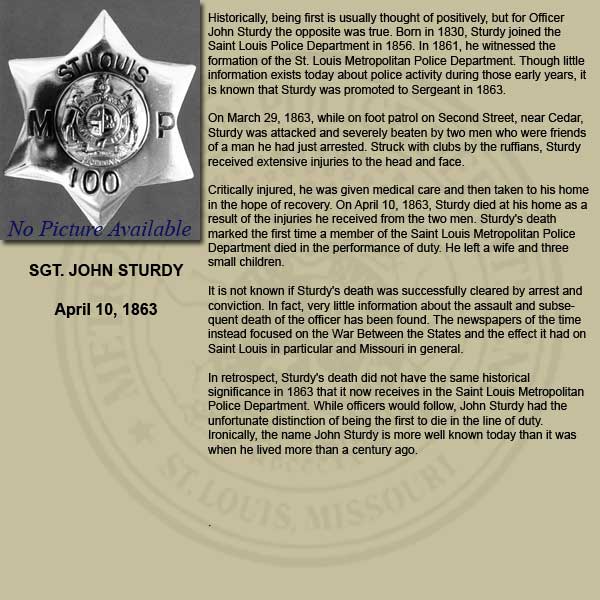 Date of death: April 10, 1863
Full Name: Sgt. John Sturdy
Content: Historically, being first is usually thought of positively, but for Officer
John Sturdy the opposite was true. Bom in 1830, Sturdy joined the.
Saint Louis Police Depariment in 1856. In 1861, he witnessed the
formation of the St. Louis Metropoitan Police Department Though litte
information exists today about police activity during those early years, it
s known that Sturdy was promoted to Sergeant in 1863.
On March 29, 1863, while on foot patrol on Second Street, near Cedar,
Sturdy was attacked and severely beaten by two men who were friends
of a man he had just arrested. Struck with clubs by the ruffians, Sturdy
received extensive injuries to the head and face.
Critically injured, he was given medical care and then taken to his home
in the hope of recovery. On April 10, 1863, Sturdy died at his home as a
result of the injuries he received from the two men. Sturdy's death
marked the first ime a member of the Saint Lous Metropolitan Police
Department died in the performance of duty. He left a wife and three
small children.
tis not known if Sturdy's death was successfully cleared by arrest and
conviction. In fact, very te information about the assault and subse-
quent death of the officer has been found. The newspapers of the time
instead focused on the War Between the States and the effect it had on
Saint Louis in particular and Missouri in general,
In retrospect, Sturdy's death did not have the same historical
significance in 1863 that it iow receives in the Saint Louis Metropolitan
Police Department. While officers would follow, John Sturdy had the
unfortunate distinction of being the first to die in the line of duty.
Ironically, the name John Sturdy is more well known today than t was
when he fived more than a century ago.
Date of death: April 10, 1863
Full Name: Sgt. John Sturdy
Content: Historically, being first is usually thought of positively, but for Officer
John Sturdy the opposite was true. Bom in 1830, Sturdy joined the.
Saint Louis Police Depariment in 1856. In 1861, he witnessed the
formation of the St. Louis Metropoitan Police Department Though litte
information exists today about police activity during those early years, it
s known that Sturdy was promoted to Sergeant in 1863.
On March 29, 1863, while on foot patrol on Second Street, near Cedar,
Sturdy was attacked and severely beaten by two men who were friends
of a man he had just arrested. Struck with clubs by the ruffians, Sturdy
received extensive injuries to the head and face.
Critically injured, he was given medical care and then taken to his home
in the hope of recovery. On April 10, 1863, Sturdy died at his home as a
result of the injuries he received from the two men. Sturdy's death
marked the first ime a member of the Saint Lous Metropolitan Police
Department died in the performance of duty. He left a wife and three
small children.
tis not known if Sturdy's death was successfully cleared by arrest and
conviction. In fact, very te information about the assault and subse-
quent death of the officer has been found. The newspapers of the time
instead focused on the War Between the States and the effect it had on
Saint Louis in particular and Missouri in general,
In retrospect, Sturdy's death did not have the same historical
significance in 1863 that it iow receives in the Saint Louis Metropolitan
Police Department. While officers would follow, John Sturdy had the
unfortunate distinction of being the first to die in the line of duty.
Ironically, the name John Sturdy is more well known today than t was
when he fived more than a century ago.
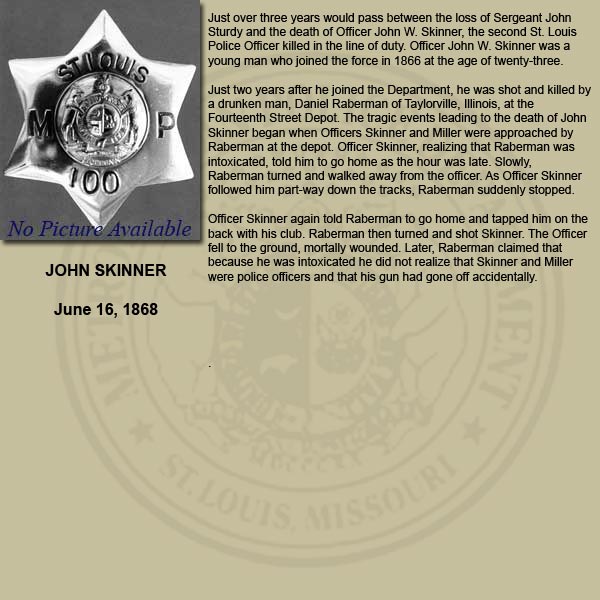 Date of death: June 16,1868
Full Name: John Skinner
Content: Just over three years would pass between the loss of Sergeant John
Sturdy and the death of Officer John W. Skinner, the second St. Louis
Police Officer killed in the line of duty. Officer John WW. Skinner was a
young man who joined the force in 1866 at the age of twenty-three.
Just two years after he joined the Department, he was shot and killed by
a drunken man, Daniel Raberman of Taylorville, llinois, at the
Fourteenth Street Depot. The tragic events leading to the death of John
Skinner began when Officers Skinner and Miler were approached by.
Raberman at the depot. Officer Skinner, realizing that Raberman was.
intoxicated, told him to go home as the hour was late. Slowly,
Raberman tumed and walked away from the officer. As Officer Skinner
followed him part-way down the tracks, Raberman suddenly stopped.
Officer Skinner again told Raberman to go home and tapped him on the
back with his club. Raberman then tumed and shot Skinner. The Officer
fell o the ground, mortally wounded. Later, Raberman claimed that
because he was intoxicated he did not realize that Skinner and Miller
were police officers and that his gun had gone off accidentally
Date of death: June 16,1868
Full Name: John Skinner
Content: Just over three years would pass between the loss of Sergeant John
Sturdy and the death of Officer John W. Skinner, the second St. Louis
Police Officer killed in the line of duty. Officer John WW. Skinner was a
young man who joined the force in 1866 at the age of twenty-three.
Just two years after he joined the Department, he was shot and killed by
a drunken man, Daniel Raberman of Taylorville, llinois, at the
Fourteenth Street Depot. The tragic events leading to the death of John
Skinner began when Officers Skinner and Miler were approached by.
Raberman at the depot. Officer Skinner, realizing that Raberman was.
intoxicated, told him to go home as the hour was late. Slowly,
Raberman tumed and walked away from the officer. As Officer Skinner
followed him part-way down the tracks, Raberman suddenly stopped.
Officer Skinner again told Raberman to go home and tapped him on the
back with his club. Raberman then tumed and shot Skinner. The Officer
fell o the ground, mortally wounded. Later, Raberman claimed that
because he was intoxicated he did not realize that Skinner and Miller
were police officers and that his gun had gone off accidentally
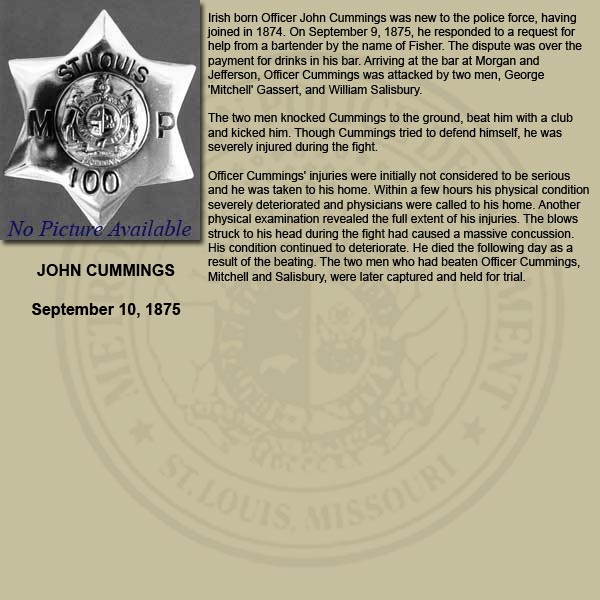 Date of death: September 10, 1875
Full Name: John Cummings
Content: Irish born Officer John Cummings was new to the police force, having
joined in 1874. On September 8, 1875, he responded 10 a request or
help from a bartender by the name of Fisher. The dispute was over the
payment for drinks in his bar. Arriving at the bar at Morgan and |
Jefferson, Officer Cummings was attacked by two men, George
‘Mitchel Gassert, and William Salisbury.
The two men knocked Cummings to the ground, beat him with a club
and kicked him. Though Cummings tried to defend himself, he was
severely injured during the fight.
Officer Cummings’ injuries were initially not considered to be serious
and he was taken to his home. Within a few hours his physical condition
severely deteriorated and physicians were called to his home. Another
physical examination revealed the full extent of is injuries. The blows
struck to his head during the fight had caused a massive concussion.
His condition continued to deteriorate. He died the following day as a
result of the beating. The two men who had beaten Officer Cummings,
Mitchell and Salisbury, were later captured and held for trial.
Date of death: September 10, 1875
Full Name: John Cummings
Content: Irish born Officer John Cummings was new to the police force, having
joined in 1874. On September 8, 1875, he responded 10 a request or
help from a bartender by the name of Fisher. The dispute was over the
payment for drinks in his bar. Arriving at the bar at Morgan and |
Jefferson, Officer Cummings was attacked by two men, George
‘Mitchel Gassert, and William Salisbury.
The two men knocked Cummings to the ground, beat him with a club
and kicked him. Though Cummings tried to defend himself, he was
severely injured during the fight.
Officer Cummings’ injuries were initially not considered to be serious
and he was taken to his home. Within a few hours his physical condition
severely deteriorated and physicians were called to his home. Another
physical examination revealed the full extent of is injuries. The blows
struck to his head during the fight had caused a massive concussion.
His condition continued to deteriorate. He died the following day as a
result of the beating. The two men who had beaten Officer Cummings,
Mitchell and Salisbury, were later captured and held for trial.
 Date of death: November 18, 1877
Full Name: John White
Content: Irish born Officer John S. White joined the St. Louis Metropolitan Police
Department in May 1877. In November 187, he was fatally wounded
when shot by James Rande during the robbery of Wright Pawnshop.
The wound, above the right knee of Officer White, Severed an artery in
his leg, causing extensive bleeding. As White's condition continued to
deteriorate, doctors recommended the amputation of is leg in a
desperate attempt to save his life. Soon, though White's leg was
removed, it became obvious {0 the doctors that the wound would prove
fatal. Officer White died on November 18, 1877. |
Date of death: November 18, 1877
Full Name: John White
Content: Irish born Officer John S. White joined the St. Louis Metropolitan Police
Department in May 1877. In November 187, he was fatally wounded
when shot by James Rande during the robbery of Wright Pawnshop.
The wound, above the right knee of Officer White, Severed an artery in
his leg, causing extensive bleeding. As White's condition continued to
deteriorate, doctors recommended the amputation of is leg in a
desperate attempt to save his life. Soon, though White's leg was
removed, it became obvious {0 the doctors that the wound would prove
fatal. Officer White died on November 18, 1877. |
 Date of death: June 1, 1879
Full Name: Charles Printz
Content: Charles Sanders, angry over an inheritance, the bulk of which had gone
to his sisters, had repeatedly threatened and harassed them. A young
drier, he occasionally went to the home of his sisters where he would
often become violent and threaten to kill them. On the afternoon of June
1, 1879, he came to their house, located at Jackson and Marion,
fanatical and flourishing a pistol
Someone called Officer Charles Printz, a seven year veteran of the
force, to come and arrest young Sanders. When Officer Printz fried to
grab him, a fight ensued. A shot, fired by Sanders, struck Printz in the
left side of his chest Though critically wounded, Printz struck Sanders
with his club before he fell to the ground.
Hundreds of people, attracted to the struggle, gathered in the street
watching as Sanders broke free from the officer and ran. A few of the
bystanders chased Sanders, throwing rocks at him as he escaped. It is
unknown if he was ever captured.
Printz was born in Germany in 1842. He served in the Union Amy
during the War Between the States, where he was wounded. After he
was discharged from the army, he joined the Police Department in
August 1872. At 62" he was one of the tallest officers in the city.
Remembered as one of the bravest officers on the force, he left a wife
and several children.
Date of death: June 1, 1879
Full Name: Charles Printz
Content: Charles Sanders, angry over an inheritance, the bulk of which had gone
to his sisters, had repeatedly threatened and harassed them. A young
drier, he occasionally went to the home of his sisters where he would
often become violent and threaten to kill them. On the afternoon of June
1, 1879, he came to their house, located at Jackson and Marion,
fanatical and flourishing a pistol
Someone called Officer Charles Printz, a seven year veteran of the
force, to come and arrest young Sanders. When Officer Printz fried to
grab him, a fight ensued. A shot, fired by Sanders, struck Printz in the
left side of his chest Though critically wounded, Printz struck Sanders
with his club before he fell to the ground.
Hundreds of people, attracted to the struggle, gathered in the street
watching as Sanders broke free from the officer and ran. A few of the
bystanders chased Sanders, throwing rocks at him as he escaped. It is
unknown if he was ever captured.
Printz was born in Germany in 1842. He served in the Union Amy
during the War Between the States, where he was wounded. After he
was discharged from the army, he joined the Police Department in
August 1872. At 62" he was one of the tallest officers in the city.
Remembered as one of the bravest officers on the force, he left a wife
and several children.
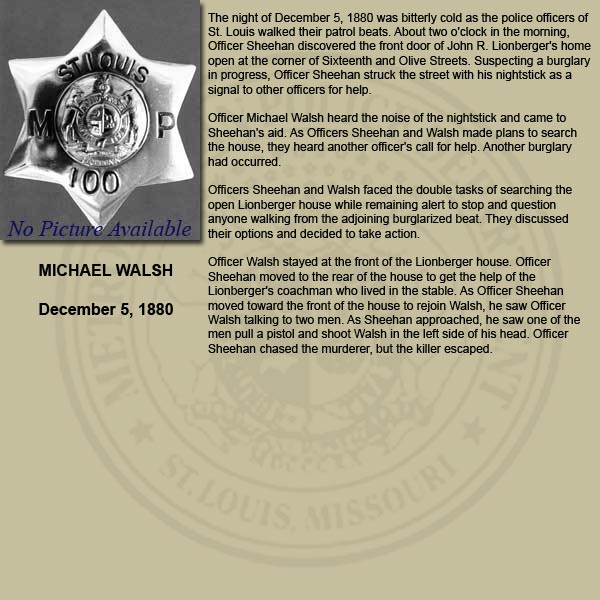 Date of death: December 5, 1880
Full Name: Michael Walsh
Content: The night of December 5, 1830 was bitterly cold as the police officers of
St. Louis walked their patrol beats. About two o'clock n the morning,
Officer Sheehan discovered the front door of John R. Lionberger's home
open at the comer of Sixteenth and Olive Streets. Suspecting a burglary
in progress, Officer Sheehan struck the street with his nightstick as a
signal to other officers for help.
Officer Michael Walsh heard the noise of the nightstick and came to
Sheehan's aid. As Officers Sheehan and Walsh made plans to search
the house, they heard another officer's call or help. Another burglary
had occurred.
Officers Sheehan and Walsh faced the double tasks of searching the
open Lionberger house while remaining alert to stop and question
anyone walking from the adjoining burglarized beat. They discussed
their options and decided to take action.
Officer Walsh stayed at the front of the Lionberger house. Officer
Sheehan moved to the rear of the house to get the help of the
Lionberger's coachman who lived in the stable. AS Officer Sheehan
moved toward the front of the house to rejoin Walsh, he saw Officer
Walsh talking to two men. As Sheehan approached, he saw one of the
men pull a pistol and shoot Walsh in the left side of his head. Officer
Sheehan chased the murderer, but the killer escaped.
Date of death: December 5, 1880
Full Name: Michael Walsh
Content: The night of December 5, 1830 was bitterly cold as the police officers of
St. Louis walked their patrol beats. About two o'clock n the morning,
Officer Sheehan discovered the front door of John R. Lionberger's home
open at the comer of Sixteenth and Olive Streets. Suspecting a burglary
in progress, Officer Sheehan struck the street with his nightstick as a
signal to other officers for help.
Officer Michael Walsh heard the noise of the nightstick and came to
Sheehan's aid. As Officers Sheehan and Walsh made plans to search
the house, they heard another officer's call or help. Another burglary
had occurred.
Officers Sheehan and Walsh faced the double tasks of searching the
open Lionberger house while remaining alert to stop and question
anyone walking from the adjoining burglarized beat. They discussed
their options and decided to take action.
Officer Walsh stayed at the front of the Lionberger house. Officer
Sheehan moved to the rear of the house to get the help of the
Lionberger's coachman who lived in the stable. AS Officer Sheehan
moved toward the front of the house to rejoin Walsh, he saw Officer
Walsh talking to two men. As Sheehan approached, he saw one of the
men pull a pistol and shoot Walsh in the left side of his head. Officer
Sheehan chased the murderer, but the killer escaped.
 Date of death: November 23, 1881
Full Name: Patrick Doran
Content: Born in 1845, Patrick Doran joined the Police Department on April 16,
1875. On November 23, 1881, Jack Shea, a notorious police character,
escaped from the custody of a deputy sheriff. Hearing of the escape,
Officer Doran joined in the pursuit. During the chase, Doran was shot by
Shea at the comer of Seventh and St. Charles Streets.
Officer Doran, married, died at the age of thirty-six. No record of Shea's
arrest has been found.
Date of death: November 23, 1881
Full Name: Patrick Doran
Content: Born in 1845, Patrick Doran joined the Police Department on April 16,
1875. On November 23, 1881, Jack Shea, a notorious police character,
escaped from the custody of a deputy sheriff. Hearing of the escape,
Officer Doran joined in the pursuit. During the chase, Doran was shot by
Shea at the comer of Seventh and St. Charles Streets.
Officer Doran, married, died at the age of thirty-six. No record of Shea's
arrest has been found.
 Date of death: October 8, 1883
Full Name: SGT. PELETIAH JENKS
Content: On October 8, 1883, Sergeant Peletiah Jenks was walking his beat
along Biddle Street. As he approached Eighth Street, he saw a large
crowd shouting and gesturing in a vacant lot. As he approached the
crowd he saw a woman standing at ts center, in a furious rage,
brandishing a pistol.
Realizing the danger the armed woman posed to the people around her,
Jenks walked up tо her from behind and grabbed her am. During the
brief struggle, she turned and fired her pistol at the Officer at point blank
range. As the Sergeant el to the ground, the woman ran off.
Officers came running from the nearby Third District Station. Officer
James Condon followed the woman and arrested her. Other officers
went to the aid of Sergeant Jenks. Realizing the wound would prove
fatal, officers transported Jenks to his home, where he died several
hours later.
The woman, Sadie Hill, was a prostitute and well known in the Third ~~
District She had been walking the sires and alleys that day,
threatening to shoot the people she met. A crowd gathered and followed
her 10 the vacant lot where Sergeant Jenks tried to intervene. After her
arrest, she told officers that she was so upset she did not realize that
Jenks was a police officer. She said she would have shot anyone who
had come near her that day.
Sergeant Jenks was one of the oldest, most experienced and well
known officers on the force. He wore badge #8, attesting to his senior.
He had joined the force in 1868 at the age of twenty-eight. An
outstanding officer, he was promoted to sergeant just one year after his.
appointment to the force due to his “efficient and zealous service” He
was married and had several children.
Date of death: October 8, 1883
Full Name: SGT. PELETIAH JENKS
Content: On October 8, 1883, Sergeant Peletiah Jenks was walking his beat
along Biddle Street. As he approached Eighth Street, he saw a large
crowd shouting and gesturing in a vacant lot. As he approached the
crowd he saw a woman standing at ts center, in a furious rage,
brandishing a pistol.
Realizing the danger the armed woman posed to the people around her,
Jenks walked up tо her from behind and grabbed her am. During the
brief struggle, she turned and fired her pistol at the Officer at point blank
range. As the Sergeant el to the ground, the woman ran off.
Officers came running from the nearby Third District Station. Officer
James Condon followed the woman and arrested her. Other officers
went to the aid of Sergeant Jenks. Realizing the wound would prove
fatal, officers transported Jenks to his home, where he died several
hours later.
The woman, Sadie Hill, was a prostitute and well known in the Third ~~
District She had been walking the sires and alleys that day,
threatening to shoot the people she met. A crowd gathered and followed
her 10 the vacant lot where Sergeant Jenks tried to intervene. After her
arrest, she told officers that she was so upset she did not realize that
Jenks was a police officer. She said she would have shot anyone who
had come near her that day.
Sergeant Jenks was one of the oldest, most experienced and well
known officers on the force. He wore badge #8, attesting to his senior.
He had joined the force in 1868 at the age of twenty-eight. An
outstanding officer, he was promoted to sergeant just one year after his.
appointment to the force due to his “efficient and zealous service” He
was married and had several children.
Date of death: September 4, 1890
Full Name: Louis H. Wilmers
Content: Officer Louis H. Wilmers had received information that Louis Crabtree, a
railroad worker, was carrying a gun. On August 25, 1890, at about 8
p.m. Officer Wilmers approached Crabtree in the Frisco Railroad Yard
and tried to arrest him. Crabtree resisted arrest and a struggle between
the two men followed.
During the fight, Crabiree pulled pistol from his pocket, and placing it
against Wilmers' back, fired one shot. As Wilmers fell to the ground
fatally wounded, Crabtree made his escape on an outgoing Missouri
Pacific train.
Officer Wilmers, who had only been on the department or one year,
was taken to Saint Luke's Hospital. There the doctors determined that
the bullet had severed his spine and that tie could be done to save the
officer's life. He remained in critical condition, paralyzed from the waist
down.
While Wilmers was still in the hospital, Louis Crabtree was arrested and
returned to Saint Louis. Crabtree was taken to the hospital, where he
was positively identified by Wilmers as his assailant. Wiimers also gave
an "ante mortem" (before death) statement of the circumstances of the
shooting.
On September 4, 1890, eleven days after being shot, twenty-eight
year-old Officer Louis Wilmers died. He left a widow and one child.
 Date of death: October 6,1890
Full Name: James Brady
Content: Officer James Brady was shot to death by Harrison Duncan in Stark's
Saloon, at 715 North Eleventh Street.
Officer John Gaffney was patrolling his beat when he saw a crowd in
front of Stark's Saloon. Anticipating trouble from the crowd, he told them
10 "move on.” One man refused to leave the area and Officer Gaffney
placed him under arrest.
Enraged by the arrest, the crowd assaulted Gaffney, throwing him to the
ground. In the struggle, someone took the officer's nightstick from him.
In a desperate try to escape the violent crowd, Officer Gaffney drew his
revolver and fired one shot. The crowd Scattered; many ran info Stark's
Saloon. Gaffney followed several of the people into the saloon. As he
entered, he was struck on the head with a revolver and knocked down.
Several officers, including Patrolman Brady, ran into the saloon to aid
Gaffney. As the officers entered the saloon, Harrison Duncan picked up
Gaffney's revolver and fired at the police officers. The police officers
returned fire at Duncan. During the exchange of gunfire, Duncan
crawled behind the bar where he found a revolver owned by Stark, the
saloon-keeper.
Officer Brady leaned over the bar and called on Duncan to surrender.
Duncan responded by firing a shot which struck Brady in the chest. The
wound proved fatal. Duncan fired the second revolver at the other
policemen. After he fired his last bullet, officers captured him as he tried
to escape.
Duncan was tried for the murder of Officer Brady in Clayton, Missouri,
On October 31, 1891, a verdict of guilty was returned for the murder of
Officer Brady. Duncan was sentenced to death. After appeals to the
Missouri State Supreme Court, Duncan was hanged on July 27, 1834
Date of death: October 6,1890
Full Name: James Brady
Content: Officer James Brady was shot to death by Harrison Duncan in Stark's
Saloon, at 715 North Eleventh Street.
Officer John Gaffney was patrolling his beat when he saw a crowd in
front of Stark's Saloon. Anticipating trouble from the crowd, he told them
10 "move on.” One man refused to leave the area and Officer Gaffney
placed him under arrest.
Enraged by the arrest, the crowd assaulted Gaffney, throwing him to the
ground. In the struggle, someone took the officer's nightstick from him.
In a desperate try to escape the violent crowd, Officer Gaffney drew his
revolver and fired one shot. The crowd Scattered; many ran info Stark's
Saloon. Gaffney followed several of the people into the saloon. As he
entered, he was struck on the head with a revolver and knocked down.
Several officers, including Patrolman Brady, ran into the saloon to aid
Gaffney. As the officers entered the saloon, Harrison Duncan picked up
Gaffney's revolver and fired at the police officers. The police officers
returned fire at Duncan. During the exchange of gunfire, Duncan
crawled behind the bar where he found a revolver owned by Stark, the
saloon-keeper.
Officer Brady leaned over the bar and called on Duncan to surrender.
Duncan responded by firing a shot which struck Brady in the chest. The
wound proved fatal. Duncan fired the second revolver at the other
policemen. After he fired his last bullet, officers captured him as he tried
to escape.
Duncan was tried for the murder of Officer Brady in Clayton, Missouri,
On October 31, 1891, a verdict of guilty was returned for the murder of
Officer Brady. Duncan was sentenced to death. After appeals to the
Missouri State Supreme Court, Duncan was hanged on July 27, 1834
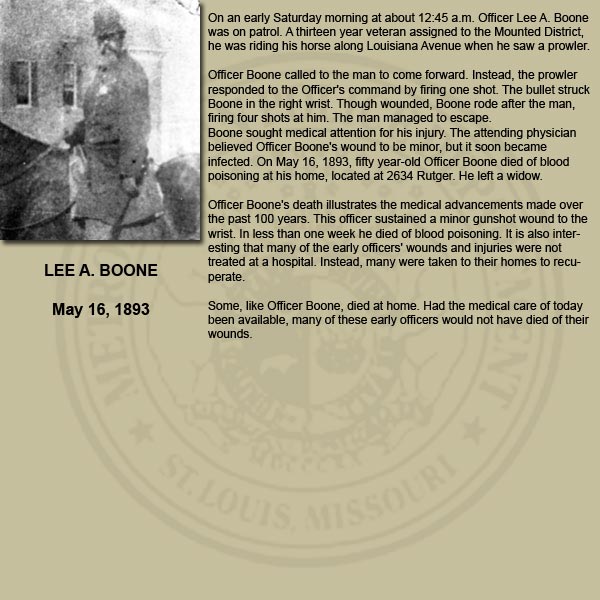 Date of death: May 16, 1893
Full Name: Lee A. Boone
Content: On an early Saturday morning at about 12:45 a.m. Officer Lee A. Boone
was on patrol. A thirteen-year veteran assigned o the Mounted District,
he was riding his horse along Louisiana Avenue when he saw a prowler.
Officer Boone called to the man to come forward. Instead, the prowler
responded to the Officer's command by firing one shot. The bullet struck
Boone in the right wrist. Though wounded, Boone rode after the man,
firing four shots at him. The man managed to escape.
Boone sought medical attention for his injury. The attending physician
believed Officer Boone's wound to be minor, but it soon became |
infected On May 16, 1893, fifty year-old Officer Boone died of blood
poisoning at his home, located at 2634 Rutger. He left a widow. |
Officer Boone's death illustrates the medical advancements made over
the past 100 years. This officer sustained a minor gunshot wound to the
wrist. In less than one week he died of blood poisoning. Its also interesting that many of the early officers’ wounds and injuries were not
treated at a hospital. Instead, many were taken to their homes to recuperate.
Some, like Officer Boone, died at home. Had the medical care of today
been available, many of these early offices would not have died of their
wounds.
Date of death: May 16, 1893
Full Name: Lee A. Boone
Content: On an early Saturday morning at about 12:45 a.m. Officer Lee A. Boone
was on patrol. A thirteen-year veteran assigned o the Mounted District,
he was riding his horse along Louisiana Avenue when he saw a prowler.
Officer Boone called to the man to come forward. Instead, the prowler
responded to the Officer's command by firing one shot. The bullet struck
Boone in the right wrist. Though wounded, Boone rode after the man,
firing four shots at him. The man managed to escape.
Boone sought medical attention for his injury. The attending physician
believed Officer Boone's wound to be minor, but it soon became |
infected On May 16, 1893, fifty year-old Officer Boone died of blood
poisoning at his home, located at 2634 Rutger. He left a widow. |
Officer Boone's death illustrates the medical advancements made over
the past 100 years. This officer sustained a minor gunshot wound to the
wrist. In less than one week he died of blood poisoning. Its also interesting that many of the early officers’ wounds and injuries were not
treated at a hospital. Instead, many were taken to their homes to recuperate.
Some, like Officer Boone, died at home. Had the medical care of today
been available, many of these early offices would not have died of their
wounds.
 Date of death: August 3, 1894
Full Name: Sgt. Michael Gannon
Content: On August 2, 1894, Sergeant Michael Gannon was struck by a train on
the Missouri Pacific racks at the Ewing Avenue crossing. Despite
massive internal and external injuries, he lived until the next day. He
died at his residence, located at 328 South Garrison.
Gannon, a twenty year police veteran, had been promoted to Sergeant
only a few months before his death. Assigned to the Fifth District, he
was one of the most respected officers on the department, On August 4,
1894, the Globe-Democrat praised the fallen officer:
“Few policemen in St. Louis were more widely known of more widely
liked than Sergeant Gannon. For twenty years past he has been on the
force, his duties being done mainly in the Central District and at the
Union Depot. This brought him closely in ouch with the business
community
His unfailing courtesy as well as is sound common sense made him
Very popular. His shy, quiet, retiring character, which was just as
notable, kept him out of public notice, and perhaps deferred his
promotion *
Ironically, Sergeant Gannon's wife was killed at the same spot by a train
eleven years earlier.
Date of death: August 3, 1894
Full Name: Sgt. Michael Gannon
Content: On August 2, 1894, Sergeant Michael Gannon was struck by a train on
the Missouri Pacific racks at the Ewing Avenue crossing. Despite
massive internal and external injuries, he lived until the next day. He
died at his residence, located at 328 South Garrison.
Gannon, a twenty year police veteran, had been promoted to Sergeant
only a few months before his death. Assigned to the Fifth District, he
was one of the most respected officers on the department, On August 4,
1894, the Globe-Democrat praised the fallen officer:
“Few policemen in St. Louis were more widely known of more widely
liked than Sergeant Gannon. For twenty years past he has been on the
force, his duties being done mainly in the Central District and at the
Union Depot. This brought him closely in ouch with the business
community
His unfailing courtesy as well as is sound common sense made him
Very popular. His shy, quiet, retiring character, which was just as
notable, kept him out of public notice, and perhaps deferred his
promotion *
Ironically, Sergeant Gannon's wife was killed at the same spot by a train
eleven years earlier.
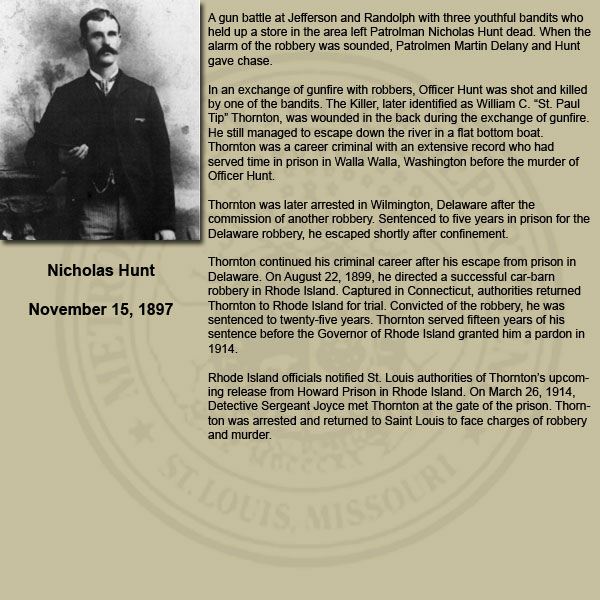 Date of death: November 15, 1897
Full Name: Nicholas Hunt
Content: A gun battle at Jefferson and Randolph with three youthful bandits who
held up a store in the area left Patrolman Nicholas Hunt dead. When the
alarm of the robbery was sounded, Patrolmen Martin Delany and Hunt gave chase.
In an exchange of gunfire with robbers, Officer Hunt was shot and killed
by one of the bandits. The Killer, after identified as William C. “St Paul Tip" Thornton, was wounded in the back during the exchange of gun.
He still managed to escape down the river in a flat bottom boat.
Thorton was a career criminal with an extensive record who had
served time in prison in Walla Walla, Washington before the murder of
Officer Hunt
Thornton was later arrested in Wilmington, Delaware after the
commission of another robbery. Sentenced to five years in prison for the
Delaware robbery, he escaped shorty after confinement
Thorton continued his criminal career after his escape from prison in
Delaware. On August 22, 1899, he directed a successful car-barn
robbery in Rhode Island. Captured in Connecticut, authorities returned
Thorton to Rhode Island for trial. Convicted of the robbery, he was
sentenced to twenty-five years. Thorton served fifteen years of his
sentence before the Governor of Rhode Island granted him a pardon in
1914.
Rhode Island officials notified St. Louis authorities of Thornton's upcoming release from Howard Prison in Rhode Island. On March 26, 1914,
Detective Sergeant Joyce met Thornton a the gate of the prison. Thornton was arrested and returned to Saint Louis to face charges of robbery
and murder.
Date of death: November 15, 1897
Full Name: Nicholas Hunt
Content: A gun battle at Jefferson and Randolph with three youthful bandits who
held up a store in the area left Patrolman Nicholas Hunt dead. When the
alarm of the robbery was sounded, Patrolmen Martin Delany and Hunt gave chase.
In an exchange of gunfire with robbers, Officer Hunt was shot and killed
by one of the bandits. The Killer, after identified as William C. “St Paul Tip" Thornton, was wounded in the back during the exchange of gun.
He still managed to escape down the river in a flat bottom boat.
Thorton was a career criminal with an extensive record who had
served time in prison in Walla Walla, Washington before the murder of
Officer Hunt
Thornton was later arrested in Wilmington, Delaware after the
commission of another robbery. Sentenced to five years in prison for the
Delaware robbery, he escaped shorty after confinement
Thorton continued his criminal career after his escape from prison in
Delaware. On August 22, 1899, he directed a successful car-barn
robbery in Rhode Island. Captured in Connecticut, authorities returned
Thorton to Rhode Island for trial. Convicted of the robbery, he was
sentenced to twenty-five years. Thorton served fifteen years of his
sentence before the Governor of Rhode Island granted him a pardon in
1914.
Rhode Island officials notified St. Louis authorities of Thornton's upcoming release from Howard Prison in Rhode Island. On March 26, 1914,
Detective Sergeant Joyce met Thornton a the gate of the prison. Thornton was arrested and returned to Saint Louis to face charges of robbery
and murder.
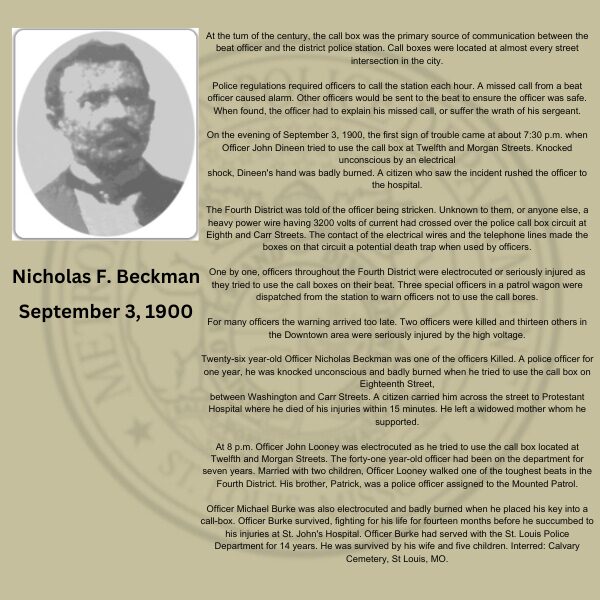 Date of death: September 3, 1900
Full Name: Nicholas J. Beckman
Content: At the turn of the century, the call box was the primary source of communication between the beat officer and the district police station. Call boxes were located at almost every street intersection in the city.
Police regulations required officers to call the station each hour. A missed call from a beat officer caused alarm. Other officers would be sent to the beat to ensure the officer was safe. When found, the officer had to explain his missed call, or suffer the wrath of his sergeant.
On the evening of September 3, 1900, the first sign of trouble came at about 7:30 p.m. when Officer John Dineen tried to use the call box at Twelfth and Morgan Streets. Knocked unconscious by an electrical
shock, Dineen's hand was badly burned. A citizen who saw the incident rushed the officer to the hospital.
The Fourth District was told of the officer being stricken. Unknown to them, or anyone else, a heavy power wire having 3200 volts of current had crossed over the police call box circuit at Eighth and Carr Streets. The contact of the electrical wires and the telephone lines made the boxes on that circuit a potential death trap when used by officers.
One by one, officers throughout the Fourth District were electrocuted or seriously injured as they tried to use the call boxes on their beat. Three special officers in a patrol wagon were dispatched from the station to warn officers not to use the call bores.
For many officers the warning arrived too late. Two officers were killed and thirteen others in the Downtown area were seriously injured by the high voltage.
Twenty-six year-old Officer Nicholas Beckman was one of the officers Killed. A police officer for one year, he was knocked unconscious and badly burned when he tried to use the call box on Eighteenth Street,
between Washington and Carr Streets. A citizen carried him across the street to Protestant Hospital where he died of his injuries within 15 minutes. He left a widowed mother whom he supported.
At 8 p.m. Officer John Looney was electrocuted as he tried to use the call box located at Twelfth and Morgan Streets. The forty-one year-old officer had been on the department for seven years. Married with two children, Officer Looney walked one of the toughest beats in the Fourth District. His brother, Patrick, was a police officer assigned to the Mounted Patrol.
Officer Michael Burke was also electrocuted and badly burned when he placed his key into a call-box. Officer Burke survived, fighting for his life for fourteen months before he succumbed to his injuries at St. John's Hospital. Officer Burke had served with the St. Louis Police Department for 14 years. He was survived by his wife and five children. Interred: Calvary Cemetery, St Louis, MO.
Date of death: September 3, 1900
Full Name: Nicholas J. Beckman
Content: At the turn of the century, the call box was the primary source of communication between the beat officer and the district police station. Call boxes were located at almost every street intersection in the city.
Police regulations required officers to call the station each hour. A missed call from a beat officer caused alarm. Other officers would be sent to the beat to ensure the officer was safe. When found, the officer had to explain his missed call, or suffer the wrath of his sergeant.
On the evening of September 3, 1900, the first sign of trouble came at about 7:30 p.m. when Officer John Dineen tried to use the call box at Twelfth and Morgan Streets. Knocked unconscious by an electrical
shock, Dineen's hand was badly burned. A citizen who saw the incident rushed the officer to the hospital.
The Fourth District was told of the officer being stricken. Unknown to them, or anyone else, a heavy power wire having 3200 volts of current had crossed over the police call box circuit at Eighth and Carr Streets. The contact of the electrical wires and the telephone lines made the boxes on that circuit a potential death trap when used by officers.
One by one, officers throughout the Fourth District were electrocuted or seriously injured as they tried to use the call boxes on their beat. Three special officers in a patrol wagon were dispatched from the station to warn officers not to use the call bores.
For many officers the warning arrived too late. Two officers were killed and thirteen others in the Downtown area were seriously injured by the high voltage.
Twenty-six year-old Officer Nicholas Beckman was one of the officers Killed. A police officer for one year, he was knocked unconscious and badly burned when he tried to use the call box on Eighteenth Street,
between Washington and Carr Streets. A citizen carried him across the street to Protestant Hospital where he died of his injuries within 15 minutes. He left a widowed mother whom he supported.
At 8 p.m. Officer John Looney was electrocuted as he tried to use the call box located at Twelfth and Morgan Streets. The forty-one year-old officer had been on the department for seven years. Married with two children, Officer Looney walked one of the toughest beats in the Fourth District. His brother, Patrick, was a police officer assigned to the Mounted Patrol.
Officer Michael Burke was also electrocuted and badly burned when he placed his key into a call-box. Officer Burke survived, fighting for his life for fourteen months before he succumbed to his injuries at St. John's Hospital. Officer Burke had served with the St. Louis Police Department for 14 years. He was survived by his wife and five children. Interred: Calvary Cemetery, St Louis, MO.
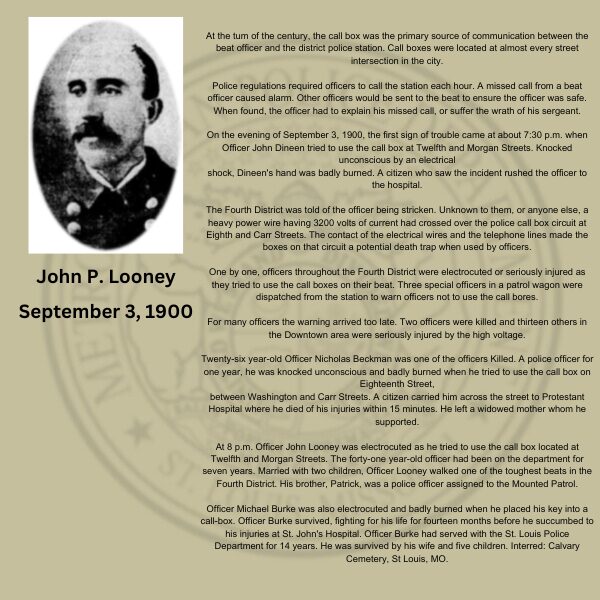 Date of death: September 3, 1900
Full Name: John Looney
Content: At the turn of the century, the call box was the primary source of communication between the beat officer and the district police station. Call boxes were located at almost every street intersection in the city.
Police regulations required officers to call the station each hour. A missed call from a beat officer caused alarm. Other officers would be sent to the beat to ensure the officer was safe. When found, the officer had to explain his missed call, or suffer the wrath of his sergeant.
On the evening of September 3, 1900, the first sign of trouble came at about 7:30 p.m. when Officer John Dineen tried to use the call box at Twelfth and Morgan Streets. Knocked unconscious by an electrical
shock, Dineen's hand was badly burned. A citizen who saw the incident rushed the officer to the hospital.
The Fourth District was told of the officer being stricken. Unknown to them, or anyone else, a heavy power wire having 3200 volts of current had crossed over the police call box circuit at Eighth and Carr Streets. The contact of the electrical wires and the telephone lines made the boxes on that circuit a potential death trap when used by officers.
One by one, officers throughout the Fourth District were electrocuted or seriously injured as they tried to use the call boxes on their beat. Three special officers in a patrol wagon were dispatched from the station to warn officers not to use the call bores.
For many officers the warning arrived too late. Two officers were killed and thirteen others in the Downtown area were seriously injured by the high voltage.
Twenty-six year-old Officer Nicholas Beckman was one of the officers Killed. A police officer for one year, he was knocked unconscious and badly burned when he tried to use the call box on Eighteenth Street,
between Washington and Carr Streets. A citizen carried him across the street to Protestant Hospital where he died of his injuries within 15 minutes. He left a widowed mother whom he supported.
At 8 p.m. Officer John Looney was electrocuted as he tried to use the call box located at Twelfth and Morgan Streets. The forty-one year-old officer had been on the department for seven years. Married with two children, Officer Looney walked one of the toughest beats in the Fourth District. His brother, Patrick, was a police officer assigned to the Mounted Patrol.
Officer Michael Burke was also electrocuted and badly burned when he placed his key into a call-box. Officer Burke survived, fighting for his life for fourteen months before he succumbed to his injuries at St. John's Hospital. Officer Burke had served with the St. Louis Police Department for 14 years. He was survived by his wife and five children. Interred: Calvary Cemetery, St Louis, MO.
Date of death: September 3, 1900
Full Name: John Looney
Content: At the turn of the century, the call box was the primary source of communication between the beat officer and the district police station. Call boxes were located at almost every street intersection in the city.
Police regulations required officers to call the station each hour. A missed call from a beat officer caused alarm. Other officers would be sent to the beat to ensure the officer was safe. When found, the officer had to explain his missed call, or suffer the wrath of his sergeant.
On the evening of September 3, 1900, the first sign of trouble came at about 7:30 p.m. when Officer John Dineen tried to use the call box at Twelfth and Morgan Streets. Knocked unconscious by an electrical
shock, Dineen's hand was badly burned. A citizen who saw the incident rushed the officer to the hospital.
The Fourth District was told of the officer being stricken. Unknown to them, or anyone else, a heavy power wire having 3200 volts of current had crossed over the police call box circuit at Eighth and Carr Streets. The contact of the electrical wires and the telephone lines made the boxes on that circuit a potential death trap when used by officers.
One by one, officers throughout the Fourth District were electrocuted or seriously injured as they tried to use the call boxes on their beat. Three special officers in a patrol wagon were dispatched from the station to warn officers not to use the call bores.
For many officers the warning arrived too late. Two officers were killed and thirteen others in the Downtown area were seriously injured by the high voltage.
Twenty-six year-old Officer Nicholas Beckman was one of the officers Killed. A police officer for one year, he was knocked unconscious and badly burned when he tried to use the call box on Eighteenth Street,
between Washington and Carr Streets. A citizen carried him across the street to Protestant Hospital where he died of his injuries within 15 minutes. He left a widowed mother whom he supported.
At 8 p.m. Officer John Looney was electrocuted as he tried to use the call box located at Twelfth and Morgan Streets. The forty-one year-old officer had been on the department for seven years. Married with two children, Officer Looney walked one of the toughest beats in the Fourth District. His brother, Patrick, was a police officer assigned to the Mounted Patrol.
Officer Michael Burke was also electrocuted and badly burned when he placed his key into a call-box. Officer Burke survived, fighting for his life for fourteen months before he succumbed to his injuries at St. John's Hospital. Officer Burke had served with the St. Louis Police Department for 14 years. He was survived by his wife and five children. Interred: Calvary Cemetery, St Louis, MO.
 Date of death: June 1, 1900
Full Name: Dennis Crane
Content: Alfred T. Koenig was a man with an extensive history of mental illness.
On June 1, 1900, he was near the Alexian Brothers’ Hospital a
Broadway and Osage Streets firing a shotgun into the air Responding
to the report of gunshots, Sergeant Lucey, with Patrolmen McNicholls,
Crane and Maher, red to locate the source of the shooting.
The police found Koenig standing in the middle of the street, Officer
Crane approached Koenig and ordered him to cop the weapon. Slowly,
Crane moved within ten feet of Koenig. Suddenly, Koenig fired his
shotgun at Crane, striking him in the chest.
Sergeant Lucey, Officer MeMicholls and Officer Maher chased Koenig
as he tried to escape. Koenig ran into a nearby saloon, taking refuge in
a back room. Exchanging gunfire, the officers rushed Koenig. In the
struggle, Officer Patrick Maher shot Koenig twice in the chest. Koenig
died in the saloon.
Date of death: June 1, 1900
Full Name: Dennis Crane
Content: Alfred T. Koenig was a man with an extensive history of mental illness.
On June 1, 1900, he was near the Alexian Brothers’ Hospital a
Broadway and Osage Streets firing a shotgun into the air Responding
to the report of gunshots, Sergeant Lucey, with Patrolmen McNicholls,
Crane and Maher, red to locate the source of the shooting.
The police found Koenig standing in the middle of the street, Officer
Crane approached Koenig and ordered him to cop the weapon. Slowly,
Crane moved within ten feet of Koenig. Suddenly, Koenig fired his
shotgun at Crane, striking him in the chest.
Sergeant Lucey, Officer MeMicholls and Officer Maher chased Koenig
as he tried to escape. Koenig ran into a nearby saloon, taking refuge in
a back room. Exchanging gunfire, the officers rushed Koenig. In the
struggle, Officer Patrick Maher shot Koenig twice in the chest. Koenig
died in the saloon.
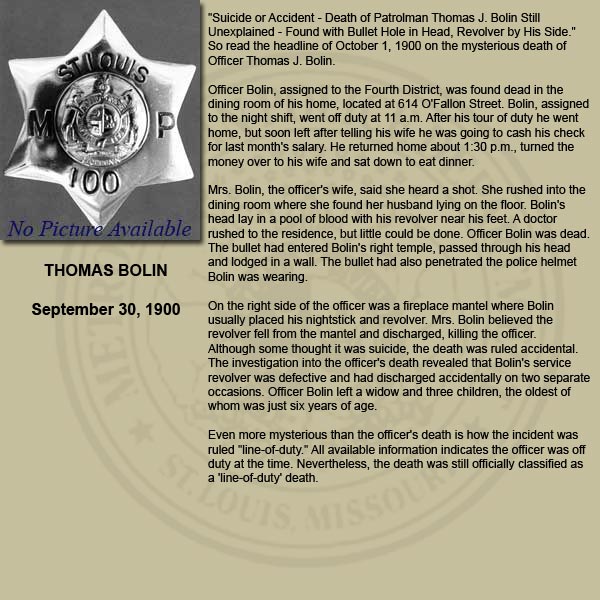 Date of death: September 30, 1900
Full Name: Thomas J. Bolin
Content: “Suicide or Accident - Death of Patrolman Thomas J. Bolin Still i
Unexplained - Found with Bullet Hole in Head, Revolver by His Side”
S0 read the headline of October 1, 1900 on the mysterious death of
Officer Thomas J. Bolin.
Officer Bolin, assigned o the Fourth District, was found dead in the
dining room of his home, located at 614 O'Fallon Street. Bolin, assigned
10 the night shift, went of duty at 11 a.m. After is tour of duty he went
home, but soon left after telling his wife he was going to cash his check
for last month's salary. He returned home about 1:30 p.m. turned the
money over to his wife and sat down to eat dinner.
Mrs. Bolin, the officer's wife, said she heard a shot. She rushed to the
dining room where she found her husband lying on the floor. Bolin's
head lay in a pool of blood with his revolver near his feet. A doctor
rushed to the residence, but ite could be done. Officer Bolin was dead.
The bullet had entered Bolin's right temple, passed through his head
and lodged in a wall. The bullet had also penetrated the police helmet
Bolin was wearing.
On the right side of the officer was a fireplace mantel where Bolin
usually placed his nightstick and revolver. Mrs. Bolin believed the
revolver fell from the mantel and discharged, killing the officer.
Although some thought twas suicide, the death was ruled accidental.
The investigation info the officer's death revealed that Bolin's service
revolver was defective and had discharged accidentally on two separate
occasions. Officer Bolin left 2 widow and three children, the oldest of
whom was just six years of age.
Even more mysterious than the officer's death is how the incident was
ruled "line-of-duty” All available information indicates the officer was off
duty at the time. Nevertheless, the death was still officially classified as
a line-of-duty’ death. |
Date of death: September 30, 1900
Full Name: Thomas J. Bolin
Content: “Suicide or Accident - Death of Patrolman Thomas J. Bolin Still i
Unexplained - Found with Bullet Hole in Head, Revolver by His Side”
S0 read the headline of October 1, 1900 on the mysterious death of
Officer Thomas J. Bolin.
Officer Bolin, assigned o the Fourth District, was found dead in the
dining room of his home, located at 614 O'Fallon Street. Bolin, assigned
10 the night shift, went of duty at 11 a.m. After is tour of duty he went
home, but soon left after telling his wife he was going to cash his check
for last month's salary. He returned home about 1:30 p.m. turned the
money over to his wife and sat down to eat dinner.
Mrs. Bolin, the officer's wife, said she heard a shot. She rushed to the
dining room where she found her husband lying on the floor. Bolin's
head lay in a pool of blood with his revolver near his feet. A doctor
rushed to the residence, but ite could be done. Officer Bolin was dead.
The bullet had entered Bolin's right temple, passed through his head
and lodged in a wall. The bullet had also penetrated the police helmet
Bolin was wearing.
On the right side of the officer was a fireplace mantel where Bolin
usually placed his nightstick and revolver. Mrs. Bolin believed the
revolver fell from the mantel and discharged, killing the officer.
Although some thought twas suicide, the death was ruled accidental.
The investigation info the officer's death revealed that Bolin's service
revolver was defective and had discharged accidentally on two separate
occasions. Officer Bolin left 2 widow and three children, the oldest of
whom was just six years of age.
Even more mysterious than the officer's death is how the incident was
ruled "line-of-duty” All available information indicates the officer was off
duty at the time. Nevertheless, the death was still officially classified as
a line-of-duty’ death. |
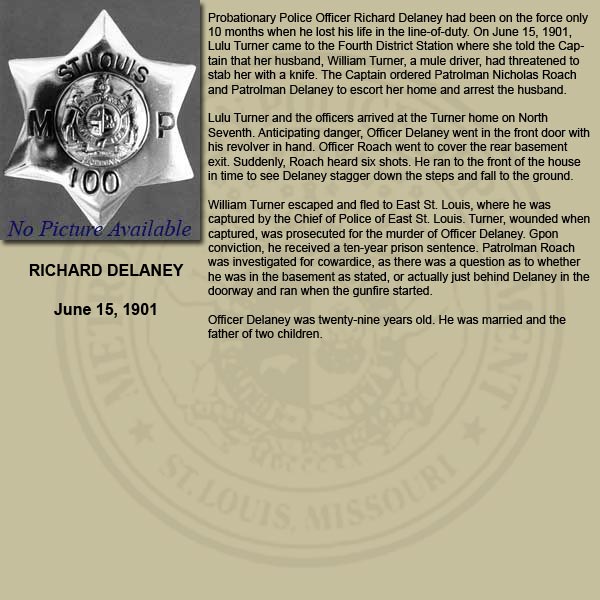 Date of death: June 15, 1901
Full Name: Richard Delaney
Content: Probationary Police Officer Richard Delaney had been on the force only
10 months when he lost his lie in the line-of-duty. On June 15, 1901,
Lulu Turner came to the Fourth District Station where she told the Captain that her husband, William Turner, a mule driver, had threatened to
stab her with a knife. The Captain ordered Patrolman Nicholas Roach
and Patrolman Delaney to escort her home and arrest the husband.
Lulu Turner and the officers arrived at the Turner home on North
Seventh. Anticipating danger, Officer Delaney went in the front door with
his revolver in hand. Officer Roach went to cover the rear basement
exit Suddenly, Roach heard six shots. He ran to the front of the house
in time to see Delaney stagger down the steps and fall to the ground
William Turner escaped and fled to East St. Louis, where he was
captured by the Chief of Police of East St. Louis. Turner, wounded when
captured, was prosecuted for the murder of Officer Delaney. Gpon
conviction, he received a ten-year prison sentence. Patrolman Roach
was investigated for cowardice, as there was a question as to whether
he was in the basement as stated, or actually just behind Delaney in the
doorway and ran when the gunfire started.
Officer Delaney was twenty-nine years old. He was married and the father of two children.
Date of death: June 15, 1901
Full Name: Richard Delaney
Content: Probationary Police Officer Richard Delaney had been on the force only
10 months when he lost his lie in the line-of-duty. On June 15, 1901,
Lulu Turner came to the Fourth District Station where she told the Captain that her husband, William Turner, a mule driver, had threatened to
stab her with a knife. The Captain ordered Patrolman Nicholas Roach
and Patrolman Delaney to escort her home and arrest the husband.
Lulu Turner and the officers arrived at the Turner home on North
Seventh. Anticipating danger, Officer Delaney went in the front door with
his revolver in hand. Officer Roach went to cover the rear basement
exit Suddenly, Roach heard six shots. He ran to the front of the house
in time to see Delaney stagger down the steps and fall to the ground
William Turner escaped and fled to East St. Louis, where he was
captured by the Chief of Police of East St. Louis. Turner, wounded when
captured, was prosecuted for the murder of Officer Delaney. Gpon
conviction, he received a ten-year prison sentence. Patrolman Roach
was investigated for cowardice, as there was a question as to whether
he was in the basement as stated, or actually just behind Delaney in the
doorway and ran when the gunfire started.
Officer Delaney was twenty-nine years old. He was married and the father of two children.
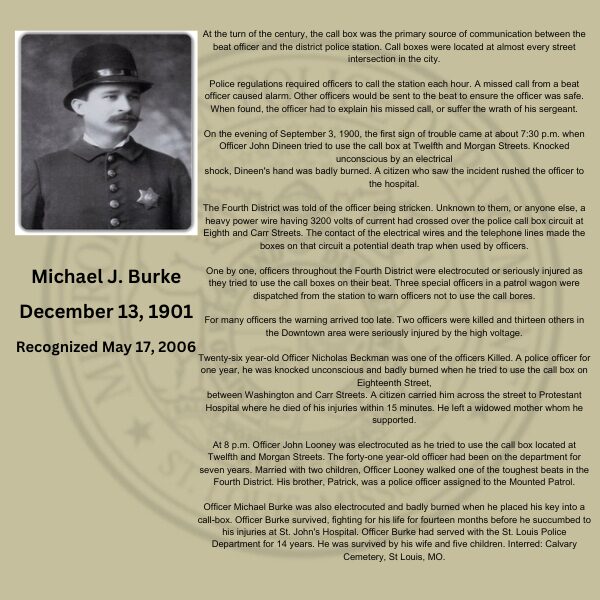 Date of death: December 13, 1901 Recognized May 17, 2006
Full Name: Michael J. Burke
Content: At the turn of the century, the call box was the primary source of communication between the beat officer and the district police station. Call boxes were located at almost every street intersection in the city.
Police regulations required officers to call the station each hour. A missed call from a beat officer caused alarm. Other officers would be sent to the beat to ensure the officer was safe. When found, the officer had to explain his missed call, or suffer the wrath of his sergeant.
On the evening of September 3, 1900, the first sign of trouble came at about 7:30 p.m. when Officer John Dineen tried to use the call box at Twelfth and Morgan Streets. Knocked unconscious by an electrical
shock, Dineen's hand was badly burned. A citizen who saw the incident rushed the officer to the hospital.
The Fourth District was told of the officer being stricken. Unknown to them, or anyone else, a heavy power wire having 3200 volts of current had crossed over the police call box circuit at Eighth and Carr Streets. The contact of the electrical wires and the telephone lines made the boxes on that circuit a potential death trap when used by officers.
One by one, officers throughout the Fourth District were electrocuted or seriously injured as they tried to use the call boxes on their beat. Three special officers in a patrol wagon were dispatched from the station to warn officers not to use the call bores.
For many officers the warning arrived too late. Two officers were killed and thirteen others in the Downtown area were seriously injured by the high voltage.
Twenty-six year-old Officer Nicholas Beckman was one of the officers Killed. A police officer for one year, he was knocked unconscious and badly burned when he tried to use the call box on Eighteenth Street,
between Washington and Carr Streets. A citizen carried him across the street to Protestant Hospital where he died of his injuries within 15 minutes. He left a widowed mother whom he supported.
At 8 p.m. Officer John Looney was electrocuted as he tried to use the call box located at Twelfth and Morgan Streets. The forty-one year-old officer had been on the department for seven years. Married with two children, Officer Looney walked one of the toughest beats in the Fourth District. His brother, Patrick, was a police officer assigned to the Mounted Patrol.
Officer Michael Burke was also electrocuted and badly burned when he placed his key into a call-box. Officer Burke survived, fighting for his life for fourteen months before he succumbed to his injuries at St. John's Hospital. Officer Burke had served with the St. Louis Police Department for 14 years. He was survived by his wife and five children. Interred: Calvary Cemetery, St Louis, MO.
Date of death: December 13, 1901 Recognized May 17, 2006
Full Name: Michael J. Burke
Content: At the turn of the century, the call box was the primary source of communication between the beat officer and the district police station. Call boxes were located at almost every street intersection in the city.
Police regulations required officers to call the station each hour. A missed call from a beat officer caused alarm. Other officers would be sent to the beat to ensure the officer was safe. When found, the officer had to explain his missed call, or suffer the wrath of his sergeant.
On the evening of September 3, 1900, the first sign of trouble came at about 7:30 p.m. when Officer John Dineen tried to use the call box at Twelfth and Morgan Streets. Knocked unconscious by an electrical
shock, Dineen's hand was badly burned. A citizen who saw the incident rushed the officer to the hospital.
The Fourth District was told of the officer being stricken. Unknown to them, or anyone else, a heavy power wire having 3200 volts of current had crossed over the police call box circuit at Eighth and Carr Streets. The contact of the electrical wires and the telephone lines made the boxes on that circuit a potential death trap when used by officers.
One by one, officers throughout the Fourth District were electrocuted or seriously injured as they tried to use the call boxes on their beat. Three special officers in a patrol wagon were dispatched from the station to warn officers not to use the call bores.
For many officers the warning arrived too late. Two officers were killed and thirteen others in the Downtown area were seriously injured by the high voltage.
Twenty-six year-old Officer Nicholas Beckman was one of the officers Killed. A police officer for one year, he was knocked unconscious and badly burned when he tried to use the call box on Eighteenth Street,
between Washington and Carr Streets. A citizen carried him across the street to Protestant Hospital where he died of his injuries within 15 minutes. He left a widowed mother whom he supported.
At 8 p.m. Officer John Looney was electrocuted as he tried to use the call box located at Twelfth and Morgan Streets. The forty-one year-old officer had been on the department for seven years. Married with two children, Officer Looney walked one of the toughest beats in the Fourth District. His brother, Patrick, was a police officer assigned to the Mounted Patrol.
Officer Michael Burke was also electrocuted and badly burned when he placed his key into a call-box. Officer Burke survived, fighting for his life for fourteen months before he succumbed to his injuries at St. John's Hospital. Officer Burke had served with the St. Louis Police Department for 14 years. He was survived by his wife and five children. Interred: Calvary Cemetery, St Louis, MO.
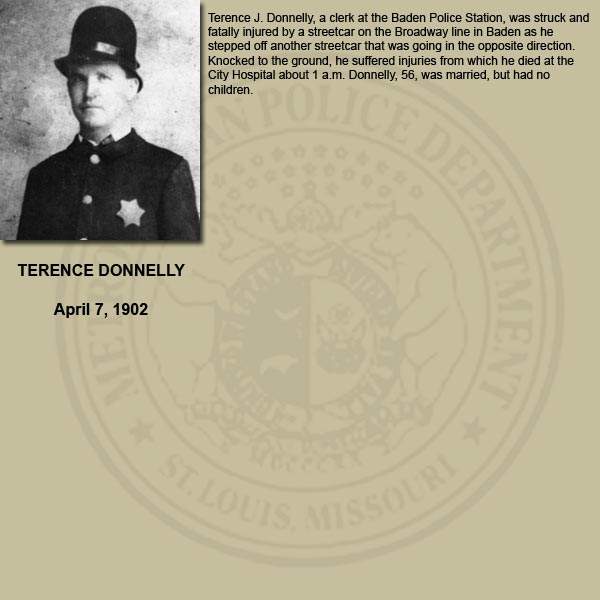 Date of death: April 7, 1902
Full Name: Terrence J. Donnelly
Content: Terence J. Donnelly, a clerk at the Baden Police Station, was struck and
fatally injured by a streetcar on the Broadway fine in Baden as he
stepped off another streetcar that was going in the opposite direction.
Knocked to the ground, he suffered injuries from which he died at the
City Hospital about 1 am. Donnelly, 56, was married, but had no
children.
Date of death: April 7, 1902
Full Name: Terrence J. Donnelly
Content: Terence J. Donnelly, a clerk at the Baden Police Station, was struck and
fatally injured by a streetcar on the Broadway fine in Baden as he
stepped off another streetcar that was going in the opposite direction.
Knocked to the ground, he suffered injuries from which he died at the
City Hospital about 1 am. Donnelly, 56, was married, but had no
children.
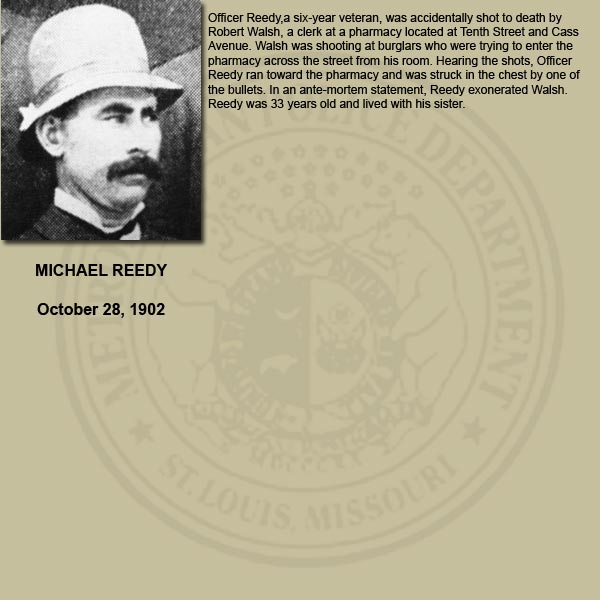 Date of death: October 28, 1902
Full Name: Michael Reedy
Content: Officer Reedy, six-year veteran, was accidentally shot to death by
Robert Walsh, a clerk at a pharmacy located at Tenth Street and Cass
Avenue. Walsh was shooting at burglars who were frying to enter the
pharmacy across the street from his room. Hearing the shots, Officer
Reedy ran toward the pharmacy and was struck in the chest by one of
the bullets. In an ante-mortem statement, Reedy exonerated Walsh.
Reedy was 33 years old and lived with his sister.
Date of death: October 28, 1902
Full Name: Michael Reedy
Content: Officer Reedy, six-year veteran, was accidentally shot to death by
Robert Walsh, a clerk at a pharmacy located at Tenth Street and Cass
Avenue. Walsh was shooting at burglars who were frying to enter the
pharmacy across the street from his room. Hearing the shots, Officer
Reedy ran toward the pharmacy and was struck in the chest by one of
the bullets. In an ante-mortem statement, Reedy exonerated Walsh.
Reedy was 33 years old and lived with his sister.
 Date of death: December 28, 1902
Full Name: William Boka
Content: On Christmas Day, Officer Boka tried to board a streetcar on Channing
Avenue. Missing his footing, he fell across the streetcar track and was
run over by the following streetcar
With his leg mangled, the offer almost bled to death at the scene. A
doctor, who was passing by, administered emergency treatment and
partially stopped the bleeding. Boka was rushed o the hospital where
doctors decided to remove his injured leg in a desperate attempt to
save his life. Despite the emergency operation, Officer Boka soon died
at City Hospital.
Nelson K. Healy was the motorman of the streetcar which ran over
Officer Boka. Healy was charged and convicted of culpable negligence
in the operation and management of his streetcar.
Date of death: December 28, 1902
Full Name: William Boka
Content: On Christmas Day, Officer Boka tried to board a streetcar on Channing
Avenue. Missing his footing, he fell across the streetcar track and was
run over by the following streetcar
With his leg mangled, the offer almost bled to death at the scene. A
doctor, who was passing by, administered emergency treatment and
partially stopped the bleeding. Boka was rushed o the hospital where
doctors decided to remove his injured leg in a desperate attempt to
save his life. Despite the emergency operation, Officer Boka soon died
at City Hospital.
Nelson K. Healy was the motorman of the streetcar which ran over
Officer Boka. Healy was charged and convicted of culpable negligence
in the operation and management of his streetcar.
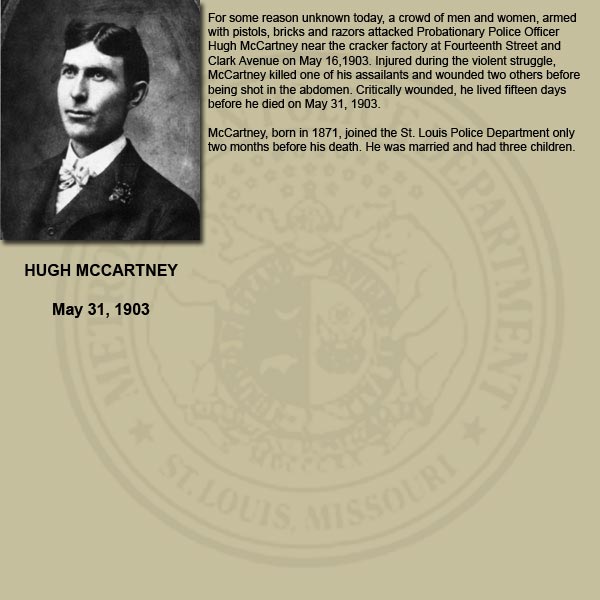 Date of death: May 31,1903
Full Name: Hugh McCartney
Content: For some reason unknown today, a crowd of men and women, armed
with pistols, bricks and razors attacked Probationary Police Officer
Hugh McCartney near the cracker factory at Fourteenth Street and
Clark Avenue on May 16,1903. Injured during the violent struggle,
McCartney killed one of his assailants and wounded two others before
being shot in the abdomen. Critically wounded, he lived fifteen days
before he died on May 31, 1903.
McCartney, born in 1871, joined the St. Louis Police Department only
two months before his death. He was married and had three children.
Date of death: May 31,1903
Full Name: Hugh McCartney
Content: For some reason unknown today, a crowd of men and women, armed
with pistols, bricks and razors attacked Probationary Police Officer
Hugh McCartney near the cracker factory at Fourteenth Street and
Clark Avenue on May 16,1903. Injured during the violent struggle,
McCartney killed one of his assailants and wounded two others before
being shot in the abdomen. Critically wounded, he lived fifteen days
before he died on May 31, 1903.
McCartney, born in 1871, joined the St. Louis Police Department only
two months before his death. He was married and had three children.
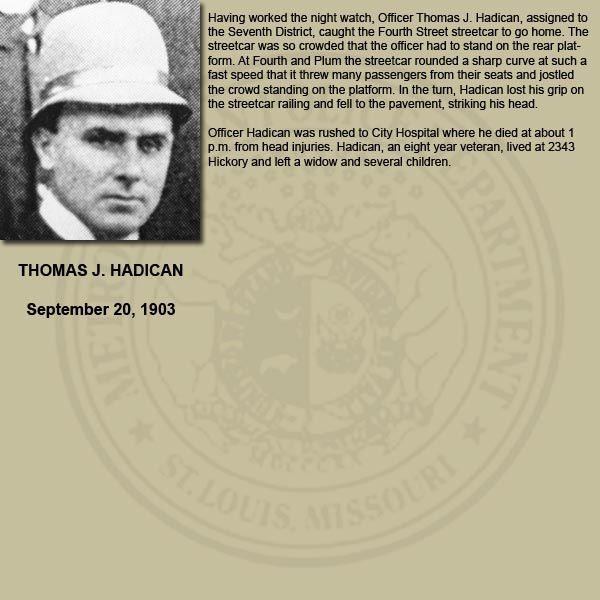 Date of death: September 20, 1903
Full Name: Thomas J. Hadican
Content: Having worked the night watch, Officer Thomas J. Hadican, assigned to
the Seventh District, caught the Fourth Street streetcar to go home. The
Streetcar was so crowded that the officer had to stand on the rear platform. At Fourth and Plum the streetcar rounded a sharp curve at such a
fast speed that t threw many passengers from their seats and jostled
the crowd standing on the platform. In the tum, Hadican 1ost is grip on
the streetcar railing and fell o the pavement, striking his head
Officer Hadican was rushed to City Hospital where he died at about 1
p.m. from head injuries. Hadican, an eight year veteran, ived at 2343
Hickory and let a widow and several children.
Date of death: September 20, 1903
Full Name: Thomas J. Hadican
Content: Having worked the night watch, Officer Thomas J. Hadican, assigned to
the Seventh District, caught the Fourth Street streetcar to go home. The
Streetcar was so crowded that the officer had to stand on the rear platform. At Fourth and Plum the streetcar rounded a sharp curve at such a
fast speed that t threw many passengers from their seats and jostled
the crowd standing on the platform. In the tum, Hadican 1ost is grip on
the streetcar railing and fell o the pavement, striking his head
Officer Hadican was rushed to City Hospital where he died at about 1
p.m. from head injuries. Hadican, an eight year veteran, ived at 2343
Hickory and let a widow and several children.
 Date of death: August 24, 1903
Full Name: William Y. Hoagland
Content: Like some of his predecessors, Police Officer William Y. Hoagland was
fatally injured by a streetcar. The accident occurred on the Belt Avenue
crossing of the suburban right-of-way when Hoagland walked behind an
eastbound streetcar and onto the opposite frack, unaware a westbound
car was approaching. The westbound car hit the officer. The force of the
impact threw him about ten feet, his body coming o rest after striking a
telephone pole.
Officer Hoagland was rushed to City Hospital. Doctors found that he
suffered from a compound fracture of the skull and a concussion. He
died within an hour of the accident.
Just ten days before his death, Officer Hoagland had saved a young
girls life by pulling her from the track of an oncoming streetcar. Hoagland used that incident to warm his own children to look both ways before crossing the tracks.
A member of the Police Department since May 1876, Hoagland
advanced to Sergeant in 1836. In 1892, he was reassigned the rank of
Patrolman. He, his wife and several children lived at 4408 North Nineteenth Street
Date of death: August 24, 1903
Full Name: William Y. Hoagland
Content: Like some of his predecessors, Police Officer William Y. Hoagland was
fatally injured by a streetcar. The accident occurred on the Belt Avenue
crossing of the suburban right-of-way when Hoagland walked behind an
eastbound streetcar and onto the opposite frack, unaware a westbound
car was approaching. The westbound car hit the officer. The force of the
impact threw him about ten feet, his body coming o rest after striking a
telephone pole.
Officer Hoagland was rushed to City Hospital. Doctors found that he
suffered from a compound fracture of the skull and a concussion. He
died within an hour of the accident.
Just ten days before his death, Officer Hoagland had saved a young
girls life by pulling her from the track of an oncoming streetcar. Hoagland used that incident to warm his own children to look both ways before crossing the tracks.
A member of the Police Department since May 1876, Hoagland
advanced to Sergeant in 1836. In 1892, he was reassigned the rank of
Patrolman. He, his wife and several children lived at 4408 North Nineteenth Street
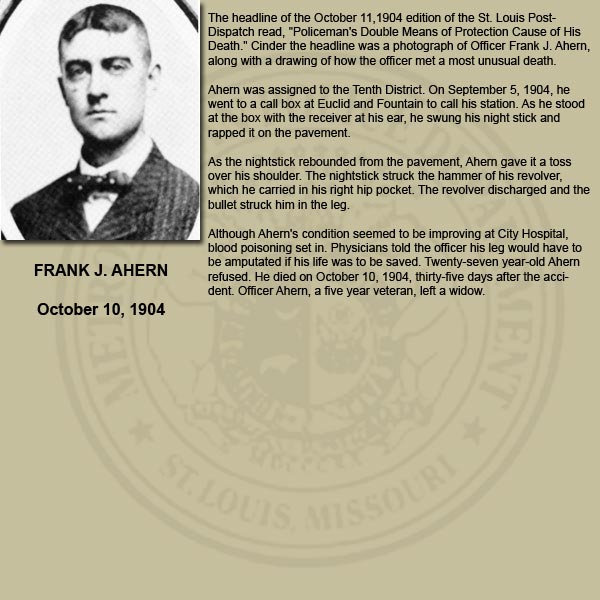 Date of death: October 10, 1904
Full Name: Frank Ahern
Content: The headline of the October 11,1904 edition of the St. Louis Post-
Dispatch read, "Policeman's Double Means of Protection Cause of His
Death." Cinder the headline was a photograph of Officer Frank J. Ahern,
along with a drawing of how the officer met a most unusual death.
Ahern was assigned to the Tenth District. On September 5, 1904, he
went to a cal box at Euclid and Fountain to call is station. As he stood
at the box with the receiver at is ear, he swung his night sick and
rapped it on the pavement.
As the nightstick rebounded from the pavement, Ahem gave it a toss
over his shoulder. The nightstick struck the hammer of his revolver,
which he carried in his fight hip pocket. The revolver discharged and the
bullet struck him in the leg.
Although Ahem's condition seemed to be improving at City Hospital,
blood poisoning set in. Physicians told the officer his leg would have to
be amputated if his life was to be saved. Twen'y-seven year-old Ahem
refused. He died on October 10, 1904, thirty-five days after the acct
dent Officer Ahem, a five year veteran, left a widow.
Date of death: October 10, 1904
Full Name: Frank Ahern
Content: The headline of the October 11,1904 edition of the St. Louis Post-
Dispatch read, "Policeman's Double Means of Protection Cause of His
Death." Cinder the headline was a photograph of Officer Frank J. Ahern,
along with a drawing of how the officer met a most unusual death.
Ahern was assigned to the Tenth District. On September 5, 1904, he
went to a cal box at Euclid and Fountain to call is station. As he stood
at the box with the receiver at is ear, he swung his night sick and
rapped it on the pavement.
As the nightstick rebounded from the pavement, Ahem gave it a toss
over his shoulder. The nightstick struck the hammer of his revolver,
which he carried in his fight hip pocket. The revolver discharged and the
bullet struck him in the leg.
Although Ahem's condition seemed to be improving at City Hospital,
blood poisoning set in. Physicians told the officer his leg would have to
be amputated if his life was to be saved. Twen'y-seven year-old Ahem
refused. He died on October 10, 1904, thirty-five days after the acct
dent Officer Ahem, a five year veteran, left a widow.
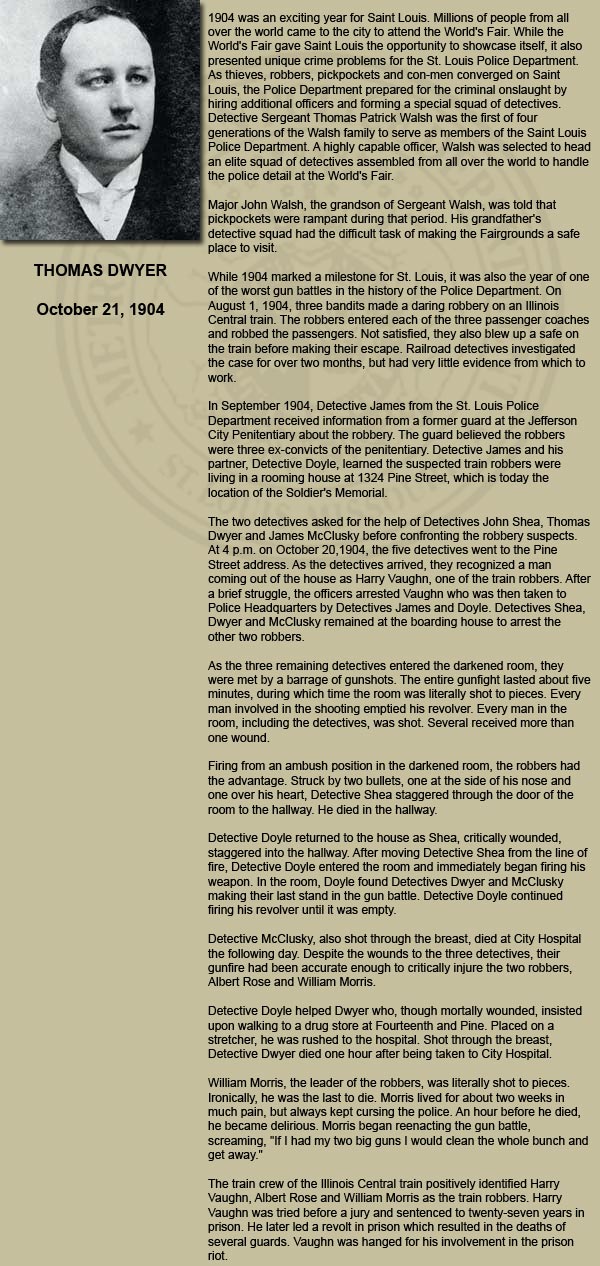 Date of death: October 21, 1904
Full Name: Thomas Dwyer
Content: 1904 was an exciting year for Saint Louis. Milions of people from all
over the world came to the city to attend the Worlds Fair. While the World's Fair gave Saint Louis the opportunity to showcase itself, it also
presented unique crime problems for the St. Louis Police Department.
As thieves, robbers, pickpockets and con-men converged on Saint
Lous, the Police Department prepared for the criminal onslaught by.
hiring additional officers and forming a special squad of detectives.
Detective Sergeant Thomas Patrick Waish was the first of four
generations of the Walsh family to serve as members of the Saint Louis
Police Department A highly capable officer, Walsh was selected to head
an elite squad of detectives assembled from all over the world to handle
the police detail at the World's Fair.
Major John Wash, the grandson of Sergeant Walsh, was fold that
pickpockets were rampant during that period. His grandfather's
detective squad had the difficult task of making the Fairgrounds a safe
place to visit.
While 1904 marked a milestone for St. Lois, it was also the year of one
of the worst gun battles in the history of the Police Department. On
August 1, 1904, three bandits made a daring robbery on an Illinois
Central train. The robbers entered each of the three passenger coaches
and robbed the passengers. Not satisfied, they also blew up a safe on
the train before making their escape. Railroad detectives investigated
the case for over two months, but had very tle evidence from which to
work.
In September 1904, Detective James from the St. Louis Police
Department received information from a former guard at the Jefferson
City Penitentiary about the robbery. The guard believed the robbers
were three ex-convicts of the penitentiary. Detective James and his
partner, Detective Doyle, learned the suspected train robbers were
living in a rooming house at 1324 Pine Street, which is today the
location of the Soldier's Memorial.
The two detectives asked for the help of Detectives John Shea, Thomas
Dwyer and James McClusky before confronting the robbery suspects.
AL4 p.m. on October 20,1904, the five defectives went to the Pine.
Street address. As the detectives arrived, they recognized a man
coming out of the house as Harry Vaughn, one of the train robbers. After
a brief struggle, the officers arrested Vaughn who was then taken to
Police Headquarters by Detectives James and Doyle. Detectives Shea,
Dwyer and McClusky remained at the boarding house to arrest the
other two robbers.
As the tee remaining detectives entered the darkened room, hey
were met by a barrage of gunshots. The entire gunfight lasted about five.
minutes, during which time the room was literally shot to pieces. Every
man involved in the shooting emptied his revolver. Every man in the
room, including the detectives, was shot Several received more than
one wound.
Firing from an ambush position in the darkened room, the robbers had
the advantage. Struck by two bullets, one at the side of his nose and
one over his heart, Defective Shea staggered through the door of the
room to the hallway. He died in the hallway.
Detective Doyle returned to the house as Shea, critically wounded,
staggered into the hallway. After moving Detective Shea from the line of
fire, Detective Doyle entered the room and immediately began firing his
weapon. In the room, Doyle found Detectives Dwyer and McClusky
making their last stand in the gun battle. Detective Doyle continued
firing his revolver unit was empty.
Detective McClusky, also shot through the breast, died at City Hospital
the following day. Despite the wounds to the three detectives, their
gunfire had been accurate enough to critically injure the two robbers,
Albert Rose and Wiliam Mortis.
Detective Doyle helped Dwyer who, though mortally wounded, insisted
upon walking to a drug store at Fourteenth and Pine. Placed on a
stretcher, he was rushed to the hospital. Shot through the breast,
Detective Dwyer died one hour after being taken to City Hospital.
William Moris, the leader of the robbers, was literally shot to pieces.
Ironically, he was the last to die. Morris lived for about two weeks in
much pain, but always kept cursing the police. An hour before he died,
he became delirious. Moris began reenacting the gun battle,
Screaming, If had my two big guns | would clean the whole bunch and
get away”
Date of death: October 21, 1904
Full Name: Thomas Dwyer
Content: 1904 was an exciting year for Saint Louis. Milions of people from all
over the world came to the city to attend the Worlds Fair. While the World's Fair gave Saint Louis the opportunity to showcase itself, it also
presented unique crime problems for the St. Louis Police Department.
As thieves, robbers, pickpockets and con-men converged on Saint
Lous, the Police Department prepared for the criminal onslaught by.
hiring additional officers and forming a special squad of detectives.
Detective Sergeant Thomas Patrick Waish was the first of four
generations of the Walsh family to serve as members of the Saint Louis
Police Department A highly capable officer, Walsh was selected to head
an elite squad of detectives assembled from all over the world to handle
the police detail at the World's Fair.
Major John Wash, the grandson of Sergeant Walsh, was fold that
pickpockets were rampant during that period. His grandfather's
detective squad had the difficult task of making the Fairgrounds a safe
place to visit.
While 1904 marked a milestone for St. Lois, it was also the year of one
of the worst gun battles in the history of the Police Department. On
August 1, 1904, three bandits made a daring robbery on an Illinois
Central train. The robbers entered each of the three passenger coaches
and robbed the passengers. Not satisfied, they also blew up a safe on
the train before making their escape. Railroad detectives investigated
the case for over two months, but had very tle evidence from which to
work.
In September 1904, Detective James from the St. Louis Police
Department received information from a former guard at the Jefferson
City Penitentiary about the robbery. The guard believed the robbers
were three ex-convicts of the penitentiary. Detective James and his
partner, Detective Doyle, learned the suspected train robbers were
living in a rooming house at 1324 Pine Street, which is today the
location of the Soldier's Memorial.
The two detectives asked for the help of Detectives John Shea, Thomas
Dwyer and James McClusky before confronting the robbery suspects.
AL4 p.m. on October 20,1904, the five defectives went to the Pine.
Street address. As the detectives arrived, they recognized a man
coming out of the house as Harry Vaughn, one of the train robbers. After
a brief struggle, the officers arrested Vaughn who was then taken to
Police Headquarters by Detectives James and Doyle. Detectives Shea,
Dwyer and McClusky remained at the boarding house to arrest the
other two robbers.
As the tee remaining detectives entered the darkened room, hey
were met by a barrage of gunshots. The entire gunfight lasted about five.
minutes, during which time the room was literally shot to pieces. Every
man involved in the shooting emptied his revolver. Every man in the
room, including the detectives, was shot Several received more than
one wound.
Firing from an ambush position in the darkened room, the robbers had
the advantage. Struck by two bullets, one at the side of his nose and
one over his heart, Defective Shea staggered through the door of the
room to the hallway. He died in the hallway.
Detective Doyle returned to the house as Shea, critically wounded,
staggered into the hallway. After moving Detective Shea from the line of
fire, Detective Doyle entered the room and immediately began firing his
weapon. In the room, Doyle found Detectives Dwyer and McClusky
making their last stand in the gun battle. Detective Doyle continued
firing his revolver unit was empty.
Detective McClusky, also shot through the breast, died at City Hospital
the following day. Despite the wounds to the three detectives, their
gunfire had been accurate enough to critically injure the two robbers,
Albert Rose and Wiliam Mortis.
Detective Doyle helped Dwyer who, though mortally wounded, insisted
upon walking to a drug store at Fourteenth and Pine. Placed on a
stretcher, he was rushed to the hospital. Shot through the breast,
Detective Dwyer died one hour after being taken to City Hospital.
William Moris, the leader of the robbers, was literally shot to pieces.
Ironically, he was the last to die. Morris lived for about two weeks in
much pain, but always kept cursing the police. An hour before he died,
he became delirious. Moris began reenacting the gun battle,
Screaming, If had my two big guns | would clean the whole bunch and
get away”
 Date of death: October 21, 1904
Full Name: John Shea
Content: 1904 was an exciting year for Saint Louis. Milions of people from all
over the world came to the city to attend the Worlds Fair. While the World's Fair gave Saint Louis the opportunity to showcase itself, it also
presented unique crime problems for the St. Louis Police Department.
As thieves, robbers, pickpockets and con-men converged on Saint
Lous, the Police Department prepared for the criminal onslaught by.
hiring additional officers and forming a special squad of detectives.
Detective Sergeant Thomas Patrick Waish was the first of four
generations of the Walsh family to serve as members of the Saint Louis
Police Department A highly capable officer, Walsh was selected to head
an elite squad of detectives assembled from all over the world to handle
the police detail at the World's Fair.
Major John Wash, the grandson of Sergeant Walsh, was fold that
pickpockets were rampant during that period. His grandfather's
detective squad had the difficult task of making the Fairgrounds a safe
place to visit.
While 1904 marked a milestone for St. Lois, it was also the year of one
of the worst gun battles in the history of the Police Department. On
August 1, 1904, three bandits made a daring robbery on an Illinois
Central train. The robbers entered each of the three passenger coaches
and robbed the passengers. Not satisfied, they also blew up a safe on
the train before making their escape. Railroad detectives investigated
the case for over two months, but had very tle evidence from which to
work.
In September 1904, Detective James from the St. Louis Police
Department received information from a former guard at the Jefferson
City Penitentiary about the robbery. The guard believed the robbers
were three ex-convicts of the penitentiary. Detective James and his
partner, Detective Doyle, learned the suspected train robbers were
living in a rooming house at 1324 Pine Street, which is today the
location of the Soldier's Memorial.
The two detectives asked for the help of Detectives John Shea, Thomas
Dwyer and James McClusky before confronting the robbery suspects.
AL4 p.m. on October 20,1904, the five defectives went to the Pine.
Street address. As the detectives arrived, they recognized a man
coming out of the house as Harry Vaughn, one of the train robbers. After
a brief struggle, the officers arrested Vaughn who was then taken to
Police Headquarters by Detectives James and Doyle. Detectives Shea,
Dwyer and McClusky remained at the boarding house to arrest the
other two robbers.
As the tee remaining detectives entered the darkened room, hey
were met by a barrage of gunshots. The entire gunfight lasted about five.
minutes, during which time the room was literally shot to pieces. Every
man involved in the shooting emptied his revolver. Every man in the
room, including the detectives, was shot Several received more than
one wound.
Firing from an ambush position in the darkened room, the robbers had
the advantage. Struck by two bullets, one at the side of his nose and
one over his heart, Defective Shea staggered through the door of the
room to the hallway. He died in the hallway.
Detective Doyle returned to the house as Shea, critically wounded,
staggered into the hallway. After moving Detective Shea from the line of
fire, Detective Doyle entered the room and immediately began firing his
weapon. In the room, Doyle found Detectives Dwyer and McClusky
making their last stand in the gun battle. Detective Doyle continued
firing his revolver unit was empty.
Detective McClusky, also shot through the breast, died at City Hospital
the following day. Despite the wounds to the three detectives, their
gunfire had been accurate enough to critically injure the two robbers,
Albert Rose and Wiliam Mortis.
Detective Doyle helped Dwyer who, though mortally wounded, insisted
upon walking to a drug store at Fourteenth and Pine. Placed on a
stretcher, he was rushed to the hospital. Shot through the breast,
Detective Dwyer died one hour after being taken to City Hospital.
William Moris, the leader of the robbers, was literally shot to pieces.
Ironically, he was the last to die. Morris lived for about two weeks in
much pain, but always kept cursing the police. An hour before he died,
he became delirious. Moris began reenacting the gun battle,
Screaming, If had my two big guns | would clean the whole bunch and
get away”
Date of death: October 21, 1904
Full Name: John Shea
Content: 1904 was an exciting year for Saint Louis. Milions of people from all
over the world came to the city to attend the Worlds Fair. While the World's Fair gave Saint Louis the opportunity to showcase itself, it also
presented unique crime problems for the St. Louis Police Department.
As thieves, robbers, pickpockets and con-men converged on Saint
Lous, the Police Department prepared for the criminal onslaught by.
hiring additional officers and forming a special squad of detectives.
Detective Sergeant Thomas Patrick Waish was the first of four
generations of the Walsh family to serve as members of the Saint Louis
Police Department A highly capable officer, Walsh was selected to head
an elite squad of detectives assembled from all over the world to handle
the police detail at the World's Fair.
Major John Wash, the grandson of Sergeant Walsh, was fold that
pickpockets were rampant during that period. His grandfather's
detective squad had the difficult task of making the Fairgrounds a safe
place to visit.
While 1904 marked a milestone for St. Lois, it was also the year of one
of the worst gun battles in the history of the Police Department. On
August 1, 1904, three bandits made a daring robbery on an Illinois
Central train. The robbers entered each of the three passenger coaches
and robbed the passengers. Not satisfied, they also blew up a safe on
the train before making their escape. Railroad detectives investigated
the case for over two months, but had very tle evidence from which to
work.
In September 1904, Detective James from the St. Louis Police
Department received information from a former guard at the Jefferson
City Penitentiary about the robbery. The guard believed the robbers
were three ex-convicts of the penitentiary. Detective James and his
partner, Detective Doyle, learned the suspected train robbers were
living in a rooming house at 1324 Pine Street, which is today the
location of the Soldier's Memorial.
The two detectives asked for the help of Detectives John Shea, Thomas
Dwyer and James McClusky before confronting the robbery suspects.
AL4 p.m. on October 20,1904, the five defectives went to the Pine.
Street address. As the detectives arrived, they recognized a man
coming out of the house as Harry Vaughn, one of the train robbers. After
a brief struggle, the officers arrested Vaughn who was then taken to
Police Headquarters by Detectives James and Doyle. Detectives Shea,
Dwyer and McClusky remained at the boarding house to arrest the
other two robbers.
As the tee remaining detectives entered the darkened room, hey
were met by a barrage of gunshots. The entire gunfight lasted about five.
minutes, during which time the room was literally shot to pieces. Every
man involved in the shooting emptied his revolver. Every man in the
room, including the detectives, was shot Several received more than
one wound.
Firing from an ambush position in the darkened room, the robbers had
the advantage. Struck by two bullets, one at the side of his nose and
one over his heart, Defective Shea staggered through the door of the
room to the hallway. He died in the hallway.
Detective Doyle returned to the house as Shea, critically wounded,
staggered into the hallway. After moving Detective Shea from the line of
fire, Detective Doyle entered the room and immediately began firing his
weapon. In the room, Doyle found Detectives Dwyer and McClusky
making their last stand in the gun battle. Detective Doyle continued
firing his revolver unit was empty.
Detective McClusky, also shot through the breast, died at City Hospital
the following day. Despite the wounds to the three detectives, their
gunfire had been accurate enough to critically injure the two robbers,
Albert Rose and Wiliam Mortis.
Detective Doyle helped Dwyer who, though mortally wounded, insisted
upon walking to a drug store at Fourteenth and Pine. Placed on a
stretcher, he was rushed to the hospital. Shot through the breast,
Detective Dwyer died one hour after being taken to City Hospital.
William Moris, the leader of the robbers, was literally shot to pieces.
Ironically, he was the last to die. Morris lived for about two weeks in
much pain, but always kept cursing the police. An hour before he died,
he became delirious. Moris began reenacting the gun battle,
Screaming, If had my two big guns | would clean the whole bunch and
get away”
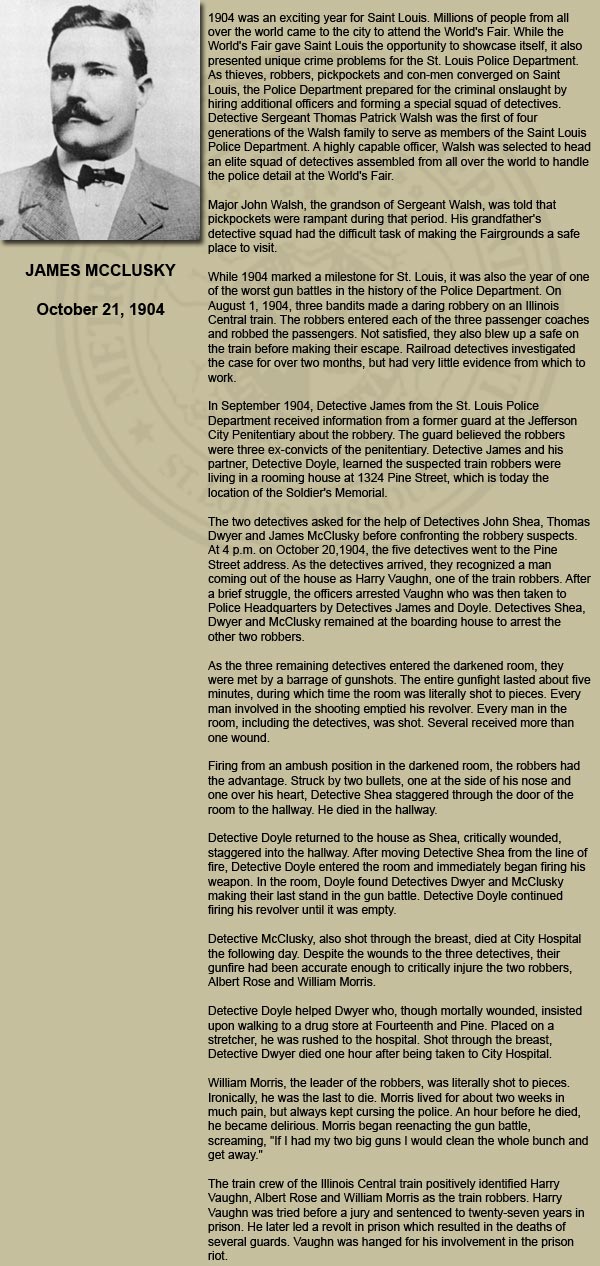 Date of death: October 21, 1904
Full Name: James McClusky
Content: 1904 was an exciting year for Saint Louis. Milions of people from all
over the world came to the city to attend the Worlds Fair. While the World's Fair gave Saint Louis the opportunity to showcase itself, it also
presented unique crime problems for the St. Louis Police Department.
As thieves, robbers, pickpockets and con-men converged on Saint
Lous, the Police Department prepared for the criminal onslaught by.
hiring additional officers and forming a special squad of detectives.
Detective Sergeant Thomas Patrick Waish was the first of four
generations of the Walsh family to serve as members of the Saint Louis
Police Department A highly capable officer, Walsh was selected to head
an elite squad of detectives assembled from all over the world to handle
the police detail at the World's Fair.
Major John Wash, the grandson of Sergeant Walsh, was fold that
pickpockets were rampant during that period. His grandfather's
detective squad had the difficult task of making the Fairgrounds a safe
place to visit.
While 1904 marked a milestone for St. Lois, it was also the year of one
of the worst gun battles in the history of the Police Department. On
August 1, 1904, three bandits made a daring robbery on an Illinois
Central train. The robbers entered each of the three passenger coaches
and robbed the passengers. Not satisfied, they also blew up a safe on
the train before making their escape. Railroad detectives investigated
the case for over two months, but had very tle evidence from which to
work.
In September 1904, Detective James from the St. Louis Police
Department received information from a former guard at the Jefferson
City Penitentiary about the robbery. The guard believed the robbers
were three ex-convicts of the penitentiary. Detective James and his
partner, Detective Doyle, learned the suspected train robbers were
living in a rooming house at 1324 Pine Street, which is today the
location of the Soldier's Memorial.
The two detectives asked for the help of Detectives John Shea, Thomas
Dwyer and James McClusky before confronting the robbery suspects.
AL4 p.m. on October 20,1904, the five defectives went to the Pine.
Street address. As the detectives arrived, they recognized a man
coming out of the house as Harry Vaughn, one of the train robbers. After
a brief struggle, the officers arrested Vaughn who was then taken to
Police Headquarters by Detectives James and Doyle. Detectives Shea,
Dwyer and McClusky remained at the boarding house to arrest the
other two robbers.
As the tee remaining detectives entered the darkened room, hey
were met by a barrage of gunshots. The entire gunfight lasted about five.
minutes, during which time the room was literally shot to pieces. Every
man involved in the shooting emptied his revolver. Every man in the
room, including the detectives, was shot Several received more than
one wound.
Firing from an ambush position in the darkened room, the robbers had
the advantage. Struck by two bullets, one at the side of his nose and
one over his heart, Defective Shea staggered through the door of the
room to the hallway. He died in the hallway.
Detective Doyle returned to the house as Shea, critically wounded,
staggered into the hallway. After moving Detective Shea from the line of
fire, Detective Doyle entered the room and immediately began firing his
weapon. In the room, Doyle found Detectives Dwyer and McClusky
making their last stand in the gun battle. Detective Doyle continued
firing his revolver unit was empty.
Detective McClusky, also shot through the breast, died at City Hospital
the following day. Despite the wounds to the three detectives, their
gunfire had been accurate enough to critically injure the two robbers,
Albert Rose and Wiliam Mortis.
Detective Doyle helped Dwyer who, though mortally wounded, insisted
upon walking to a drug store at Fourteenth and Pine. Placed on a
stretcher, he was rushed to the hospital. Shot through the breast,
Detective Dwyer died one hour after being taken to City Hospital.
William Moris, the leader of the robbers, was literally shot to pieces.
Ironically, he was the last to die. Morris lived for about two weeks in
much pain, but always kept cursing the police. An hour before he died,
he became delirious. Moris began reenacting the gun battle,
Screaming, If had my two big guns | would clean the whole bunch and
get away”
Date of death: October 21, 1904
Full Name: James McClusky
Content: 1904 was an exciting year for Saint Louis. Milions of people from all
over the world came to the city to attend the Worlds Fair. While the World's Fair gave Saint Louis the opportunity to showcase itself, it also
presented unique crime problems for the St. Louis Police Department.
As thieves, robbers, pickpockets and con-men converged on Saint
Lous, the Police Department prepared for the criminal onslaught by.
hiring additional officers and forming a special squad of detectives.
Detective Sergeant Thomas Patrick Waish was the first of four
generations of the Walsh family to serve as members of the Saint Louis
Police Department A highly capable officer, Walsh was selected to head
an elite squad of detectives assembled from all over the world to handle
the police detail at the World's Fair.
Major John Wash, the grandson of Sergeant Walsh, was fold that
pickpockets were rampant during that period. His grandfather's
detective squad had the difficult task of making the Fairgrounds a safe
place to visit.
While 1904 marked a milestone for St. Lois, it was also the year of one
of the worst gun battles in the history of the Police Department. On
August 1, 1904, three bandits made a daring robbery on an Illinois
Central train. The robbers entered each of the three passenger coaches
and robbed the passengers. Not satisfied, they also blew up a safe on
the train before making their escape. Railroad detectives investigated
the case for over two months, but had very tle evidence from which to
work.
In September 1904, Detective James from the St. Louis Police
Department received information from a former guard at the Jefferson
City Penitentiary about the robbery. The guard believed the robbers
were three ex-convicts of the penitentiary. Detective James and his
partner, Detective Doyle, learned the suspected train robbers were
living in a rooming house at 1324 Pine Street, which is today the
location of the Soldier's Memorial.
The two detectives asked for the help of Detectives John Shea, Thomas
Dwyer and James McClusky before confronting the robbery suspects.
AL4 p.m. on October 20,1904, the five defectives went to the Pine.
Street address. As the detectives arrived, they recognized a man
coming out of the house as Harry Vaughn, one of the train robbers. After
a brief struggle, the officers arrested Vaughn who was then taken to
Police Headquarters by Detectives James and Doyle. Detectives Shea,
Dwyer and McClusky remained at the boarding house to arrest the
other two robbers.
As the tee remaining detectives entered the darkened room, hey
were met by a barrage of gunshots. The entire gunfight lasted about five.
minutes, during which time the room was literally shot to pieces. Every
man involved in the shooting emptied his revolver. Every man in the
room, including the detectives, was shot Several received more than
one wound.
Firing from an ambush position in the darkened room, the robbers had
the advantage. Struck by two bullets, one at the side of his nose and
one over his heart, Defective Shea staggered through the door of the
room to the hallway. He died in the hallway.
Detective Doyle returned to the house as Shea, critically wounded,
staggered into the hallway. After moving Detective Shea from the line of
fire, Detective Doyle entered the room and immediately began firing his
weapon. In the room, Doyle found Detectives Dwyer and McClusky
making their last stand in the gun battle. Detective Doyle continued
firing his revolver unit was empty.
Detective McClusky, also shot through the breast, died at City Hospital
the following day. Despite the wounds to the three detectives, their
gunfire had been accurate enough to critically injure the two robbers,
Albert Rose and Wiliam Mortis.
Detective Doyle helped Dwyer who, though mortally wounded, insisted
upon walking to a drug store at Fourteenth and Pine. Placed on a
stretcher, he was rushed to the hospital. Shot through the breast,
Detective Dwyer died one hour after being taken to City Hospital.
William Moris, the leader of the robbers, was literally shot to pieces.
Ironically, he was the last to die. Morris lived for about two weeks in
much pain, but always kept cursing the police. An hour before he died,
he became delirious. Moris began reenacting the gun battle,
Screaming, If had my two big guns | would clean the whole bunch and
get away”
 Date of death: September 29, 1906
Full Name: Humphrey O’Leary
Content: Officer Humphrey O'Leary, a four year veteran of the force, was i
assigned to the Magnolia Avenue Station. O'Leary walked his beat in
the Tower Grove Park neighborhood, where he was beloved by the local
children.
On September 29, 1906, after a storm, the thirty-five year-old Officer
discovered downed electrical wires at 4311 Hunt. Concerned for the
Safety of the public, he tried to move the deadly wires with a sick. One.
wire was sputtering in the mud. For some reason, O'Leary decided to
pick the wire up while wearing buckskin gloves loaned to him by a
bystander.
When he grabbed the wire, he was electrocuted. O'Leary died
immediately. The valiant Officer was married and was the father of one
child.
Date of death: September 29, 1906
Full Name: Humphrey O’Leary
Content: Officer Humphrey O'Leary, a four year veteran of the force, was i
assigned to the Magnolia Avenue Station. O'Leary walked his beat in
the Tower Grove Park neighborhood, where he was beloved by the local
children.
On September 29, 1906, after a storm, the thirty-five year-old Officer
discovered downed electrical wires at 4311 Hunt. Concerned for the
Safety of the public, he tried to move the deadly wires with a sick. One.
wire was sputtering in the mud. For some reason, O'Leary decided to
pick the wire up while wearing buckskin gloves loaned to him by a
bystander.
When he grabbed the wire, he was electrocuted. O'Leary died
immediately. The valiant Officer was married and was the father of one
child.
 Date of death: March 31, 1907
Full Name: Lemuel R. Boyce
Content: Believing a police officer's job 100 risky for a widower with a small child
10 care for, Officer Lemuel Boyce decided to resign from the Police
Department in March 1907. He had his resignation approved and was
performing his fast shift on the night of March 30-31, 1907.
Boyce remained on duty though, unknown to him, his resignation had
taken effect several hours earlier. While Serving what he thought were
is last few minutes of duty, he heard of a burglary at a saloon on
Cardinal and Chouteau Avenues. Dedicated to the fast, he ran off is
beat to chase the suspects.
Boyce caught and scuffled with the two burglars. One of the suspects
fired three shots, hitting Boyce twice in the face and once in the chest.
Boyce died instantly. The suspects escaped with their loot, a total of
52.00. Boyce was born in 1876 and joined the force on October 8, 1906.
Date of death: March 31, 1907
Full Name: Lemuel R. Boyce
Content: Believing a police officer's job 100 risky for a widower with a small child
10 care for, Officer Lemuel Boyce decided to resign from the Police
Department in March 1907. He had his resignation approved and was
performing his fast shift on the night of March 30-31, 1907.
Boyce remained on duty though, unknown to him, his resignation had
taken effect several hours earlier. While Serving what he thought were
is last few minutes of duty, he heard of a burglary at a saloon on
Cardinal and Chouteau Avenues. Dedicated to the fast, he ran off is
beat to chase the suspects.
Boyce caught and scuffled with the two burglars. One of the suspects
fired three shots, hitting Boyce twice in the face and once in the chest.
Boyce died instantly. The suspects escaped with their loot, a total of
52.00. Boyce was born in 1876 and joined the force on October 8, 1906.
 Date of death: August 12, 1908
Full Name: Zeno Fults
Content: As Officer Zeno Fults left for work on August 12, 1908, he told his wife
not to worry about her dreams of danger. His remarks were made to
reassure Mrs. Fults of her safety. She had a dream the night before that
someone had broken into their home on Page Avenue. Fearing the
worst from her dream, she had discussed her concerns with her
husband.
At 7 p.m, Officer Fults and his partner, Officer Hart, were at
Twenty-third and Market. They were told that John Thornton, wanted for
Shooting his brother-in-law, was hiding at 2308 Chestnut.
Officer Hart went to the font of the Chestnut address while Officer Fults
covered the back door. As Fults opened the back door, Thornton
opened fire. Wounded in the arm, Fults retuned fire, striking Thorton
three times. Thornton again fired. A bullet pierced Fult's heart, killing him
instant.
Thornton, though wounded, escaped from the scene. He was later
captured at his father's residence, located at Chippewa and Gravois.
Thornton was convicted of the murder of Officer Fults and sentenced to
prison for life. Thirty-one year-old Officer Fults had been married for
nine years. He left a widow and two sons.
Date of death: August 12, 1908
Full Name: Zeno Fults
Content: As Officer Zeno Fults left for work on August 12, 1908, he told his wife
not to worry about her dreams of danger. His remarks were made to
reassure Mrs. Fults of her safety. She had a dream the night before that
someone had broken into their home on Page Avenue. Fearing the
worst from her dream, she had discussed her concerns with her
husband.
At 7 p.m, Officer Fults and his partner, Officer Hart, were at
Twenty-third and Market. They were told that John Thornton, wanted for
Shooting his brother-in-law, was hiding at 2308 Chestnut.
Officer Hart went to the font of the Chestnut address while Officer Fults
covered the back door. As Fults opened the back door, Thornton
opened fire. Wounded in the arm, Fults retuned fire, striking Thorton
three times. Thornton again fired. A bullet pierced Fult's heart, killing him
instant.
Thornton, though wounded, escaped from the scene. He was later
captured at his father's residence, located at Chippewa and Gravois.
Thornton was convicted of the murder of Officer Fults and sentenced to
prison for life. Thirty-one year-old Officer Fults had been married for
nine years. He left a widow and two sons.
 Date of death: October 25, 1908
Full Name: Edward Dellmore
Content: Probationary Police Officer Edward Dellmore died on October 25, 1908,
from injuries, he sustained several months earlier. In May 1908, he was
involved in a fight with an obstinate prisoner. In the struggle, Delimore
received blows and kicks to his head and abdomen. After the fight he
complained of pains in his stomach and head, but continued his service.
On October 13, 1908, he became ill Twelve days later, he died. His
death was the result of a blood clot on the brain and an abdominal
abscess. Twenty-five year-old Dellmore was married and had two
children. He had been on the force only since September 1907.
Date of death: October 25, 1908
Full Name: Edward Dellmore
Content: Probationary Police Officer Edward Dellmore died on October 25, 1908,
from injuries, he sustained several months earlier. In May 1908, he was
involved in a fight with an obstinate prisoner. In the struggle, Delimore
received blows and kicks to his head and abdomen. After the fight he
complained of pains in his stomach and head, but continued his service.
On October 13, 1908, he became ill Twelve days later, he died. His
death was the result of a blood clot on the brain and an abdominal
abscess. Twenty-five year-old Dellmore was married and had two
children. He had been on the force only since September 1907.
 Date of death: August 8, 1911
Full Name: Cornelius O’Keefe
Content: To the officers of the Central District, Comelius O'Keefe was known as a
tough cop—a policeman who made many daring arrests during his
career. But that career ended abruptly on the evening of August 8, 1911.
Officer O'Keefe walked one of the toughest beats in the downtown area.
On August 8, 1811, he patrolled his beat, looking for Remus Hawshaw,
who was wanted for assault. At 10:55 p.m. just five minutes before he
was to have been relieved from duty, O'Keefe was killed. One bullet
entered his body just above the heart. Shot at point blank range, he lay
In the rear of the Chouris Candy Store, located at 1308 Olive until
helped arrived.
A violent thunderstorm prevented the shots from being heard. The
wounded officer lay on the ground about fifteen minutes after being
shot. When other officers found him, the wounded officer could only say.
he had been shot by a black man. He then lost consciousness. He was
taken to City Hospital, where he died a few hours later.
It was first believed that Officer O'Keefe was shot by a burglar who had
gained entrance to the candy store. As the investigation continued,
evidence mounted which led police to believe that Remus Hawshaw
actually killed the officer.
A witness who lived across the alley from the scene of the shooting saw.
Hawshaw in the area. Hawshaw now became a suspect in the murder
of the officer. The day after the murder, Hawshaw surrendered for the
assault.
Hawshaw denied responsibility for the death of O'Keefe, but an aggressive investigation into the Officer's death revealed Hawshaw’s alibi for
the time of the shooting to be false. The investigation further disclosed
that Hawshaw knew O'Keefe was looking for him. He became the prime
suspect.
Many of Officer O'Keefe’s exploits were widely known throughout the
Police Department. Although he had been wounded several times
before, he always managed to recover. He was even once attacked by
a large female who plunged a pair of scissors into him. Though injured,
O'Keefe still managed to drag the woman to the Station before receiving
medical treatment. The scissors missed his heart by only a fraction of
an inch.
Just months before his death, he was shot n the hand while capturing a
burglar. In another incident Officer O'Keefe won praise when he "captured a maniac on Market Street by dancing like a rained bear to
amuse the insane man.” As quoted in the paper, "Gradually approaching the maniac as he danced around him, O'Keefe took two revolvers
from him and overpowered him.
Officer O'Keefe had been on the department twelve years. He was a
bachelor, forty-two years of age, and lived at 1221 Mississippi at the
time of his death.
Date of death: August 8, 1911
Full Name: Cornelius O’Keefe
Content: To the officers of the Central District, Comelius O'Keefe was known as a
tough cop—a policeman who made many daring arrests during his
career. But that career ended abruptly on the evening of August 8, 1911.
Officer O'Keefe walked one of the toughest beats in the downtown area.
On August 8, 1811, he patrolled his beat, looking for Remus Hawshaw,
who was wanted for assault. At 10:55 p.m. just five minutes before he
was to have been relieved from duty, O'Keefe was killed. One bullet
entered his body just above the heart. Shot at point blank range, he lay
In the rear of the Chouris Candy Store, located at 1308 Olive until
helped arrived.
A violent thunderstorm prevented the shots from being heard. The
wounded officer lay on the ground about fifteen minutes after being
shot. When other officers found him, the wounded officer could only say.
he had been shot by a black man. He then lost consciousness. He was
taken to City Hospital, where he died a few hours later.
It was first believed that Officer O'Keefe was shot by a burglar who had
gained entrance to the candy store. As the investigation continued,
evidence mounted which led police to believe that Remus Hawshaw
actually killed the officer.
A witness who lived across the alley from the scene of the shooting saw.
Hawshaw in the area. Hawshaw now became a suspect in the murder
of the officer. The day after the murder, Hawshaw surrendered for the
assault.
Hawshaw denied responsibility for the death of O'Keefe, but an aggressive investigation into the Officer's death revealed Hawshaw’s alibi for
the time of the shooting to be false. The investigation further disclosed
that Hawshaw knew O'Keefe was looking for him. He became the prime
suspect.
Many of Officer O'Keefe’s exploits were widely known throughout the
Police Department. Although he had been wounded several times
before, he always managed to recover. He was even once attacked by
a large female who plunged a pair of scissors into him. Though injured,
O'Keefe still managed to drag the woman to the Station before receiving
medical treatment. The scissors missed his heart by only a fraction of
an inch.
Just months before his death, he was shot n the hand while capturing a
burglar. In another incident Officer O'Keefe won praise when he "captured a maniac on Market Street by dancing like a rained bear to
amuse the insane man.” As quoted in the paper, "Gradually approaching the maniac as he danced around him, O'Keefe took two revolvers
from him and overpowered him.
Officer O'Keefe had been on the department twelve years. He was a
bachelor, forty-two years of age, and lived at 1221 Mississippi at the
time of his death.
 Date of death: June 2, 1912
Full Name: Louis Schnarr
Content: George Wiggins, a twenty-year-old “wayward son of respectable parents,” shot and killed Officer Louis Schnarr outside a restaurant at
1403 Chouteau. The owner had barred Wiggins from the restaurant for unpaid bills, On June 3, 1912, he returned to the restaurant with a
revolver, shouting "I'm going to clean out your dump” The restaurant owner's wife pushed Wiggins out the front door and locked it. Wiggins
began hammering on the door and shouting Officer Schnarr heard the disturbance and ran up to Wiggins. Wiggins
turned and fired three shots at Schnarr. Schnar died almost immediately. Wiggins ran from the scene of the murder and boarded a train. He
Was arrested a few hours after in Kimmswick, Missouri Schnarr was born in 1881. In 1907, he joined the force. He had a wife and two children. His wife reported that he had a premonition of danger that day and had been reluctant to leave for work. After kissing his wife goodbye, Schnarr left home, only to return a few moments later to give her another kiss goodbye. She would never again see him alive.
Date of death: June 2, 1912
Full Name: Louis Schnarr
Content: George Wiggins, a twenty-year-old “wayward son of respectable parents,” shot and killed Officer Louis Schnarr outside a restaurant at
1403 Chouteau. The owner had barred Wiggins from the restaurant for unpaid bills, On June 3, 1912, he returned to the restaurant with a
revolver, shouting "I'm going to clean out your dump” The restaurant owner's wife pushed Wiggins out the front door and locked it. Wiggins
began hammering on the door and shouting Officer Schnarr heard the disturbance and ran up to Wiggins. Wiggins
turned and fired three shots at Schnarr. Schnar died almost immediately. Wiggins ran from the scene of the murder and boarded a train. He
Was arrested a few hours after in Kimmswick, Missouri Schnarr was born in 1881. In 1907, he joined the force. He had a wife and two children. His wife reported that he had a premonition of danger that day and had been reluctant to leave for work. After kissing his wife goodbye, Schnarr left home, only to return a few moments later to give her another kiss goodbye. She would never again see him alive.
 Date of death: November 17, 1912
Full Name: Arthur M. Huddleston
Content: On November 17, 1912, Patrolman Arthur M. Huddleston became the
thirty-fifth St. Louis City Police Officer to die in the fine of duty. The fact
that he died while coming to the aid of a fellow officer shows the Kind of
man he was. That he was killed by a recently paroled murderer is
indicative of the problems of the criminal justice system, both then and
now.
Albert Whitefield a long-term convict, had served only half of his
sentence when he was released from the Missouri Penitentiary on a
“Holiday Parole" by the Governor for good behavior in 1908. On
November 17,1912, about 12:50 a.m., Officers William Kelly and
Huddleston heard a woman screaming in the rear alley of 2012 |
Washington. Unknown to the officers, Whitefield had broken into the
house and was flourishing a knife at the woman. He then fled out the
back door and into the alley.
At Washington and Ewing, the two officers split up in their search for the
suspect Officer Kelly began searching the alley when Whitefield i
jumped from behind a telephone pole and wrestled the officers gun
from him. Breaking free from the Officer, Whitefield ran from the alley.
Kelly then rapped his nightstick on the sidewalk to call for help.
Officer Huddleston, with his flashlight on, came running to Kelly's aid.
The flashlight proved to be an easy target as Whitefield fired one shot,
striking Huddleston in the heart, killing him instantly. Officer Kelly
advanced on Whitefield, who then shot Kelly in the hand.
As Whitefield fled from the scene, he ran to the Fourteenth Street
Bridge where he also shot another police officer and a watchman.
Whitefield then jumped from the bridge and info the railroad yards.
About forty officers from two police districts converged on the rail-yards
in the area of the Fourteenth Street Bridge to search for Whitefield.
Whitefield was located and a gun battle between Whitefield and the
officers commenced. Though officers fired about fifty rounds at the
suspect, the twice wounded Whitefield managed to escape. He was
captured two days after in Gorham, lino. Later, hie was prosecuted,
convicted and sentenced to life Imprisonment for the murder of Officer
Huddleston.
The tragedy of Officer Huddlesion's death is that he was killed by a
convicted murderer who was paroled for “good behavior” The offer
tragedy is that Whitefield was only sentenced to life imprisonment for
the murder of the police officer and was not sentenced to death.
Date of death: November 17, 1912
Full Name: Arthur M. Huddleston
Content: On November 17, 1912, Patrolman Arthur M. Huddleston became the
thirty-fifth St. Louis City Police Officer to die in the fine of duty. The fact
that he died while coming to the aid of a fellow officer shows the Kind of
man he was. That he was killed by a recently paroled murderer is
indicative of the problems of the criminal justice system, both then and
now.
Albert Whitefield a long-term convict, had served only half of his
sentence when he was released from the Missouri Penitentiary on a
“Holiday Parole" by the Governor for good behavior in 1908. On
November 17,1912, about 12:50 a.m., Officers William Kelly and
Huddleston heard a woman screaming in the rear alley of 2012 |
Washington. Unknown to the officers, Whitefield had broken into the
house and was flourishing a knife at the woman. He then fled out the
back door and into the alley.
At Washington and Ewing, the two officers split up in their search for the
suspect Officer Kelly began searching the alley when Whitefield i
jumped from behind a telephone pole and wrestled the officers gun
from him. Breaking free from the Officer, Whitefield ran from the alley.
Kelly then rapped his nightstick on the sidewalk to call for help.
Officer Huddleston, with his flashlight on, came running to Kelly's aid.
The flashlight proved to be an easy target as Whitefield fired one shot,
striking Huddleston in the heart, killing him instantly. Officer Kelly
advanced on Whitefield, who then shot Kelly in the hand.
As Whitefield fled from the scene, he ran to the Fourteenth Street
Bridge where he also shot another police officer and a watchman.
Whitefield then jumped from the bridge and info the railroad yards.
About forty officers from two police districts converged on the rail-yards
in the area of the Fourteenth Street Bridge to search for Whitefield.
Whitefield was located and a gun battle between Whitefield and the
officers commenced. Though officers fired about fifty rounds at the
suspect, the twice wounded Whitefield managed to escape. He was
captured two days after in Gorham, lino. Later, hie was prosecuted,
convicted and sentenced to life Imprisonment for the murder of Officer
Huddleston.
The tragedy of Officer Huddlesion's death is that he was killed by a
convicted murderer who was paroled for “good behavior” The offer
tragedy is that Whitefield was only sentenced to life imprisonment for
the murder of the police officer and was not sentenced to death.
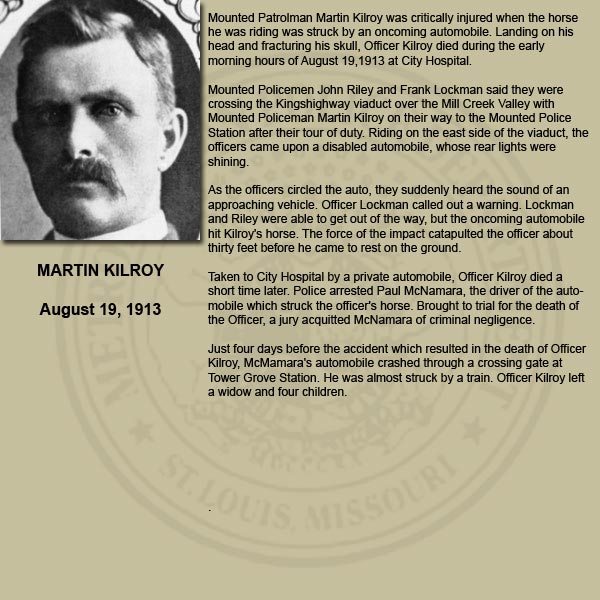 Date of death: August 19, 1913
Full Name: Martin Kilroy
Content: Mounted Patrolman Martin Kiroy was critically injured when the horse
he was riding was struck by an oncoming automobile. Landing on his
head and fracturing his skull, Officer Kilroy died during the early
morning hours of August 19,1913 at City Hospital.
Mounted Policemen John Riley and Frank Lockman said they were
crossing the Kingshighway viaduct over the Mill Creek Valley with
Mounted Policeman Martin Kilroy on their way to the Mounted Police
Station after their tour of duty. Riding on the east side of the viaduct, the
officers came upon a disabled automobile, whose rear lights were shining.
As the officers circled the auto, they suddenly heard the sound of an approaching vehicle. Officer Lockman called out a warming. Lockman
and Riley were able to get out of the way, but the oncoming automobile
hit Kiroy's horse. The force of the impact catapulted the officer about
thirty feet before he came to rest on the ground.
Taken to City Hospital by a private automobile, Officer Kilroy died a
short time later. Police arrested Paul McNamara, the driver of the automobile which struck the officer's horse. Brought to rial for the death of
the Officer, a jury acquitted McNamara of criminal negligence.
Just four days before the accident which resulted in the death of Officer Kilroy, McMamara's automobile crashed through a crossing gate at Tower Grove Station. He was almost struck by a rain. Offer Kilroy lefta widow and four children.
Date of death: August 19, 1913
Full Name: Martin Kilroy
Content: Mounted Patrolman Martin Kiroy was critically injured when the horse
he was riding was struck by an oncoming automobile. Landing on his
head and fracturing his skull, Officer Kilroy died during the early
morning hours of August 19,1913 at City Hospital.
Mounted Policemen John Riley and Frank Lockman said they were
crossing the Kingshighway viaduct over the Mill Creek Valley with
Mounted Policeman Martin Kilroy on their way to the Mounted Police
Station after their tour of duty. Riding on the east side of the viaduct, the
officers came upon a disabled automobile, whose rear lights were shining.
As the officers circled the auto, they suddenly heard the sound of an approaching vehicle. Officer Lockman called out a warming. Lockman
and Riley were able to get out of the way, but the oncoming automobile
hit Kiroy's horse. The force of the impact catapulted the officer about
thirty feet before he came to rest on the ground.
Taken to City Hospital by a private automobile, Officer Kilroy died a
short time later. Police arrested Paul McNamara, the driver of the automobile which struck the officer's horse. Brought to rial for the death of
the Officer, a jury acquitted McNamara of criminal negligence.
Just four days before the accident which resulted in the death of Officer Kilroy, McMamara's automobile crashed through a crossing gate at Tower Grove Station. He was almost struck by a rain. Offer Kilroy lefta widow and four children.
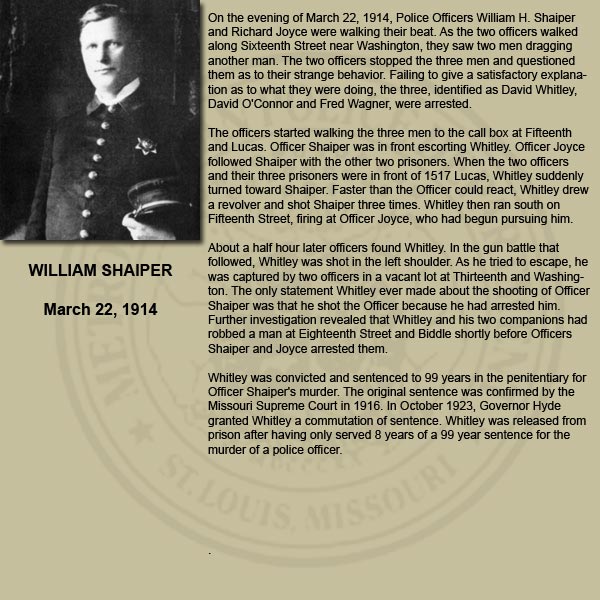 Date of death: March 22, 1914
Full Name: William Shaiper
Content: On the evening of March 22, 1914, Police Officers William H. Shaiper
and Richard Joyce were walking their beat. As the two officers waked
along Sixteenth Street near Washington, hey Saw two men dragging
another man. The two officers stopped the three men and questioned
them as to their strange behavior. Failing to give a satisfactory explanation as to what they were doing, the three, identified as David Whitley,
David O'Connor and Fred Wagner, were arrested.
The officers started walking the three men to the call box at Fifteenth
and Lucas. Officer Shaiper was in front escorting Whilley. Officer Joyce
followed Shaiper with the other two prisoners. When the two officers
and their three prisoners were in front of 1517 Lucas Whitley suddenly
turned toward Shaiper. Faster than the Officer could react, Whitley drew
a revolver and shot Shaiper three times. Whitley then ran South on
Fifteenth Street, firng at Officer Joyce, who had begun pursuing him.
About a half our later officers found Whitley. In the gun battle that
followed, Whitley was shot in the left shoulder. As he tried 10 escape, he
was captured by two officers in a vacant lot a Thirteenth and Washington. The only statement Whitley ever made about the shooting of Officer
Shaiper was that he shot the Officer because he had arrested him.
Further investigation revealed that Whitey and his two companions had
robbed a man at Eighteenth Street and Biddle shorty before Officers
Shaiper and Joyce arrested them.
Whitley was convicted and sentenced to 99 years in the penitentiary for
Officer Shaiper's murder. The original sentence was confirmed by the
Missouri Supreme Court in 1816. In October 1923, Governor Hyde
granted Whitley 2 commutation of sentence. Whitley was released from
prison after having only served 8 years of a 99 year sentence for the
murder of a police officer.
Date of death: March 22, 1914
Full Name: William Shaiper
Content: On the evening of March 22, 1914, Police Officers William H. Shaiper
and Richard Joyce were walking their beat. As the two officers waked
along Sixteenth Street near Washington, hey Saw two men dragging
another man. The two officers stopped the three men and questioned
them as to their strange behavior. Failing to give a satisfactory explanation as to what they were doing, the three, identified as David Whitley,
David O'Connor and Fred Wagner, were arrested.
The officers started walking the three men to the call box at Fifteenth
and Lucas. Officer Shaiper was in front escorting Whilley. Officer Joyce
followed Shaiper with the other two prisoners. When the two officers
and their three prisoners were in front of 1517 Lucas Whitley suddenly
turned toward Shaiper. Faster than the Officer could react, Whitley drew
a revolver and shot Shaiper three times. Whitley then ran South on
Fifteenth Street, firng at Officer Joyce, who had begun pursuing him.
About a half our later officers found Whitley. In the gun battle that
followed, Whitley was shot in the left shoulder. As he tried 10 escape, he
was captured by two officers in a vacant lot a Thirteenth and Washington. The only statement Whitley ever made about the shooting of Officer
Shaiper was that he shot the Officer because he had arrested him.
Further investigation revealed that Whitey and his two companions had
robbed a man at Eighteenth Street and Biddle shorty before Officers
Shaiper and Joyce arrested them.
Whitley was convicted and sentenced to 99 years in the penitentiary for
Officer Shaiper's murder. The original sentence was confirmed by the
Missouri Supreme Court in 1816. In October 1923, Governor Hyde
granted Whitley 2 commutation of sentence. Whitley was released from
prison after having only served 8 years of a 99 year sentence for the
murder of a police officer.
 Date of death: May 2, 1914
Full Name: Charles Benderoth
Content: On April 20, 1914, Motorcycle Officer Charles Benderoth died as a
result o injuries sustained in a traffic accident. Turning onto Boyle from
Lindell on his way to the Laclede Avenue Station, Benderoth's motor-
cycle was struck by a car driven by Donald McArthur.
Officer Benderoth's extensive injuries included a skull fracture. One.
week after the accident, the thirty-three year-old officer came down with
meningitis. Despite the efforts of his physician, Officer Benderoth soon
died. The coroner exonerated Donald McArthur of any criminal
negligence in the accident. Benderoth was married at the time of his
death
Date of death: May 2, 1914
Full Name: Charles Benderoth
Content: On April 20, 1914, Motorcycle Officer Charles Benderoth died as a
result o injuries sustained in a traffic accident. Turning onto Boyle from
Lindell on his way to the Laclede Avenue Station, Benderoth's motor-
cycle was struck by a car driven by Donald McArthur.
Officer Benderoth's extensive injuries included a skull fracture. One.
week after the accident, the thirty-three year-old officer came down with
meningitis. Despite the efforts of his physician, Officer Benderoth soon
died. The coroner exonerated Donald McArthur of any criminal
negligence in the accident. Benderoth was married at the time of his
death
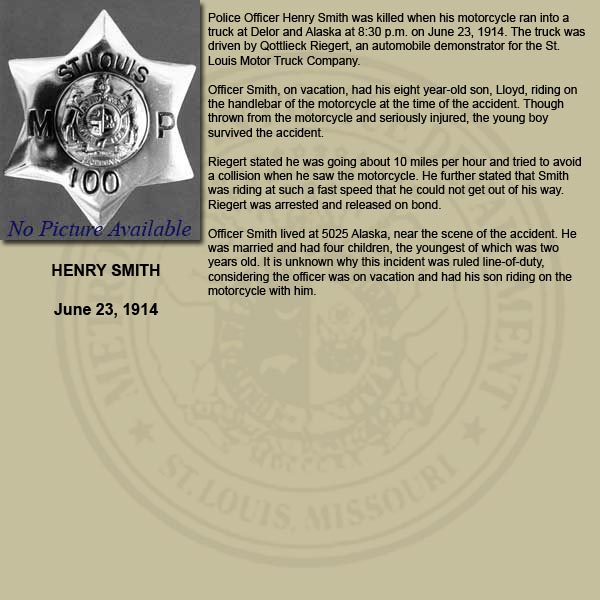 Date of death: June 23, 1914
Full Name: Henry Smith
Content: Police Officer Henry Smith was killed when his motorcycle ran info a
truck at Delor and Alaska at 8:30 p.m. on June 23, 1914. The truck was.
driven by Qottiieck Rieger, an automobile demonstrator for the St.
Louis Motor Truck Company.
Officer Smith, on vacation, had his eight year-old son, Lloyd, riding on
the handlebar of the motorcycle at the time of the accident Though
thrown from the motorcycle and seriously injured, the young boy
survived the accident.
Riegert stated he was going about 10 miles per hour and tried to avoid
a collision when he saw the motorcycle. He further stated that Smith
was riding at such a fast speed that he could not get out of his way.
Riegert was arrested and released on bond
Officer Smith lived at 5025 Alaska, near the scene of the accident. He
was married and had four children, the youngest of which was two.
years old. It is unknown why this incident was ruled line-of-duty,
considering the officer was on vacation and had his son riding on the
‘motorcycle with him.
Date of death: June 23, 1914
Full Name: Henry Smith
Content: Police Officer Henry Smith was killed when his motorcycle ran info a
truck at Delor and Alaska at 8:30 p.m. on June 23, 1914. The truck was.
driven by Qottiieck Rieger, an automobile demonstrator for the St.
Louis Motor Truck Company.
Officer Smith, on vacation, had his eight year-old son, Lloyd, riding on
the handlebar of the motorcycle at the time of the accident Though
thrown from the motorcycle and seriously injured, the young boy
survived the accident.
Riegert stated he was going about 10 miles per hour and tried to avoid
a collision when he saw the motorcycle. He further stated that Smith
was riding at such a fast speed that he could not get out of his way.
Riegert was arrested and released on bond
Officer Smith lived at 5025 Alaska, near the scene of the accident. He
was married and had four children, the youngest of which was two.
years old. It is unknown why this incident was ruled line-of-duty,
considering the officer was on vacation and had his son riding on the
‘motorcycle with him.
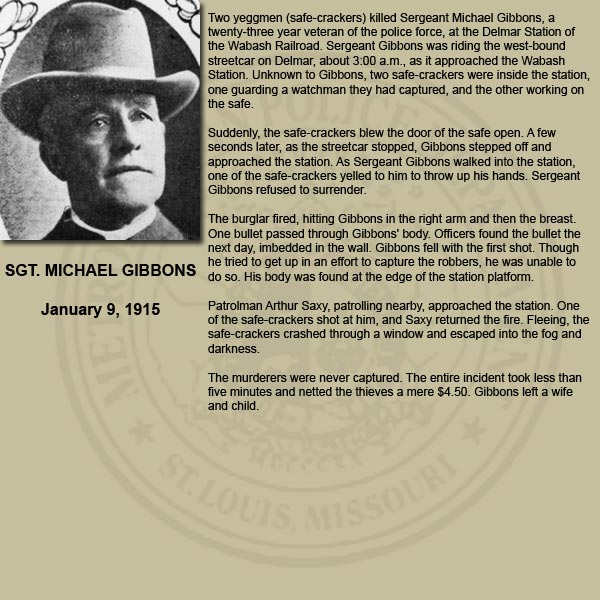 Date of death: January 9, 1915
Full Name: Sgt. Michael Gibbons
Content: Two yeggmen (safe-crackers) killed Sergeant Michael Gibbons, a
twenty-three year veteran of the police force, at the Delmar Station of
the Wabash Ralload. Sergeant Gibbons was riding the west-bound
streetcar on Delmar, about 300 2m. as it approached the Wabash
Station. Unknown to Gibbons, two safe-crackers were inside the station,
one guarding a watchman they had captured, and the other working on
the safe.
Suddenly, the safe-crackers blew the door of the safe open. A few
seconds later, as the streetcar stopped, Gibbons stepped off and
approached the station. As Sergeant Gibbons walked info the station,
one of the safe-crackers yelled to him to throw up his hands. Sergeant.
Gibbons refused to Surender.
The burglar fired, hitting Gibbons in the right arm and then the breast.
One bullet passed through Gibbons body. Officers found the bullet the
next day, imbedded in the wall. Gibbons fell with the first shot. Though
he tried to get up in an effort to capture the robbers, he was unable to
do so. His body was found at the edge of the station platform.
Patrolman Arthur Saxy, patrolling nearby, approached the station. One
of the safe-crackers shot at him, and Saxy returned the fie. Fleeing, the
safe-crackers crashed through a window and escaped into the fog and
darkness.
The murderers were never captured. The entire incident took less than
five minutes and netted the thieves a mere $4.50. Gibbons left a wife
and child.
Date of death: January 9, 1915
Full Name: Sgt. Michael Gibbons
Content: Two yeggmen (safe-crackers) killed Sergeant Michael Gibbons, a
twenty-three year veteran of the police force, at the Delmar Station of
the Wabash Ralload. Sergeant Gibbons was riding the west-bound
streetcar on Delmar, about 300 2m. as it approached the Wabash
Station. Unknown to Gibbons, two safe-crackers were inside the station,
one guarding a watchman they had captured, and the other working on
the safe.
Suddenly, the safe-crackers blew the door of the safe open. A few
seconds later, as the streetcar stopped, Gibbons stepped off and
approached the station. As Sergeant Gibbons walked info the station,
one of the safe-crackers yelled to him to throw up his hands. Sergeant.
Gibbons refused to Surender.
The burglar fired, hitting Gibbons in the right arm and then the breast.
One bullet passed through Gibbons body. Officers found the bullet the
next day, imbedded in the wall. Gibbons fell with the first shot. Though
he tried to get up in an effort to capture the robbers, he was unable to
do so. His body was found at the edge of the station platform.
Patrolman Arthur Saxy, patrolling nearby, approached the station. One
of the safe-crackers shot at him, and Saxy returned the fie. Fleeing, the
safe-crackers crashed through a window and escaped into the fog and
darkness.
The murderers were never captured. The entire incident took less than
five minutes and netted the thieves a mere $4.50. Gibbons left a wife
and child.
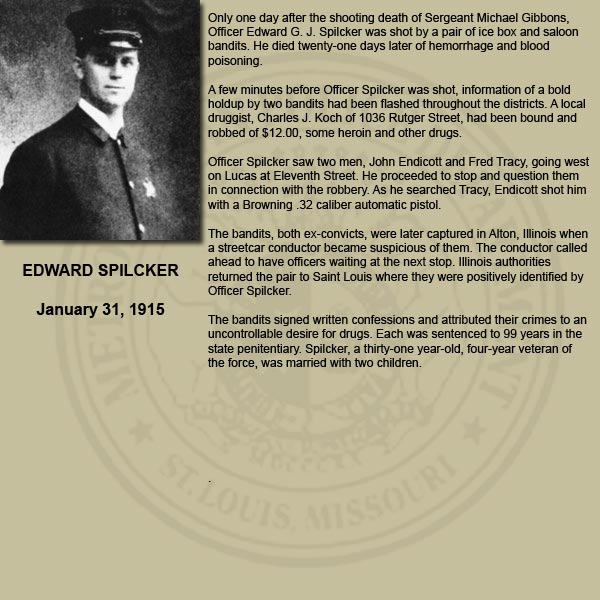 Date of death: January 31, 1915
Full Name: Edward G.J. Spilcker
Content: Only one day after the shooting death of Sergeant Michael Gibbons,
Officer Edward G. J. Spilcker was shot by a pair of ice box and saloon
bands. He died twenty-one days later of hemorrhage and blood
poisoning.
A few minutes before Officer Spilcker was shot, information of a bold
holdup by two bandits had been flashed throughout the districts. A local
druggist, Charles J. Koch of 1036 Rutger Street, had been bound and
robbed of $12.00, some heroin and other drugs.
Officer Spilcker saw two men, John Endicott and Fred Tracy, going west
on Lucas at Eleventh Street. He proceeded to stop and question them
in connection with the robbery. As he searched Tracy, Endicott shot him
with a Browning 32 caliber automatic pistol.
The bandits, both ex-convicts, were later captured in Alton, Illinois when
a streetcar conductor became suspicious of them. The conductor called
ahead to have officers waiting at the next stop. Illinois authorities
returned the pair to Saint Louis where they were positively identified by
Officer Spilcker.
The bandits signed written confessions and attributed their crimes to an
uncontrollable desire for drugs. Each was sentenced to 99 years in the
state penitentiary. Spilcker, a thirty-one year-old, four-year veteran of
the force, was married with two children.
Date of death: January 31, 1915
Full Name: Edward G.J. Spilcker
Content: Only one day after the shooting death of Sergeant Michael Gibbons,
Officer Edward G. J. Spilcker was shot by a pair of ice box and saloon
bands. He died twenty-one days later of hemorrhage and blood
poisoning.
A few minutes before Officer Spilcker was shot, information of a bold
holdup by two bandits had been flashed throughout the districts. A local
druggist, Charles J. Koch of 1036 Rutger Street, had been bound and
robbed of $12.00, some heroin and other drugs.
Officer Spilcker saw two men, John Endicott and Fred Tracy, going west
on Lucas at Eleventh Street. He proceeded to stop and question them
in connection with the robbery. As he searched Tracy, Endicott shot him
with a Browning 32 caliber automatic pistol.
The bandits, both ex-convicts, were later captured in Alton, Illinois when
a streetcar conductor became suspicious of them. The conductor called
ahead to have officers waiting at the next stop. Illinois authorities
returned the pair to Saint Louis where they were positively identified by
Officer Spilcker.
The bandits signed written confessions and attributed their crimes to an
uncontrollable desire for drugs. Each was sentenced to 99 years in the
state penitentiary. Spilcker, a thirty-one year-old, four-year veteran of
the force, was married with two children.
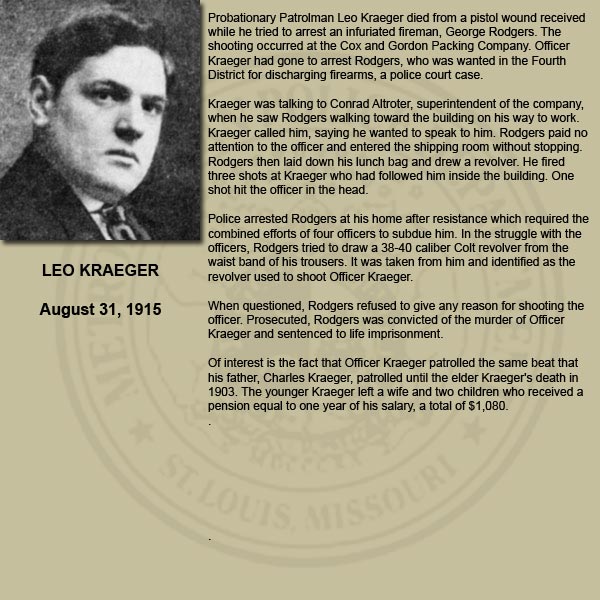 Date of death: August 31,1915
Full Name: Leo Kraeger
Content: Probationary Patrolman Leo Kraeger died from a pistol wound received
while he tried to arrest an infuriated fireman, George Rodgers. The.
shooting occurred at the Cox and Gordon Packing Company. Officer
Kraeger had gone to arrest Rodgers, who was wanted in the Fourth
District for discharging firearms, a police court case.
Kraeger was talking to Conrad Altroter, superintendent of the company,
when he saw Rodgers walking toward the building on his way to work.
Kraeger called him, saying he wanted to speak to him. Rodgers paid no
attention to the officer and entered the shipping room without stopping
Rodgers then laid down his lunch bag and drew a revolver. He fired
three shots at Kraeger who had followed him inside the building. One
shot hit the officer in the head.
Police arrested Rodgers at his home after resistance which required the
combined efforts of four officers to subdue him. In the struggle with the
officers, Rodgers tried to draw a 33-40 caliber Colt revolver from the
waist band of his trousers. It was taken from him and identified as the
revolver used to shoot Officer Kraeger.
When questioned, Rodgers refused to give any reason for shooting the
officer. Prosecuted, Rodgers was convicted of the murder of Officer
Kraeger and sentenced to life Imprisonment.
Of interest is the fact that Officer Kraeger patrolled the same beat that
his father, Charles Kraeger, patrolled until the elder Kraeger's death in
1903. The younger Kraeger left a wife and two children who received a
pension equal to one year of his salary, a total of $1,080.
Date of death: August 31,1915
Full Name: Leo Kraeger
Content: Probationary Patrolman Leo Kraeger died from a pistol wound received
while he tried to arrest an infuriated fireman, George Rodgers. The.
shooting occurred at the Cox and Gordon Packing Company. Officer
Kraeger had gone to arrest Rodgers, who was wanted in the Fourth
District for discharging firearms, a police court case.
Kraeger was talking to Conrad Altroter, superintendent of the company,
when he saw Rodgers walking toward the building on his way to work.
Kraeger called him, saying he wanted to speak to him. Rodgers paid no
attention to the officer and entered the shipping room without stopping
Rodgers then laid down his lunch bag and drew a revolver. He fired
three shots at Kraeger who had followed him inside the building. One
shot hit the officer in the head.
Police arrested Rodgers at his home after resistance which required the
combined efforts of four officers to subdue him. In the struggle with the
officers, Rodgers tried to draw a 33-40 caliber Colt revolver from the
waist band of his trousers. It was taken from him and identified as the
revolver used to shoot Officer Kraeger.
When questioned, Rodgers refused to give any reason for shooting the
officer. Prosecuted, Rodgers was convicted of the murder of Officer
Kraeger and sentenced to life Imprisonment.
Of interest is the fact that Officer Kraeger patrolled the same beat that
his father, Charles Kraeger, patrolled until the elder Kraeger's death in
1903. The younger Kraeger left a wife and two children who received a
pension equal to one year of his salary, a total of $1,080.
 Date of death: November 25, 1915
Full Name: Charles F. Barmeier
Content: On this November night, William Street, the Assistant Chief of Police at
Madison, Illinois, entered John Holzwed's Saloon, in search of his wife,
Catherine. He found her there in an intoxicated condition, drinking with
Harry Gilbert. Due to domestic problems, Street and his wife had been
lining apart. Enraged, Street knocked Gilbert down with a leather billy,
drew a revolver and threatened his Iife.
Gilbert, in a panic, ran from the saloon. Street, with revolver in hand,
threatened the bartender for selling his wife liquor. Clutching his wife by
the wrist, he then forced her to accompany him toward her home. She
broke away from him and ran into the alley in the rear of 915 Salisbury.
Street, screaming for help.
Patrolman Charles Barmeier, on a streetcar on his way to report for duty
at 11 pm, heard her call for help. The dedicated officer left the streetcar
and hurried to the location from which the calls for help originated. As
Barmeier entered the alley to investigate, shooting began immediately.
One bullet slammed into Barmeier's chest, another bullet entered Mrs.
Streets left side. Both wounds would prove fatal.
The post-mortem examination of Barmeier and Catherine Street
revealed that both were killed by 32 caliber bullets. The source of the
32 caliber bullets created a mystery for both the investigators and the
prosecution. The guns taken from Street and from Officer Barmeier
were 38 caliber. Though the murder case appeared to be clear-cut, a
jury acquitted Street of the murder of Patrolman Barmeier and his wife
because the state could not produce is witnesses.
Date of death: November 25, 1915
Full Name: Charles F. Barmeier
Content: On this November night, William Street, the Assistant Chief of Police at
Madison, Illinois, entered John Holzwed's Saloon, in search of his wife,
Catherine. He found her there in an intoxicated condition, drinking with
Harry Gilbert. Due to domestic problems, Street and his wife had been
lining apart. Enraged, Street knocked Gilbert down with a leather billy,
drew a revolver and threatened his Iife.
Gilbert, in a panic, ran from the saloon. Street, with revolver in hand,
threatened the bartender for selling his wife liquor. Clutching his wife by
the wrist, he then forced her to accompany him toward her home. She
broke away from him and ran into the alley in the rear of 915 Salisbury.
Street, screaming for help.
Patrolman Charles Barmeier, on a streetcar on his way to report for duty
at 11 pm, heard her call for help. The dedicated officer left the streetcar
and hurried to the location from which the calls for help originated. As
Barmeier entered the alley to investigate, shooting began immediately.
One bullet slammed into Barmeier's chest, another bullet entered Mrs.
Streets left side. Both wounds would prove fatal.
The post-mortem examination of Barmeier and Catherine Street
revealed that both were killed by 32 caliber bullets. The source of the
32 caliber bullets created a mystery for both the investigators and the
prosecution. The guns taken from Street and from Officer Barmeier
were 38 caliber. Though the murder case appeared to be clear-cut, a
jury acquitted Street of the murder of Patrolman Barmeier and his wife
because the state could not produce is witnesses.
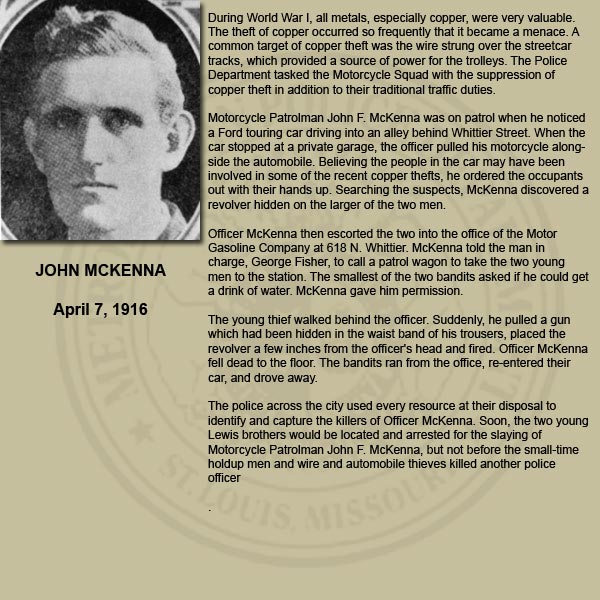 Date of death: April 7, 1916
Full Name: John McKenna
Content: During World War I, all metals, especially copper, were very valuable.
The theft of copper occurred so frequently that it became a menace. A
common target of copper theft was the wire strung over the streetcar
tracks, which provided a source of power for the trolleys. The Police
Department tase the Motorcycle Squad with the suppression of
copper theft in addition to their traditional traffic duties.
Motorcycle Patrolman John F- McKenna was on patrol when he noticed
a Ford touring car driving into an alley behind Whittier Street. When the
car stopped at a private garage, the officer pulled his motorcycle along-
side the automobile. Believing the people in the car may have been
involved in some of the recent copper thefts, he ordered the occupants
out with their hands up. Searching the suspects, McKenna discovered a
revolver hidden on the larger of the two men.
Officer McKenna then escorted the two into the office of the Motor
Gasoline Company at 618 N. Whittier. McKenna told the man in
charge, George Fisher, to call a patrol wagon to take the two young
men to the station. The smallest of the two bandits asked if he could get
2 dink of water Mckenna gave him permission.
The young thief walked behind the officer. Suddenly, he pulled a gun
which had been hidden in the waist band of is trousers, placed the
revolver a few inches from the officer's head and fired. Officer McKenna
fell dead to the floor. The bandits ran from the office, re-entered their
car, and drove away.
The police across the city used every resource at their disposal to
identify and capture the killers of Officer McKenna. Soon, the two young
Lewis brothers would be located and arrested for the slaying of i
Motorcycle Patrolman John F- McKenna, but not before the small-time
holdup men and wire and automobile thieves killed another police
officer.
Date of death: April 7, 1916
Full Name: John McKenna
Content: During World War I, all metals, especially copper, were very valuable.
The theft of copper occurred so frequently that it became a menace. A
common target of copper theft was the wire strung over the streetcar
tracks, which provided a source of power for the trolleys. The Police
Department tase the Motorcycle Squad with the suppression of
copper theft in addition to their traditional traffic duties.
Motorcycle Patrolman John F- McKenna was on patrol when he noticed
a Ford touring car driving into an alley behind Whittier Street. When the
car stopped at a private garage, the officer pulled his motorcycle along-
side the automobile. Believing the people in the car may have been
involved in some of the recent copper thefts, he ordered the occupants
out with their hands up. Searching the suspects, McKenna discovered a
revolver hidden on the larger of the two men.
Officer McKenna then escorted the two into the office of the Motor
Gasoline Company at 618 N. Whittier. McKenna told the man in
charge, George Fisher, to call a patrol wagon to take the two young
men to the station. The smallest of the two bandits asked if he could get
2 dink of water Mckenna gave him permission.
The young thief walked behind the officer. Suddenly, he pulled a gun
which had been hidden in the waist band of is trousers, placed the
revolver a few inches from the officer's head and fired. Officer McKenna
fell dead to the floor. The bandits ran from the office, re-entered their
car, and drove away.
The police across the city used every resource at their disposal to
identify and capture the killers of Officer McKenna. Soon, the two young
Lewis brothers would be located and arrested for the slaying of i
Motorcycle Patrolman John F- McKenna, but not before the small-time
holdup men and wire and automobile thieves killed another police
officer.
 Date of death: April 7,1916
Full Name: William Dillon
Content: Officer Dillon was killed as he investigated the murder of Officer
Mckenna. Patrolman Dillon, making his hourly cal at a patrol call-box,
was given the description of the two men riding in a Ford touring car
wanted for the murder of McKenna in the Eleventh District. He
recognized the description as that of the Lewis brothers, alias DeMorris Boys.
Dillon walked down the alley behind the DeMorris home on Athlone.
Hearing voices in the garage, he walked in. The officer's sudden
appearance surprised the brothers, Frank and Ora Lewis. As Frank
Lewis went for the pistol in his hip pocket, Officer Dillon, his revolver
drawn, said, “None of that". Noticing some copper wire in the trunk of a
Hudson car, Dillon stepped toward it.
As Officer Dillon looked info the Hudson's trunk, Frank Lewis took a
hatchet from the top of a box and struck the officer on the back of the
head. As Dillon fell to the floor, Frank Lewis continued to beat him with a
hatchet and shovel, causing his death.
The Lewis brothers now quickly made plans to hide Dillon's body. Ora
and Frank wrapped the officer in a lap robe and coat. They placed
Dillon's body in the stolen Hudson car, and abandoned the automobile
in a watery ditch on the side of Denny Road, a short distance south of
Clayton Road. They took the body from the car and covered it with dirt
in a shallow grave. They then returned to their house on Athlone.
When Officer Dillon did not appear for his relief at 3:00 p.m., concern for
his safety mounted. A quick review of the reporting log revealed that he
had not reported since 8:08 a.m. He had missed six patrol calls in a row.
The worst was feared.
The events surrounding his disappearance had not gone unnoticed.
Two little boys and a woman, living across the alley from the Athlone
Avenue house, watched the officer enter the garage. They did not see.
him reappear. Concerned for the safety of the officer, the woman
reported what she had seen to the police.
Officers went o the Athlone Avenue garage and found signs of a desperate struggle. Blood was splattered all over the garage. A blood
covered hatchet, a pair of old pans, and a battle ax were taken to
Police Headquarters as evidence of the suspected murder.
The search for the officer extended outside the city limits. In St. Louis
County, a little girl, Helen Wilson, told Sergeant Rinewald and Detective
Cllander that she was afraid to play at a location where she believed
blood was on a rock. About three-quarters of a mile south of Clayton
Road on Denny Road the officers found the rock she described,
splattered with blood. In a ditch fifteen feet below were signs of freshly.
turned clay. A quick search revealed the body of Officer Dillon.
Roy Joe Lewis and Ora Lewis were arrested and soon convicted of the
murder of Officer McKenna. They were sentenced to hang, but their
sentence was commuted to fife imprisonment. Later, Frank Lewis was
arrested after a rampage of crime in Colorado and Kansas, and he
eventually died in prison
Date of death: April 7,1916
Full Name: William Dillon
Content: Officer Dillon was killed as he investigated the murder of Officer
Mckenna. Patrolman Dillon, making his hourly cal at a patrol call-box,
was given the description of the two men riding in a Ford touring car
wanted for the murder of McKenna in the Eleventh District. He
recognized the description as that of the Lewis brothers, alias DeMorris Boys.
Dillon walked down the alley behind the DeMorris home on Athlone.
Hearing voices in the garage, he walked in. The officer's sudden
appearance surprised the brothers, Frank and Ora Lewis. As Frank
Lewis went for the pistol in his hip pocket, Officer Dillon, his revolver
drawn, said, “None of that". Noticing some copper wire in the trunk of a
Hudson car, Dillon stepped toward it.
As Officer Dillon looked info the Hudson's trunk, Frank Lewis took a
hatchet from the top of a box and struck the officer on the back of the
head. As Dillon fell to the floor, Frank Lewis continued to beat him with a
hatchet and shovel, causing his death.
The Lewis brothers now quickly made plans to hide Dillon's body. Ora
and Frank wrapped the officer in a lap robe and coat. They placed
Dillon's body in the stolen Hudson car, and abandoned the automobile
in a watery ditch on the side of Denny Road, a short distance south of
Clayton Road. They took the body from the car and covered it with dirt
in a shallow grave. They then returned to their house on Athlone.
When Officer Dillon did not appear for his relief at 3:00 p.m., concern for
his safety mounted. A quick review of the reporting log revealed that he
had not reported since 8:08 a.m. He had missed six patrol calls in a row.
The worst was feared.
The events surrounding his disappearance had not gone unnoticed.
Two little boys and a woman, living across the alley from the Athlone
Avenue house, watched the officer enter the garage. They did not see.
him reappear. Concerned for the safety of the officer, the woman
reported what she had seen to the police.
Officers went o the Athlone Avenue garage and found signs of a desperate struggle. Blood was splattered all over the garage. A blood
covered hatchet, a pair of old pans, and a battle ax were taken to
Police Headquarters as evidence of the suspected murder.
The search for the officer extended outside the city limits. In St. Louis
County, a little girl, Helen Wilson, told Sergeant Rinewald and Detective
Cllander that she was afraid to play at a location where she believed
blood was on a rock. About three-quarters of a mile south of Clayton
Road on Denny Road the officers found the rock she described,
splattered with blood. In a ditch fifteen feet below were signs of freshly.
turned clay. A quick search revealed the body of Officer Dillon.
Roy Joe Lewis and Ora Lewis were arrested and soon convicted of the
murder of Officer McKenna. They were sentenced to hang, but their
sentence was commuted to fife imprisonment. Later, Frank Lewis was
arrested after a rampage of crime in Colorado and Kansas, and he
eventually died in prison
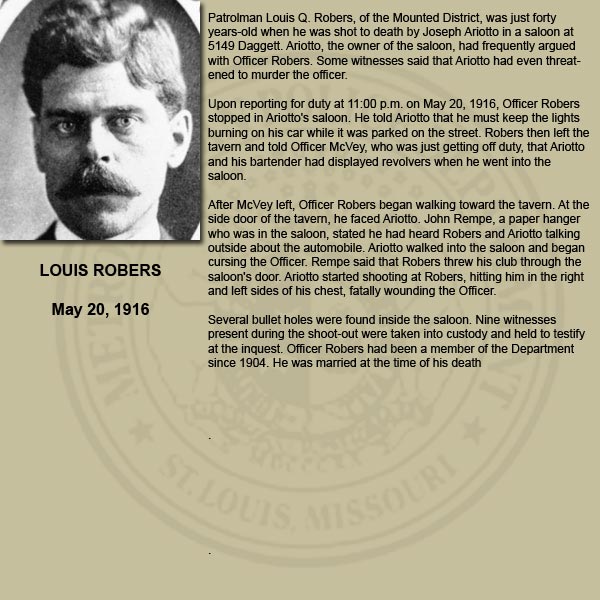 Date of death: May 20,1916
Full Name: Louis Robers
Content: Patrolman Louis Q. Robers, of the Mounted District, was just forty
years-old when he was shot o death by Joseph Argo in a saloon at
5149 Daggett. Ariotto, the owner of the saloon, had frequently argued
with Officer Robers. Some witnesses said that Ariotto had even threatened to murder the officer.
Upon reporting for duty at 11:00 p.m. on May 20, 1916, Officer Robers
stopped in Ariotto's saloon. He told Ariotto that he must keep the lights
burning on his car while it was parked on the street. Robers then left he
tavern and told Officer McVey, who was just getting of duty, that Ariotto
and his bartender had displayed revolvers when he went info the saloon.
After McVey left, Officer Robers began walking foward the fave. At the
side door of the tavern, he faced Ariotto. John Rempe, a paper hanger
who was in the saloon, stated he had heard Robers and Arioto taking.
outside about the automobile. Ariotto walked info the saloon and began
cursing the Office. Rempe said that Robers threw his club through the
saloon's door. Ariotto started shooting at Robers, hitting him in the right
20a lt ides of his chest, fatal wounding the Officer.
Several bullet holes were found inside the saloon. Nine witnesses
present during the shoot-out were taken into custody and held 0 testy
at the inquest, Officer Robers had been a member of the Department
since 1904. He was marred at the time of his death.
Date of death: May 20,1916
Full Name: Louis Robers
Content: Patrolman Louis Q. Robers, of the Mounted District, was just forty
years-old when he was shot o death by Joseph Argo in a saloon at
5149 Daggett. Ariotto, the owner of the saloon, had frequently argued
with Officer Robers. Some witnesses said that Ariotto had even threatened to murder the officer.
Upon reporting for duty at 11:00 p.m. on May 20, 1916, Officer Robers
stopped in Ariotto's saloon. He told Ariotto that he must keep the lights
burning on his car while it was parked on the street. Robers then left he
tavern and told Officer McVey, who was just getting of duty, that Ariotto
and his bartender had displayed revolvers when he went info the saloon.
After McVey left, Officer Robers began walking foward the fave. At the
side door of the tavern, he faced Ariotto. John Rempe, a paper hanger
who was in the saloon, stated he had heard Robers and Arioto taking.
outside about the automobile. Ariotto walked info the saloon and began
cursing the Office. Rempe said that Robers threw his club through the
saloon's door. Ariotto started shooting at Robers, hitting him in the right
20a lt ides of his chest, fatal wounding the Officer.
Several bullet holes were found inside the saloon. Nine witnesses
present during the shoot-out were taken into custody and held 0 testy
at the inquest, Officer Robers had been a member of the Department
since 1904. He was marred at the time of his death.
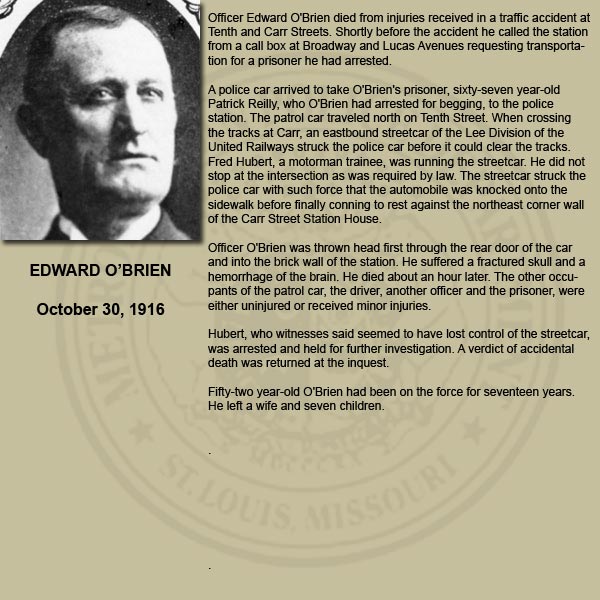 Date of death: October 30, 1916
Full Name: Edward O’Brien
Content: Officer Edward O'Brien died from injuries received in a traffic accident at
Tenth and Carr Streets. Shorty before the accident he called the station
from a call box at Broadway and Lucas Aventis requesting transportation for a prisoner he had arrested.
A police car arrived to take O'Brien's prisoner, sixty-seven year-old i
Patrick Reilly, who O'Brien had arrested for begging, to the police.
station. The patrol car traveled north on Tenth Street. When crossing
the tracks at Carr, an eastbound streetcar of the Lee Division of the
United Railways struck the police car before it could clear the tracks.
Fred Hubert, a motorman trainee, was running the streetcar. He did not
stop at the intersection as was required by law. The streetcar struck the
police car with Such force that the automobile was knocked onto the
sidewalk before finally conning to rest against the northeast comer wall
of the Carr Street Station House.
Officer O'Brien was thrown head first through the rear door of the car
and into the brick wall of the station. He suffered a fractured skull and a
hemorrhage of the brain. He died about an hour after. The other occupants of the patrol car, the driver, another officer and the prisoner, were
either uninjured or received minor injures.
Hubert, who witnesses said seemed to have lost control of the streetcar,
was arrested and held for further investigation. A verdict of accidental
death was returned at the inquest.
Fifty-two year-old O'Brien had been on the force or seventeen years.
He left a wife and seven children.
Date of death: October 30, 1916
Full Name: Edward O’Brien
Content: Officer Edward O'Brien died from injuries received in a traffic accident at
Tenth and Carr Streets. Shorty before the accident he called the station
from a call box at Broadway and Lucas Aventis requesting transportation for a prisoner he had arrested.
A police car arrived to take O'Brien's prisoner, sixty-seven year-old i
Patrick Reilly, who O'Brien had arrested for begging, to the police.
station. The patrol car traveled north on Tenth Street. When crossing
the tracks at Carr, an eastbound streetcar of the Lee Division of the
United Railways struck the police car before it could clear the tracks.
Fred Hubert, a motorman trainee, was running the streetcar. He did not
stop at the intersection as was required by law. The streetcar struck the
police car with Such force that the automobile was knocked onto the
sidewalk before finally conning to rest against the northeast comer wall
of the Carr Street Station House.
Officer O'Brien was thrown head first through the rear door of the car
and into the brick wall of the station. He suffered a fractured skull and a
hemorrhage of the brain. He died about an hour after. The other occupants of the patrol car, the driver, another officer and the prisoner, were
either uninjured or received minor injures.
Hubert, who witnesses said seemed to have lost control of the streetcar,
was arrested and held for further investigation. A verdict of accidental
death was returned at the inquest.
Fifty-two year-old O'Brien had been on the force or seventeen years.
He left a wife and seven children.
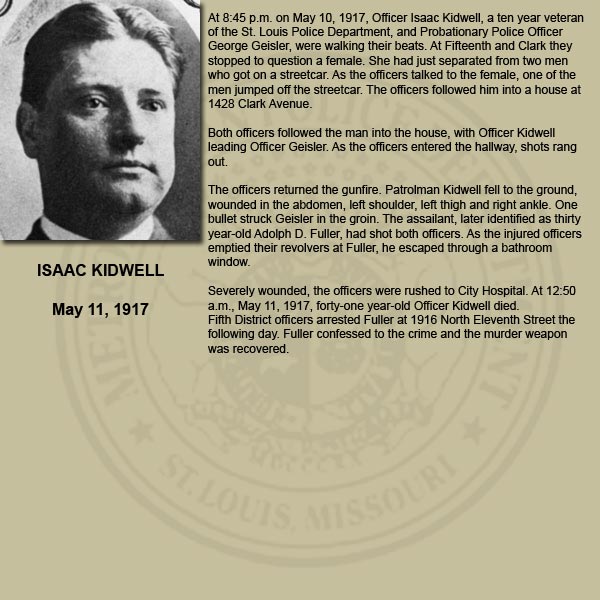 Date of death: May 11, 1917
Full Name: Issac Kidwell
Content: At 8:45 p.m. on May 10, 1917, Officer Isaac Kidwell, a ten year veteran
of the St. Louis Police Department, and Probationary Police Officer
George Geisler, were walking their beats. At Fifteenth and Clark they
stopped to question a female. She had just separated from two men
who got on a streetcar. As the officers talked to the female, one of the
men jumped off the streetcar. The officers followed him into a house at
1428 Clark Avenue.
Both officers followed the man into the house, with Officer Kidwell
leading Officer Geisler. As the officers entered the hallway, shots rang
out.
The officers returned the gunfire. Patrolman Kidwell fell to the ground,
wounded in the abdomen, left shoulder, let high and right ankle. One
bullet struck Geisler in the groin. The assailant, later identified as thirty
year-old Adolph D. Fuller, had shot both officers. As the injured officers
emptied their revolvers at Fuller, he escaped through a bathroom
window.
Severely wounded, the officers were rushed to City Hospital. At 12:50
am, May 11, 1817, forty-one year-old Officer Kidwell died.
Fifth District officers arrested Fuller at 1916 North Eleventh Street, the
following day. Fuller confessed to the crime and the murder weapon
was recovered.
Date of death: May 11, 1917
Full Name: Issac Kidwell
Content: At 8:45 p.m. on May 10, 1917, Officer Isaac Kidwell, a ten year veteran
of the St. Louis Police Department, and Probationary Police Officer
George Geisler, were walking their beats. At Fifteenth and Clark they
stopped to question a female. She had just separated from two men
who got on a streetcar. As the officers talked to the female, one of the
men jumped off the streetcar. The officers followed him into a house at
1428 Clark Avenue.
Both officers followed the man into the house, with Officer Kidwell
leading Officer Geisler. As the officers entered the hallway, shots rang
out.
The officers returned the gunfire. Patrolman Kidwell fell to the ground,
wounded in the abdomen, left shoulder, let high and right ankle. One
bullet struck Geisler in the groin. The assailant, later identified as thirty
year-old Adolph D. Fuller, had shot both officers. As the injured officers
emptied their revolvers at Fuller, he escaped through a bathroom
window.
Severely wounded, the officers were rushed to City Hospital. At 12:50
am, May 11, 1817, forty-one year-old Officer Kidwell died.
Fifth District officers arrested Fuller at 1916 North Eleventh Street, the
following day. Fuller confessed to the crime and the murder weapon
was recovered.
 Date of death: July 17, 1917
Full Name: Julius H. Petring
Content: Thirty year-old Patrolman Julius H. Petring was shot in the chest by
Mrs. Frieda Hagemeler in a room over the saloon owned by William
Diedrich at 2301 North Market, Death for the Officer was almost
instantaneous. Diedrich said he allowed the couple to have a room for
the night after Patrolman Petring said he had to be in court the next
morning.
Mrs. Hagemeier claimed that Petring had tried to kill her because of
Jealousy. She further stated that after a struggle, she took Petring's
revolver and shot him in the chest. Mrs. Hagemeler was taken to the
hospital with injuries to her head.
Date of death: July 17, 1917
Full Name: Julius H. Petring
Content: Thirty year-old Patrolman Julius H. Petring was shot in the chest by
Mrs. Frieda Hagemeler in a room over the saloon owned by William
Diedrich at 2301 North Market, Death for the Officer was almost
instantaneous. Diedrich said he allowed the couple to have a room for
the night after Patrolman Petring said he had to be in court the next
morning.
Mrs. Hagemeier claimed that Petring had tried to kill her because of
Jealousy. She further stated that after a struggle, she took Petring's
revolver and shot him in the chest. Mrs. Hagemeler was taken to the
hospital with injuries to her head.
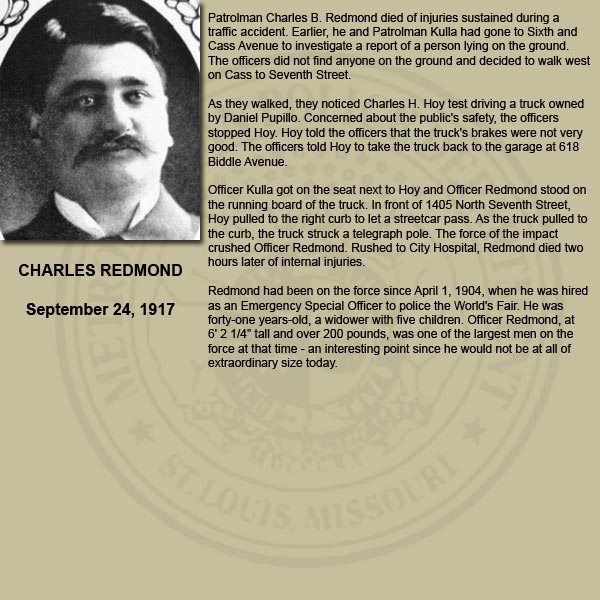 Date of death: September 24, 1917
Full Name: Charles Redmond
Content: Patrolman Charles B. Redmond died of injuries sustained during a
traffic accident. Earlier, he and Patrolman Kulla had gone to Sixth and
Cass Avenue to investigate a report of a person lying on the ground.
The officers did not find anyone on the ground and decided to walk west
on Cass to Seventh Street.
As they walked, they noticed Charles H. Hoy test driving a truck owned
by Daniel Pupillo. Concerned about the public's safely, the officers
stopped Hoy. Hoy told the officers that the truck's brakes were not very
good. The officers told Hoy to take the truck back to the garage at 618.
Biddle Avenue.
Officer Kulla got on the seat next to Hoy and Officer Redmond stood on
the running board of the truck. In front of 1405 North Seventh Street,
Hoy pulled to the right curb to let a streetcar pass. AS the truck pulled to
the curb, the truck suck a telegraph pole. The force of the impact
crushed Officer Redmond. Rushed to City Hospital, Redmond died two
hours after of internal injuries.
Redmond had been on the force since April 1, 1904, when he was hired
as an Emergency Special Officer to police the World's Fair. He was
forty-one years-old, a widower with five children. Officer Redmond, at
62 1/4" tall and over 200 pounds, was one of the largest men on the
force at that time - an interesting point since he would not be at all of
extraordinary size today.
Date of death: September 24, 1917
Full Name: Charles Redmond
Content: Patrolman Charles B. Redmond died of injuries sustained during a
traffic accident. Earlier, he and Patrolman Kulla had gone to Sixth and
Cass Avenue to investigate a report of a person lying on the ground.
The officers did not find anyone on the ground and decided to walk west
on Cass to Seventh Street.
As they walked, they noticed Charles H. Hoy test driving a truck owned
by Daniel Pupillo. Concerned about the public's safely, the officers
stopped Hoy. Hoy told the officers that the truck's brakes were not very
good. The officers told Hoy to take the truck back to the garage at 618.
Biddle Avenue.
Officer Kulla got on the seat next to Hoy and Officer Redmond stood on
the running board of the truck. In front of 1405 North Seventh Street,
Hoy pulled to the right curb to let a streetcar pass. AS the truck pulled to
the curb, the truck suck a telegraph pole. The force of the impact
crushed Officer Redmond. Rushed to City Hospital, Redmond died two
hours after of internal injuries.
Redmond had been on the force since April 1, 1904, when he was hired
as an Emergency Special Officer to police the World's Fair. He was
forty-one years-old, a widower with five children. Officer Redmond, at
62 1/4" tall and over 200 pounds, was one of the largest men on the
force at that time - an interesting point since he would not be at all of
extraordinary size today.
 Date of death: May 19,1918
Full Name: Andrew Lawrence
Content: Fifty-eight year old Patrolman Andrew Lawrence of the Twelfth District
was run down and killed at 2:35 am. by a car driven at reckless speed
by Over Kiein, a chauffeur, at the comer of Arlington and Easton
Avenues. (Martin Luther King Dr).
Officer Edward (Kink) Connell heard the sound of a policeman's night-
stick striking the pavement and saw a large car speed past him. He fired
two shots at the car in an attempt to stop the automobile. The fleeing
car escaped, turning south on Union Boulevard. Connell hurried down
the street to the south side of Easton Avenue, about twenty feet east of
Arlington. There he found Lawrence lying in the street, critically injured
from the impact of the automobile.
Connell stopped a passing car to take Lawrence to the hospital, but this
car broke down at Vandeventer and Olive. When an ambulance arrived,
Lawrence was pronounced dead.
The driver of the automobile that struck Lawrence was soon identified
as a man named Klein. Later in the day police arrested him in Clayton
and detained the three other occupants of his car or questioning. The
other people who had been with Klein were soon released when investigators learned that they tried to get Klein to return o the scene of the
accident.
Lawrence was married and had six children. He had been on the force
since September of 1896.
Date of death: May 19,1918
Full Name: Andrew Lawrence
Content: Fifty-eight year old Patrolman Andrew Lawrence of the Twelfth District
was run down and killed at 2:35 am. by a car driven at reckless speed
by Over Kiein, a chauffeur, at the comer of Arlington and Easton
Avenues. (Martin Luther King Dr).
Officer Edward (Kink) Connell heard the sound of a policeman's night-
stick striking the pavement and saw a large car speed past him. He fired
two shots at the car in an attempt to stop the automobile. The fleeing
car escaped, turning south on Union Boulevard. Connell hurried down
the street to the south side of Easton Avenue, about twenty feet east of
Arlington. There he found Lawrence lying in the street, critically injured
from the impact of the automobile.
Connell stopped a passing car to take Lawrence to the hospital, but this
car broke down at Vandeventer and Olive. When an ambulance arrived,
Lawrence was pronounced dead.
The driver of the automobile that struck Lawrence was soon identified
as a man named Klein. Later in the day police arrested him in Clayton
and detained the three other occupants of his car or questioning. The
other people who had been with Klein were soon released when investigators learned that they tried to get Klein to return o the scene of the
accident.
Lawrence was married and had six children. He had been on the force
since September of 1896.
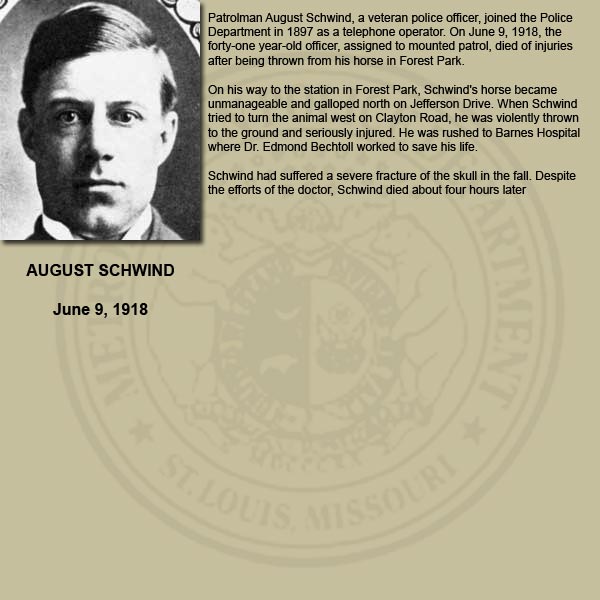 Date of death: June 9, 1918
Full Name: August Schwind
Content: Patrolman August Schwind, a veteran police officer, joined the Police
Department in 1897 as a telephone operator. On June 9, 1918, the
forty-one year-old officer, assigned to mounted patrol, died of injuries
after being thrown from his horse in Forest Park.
On his way to the station in Forest Park, Schwind's horse became
unmanageable and galloped north on Jefferson Drive. When Schwind
fried to tum the animal west on Clayion Road, he was violently thrown
to the ground and seriously injured. He was rushed to Barnes Hospital
where Dr. Edmond Bechtoll worked to save his life.
Schwind had suffered a severe fracture of the skull in the fall. Despite
the efforts of the doctor, Schwind died about four hours later.
Date of death: June 9, 1918
Full Name: August Schwind
Content: Patrolman August Schwind, a veteran police officer, joined the Police
Department in 1897 as a telephone operator. On June 9, 1918, the
forty-one year-old officer, assigned to mounted patrol, died of injuries
after being thrown from his horse in Forest Park.
On his way to the station in Forest Park, Schwind's horse became
unmanageable and galloped north on Jefferson Drive. When Schwind
fried to tum the animal west on Clayion Road, he was violently thrown
to the ground and seriously injured. He was rushed to Barnes Hospital
where Dr. Edmond Bechtoll worked to save his life.
Schwind had suffered a severe fracture of the skull in the fall. Despite
the efforts of the doctor, Schwind died about four hours later.
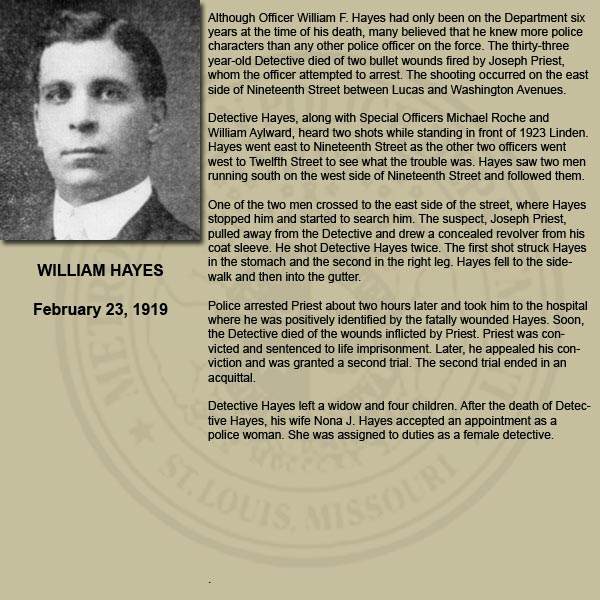 Date of death: February 23, 1919
Full Name: William Hayes
Content: Although Officer William F. Hayes had only been on the Department six
years at the time of his death, many believed that he knew more police:
characters than any other police officer on the force. The thirty-three
year-old Detective died of two bullet wounds fired by Joseph Priest,
whom the officer attempted to arrest. The shooting occurred on the east
side of Nineteenth Street between Lucas and Washington Avenues.
Detective Hayes, along with Special Officers Michael Roche and
William Aylward, heard two shots while standing in front of 1923 Linden.
Hayes went east to Nineteenth Street as the other two officers went
west to Twelfth Street to see what the trouble was. Hayes saw two men
running south on the west side of Nineteenth Street and followed them.
One of the two men crossed to the east side of the street, where Hayes
stopped him and started to search him. The suspect, Joseph Priest,
pulled away from the Detective and drew a concealed revolver from his.
coat sleeve. He shot Detective Hayes twice. The first shot struck Hayes
in the stomach and the second in the right leg. Hayes fell to the side-
walk and then into the gutter.
Police arrested Priest about two hours later and took him to the hospital
where he was positively identified by the fatally wounded Hayes. Soon,
the Detective died of the wounds inflicted by Priest. Priest was convicted and sentenced to life imprisonment Later, he appealed his conviction and was granted a second trial. The second trial ended in an
acquittal.
Detective Hayes left a widow and four children. After the death of Detective Hayes, his wife Nona J. Hayes accepted an appointment as a
police woman. She was assigned to duties as a female detective.
Date of death: February 23, 1919
Full Name: William Hayes
Content: Although Officer William F. Hayes had only been on the Department six
years at the time of his death, many believed that he knew more police:
characters than any other police officer on the force. The thirty-three
year-old Detective died of two bullet wounds fired by Joseph Priest,
whom the officer attempted to arrest. The shooting occurred on the east
side of Nineteenth Street between Lucas and Washington Avenues.
Detective Hayes, along with Special Officers Michael Roche and
William Aylward, heard two shots while standing in front of 1923 Linden.
Hayes went east to Nineteenth Street as the other two officers went
west to Twelfth Street to see what the trouble was. Hayes saw two men
running south on the west side of Nineteenth Street and followed them.
One of the two men crossed to the east side of the street, where Hayes
stopped him and started to search him. The suspect, Joseph Priest,
pulled away from the Detective and drew a concealed revolver from his.
coat sleeve. He shot Detective Hayes twice. The first shot struck Hayes
in the stomach and the second in the right leg. Hayes fell to the side-
walk and then into the gutter.
Police arrested Priest about two hours later and took him to the hospital
where he was positively identified by the fatally wounded Hayes. Soon,
the Detective died of the wounds inflicted by Priest. Priest was convicted and sentenced to life imprisonment Later, he appealed his conviction and was granted a second trial. The second trial ended in an
acquittal.
Detective Hayes left a widow and four children. After the death of Detective Hayes, his wife Nona J. Hayes accepted an appointment as a
police woman. She was assigned to duties as a female detective.
 Date of death: June 13,1919
Full Name: Thomas Ward
Content: On Thursday, June 12, 1919, four armed men held up the Meramec
Trust Company. The gun bate between the robbers and police officers
who responded to the robbery marked only the third time in the history
of the Department that two officers would be killed in the same incident
The robbery and subsequent gun battle gained much notoriety in 1919
and it is considered one of the most famous gun battles in the history of
the St. Louis Police Department.
After meeting in Lafayette Park, the four robbers drove to the bank,
located at 3224 Meramec Street. About 2 p.m. three of the men entered
the building, while the fourth remained in the getaway car. As the bandits
gathered $8,000 in cash and $12,000 in Liberty Bonds, passers-by saw
the robbers and gave the alarm. Many officers and detectives from the
‘Second District responded. When the robbers fled the bank, one of the
biggest gun battles in the history of the Department began.
The first officers at the scene were Sergeant William J. Smith, Officer
Thomas Ward, Sergeant William J. O'Brien, brother of Police Chief
O'Brien, and Officers Earl C. Valleroy and Nicholas McVey. As the
robbers exited the bank, gunshots were exchanged with the officers
who had taken up positions outside the bank. As the shooting continued, the driver of the get-away car drove away, leaving the other
robbers behind. This would later prove to be the demise of the three
armed men.
The three robbers who were left at the bank tried to escape. They spit
up and began running, leaving the protection of their concealment. They.
were met with a barrage of gunfire from Joseph Bauer, a citizen who
rushed to the officers’ aid. Bauer's action allowed the officers to reload
and momentarily prevented the robber's escape.
After firing a final volley of shots, two of the robbers escaped into an
alley between Osceola and Meramec Streets. In their haste, they either
dropped or discarded the satchel containing the money in front of St.
Anthony's School.
The robbers forced the driver of a one-horse wagon to drive them
through alleys and side streets. In panic, the driver of the horse wagon
lost control of the wagon and wrecked after only a few blocks. Sergeant
O'Brien, leading the chase, saw what had happened and commandeered 2 passing citizens automobile. He continued the pursuit of the
robbers. Two of the robbers then entered the rear yard at 4526.
Date of death: June 13,1919
Full Name: Thomas Ward
Content: On Thursday, June 12, 1919, four armed men held up the Meramec
Trust Company. The gun bate between the robbers and police officers
who responded to the robbery marked only the third time in the history
of the Department that two officers would be killed in the same incident
The robbery and subsequent gun battle gained much notoriety in 1919
and it is considered one of the most famous gun battles in the history of
the St. Louis Police Department.
After meeting in Lafayette Park, the four robbers drove to the bank,
located at 3224 Meramec Street. About 2 p.m. three of the men entered
the building, while the fourth remained in the getaway car. As the bandits
gathered $8,000 in cash and $12,000 in Liberty Bonds, passers-by saw
the robbers and gave the alarm. Many officers and detectives from the
‘Second District responded. When the robbers fled the bank, one of the
biggest gun battles in the history of the Department began.
The first officers at the scene were Sergeant William J. Smith, Officer
Thomas Ward, Sergeant William J. O'Brien, brother of Police Chief
O'Brien, and Officers Earl C. Valleroy and Nicholas McVey. As the
robbers exited the bank, gunshots were exchanged with the officers
who had taken up positions outside the bank. As the shooting continued, the driver of the get-away car drove away, leaving the other
robbers behind. This would later prove to be the demise of the three
armed men.
The three robbers who were left at the bank tried to escape. They spit
up and began running, leaving the protection of their concealment. They.
were met with a barrage of gunfire from Joseph Bauer, a citizen who
rushed to the officers’ aid. Bauer's action allowed the officers to reload
and momentarily prevented the robber's escape.
After firing a final volley of shots, two of the robbers escaped into an
alley between Osceola and Meramec Streets. In their haste, they either
dropped or discarded the satchel containing the money in front of St.
Anthony's School.
The robbers forced the driver of a one-horse wagon to drive them
through alleys and side streets. In panic, the driver of the horse wagon
lost control of the wagon and wrecked after only a few blocks. Sergeant
O'Brien, leading the chase, saw what had happened and commandeered 2 passing citizens automobile. He continued the pursuit of the
robbers. Two of the robbers then entered the rear yard at 4526.
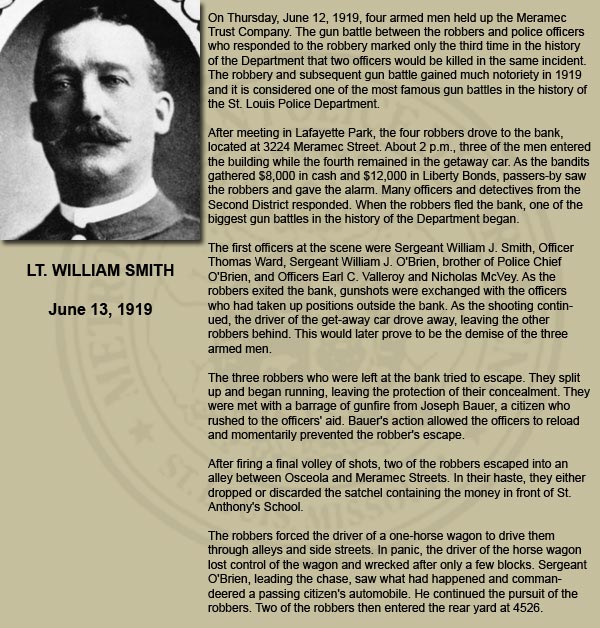 Date of death: June 13, 1919
Full Name: Lt. William Smith
Content: On Thursday, June 12, 1919, four armed men held up the Meramec
Trust Company. The gun bate between the robbers and police officers
who responded to the robbery marked only the third time in the history
of the Department that two officers would be killed in the same incident
The robbery and subsequent gun battle gained much notoriety in 1919
and it is considered one of the most famous gun battles in the history of
the St. Louis Police Department.
After meeting in Lafayette Park, the four robbers drove to the bank,
located at 3224 Meramec Street. About 2 p.m. three of the men entered
the building, while the fourth remained in the getaway car. As the bandits
gathered $8,000 in cash and $12,000 in Liberty Bonds, passers-by saw
the robbers and gave the alarm. Many officers and detectives from the
‘Second District responded. When the robbers fled the bank, one of the
biggest gun battles in the history of the Department began.
The first officers at the scene were Sergeant William J. Smith, Officer
Thomas Ward, Sergeant William J. O'Brien, brother of Police Chief
O'Brien, and Officers Earl C. Valleroy and Nicholas McVey. As the
robbers exited the bank, gunshots were exchanged with the officers
who had taken up positions outside the bank. As the shooting continued, the driver of the get-away car drove away, leaving the other
robbers behind. This would later prove to be the demise of the three
armed men.
The three robbers who were left at the bank tried to escape. They spit
up and began running, leaving the protection of their concealment. They.
were met with a barrage of gunfire from Joseph Bauer, a citizen who
rushed to the officers’ aid. Bauer's action allowed the officers to reload
and momentarily prevented the robber's escape.
After firing a final volley of shots, two of the robbers escaped into an
alley between Osceola and Meramec Streets. In their haste, they either
dropped or discarded the satchel containing the money in front of St.
Anthony's School.
The robbers forced the driver of a one-horse wagon to drive them
through alleys and side streets. In panic, the driver of the horse wagon
lost control of the wagon and wrecked after only a few blocks. Sergeant
O'Brien, leading the chase, saw what had happened and commandeered 2 passing citizens automobile. He continued the pursuit of the
robbers. Two of the robbers then entered the rear yard at 4526.
Date of death: June 13, 1919
Full Name: Lt. William Smith
Content: On Thursday, June 12, 1919, four armed men held up the Meramec
Trust Company. The gun bate between the robbers and police officers
who responded to the robbery marked only the third time in the history
of the Department that two officers would be killed in the same incident
The robbery and subsequent gun battle gained much notoriety in 1919
and it is considered one of the most famous gun battles in the history of
the St. Louis Police Department.
After meeting in Lafayette Park, the four robbers drove to the bank,
located at 3224 Meramec Street. About 2 p.m. three of the men entered
the building, while the fourth remained in the getaway car. As the bandits
gathered $8,000 in cash and $12,000 in Liberty Bonds, passers-by saw
the robbers and gave the alarm. Many officers and detectives from the
‘Second District responded. When the robbers fled the bank, one of the
biggest gun battles in the history of the Department began.
The first officers at the scene were Sergeant William J. Smith, Officer
Thomas Ward, Sergeant William J. O'Brien, brother of Police Chief
O'Brien, and Officers Earl C. Valleroy and Nicholas McVey. As the
robbers exited the bank, gunshots were exchanged with the officers
who had taken up positions outside the bank. As the shooting continued, the driver of the get-away car drove away, leaving the other
robbers behind. This would later prove to be the demise of the three
armed men.
The three robbers who were left at the bank tried to escape. They spit
up and began running, leaving the protection of their concealment. They.
were met with a barrage of gunfire from Joseph Bauer, a citizen who
rushed to the officers’ aid. Bauer's action allowed the officers to reload
and momentarily prevented the robber's escape.
After firing a final volley of shots, two of the robbers escaped into an
alley between Osceola and Meramec Streets. In their haste, they either
dropped or discarded the satchel containing the money in front of St.
Anthony's School.
The robbers forced the driver of a one-horse wagon to drive them
through alleys and side streets. In panic, the driver of the horse wagon
lost control of the wagon and wrecked after only a few blocks. Sergeant
O'Brien, leading the chase, saw what had happened and commandeered 2 passing citizens automobile. He continued the pursuit of the
robbers. Two of the robbers then entered the rear yard at 4526.
 Date of death: August 12, 1919
Full Name: Louis Niederschulte
Content: The Third District Station received a report that a disturbance had
caused a crowd 10 form at Second and Marion Streets. Two officers,
thirty-seven year-old Patrolman Louis H. Niederschulte and Patrolman
Timothy Mahoney responded to determine why the crowd had formed.
They were told nineteen year-old James Mitchell had learned that
William Watkins had been friendly with his common-law wife, Annice
Pettie. Mitchell, crazed with jealousy and armed with a .38 caliber Winchester repeating rifle, was unable to ind Watkins. Frustrated, Mitchell
began taking chance shots at anyone who came within range.
The Offices were told that Mitchell was in the fear of 1517 1/2 Second.
Street. As Patrolman Timothy Mahoney entered the rear yard, a shot
whizzed past his head, missing him. He ran to the front of the house to
intercept the fugitive, exchanging gunfire in the process.
Patrolman Niederschulte then entered the rear yard. A second shot fired
by Mitchell struck Patrolman Niederschule in the back. The bullet
passed through his body near the heart. Niederschulte fell dead.
One half hour later, after an extensive search of the area, officers cap-
turned Mitchell hiding in 2 coal hole in the rear of the cellar at 1515 South
Second Street. Wounded by Officer Mahoney, Mitchell recovered from
his wounds. Mitchell was sentenced to fife in prison.
Date of death: August 12, 1919
Full Name: Louis Niederschulte
Content: The Third District Station received a report that a disturbance had
caused a crowd 10 form at Second and Marion Streets. Two officers,
thirty-seven year-old Patrolman Louis H. Niederschulte and Patrolman
Timothy Mahoney responded to determine why the crowd had formed.
They were told nineteen year-old James Mitchell had learned that
William Watkins had been friendly with his common-law wife, Annice
Pettie. Mitchell, crazed with jealousy and armed with a .38 caliber Winchester repeating rifle, was unable to ind Watkins. Frustrated, Mitchell
began taking chance shots at anyone who came within range.
The Offices were told that Mitchell was in the fear of 1517 1/2 Second.
Street. As Patrolman Timothy Mahoney entered the rear yard, a shot
whizzed past his head, missing him. He ran to the front of the house to
intercept the fugitive, exchanging gunfire in the process.
Patrolman Niederschulte then entered the rear yard. A second shot fired
by Mitchell struck Patrolman Niederschule in the back. The bullet
passed through his body near the heart. Niederschulte fell dead.
One half hour later, after an extensive search of the area, officers cap-
turned Mitchell hiding in 2 coal hole in the rear of the cellar at 1515 South
Second Street. Wounded by Officer Mahoney, Mitchell recovered from
his wounds. Mitchell was sentenced to fife in prison.
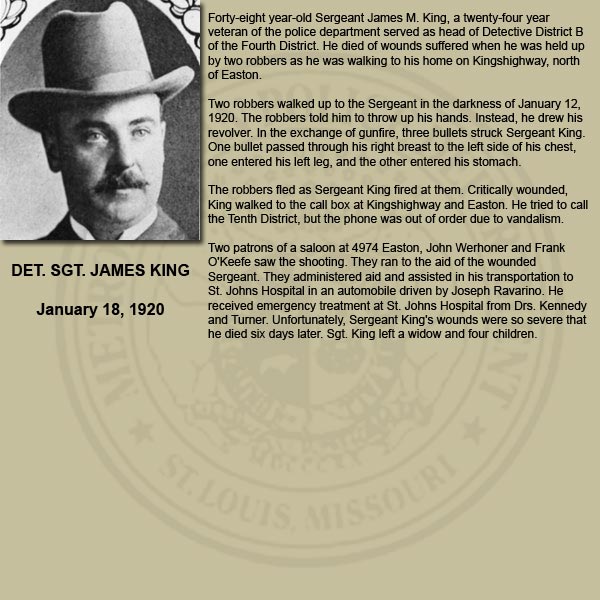 Date of death: January 18, 1920
Full Name: Det. Sgt. James King
Content: Forty-eight year-old Sergeant James M. King, a twenty-four year
Veteran of the police department served as head of Detective District B
of the Fourth District. He died of wounds suffered when he was held up
by two robbers as he was walking to his home on Kingshighway, north
of Easton.
Two robbers walked up to the Sergeant in the darkness of January 12,
120. The robbers told him to throw up his hands. Instead, he drew his
revolver In he exchange of gunfire, three bullets struck Sergeant King.
One bullet passed through his right beast to the left side of is chest,
one entered his left leg, and the other entered his stomach.
The robbers fled as Sergeant King fired at them. Critically wounded,
King walked to the call box at Kingshighway and Easton. He tried to call
the Tenth District, but the phone was out of order due to vandalism.
Two patrons of a saloon at 4974 Easton, John Werhoner and Frank
O'Keefe saw the shooting. They ran to the aid of the wounded
Sergeant. They administered aid and assisted in is transportation to
St. Johns Hospital in an automobile driven by Joseph Ravarino. He
received emergency treatment at St. Johns Hospital from Drs. Kennedy
and Turner. Unfortunately, Sergeant King's wounds were so severe that
he died six days later. Sgt. King left a widow and four children.
Date of death: January 18, 1920
Full Name: Det. Sgt. James King
Content: Forty-eight year-old Sergeant James M. King, a twenty-four year
Veteran of the police department served as head of Detective District B
of the Fourth District. He died of wounds suffered when he was held up
by two robbers as he was walking to his home on Kingshighway, north
of Easton.
Two robbers walked up to the Sergeant in the darkness of January 12,
120. The robbers told him to throw up his hands. Instead, he drew his
revolver In he exchange of gunfire, three bullets struck Sergeant King.
One bullet passed through his right beast to the left side of is chest,
one entered his left leg, and the other entered his stomach.
The robbers fled as Sergeant King fired at them. Critically wounded,
King walked to the call box at Kingshighway and Easton. He tried to call
the Tenth District, but the phone was out of order due to vandalism.
Two patrons of a saloon at 4974 Easton, John Werhoner and Frank
O'Keefe saw the shooting. They ran to the aid of the wounded
Sergeant. They administered aid and assisted in is transportation to
St. Johns Hospital in an automobile driven by Joseph Ravarino. He
received emergency treatment at St. Johns Hospital from Drs. Kennedy
and Turner. Unfortunately, Sergeant King's wounds were so severe that
he died six days later. Sgt. King left a widow and four children.
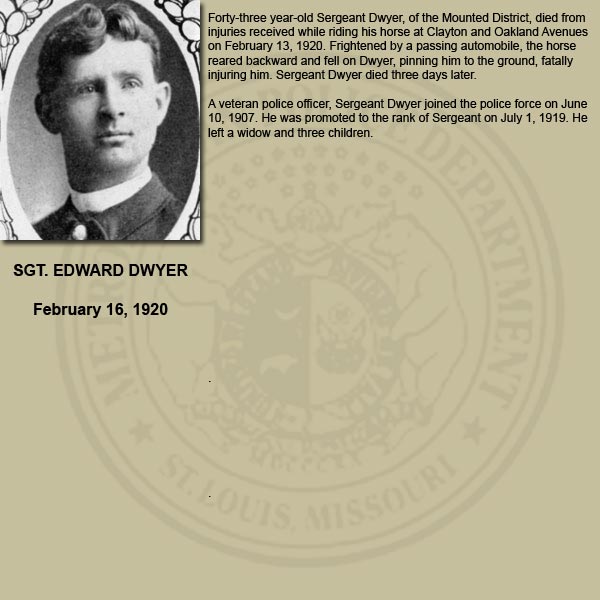 Date of death: February 16, 1920
Full Name: Sgt. Edward Dwyer
Content: Forty-three year-old Sergeant Dwyer, of the Mounted District, died from
injuries received while riding his horse at Clayton and Oakland Avenues
on February 13, 1920. Frightened by a passing automobile, the horse
reared backward and fell on Dwyer, pinning him to the ground, fatally
injuring him. Sergeant Dwyer died three days later.
A veteran police officer, Sergeant Dwyer joined the police force on June
10, 1907. He was promoted to the rank of Sergeant on July 1, 1919. He
left a widow and three children.
Date of death: February 16, 1920
Full Name: Sgt. Edward Dwyer
Content: Forty-three year-old Sergeant Dwyer, of the Mounted District, died from
injuries received while riding his horse at Clayton and Oakland Avenues
on February 13, 1920. Frightened by a passing automobile, the horse
reared backward and fell on Dwyer, pinning him to the ground, fatally
injuring him. Sergeant Dwyer died three days later.
A veteran police officer, Sergeant Dwyer joined the police force on June
10, 1907. He was promoted to the rank of Sergeant on July 1, 1919. He
left a widow and three children.
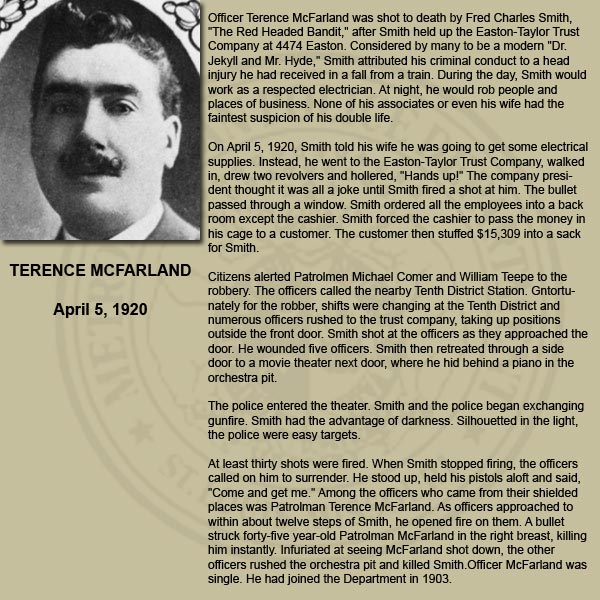 Date of death: April 5, 1920
Full Name: Terence McFarland
Content: Officer Terence McFarland was shot to death by Fred Charles Smith,
“The Red Headed Bandit" after Smith held up the Easton-Taylor Trust
Company at 4474 Easton. Considered by many to be a modern "Dr.
Jekyll and Mr Hyde,” Smith attributed his criminal conduct to a head
injury he had received in a fall from a train. During the day, Smith would
work as a respected electrician. At night, he would rob people and
places of business. None of his associates or even his wife had the
faintest suspicion of his double life.
On April 5, 1920, Smith told his wife he was going to get some electrical
supplies. Instead, he went to the Easton-Taylor Trust Company, walked
in, drew two revolvers and hollered, "Hands up" The company president thought it was all a joke until Smith fired a shot at him. The bullet
passed through a window. Smith ordered all the employees info a back
room except the cashier. Smith forced the cashier to pass the money in
his cage to a customer. The customer then stuffed $15,309 into a sack
for Smith.
Citizens alerted Patrolmen Michael! Comer and William Teepe to the
robbery. The officers called the nearby Tenth District Station. Unfortunately for the robber, shifts were changing at the Tenth District and
numerous officers rushed to the trust company, taking up positions
outside the front door. Smith shot at the officers as they approached the door. He wounded five officers. Smith then retreated through a side
door to a movie theater next door, where he hid behind a piano in the orchestra pit.
The police entered the theater. Smith and the police began exchanging
gunfire. Smith had the advantage of darkness. Silhouetted in the light,
the police were easy targets,
At least thirty shots were fired. When Smith stopped firing, the officers
called on him to surrender. He stood up, held his pistols aloft and said,
"Come and get me." Among the officers who came from their shielded
places was Patrolman Terence McFarland. As officers approached to
within about twelve steps of Smith, he opened fire on them. A bullet
struck forty-five year-old Patrolman McFarland in the right breast, killing
him instantly. Infuriated at seeing McFarland shot down, the other
officers rushed the orchestra pit and killed Smith Officer McFarland was
single. He had joined the Department in 1903.
Date of death: April 5, 1920
Full Name: Terence McFarland
Content: Officer Terence McFarland was shot to death by Fred Charles Smith,
“The Red Headed Bandit" after Smith held up the Easton-Taylor Trust
Company at 4474 Easton. Considered by many to be a modern "Dr.
Jekyll and Mr Hyde,” Smith attributed his criminal conduct to a head
injury he had received in a fall from a train. During the day, Smith would
work as a respected electrician. At night, he would rob people and
places of business. None of his associates or even his wife had the
faintest suspicion of his double life.
On April 5, 1920, Smith told his wife he was going to get some electrical
supplies. Instead, he went to the Easton-Taylor Trust Company, walked
in, drew two revolvers and hollered, "Hands up" The company president thought it was all a joke until Smith fired a shot at him. The bullet
passed through a window. Smith ordered all the employees info a back
room except the cashier. Smith forced the cashier to pass the money in
his cage to a customer. The customer then stuffed $15,309 into a sack
for Smith.
Citizens alerted Patrolmen Michael! Comer and William Teepe to the
robbery. The officers called the nearby Tenth District Station. Unfortunately for the robber, shifts were changing at the Tenth District and
numerous officers rushed to the trust company, taking up positions
outside the front door. Smith shot at the officers as they approached the door. He wounded five officers. Smith then retreated through a side
door to a movie theater next door, where he hid behind a piano in the orchestra pit.
The police entered the theater. Smith and the police began exchanging
gunfire. Smith had the advantage of darkness. Silhouetted in the light,
the police were easy targets,
At least thirty shots were fired. When Smith stopped firing, the officers
called on him to surrender. He stood up, held his pistols aloft and said,
"Come and get me." Among the officers who came from their shielded
places was Patrolman Terence McFarland. As officers approached to
within about twelve steps of Smith, he opened fire on them. A bullet
struck forty-five year-old Patrolman McFarland in the right breast, killing
him instantly. Infuriated at seeing McFarland shot down, the other
officers rushed the orchestra pit and killed Smith Officer McFarland was
single. He had joined the Department in 1903.
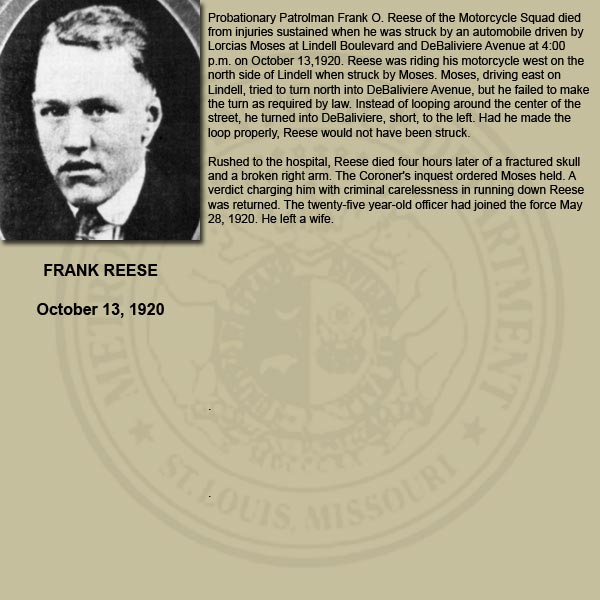 Date of death: October 13, 1920
Full Name: Frank Reese
Content: Probationary Patrolman Frank O. Reese of the Motorcycle Squad died
from injuries sustained when he was struck by an automobile driven by
Lorcias Moses at Lindell Boulevard and DeBaliviere Avenue at 4:00
p.m. on October 13,1920. Reese was riding his motorcycle west on the
north side of Lindell when struck by Moses. Moses, driving east on
Lindell, tried to turn north info DeBaliviere Avenue, but he failed to make
the turn as required by law. Instead of looping around the center of the
street, he fumed into DeBaliviere, short, to the left. Had he made the
loop properly, Reese would not have been struck.
Rushed to the hospital, Reese died four hours later of a fractured skull
and a broken right am. The Coroner's inquest ordered Moses held. A
verdict charging him with criminal carelessness in running down Reese
was returned. The twenty-five year-old officer had joined the force May
28, 1920. He left a wife.
Date of death: October 13, 1920
Full Name: Frank Reese
Content: Probationary Patrolman Frank O. Reese of the Motorcycle Squad died
from injuries sustained when he was struck by an automobile driven by
Lorcias Moses at Lindell Boulevard and DeBaliviere Avenue at 4:00
p.m. on October 13,1920. Reese was riding his motorcycle west on the
north side of Lindell when struck by Moses. Moses, driving east on
Lindell, tried to turn north info DeBaliviere Avenue, but he failed to make
the turn as required by law. Instead of looping around the center of the
street, he fumed into DeBaliviere, short, to the left. Had he made the
loop properly, Reese would not have been struck.
Rushed to the hospital, Reese died four hours later of a fractured skull
and a broken right am. The Coroner's inquest ordered Moses held. A
verdict charging him with criminal carelessness in running down Reese
was returned. The twenty-five year-old officer had joined the force May
28, 1920. He left a wife.
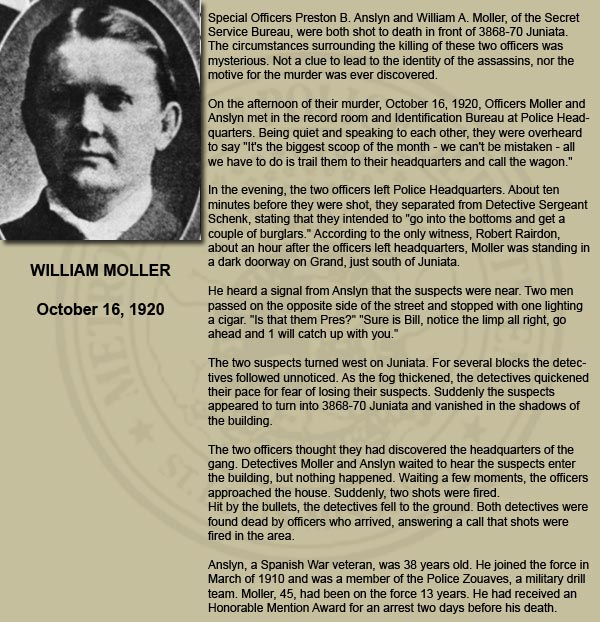 Date of death: October 16, 1920
Full Name: William A. Moller
Content: Special Officers Preston B. Anslyn and William A. Moller, of the Secret
Service Bureau, were both shot o death in front of 3868-70 Juniata.
The circumstances surrounding the killing of these two officers was
mysterious. Not a clue to lead to the identity of the assassins, nor the
motive for the murder was ever discovered.
On the afternoon of their murder, October 16, 1920, Officers Moller and
Ansiyn met in the record room and Identification Bureau at Police Head-
quarters. Being quiet and speaking to each other, they were overheard
to say "It's the biggest scoop of the month - we can't be mistaken - all
we have to do is rail them to their headquarters and call the wagon."
In the evening, the two officers left Police Headquarters. About ten
minutes before they were shot, they separated from Detective Sergeant
Schenck, stating that they intended to "go into the bottoms and get a
couple of burglars" According to the only witness, Robert Rairdon,
about an hour after the officers left headquarters, Moller was standing in
a dark doorway on Grand, just south of Juniata.
He heard a signal from Ansiyn that the suspects were near. Two men
passed on the opposite side of the street and stopped with one lighting
a cigar. "Is that them Pres?" "Sure is Bill, notice the lamp all night, go
ahead and 1 will catch up with you.”
The two suspects fumed west on Juniata. For several blocks the detectives followed unnoticed. As the fog thickened, the detectives quickened
their pace for fear of losing their suspects. Suddenly the suspects
appeared to tum into 3868-70 Juniata and vanished in the shadows of
the building.
The two officers thought they had discovered the headquarters of the
gang. Detectives Moller and Ansiyn waited to hear the suspects enter
the building, but nothing happened. Waiting a few moments, the officers
approached the house. Suddenly, two shots were fired
Hit by the bullets, the detectives fell o the ground. Both detectives were:
found dead by officers who arrived, answering a call that shots were
fired in the area.
Ansiyn, a Spanish War veteran, was 38 years old. He joined the force in
March of 1910 and was a member of the Police Zouaves, a military drill
team. Moller, 45, had been on the force 13 years. He had received an
Honorable Mention Award for an arrest two days before his death.
Date of death: October 16, 1920
Full Name: William A. Moller
Content: Special Officers Preston B. Anslyn and William A. Moller, of the Secret
Service Bureau, were both shot o death in front of 3868-70 Juniata.
The circumstances surrounding the killing of these two officers was
mysterious. Not a clue to lead to the identity of the assassins, nor the
motive for the murder was ever discovered.
On the afternoon of their murder, October 16, 1920, Officers Moller and
Ansiyn met in the record room and Identification Bureau at Police Head-
quarters. Being quiet and speaking to each other, they were overheard
to say "It's the biggest scoop of the month - we can't be mistaken - all
we have to do is rail them to their headquarters and call the wagon."
In the evening, the two officers left Police Headquarters. About ten
minutes before they were shot, they separated from Detective Sergeant
Schenck, stating that they intended to "go into the bottoms and get a
couple of burglars" According to the only witness, Robert Rairdon,
about an hour after the officers left headquarters, Moller was standing in
a dark doorway on Grand, just south of Juniata.
He heard a signal from Ansiyn that the suspects were near. Two men
passed on the opposite side of the street and stopped with one lighting
a cigar. "Is that them Pres?" "Sure is Bill, notice the lamp all night, go
ahead and 1 will catch up with you.”
The two suspects fumed west on Juniata. For several blocks the detectives followed unnoticed. As the fog thickened, the detectives quickened
their pace for fear of losing their suspects. Suddenly the suspects
appeared to tum into 3868-70 Juniata and vanished in the shadows of
the building.
The two officers thought they had discovered the headquarters of the
gang. Detectives Moller and Ansiyn waited to hear the suspects enter
the building, but nothing happened. Waiting a few moments, the officers
approached the house. Suddenly, two shots were fired
Hit by the bullets, the detectives fell o the ground. Both detectives were:
found dead by officers who arrived, answering a call that shots were
fired in the area.
Ansiyn, a Spanish War veteran, was 38 years old. He joined the force in
March of 1910 and was a member of the Police Zouaves, a military drill
team. Moller, 45, had been on the force 13 years. He had received an
Honorable Mention Award for an arrest two days before his death.
 Date of death: October 16, 1920
Full Name: Preston Anslyn
Content: Special Officers Preston B. Anslyn and William A. Moller, of the Secret
Service Bureau, were both shot o death in front of 3868-70 Juniata.
The circumstances surrounding the killing of these two officers was
mysterious. Not a clue to lead to the identity of the assassins, nor the
motive for the murder was ever discovered.
On the afternoon of their murder, October 16, 1920, Officers Moller and
Anslyn met in the record room and Identification Bureau at Police Head-
quarters. Being quiet and speaking to each other, they were overheard
to say "It's the biggest scoop of the month - we can't be mistaken - all
we have to do is rail them to their headquarters and call the wagon."
In the evening, the two officers left Police Headquarters. About ten
minutes before they were shot, they separated from Detective Sergeant
Schenck, stating that they intended to "go into the bottoms and get a
couple of burglars" According to the only witness, Robert Rairdon,
about an hour after the officers left headquarters, Moller was standing in
a dark doorway on Grand, just south of Juniata.
He heard a signal from Ansiyn that the suspects were near. Two men
passed on the opposite side of the street and stopped with one lighting
a cigar. "Is that them Pres?" "Sure is Bill, notice the lamp all night, go
ahead and 1 will catch up with you.”
The two suspects fumed west on Juniata. For several blocks the detectives followed unnoticed. As the fog thickened, the detectives quickened
their pace for fear of losing their suspects. Suddenly the suspects
appeared to tum into 3868-70 Juniata and vanished in the shadows of
the building.
The two officers thought they had discovered the headquarters of the
gang. Detectives Moller and Ansiyn waited to hear the suspects enter
the building, but nothing happened. Waiting a few moments, the officers
approached the house. Suddenly, two shots were fired
Hit by the bullets, the detectives fell o the ground. Both detectives were:
found dead by officers who arrived, answering a call that shots were
fired in the area.
Ansiyn, a Spanish War veteran, was 38 years old. He joined the force in
March of 1910 and was a member of the Police Zouaves, a military drill
team. Moller, 45, had been on the force 13 years. He had received an
Honorable Mention Award for an arrest two days before his death.
Date of death: October 16, 1920
Full Name: Preston Anslyn
Content: Special Officers Preston B. Anslyn and William A. Moller, of the Secret
Service Bureau, were both shot o death in front of 3868-70 Juniata.
The circumstances surrounding the killing of these two officers was
mysterious. Not a clue to lead to the identity of the assassins, nor the
motive for the murder was ever discovered.
On the afternoon of their murder, October 16, 1920, Officers Moller and
Anslyn met in the record room and Identification Bureau at Police Head-
quarters. Being quiet and speaking to each other, they were overheard
to say "It's the biggest scoop of the month - we can't be mistaken - all
we have to do is rail them to their headquarters and call the wagon."
In the evening, the two officers left Police Headquarters. About ten
minutes before they were shot, they separated from Detective Sergeant
Schenck, stating that they intended to "go into the bottoms and get a
couple of burglars" According to the only witness, Robert Rairdon,
about an hour after the officers left headquarters, Moller was standing in
a dark doorway on Grand, just south of Juniata.
He heard a signal from Ansiyn that the suspects were near. Two men
passed on the opposite side of the street and stopped with one lighting
a cigar. "Is that them Pres?" "Sure is Bill, notice the lamp all night, go
ahead and 1 will catch up with you.”
The two suspects fumed west on Juniata. For several blocks the detectives followed unnoticed. As the fog thickened, the detectives quickened
their pace for fear of losing their suspects. Suddenly the suspects
appeared to tum into 3868-70 Juniata and vanished in the shadows of
the building.
The two officers thought they had discovered the headquarters of the
gang. Detectives Moller and Ansiyn waited to hear the suspects enter
the building, but nothing happened. Waiting a few moments, the officers
approached the house. Suddenly, two shots were fired
Hit by the bullets, the detectives fell o the ground. Both detectives were:
found dead by officers who arrived, answering a call that shots were
fired in the area.
Ansiyn, a Spanish War veteran, was 38 years old. He joined the force in
March of 1910 and was a member of the Police Zouaves, a military drill
team. Moller, 45, had been on the force 13 years. He had received an
Honorable Mention Award for an arrest two days before his death.
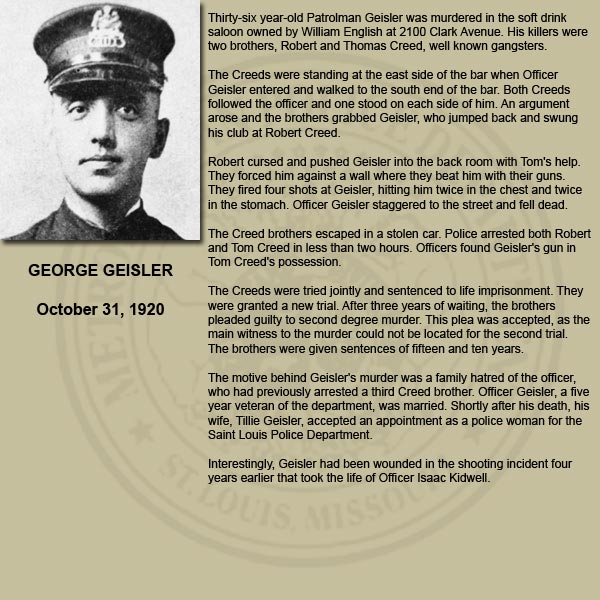 Date of death: October 31, 1920
Full Name: George Geisler
Content: Thirty-six year-old Patrolman Geisler was murdered in the soft drink i
saloon owned by William English at 2100 Clark Avenue. His Killers were
two brothers, Robert and Thomas Creed, well known gangsters.
The Creeds were standing at the east side of the bar when Officer
Geisler entered and walked o the South end of the bar. Both Creeds
followed the officer and one stood on each side of him. An argument
arose and the brothers grabbed Geisler, who jumped back and swung
his club at Robert Creed.
Robert cursed and pushed Geisler info the back room with Tom's help.
They forced him against a wall where they beat him with their guns.
They fired four shots at Geisler, ting him twice in the chest and twice
in the stomach. Officer Geisler Staggered 0 the street and fell dead.
The Creed brothers escaped in a stolen car. Police arrested both Robert
and Tom Creed in less than two hours. Officers found Geisler's gun in
Tom Creed's possession.
The Creeds were tried jointly and sentenced to life imprisonment. They
were granted a new trial. After three years of waiting, the brothers
pleaded guilty to second degree murder. This plea was accepted, as the
main witness to the murder could not be located for the second rial.
The brothers were given sentences of fifteen and ten years.
The motive behind Geisler's murder was a family haired of the officer,
who had previously arrested a third Creed brother. Officer Geisler, a five:
year veteran of the department, was married. Shortly after is death, his
wife, Tillie Geisler, accepted an appointment as a police woman for the
Saint Louis Police Department.
Interestingly, Geisler had been wounded in the shooting incident four
years earlier that took the life of Officer Isaac Kidwell.
Date of death: October 31, 1920
Full Name: George Geisler
Content: Thirty-six year-old Patrolman Geisler was murdered in the soft drink i
saloon owned by William English at 2100 Clark Avenue. His Killers were
two brothers, Robert and Thomas Creed, well known gangsters.
The Creeds were standing at the east side of the bar when Officer
Geisler entered and walked o the South end of the bar. Both Creeds
followed the officer and one stood on each side of him. An argument
arose and the brothers grabbed Geisler, who jumped back and swung
his club at Robert Creed.
Robert cursed and pushed Geisler info the back room with Tom's help.
They forced him against a wall where they beat him with their guns.
They fired four shots at Geisler, ting him twice in the chest and twice
in the stomach. Officer Geisler Staggered 0 the street and fell dead.
The Creed brothers escaped in a stolen car. Police arrested both Robert
and Tom Creed in less than two hours. Officers found Geisler's gun in
Tom Creed's possession.
The Creeds were tried jointly and sentenced to life imprisonment. They
were granted a new trial. After three years of waiting, the brothers
pleaded guilty to second degree murder. This plea was accepted, as the
main witness to the murder could not be located for the second rial.
The brothers were given sentences of fifteen and ten years.
The motive behind Geisler's murder was a family haired of the officer,
who had previously arrested a third Creed brother. Officer Geisler, a five:
year veteran of the department, was married. Shortly after is death, his
wife, Tillie Geisler, accepted an appointment as a police woman for the
Saint Louis Police Department.
Interestingly, Geisler had been wounded in the shooting incident four
years earlier that took the life of Officer Isaac Kidwell.
 Date of death: December 10, 1920
Full Name: Charles Daly
Content: Thirty year-old Detective Charles M. Daly of the Secret Service Bureau
was shot and fatally wounded by a bandit. The robbery occurred in front
of the detective's home at 4021 Forest Park.
Daly was going home in civilian dress. As he arrived in front of his.
home, a robber ordered him to throw up his hands. Daly, who had his
revolver in his coat pocket, turned to draw his pistol and shoot the
bandit. The bandit was too quick and fired first. One bullet struck Officer
Daly in the stomach. The two fought and Daly fell.
The robber fired another shot and struck Daly in the left thigh. By this
time Daly had succeeded in drawing his revolver and fired three shots
at the fleeing robber. The officer was rushed to St. Johns Hospital
where he died a short time later.
According to his wife, a previous attack on Daly happened about six
weeks before. She said several men followed her husband from a
Sarah Street streetcar and attacked him in front of their house. Mrs.
Daly ran to her husband's aid. Drawing his revolver from his coat, Officer Daly threatened his attackers, who then fled. No
connection was made between the first attack and the fatal attack on the officer.
Date of death: December 10, 1920
Full Name: Charles Daly
Content: Thirty year-old Detective Charles M. Daly of the Secret Service Bureau
was shot and fatally wounded by a bandit. The robbery occurred in front
of the detective's home at 4021 Forest Park.
Daly was going home in civilian dress. As he arrived in front of his.
home, a robber ordered him to throw up his hands. Daly, who had his
revolver in his coat pocket, turned to draw his pistol and shoot the
bandit. The bandit was too quick and fired first. One bullet struck Officer
Daly in the stomach. The two fought and Daly fell.
The robber fired another shot and struck Daly in the left thigh. By this
time Daly had succeeded in drawing his revolver and fired three shots
at the fleeing robber. The officer was rushed to St. Johns Hospital
where he died a short time later.
According to his wife, a previous attack on Daly happened about six
weeks before. She said several men followed her husband from a
Sarah Street streetcar and attacked him in front of their house. Mrs.
Daly ran to her husband's aid. Drawing his revolver from his coat, Officer Daly threatened his attackers, who then fled. No
connection was made between the first attack and the fatal attack on the officer.
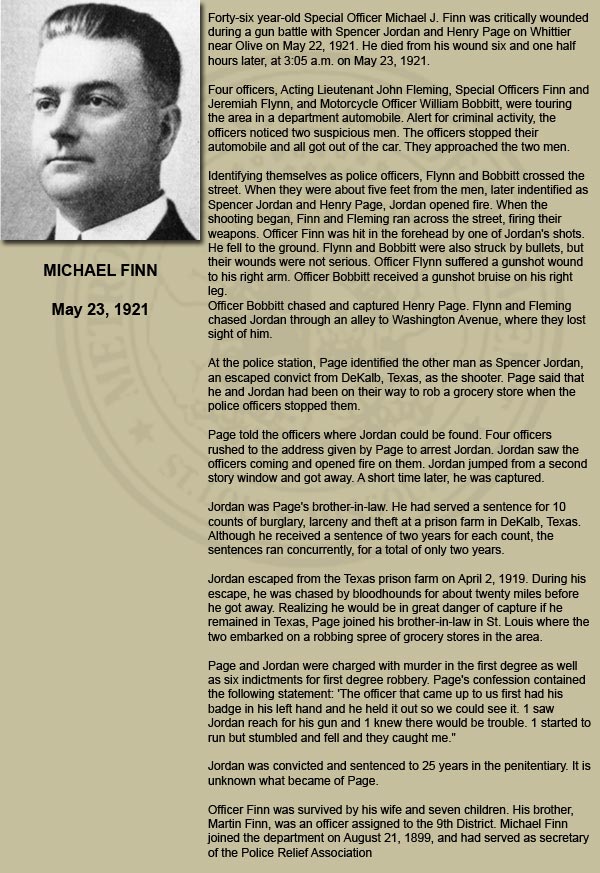 Date of death: May 23,1921
Full Name: Michael Finn
Content: Forty-six year-old Special Officer Michael J. Finn was critically wounded
during a gun battle with Spencer Jordan and Henry Page on Whittier
near Olive on May 22, 1921. He died from his wound six and one half
hours later, at 3.05 a.m. on May 23, 1621
Four officers, Acting Lieutenant John Fleming, Special Officers Finn and
Jeremiah Flynn, and Motorcycle Officer William Bobbitt, were touring
the area in a department automobile. Alert for criminal activity, the
officers noticed two suspicious men. The officers stopped their
automobile and all got out of the car. They approached the two men.
Identifying themselves as police officers, Flynn and Bobbitt crossed the
street. When they were about five feet from the men, later identified as
Spencer Jordan and Henry Page, Jordan opened fire. When the
shooting began, Finn and Fleming ran across the street, firing their
weapons. Officer Finn was hit n the forehead by one of Jordan's shots.
He fell to the ground. Flynn and Bobbitt were also struck by bullets, but
their wounds were not serious. Officer Flynn suffered a gunshot wound
to his right arm. Officer Bobbitt received a gunshot bruise on his right
leg.
Officer Bobbitt chased and captured Henry Page. Flynn and Fleming
chased Jordan through an alley to Washington Avenue, where they lost
sight of him.
At the police station, Page identified the other man as Spencer Jordan,
an escaped convict from DeKalb, Texas, as the shooter. Page said that
he and Jordan had been on their way to rob a grocery store when the
police officers stopped them.
Page told the officers where Jordan could be found. Four officers
rushed to the address given by Page to arrest Jordan. Jordan saw the
officers coming and opened fire on them. Jordan jumped from a second
story window and got away. A short time later, he was captured.
Jordan was Page's brother-in-law. He had served a sentence for 10
counts of burglary, larceny and theft at a prison farm in DeKalb, Texas.
Although he received a sentence of two years for each count, the
sentences ran concurrently, for a total of only two years
Jordan escaped from the Texas prison fa on April 2, 1919. During his
escape, he was chased by bloodhounds for about twenty miles before
he got away. Realizing he would be in great danger of capture if he
remained in Texas, Page joined his brother-in-law in St. Louis where the
two embarked on a robbing spree of grocery stores in the area.
Page and Jordan were charged with murder in the first degree as well
as six indictments for first degree robbery. Page's confession contained
the following statement: The officer that came up to us first had his
badge in his left hand and he held it out so we could see it. 1 saw
Jordan reach for his gun and 1 knew there would be trouble. 1 started to
run but stumbled and fell and they caught me.”
Jordan was convicted and sentenced to 25 years in the penitentiary. It is
unknown what became of Page.
Officer Finn was survived by his wife and seven children. His brother,
Martin Finn, was an officer assigned to the 9th District Michael Finn
joined the department on August 21, 1399, and had served as secretary
of the Police Relief Association.
Date of death: May 23,1921
Full Name: Michael Finn
Content: Forty-six year-old Special Officer Michael J. Finn was critically wounded
during a gun battle with Spencer Jordan and Henry Page on Whittier
near Olive on May 22, 1921. He died from his wound six and one half
hours later, at 3.05 a.m. on May 23, 1621
Four officers, Acting Lieutenant John Fleming, Special Officers Finn and
Jeremiah Flynn, and Motorcycle Officer William Bobbitt, were touring
the area in a department automobile. Alert for criminal activity, the
officers noticed two suspicious men. The officers stopped their
automobile and all got out of the car. They approached the two men.
Identifying themselves as police officers, Flynn and Bobbitt crossed the
street. When they were about five feet from the men, later identified as
Spencer Jordan and Henry Page, Jordan opened fire. When the
shooting began, Finn and Fleming ran across the street, firing their
weapons. Officer Finn was hit n the forehead by one of Jordan's shots.
He fell to the ground. Flynn and Bobbitt were also struck by bullets, but
their wounds were not serious. Officer Flynn suffered a gunshot wound
to his right arm. Officer Bobbitt received a gunshot bruise on his right
leg.
Officer Bobbitt chased and captured Henry Page. Flynn and Fleming
chased Jordan through an alley to Washington Avenue, where they lost
sight of him.
At the police station, Page identified the other man as Spencer Jordan,
an escaped convict from DeKalb, Texas, as the shooter. Page said that
he and Jordan had been on their way to rob a grocery store when the
police officers stopped them.
Page told the officers where Jordan could be found. Four officers
rushed to the address given by Page to arrest Jordan. Jordan saw the
officers coming and opened fire on them. Jordan jumped from a second
story window and got away. A short time later, he was captured.
Jordan was Page's brother-in-law. He had served a sentence for 10
counts of burglary, larceny and theft at a prison farm in DeKalb, Texas.
Although he received a sentence of two years for each count, the
sentences ran concurrently, for a total of only two years
Jordan escaped from the Texas prison fa on April 2, 1919. During his
escape, he was chased by bloodhounds for about twenty miles before
he got away. Realizing he would be in great danger of capture if he
remained in Texas, Page joined his brother-in-law in St. Louis where the
two embarked on a robbing spree of grocery stores in the area.
Page and Jordan were charged with murder in the first degree as well
as six indictments for first degree robbery. Page's confession contained
the following statement: The officer that came up to us first had his
badge in his left hand and he held it out so we could see it. 1 saw
Jordan reach for his gun and 1 knew there would be trouble. 1 started to
run but stumbled and fell and they caught me.”
Jordan was convicted and sentenced to 25 years in the penitentiary. It is
unknown what became of Page.
Officer Finn was survived by his wife and seven children. His brother,
Martin Finn, was an officer assigned to the 9th District Michael Finn
joined the department on August 21, 1399, and had served as secretary
of the Police Relief Association.
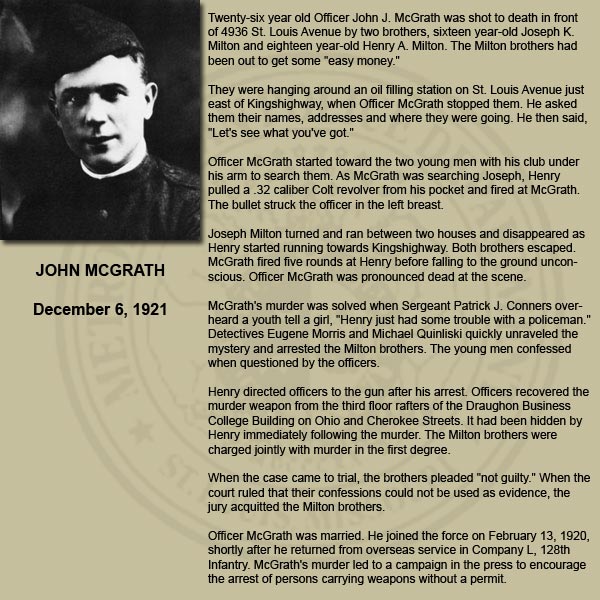 Date of death: December 6, 1921
Full Name: John McGrath
Content: Twenty-six year old Officer John J. McGrath was shot to death in front
014936 St. Louis Avenue by two brothers, sixteen year-old Joseph K.
Milton and eighteen year-old Henry A. Milton. The Milton brothers had
been out to get some “easy money.”
They were hanging around an oil fling station on St. Louis Avenue just
east of Kingshighway, when Officer McGrath stopped them. He asked
them their names, addresses and where they were going. He then said,
"Let's see what you've got".
Officer McGrath started toward the two young men with his club under
his arm to search them. AS McGrath was searching Joseph, Henry
pulled a 32 caliber Colt revolver from his pocket and fired at McGrath.
“The bullet struck the officer in the left breast. |
Joseph Milton fumed and ran between two houses and disappeared as
Henry started running towards Kingshighway. Both brothers escaped.
McGrath fired five rounds at Henry before falling to the ground unconscious. Officer McGrath was pronounced dead at the scene.
McGrath's murder was solved when Sergeant Patick J. Conners over-
heard a youth tell a girl, Henry just had some trouble with a policeman.”
Detectives Eugene Morris and Michael Quinlski quickly unraveled the
mystery and arrested the Milton brothers. The young men confessed
when questioned by the officers.
Henry directed officers to the gun after his arrest. Officers recovered the
murder weapon from the third floor rafters of the Draughon Business
College Building on Ohio and Cherokee Streets. It had been hidden by
Henry immediately following the murder. The Milton brothers were
charged jointly with murder in the first degree.
When the case came to trial, the brothers pleaded "not guilty.” When the
court ruled that their confessions could not be used as evidence, the
jury acquitted the Milton brothers.
Officer McGrath was married. He joined the force on February 13, 1920,
shortly after he returned from overseas service in Company L, 128th
Infantry. McGrath's murder led to a campaign in the press to encourage
the arrest of persons carrying weapons without a permit.
Date of death: December 6, 1921
Full Name: John McGrath
Content: Twenty-six year old Officer John J. McGrath was shot to death in front
014936 St. Louis Avenue by two brothers, sixteen year-old Joseph K.
Milton and eighteen year-old Henry A. Milton. The Milton brothers had
been out to get some “easy money.”
They were hanging around an oil fling station on St. Louis Avenue just
east of Kingshighway, when Officer McGrath stopped them. He asked
them their names, addresses and where they were going. He then said,
"Let's see what you've got".
Officer McGrath started toward the two young men with his club under
his arm to search them. AS McGrath was searching Joseph, Henry
pulled a 32 caliber Colt revolver from his pocket and fired at McGrath.
“The bullet struck the officer in the left breast. |
Joseph Milton fumed and ran between two houses and disappeared as
Henry started running towards Kingshighway. Both brothers escaped.
McGrath fired five rounds at Henry before falling to the ground unconscious. Officer McGrath was pronounced dead at the scene.
McGrath's murder was solved when Sergeant Patick J. Conners over-
heard a youth tell a girl, Henry just had some trouble with a policeman.”
Detectives Eugene Morris and Michael Quinlski quickly unraveled the
mystery and arrested the Milton brothers. The young men confessed
when questioned by the officers.
Henry directed officers to the gun after his arrest. Officers recovered the
murder weapon from the third floor rafters of the Draughon Business
College Building on Ohio and Cherokee Streets. It had been hidden by
Henry immediately following the murder. The Milton brothers were
charged jointly with murder in the first degree.
When the case came to trial, the brothers pleaded "not guilty.” When the
court ruled that their confessions could not be used as evidence, the
jury acquitted the Milton brothers.
Officer McGrath was married. He joined the force on February 13, 1920,
shortly after he returned from overseas service in Company L, 128th
Infantry. McGrath's murder led to a campaign in the press to encourage
the arrest of persons carrying weapons without a permit.
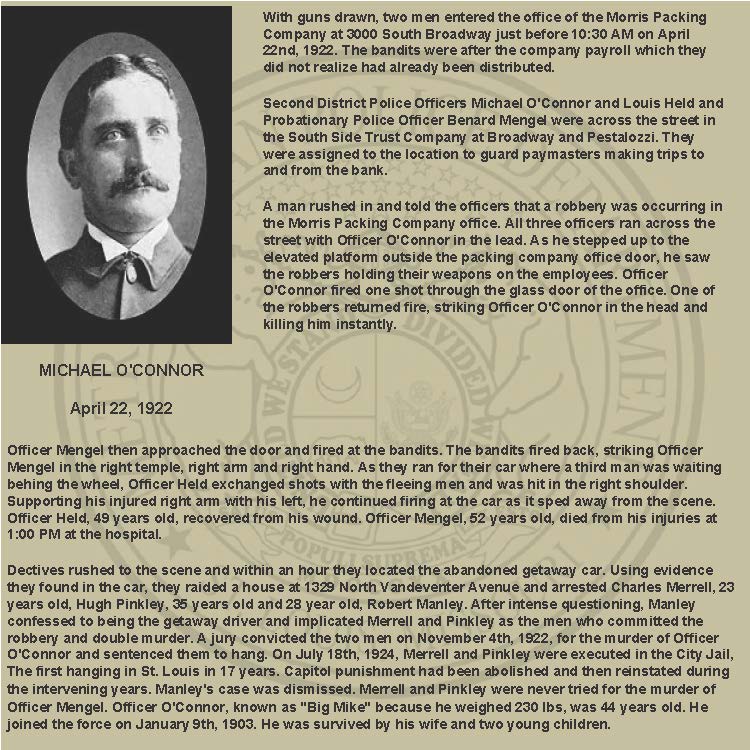 Date of death: April 22, 1922
Full Name: Michael O’Connor
Content: With guns drawn, two men entered the office of the Morris Packing
Company 2t 2000 South Broadway just before 10:30 AM on April
22nd, 1622. The bandits were after the company payroll which they
did not realize had already been distributed.
Second District Police Officers Michael O'Connor and Louis Held and
Probationary Police Officer Benard Mengel were across the street in
the South Side Trust Company at Broadway and Pestalozzl. They
were assigned to the location to guard paymasters making trips to
and from the bank.
A man rushed in and told the officers that robbery was occurring in
the Morris Packing Company office. All three officers ran across the
street with Officer O'Connor in the lead. AS ha stepped up to the
elevated platform outside the packing company office door, he saw
the robbers holding their weapons on the employees. Officer
O'Connor fired one shot through the glass door of the office. One of
the robbers returned fire, striking Officer O'Connor in the head and
Killing him instantly.
Officer Mengel then approached the door and fired at the bandits. The bandits fired back, striking Officer
Mengel in the right temple, right arm and right hand. As they ran for their car where a third man was waiting
behing the whell, Officer Held exchanged shots with the fleeing men and was hit in the right shoulder.
Supporting his injured right arm with his left, he continued firing at the car as ft sped away from the scene.
Officer Held, 49 years old, recovered from his wound. Officer Mengel, 52 years old, died from his injuries at
1:00 PM at the hospital.
Detectives rushed to the scene and within an hour they located the abandoned getaway car. Using evidence.
they found in the car, they raided a house at 1329 North Vandeventer Avenue and arrested Charles Merrell, 23
years old, Hugh Pinkley, 3 years old and 28 year old, Robert Manley. After intense questioning, Manley
confessed to being the getaway driver and implicated Merrell and Pirikley as the men who committed the
robbery and double murder. A jury convicted the two men on November 4th, 1922, for the murder of Officer
O'Connor and sentenced them to hang. On July 18th, 1924, Merrell and Pinkiey Were executed in the City Jail,
The first hanging in St. Louis In 17 years. Capitol punishment had been abolished and then reinstated during
the intervening years. Manley's case was dismissed. Merrell and Pinkley were never tried for the murder of
Officer Mengel. Officer O'Connor, known as "Big Mike" because he weighed 230 lbs, was 44 years old. He.
joined the force on January 9th, 1903. He was survived by his wife and two young children.
Date of death: April 22, 1922
Full Name: Michael O’Connor
Content: With guns drawn, two men entered the office of the Morris Packing
Company 2t 2000 South Broadway just before 10:30 AM on April
22nd, 1622. The bandits were after the company payroll which they
did not realize had already been distributed.
Second District Police Officers Michael O'Connor and Louis Held and
Probationary Police Officer Benard Mengel were across the street in
the South Side Trust Company at Broadway and Pestalozzl. They
were assigned to the location to guard paymasters making trips to
and from the bank.
A man rushed in and told the officers that robbery was occurring in
the Morris Packing Company office. All three officers ran across the
street with Officer O'Connor in the lead. AS ha stepped up to the
elevated platform outside the packing company office door, he saw
the robbers holding their weapons on the employees. Officer
O'Connor fired one shot through the glass door of the office. One of
the robbers returned fire, striking Officer O'Connor in the head and
Killing him instantly.
Officer Mengel then approached the door and fired at the bandits. The bandits fired back, striking Officer
Mengel in the right temple, right arm and right hand. As they ran for their car where a third man was waiting
behing the whell, Officer Held exchanged shots with the fleeing men and was hit in the right shoulder.
Supporting his injured right arm with his left, he continued firing at the car as ft sped away from the scene.
Officer Held, 49 years old, recovered from his wound. Officer Mengel, 52 years old, died from his injuries at
1:00 PM at the hospital.
Detectives rushed to the scene and within an hour they located the abandoned getaway car. Using evidence.
they found in the car, they raided a house at 1329 North Vandeventer Avenue and arrested Charles Merrell, 23
years old, Hugh Pinkley, 3 years old and 28 year old, Robert Manley. After intense questioning, Manley
confessed to being the getaway driver and implicated Merrell and Pirikley as the men who committed the
robbery and double murder. A jury convicted the two men on November 4th, 1922, for the murder of Officer
O'Connor and sentenced them to hang. On July 18th, 1924, Merrell and Pinkiey Were executed in the City Jail,
The first hanging in St. Louis In 17 years. Capitol punishment had been abolished and then reinstated during
the intervening years. Manley's case was dismissed. Merrell and Pinkley were never tried for the murder of
Officer Mengel. Officer O'Connor, known as "Big Mike" because he weighed 230 lbs, was 44 years old. He.
joined the force on January 9th, 1903. He was survived by his wife and two young children.
 Date of death: April 22,1922
Full Name: Bernard C. Mengel
Content: Patrolmen Bernard C. Mengel and Michael O'Connor were shot to
death by two bandits, Charles Merrell and Hugh Pinkiey. The officers
were shot during a holdup of the Morris Packing Company at 3000
South Broadway.
The two officers, and Patrolman Louis A. Held were guarding money at
the South Side Trust Company. A man rushed info the bank and told the
officers a robbery was occurring across the street at the Mortis Packing
Company.
The officers ran out of the bank, with O'Connor in the lead. Patrolman
O'Connor fired one shot through the door at the robbers. The robbers
fumed and came out of the door shooting at O'Connor. Bullets struck
him in the chest and the right side of his head.
Patrolman Mengel, running toward the open door, was also shot in the
head. He died instantly. Patrolman Held returned the robbers’ gunfire. In
the exchange of gunfire, Patrolman Held was shot through the shoulder.
The robbers, with about $100.00 in their pockets, jumped into a car and
sped away as Pairolman Held continued to fire at them.
Within a few minutes detectives were on the scene and took up the trail
Soon, officers found the robbers’ get-away car. Shorty after the discovery of the robbers’ car, police raided a house at 1329 North Vandeventer. In the house officers arrested Charles Merrel, Hugh Pinkley and
Robert Manley, with several other men and women.
Robert Manley made a written confession that he drove the automobile
Manley named Merrell and Pinkley as the men who committed the
robbery and double murder, Convicted of robbery and murder in the fist
degree, the three were sentenced to be hanged. Later, the sentence
was commuted to fife imprisonment at Jefferson City, Missouri.
Date of death: April 22,1922
Full Name: Bernard C. Mengel
Content: Patrolmen Bernard C. Mengel and Michael O'Connor were shot to
death by two bandits, Charles Merrell and Hugh Pinkiey. The officers
were shot during a holdup of the Morris Packing Company at 3000
South Broadway.
The two officers, and Patrolman Louis A. Held were guarding money at
the South Side Trust Company. A man rushed info the bank and told the
officers a robbery was occurring across the street at the Mortis Packing
Company.
The officers ran out of the bank, with O'Connor in the lead. Patrolman
O'Connor fired one shot through the door at the robbers. The robbers
fumed and came out of the door shooting at O'Connor. Bullets struck
him in the chest and the right side of his head.
Patrolman Mengel, running toward the open door, was also shot in the
head. He died instantly. Patrolman Held returned the robbers’ gunfire. In
the exchange of gunfire, Patrolman Held was shot through the shoulder.
The robbers, with about $100.00 in their pockets, jumped into a car and
sped away as Pairolman Held continued to fire at them.
Within a few minutes detectives were on the scene and took up the trail
Soon, officers found the robbers’ get-away car. Shorty after the discovery of the robbers’ car, police raided a house at 1329 North Vandeventer. In the house officers arrested Charles Merrel, Hugh Pinkley and
Robert Manley, with several other men and women.
Robert Manley made a written confession that he drove the automobile
Manley named Merrell and Pinkley as the men who committed the
robbery and double murder, Convicted of robbery and murder in the fist
degree, the three were sentenced to be hanged. Later, the sentence
was commuted to fife imprisonment at Jefferson City, Missouri.
 Date of death: May 26, 1922
Full Name: Patrick Stapleton
Content: Forty-two year-old Patrolman Patrick Stapleton and his partner, Patrolman Michael J. Leary, were walking west on Papin Street. About 11:45
p.m. Mabel Smith, a second-floor resident of 1421 Papin, told the
officers that someone was tampering with her rear window. The officers
went through her house and opened the kitchen door which led to a
porch. Leary flashed his light down into the yard below. He saw a man,
who later proved to be Joseph Kyle, a saloon keeper, between two
sheds in the rear of the yard.
Stapleton fired a shot at Kyle, who disappeared. The officers then ran
down the stairs into the yard and out info a blind alley. As Stapleton
stepped into the alley, he fired another shot. In return, Ky fired, hitting
Stapleton in the chest. Leary and Kyle exchanged gunfire until Leary
ran out of bullets. He searched the alley, but found no trace of Kyle.
Stapleton’s wound would prove fatal.
The Department placed some of its most experienced detectives on the
case. Soon, Detective Sergeant Ira L. Cooper and Detective William W.
Crockett identified the murderer as Joseph Kyle. Kyle was soon
arrested and the Detectives obtained a confession from him.
Kyle claimed that he had gone to the home of Smith, his common-law
wife, because he thought a rival was paying a call. He looked through
the shutters, and, seeing no one, left. As he left the yard, shots were
fired at him.
Vaulting the fence, he found himself in a bind alley. AS the shots continued, he turned and fired in the direction the gunfire had originated. Kyle.
said he had no idea he was firing at police officers; rather, he thought
the rival was frying to kill him. A jury acquitted Kyle of murder.
Stapleton had been on the force since March 11, 1904. He left a widow.
and a fourteen year old daughter. His wife, Josephine, accepted an
appointment as a female detective with the St. Louis Police Department
Soon after the death of her husband.
Date of death: May 26, 1922
Full Name: Patrick Stapleton
Content: Forty-two year-old Patrolman Patrick Stapleton and his partner, Patrolman Michael J. Leary, were walking west on Papin Street. About 11:45
p.m. Mabel Smith, a second-floor resident of 1421 Papin, told the
officers that someone was tampering with her rear window. The officers
went through her house and opened the kitchen door which led to a
porch. Leary flashed his light down into the yard below. He saw a man,
who later proved to be Joseph Kyle, a saloon keeper, between two
sheds in the rear of the yard.
Stapleton fired a shot at Kyle, who disappeared. The officers then ran
down the stairs into the yard and out info a blind alley. As Stapleton
stepped into the alley, he fired another shot. In return, Ky fired, hitting
Stapleton in the chest. Leary and Kyle exchanged gunfire until Leary
ran out of bullets. He searched the alley, but found no trace of Kyle.
Stapleton’s wound would prove fatal.
The Department placed some of its most experienced detectives on the
case. Soon, Detective Sergeant Ira L. Cooper and Detective William W.
Crockett identified the murderer as Joseph Kyle. Kyle was soon
arrested and the Detectives obtained a confession from him.
Kyle claimed that he had gone to the home of Smith, his common-law
wife, because he thought a rival was paying a call. He looked through
the shutters, and, seeing no one, left. As he left the yard, shots were
fired at him.
Vaulting the fence, he found himself in a bind alley. AS the shots continued, he turned and fired in the direction the gunfire had originated. Kyle.
said he had no idea he was firing at police officers; rather, he thought
the rival was frying to kill him. A jury acquitted Kyle of murder.
Stapleton had been on the force since March 11, 1904. He left a widow.
and a fourteen year old daughter. His wife, Josephine, accepted an
appointment as a female detective with the St. Louis Police Department
Soon after the death of her husband.
 Date of death: July 7,1922
Full Name: Bernard Cook
Content: Bernard Cook, a twenty-eight year-old Probationary Patrolman, was
shot and killed in front of the Ely-Walker Company Trunk Factory at
1410 North Sixteenth Street on July 7, 1922. (Cook was assigned to this
location every Friday at 245 pm. to provide a police presence as
checks were distributed.)
Cook noticed two young men loitering near the entrance of the factory.
Suspicious, he approached them. The two began to walk away from the
officer when Cook called out, "Wait a minute, you fellows, I want to talk
to you."
One of the men turned around with a revolver in his hand and fired two
shots at Cook. The two bullets struck the officer, one bullet hit Cook in
the am, the other struck him in the heart. Cook fell to one knee,
mortally wounded. Though dying, he fired five shots at the escaping
men as they ran up the street. He then collapsed and died. The
murderers escaped.
Cook had only been on the force for eight months. He was unmarried.
Date of death: July 7,1922
Full Name: Bernard Cook
Content: Bernard Cook, a twenty-eight year-old Probationary Patrolman, was
shot and killed in front of the Ely-Walker Company Trunk Factory at
1410 North Sixteenth Street on July 7, 1922. (Cook was assigned to this
location every Friday at 245 pm. to provide a police presence as
checks were distributed.)
Cook noticed two young men loitering near the entrance of the factory.
Suspicious, he approached them. The two began to walk away from the
officer when Cook called out, "Wait a minute, you fellows, I want to talk
to you."
One of the men turned around with a revolver in his hand and fired two
shots at Cook. The two bullets struck the officer, one bullet hit Cook in
the am, the other struck him in the heart. Cook fell to one knee,
mortally wounded. Though dying, he fired five shots at the escaping
men as they ran up the street. He then collapsed and died. The
murderers escaped.
Cook had only been on the force for eight months. He was unmarried.
 Date of death: July 26, 1922
Full Name: Sgt. Harry Lemkemeier
Content: On July 26, 1922, Louis Trider, an escaped convict, contacted Nick
"Shoes" Serb, a twenty-year old ex-convict. The two discussed plans to
rob a payroll courier in Wood River, Illinois. Trider needed Serb as a
driver. Serb agreed and Trider picked up Serb and his wife at 1:00 pm.
The three drove to a poolroom at 914 Biddle. At the poolroom they
picked up the final member of he group. As the three sat waiting
Trider's Stutz automobile, Detective Sergeant Harry Lemkemeier and
Detective Charles Shelton drove by.
Shelton recognized Serb and told Lemkemeder to stop and see what he
was up to. Serb said they were waiting for a fiend and that Trider would
then drive them to Alton, Illinois. Lemkemeier told Shelton there was
probably a moonshine party going on in the poolroom. Detective
Shelton went into the poolroom to check it out.
As Shelton entered the poolroom, Lemkemeier walked around to the
driver and asked, "Who are you?" Trider shoved Detective Lemkemeier
away with his left hand, drew a revolver from his waistband with his right
hand and fired. Lemkemeier fell to his knees on the sidewalk. Trider
leaned out of the car and fired another shot at Lemkemeier and drove.
away.
Hearing the shots, Shelton ran from the poolroom in time to see the
Stutz pull away, Trider fired one shot at Shelton. Defective Shelton
stopped a passing truck and ordered the diver to follow the Stutz.
Shelton continued firing at the car until he emptied his revolver as the
Stutz pulled out of sight and disappeared.
Shelton returned to the poolroom and saw Lemkemeier lying at the
curb. Shelton had not realized that Lemkemeier was shot when he
began the chase. Shelton went over to Lemkemeer and discovered that
the Detective was dead. One bullet had passed through his back and
hip and lodged near his hear, king Defective Lemiemeier instantly.
Serb and his wife were arrested at the home of Serb's mother-in-aw at
2:00 pm. A bullet from Shelton's gun had pierced Serb's cap during the
chase, providing evidence of is involvement. Serb stated that Trider
had dropped him and his wife off after losing Shelton in the chase.
Trider then left in his car. Serb and his wife were charged as
accessories to the crime.
A nation-wide search began for Trider. Eight thousand notices were
distributed across the country offering a § 1500 reward for the capture
of Trider. He was described as a former sailor who might try to leave the
country. He was wanted not only for the murder of Lemkemeier, but also
for escaping from the Kentucky State Penitentiary where he was serving
a sentence for shooting a police officer in Louisville.
Kansas City authorities reported that Trider had shot and killed Deputy
Sheriff Edward Lee of Ray County, Missouri the day after the murder of
Detective Lemkemeier in St. Louis. Many private citizens offered liberal
rewards for information leading to his capture.
In October 1922, St. Louis Police Detectives learned that Trider would
S00 return to the St. Louis area. On October 12,1922, in East St. Lous, Illinois, several detectives from St. Louis were undercover,
waiting for Trider to arrive. As a streetcar stopped, the plainclothes
detectives lined up as i to board. When Trider stepped off the streetcar,
one detective said, "I want you, Trider" Trider drew his revolver, but was
killed by the other detectives before he could fire.
Detective Sergeant Lemkemeier had joined the force on July 2, 1907.
On October 19,1918, he was promoted to Sergeant. On August
24,1921, because of his splendid service, he was placed in charge of
Detective District B, embracing the Fourth and Fifth districts. While in
this position, his record of clearing crimes was so impressive that on
June 1,1922, he was placed in charge of the Homicide Squad. He was
survived by his father, with whom he lived, and two brothers, one of
whom was a detective on the force.
Date of death: July 26, 1922
Full Name: Sgt. Harry Lemkemeier
Content: On July 26, 1922, Louis Trider, an escaped convict, contacted Nick
"Shoes" Serb, a twenty-year old ex-convict. The two discussed plans to
rob a payroll courier in Wood River, Illinois. Trider needed Serb as a
driver. Serb agreed and Trider picked up Serb and his wife at 1:00 pm.
The three drove to a poolroom at 914 Biddle. At the poolroom they
picked up the final member of he group. As the three sat waiting
Trider's Stutz automobile, Detective Sergeant Harry Lemkemeier and
Detective Charles Shelton drove by.
Shelton recognized Serb and told Lemkemeder to stop and see what he
was up to. Serb said they were waiting for a fiend and that Trider would
then drive them to Alton, Illinois. Lemkemeier told Shelton there was
probably a moonshine party going on in the poolroom. Detective
Shelton went into the poolroom to check it out.
As Shelton entered the poolroom, Lemkemeier walked around to the
driver and asked, "Who are you?" Trider shoved Detective Lemkemeier
away with his left hand, drew a revolver from his waistband with his right
hand and fired. Lemkemeier fell to his knees on the sidewalk. Trider
leaned out of the car and fired another shot at Lemkemeier and drove.
away.
Hearing the shots, Shelton ran from the poolroom in time to see the
Stutz pull away, Trider fired one shot at Shelton. Defective Shelton
stopped a passing truck and ordered the diver to follow the Stutz.
Shelton continued firing at the car until he emptied his revolver as the
Stutz pulled out of sight and disappeared.
Shelton returned to the poolroom and saw Lemkemeier lying at the
curb. Shelton had not realized that Lemkemeier was shot when he
began the chase. Shelton went over to Lemkemeer and discovered that
the Detective was dead. One bullet had passed through his back and
hip and lodged near his hear, king Defective Lemiemeier instantly.
Serb and his wife were arrested at the home of Serb's mother-in-aw at
2:00 pm. A bullet from Shelton's gun had pierced Serb's cap during the
chase, providing evidence of is involvement. Serb stated that Trider
had dropped him and his wife off after losing Shelton in the chase.
Trider then left in his car. Serb and his wife were charged as
accessories to the crime.
A nation-wide search began for Trider. Eight thousand notices were
distributed across the country offering a § 1500 reward for the capture
of Trider. He was described as a former sailor who might try to leave the
country. He was wanted not only for the murder of Lemkemeier, but also
for escaping from the Kentucky State Penitentiary where he was serving
a sentence for shooting a police officer in Louisville.
Kansas City authorities reported that Trider had shot and killed Deputy
Sheriff Edward Lee of Ray County, Missouri the day after the murder of
Detective Lemkemeier in St. Louis. Many private citizens offered liberal
rewards for information leading to his capture.
In October 1922, St. Louis Police Detectives learned that Trider would
S00 return to the St. Louis area. On October 12,1922, in East St. Lous, Illinois, several detectives from St. Louis were undercover,
waiting for Trider to arrive. As a streetcar stopped, the plainclothes
detectives lined up as i to board. When Trider stepped off the streetcar,
one detective said, "I want you, Trider" Trider drew his revolver, but was
killed by the other detectives before he could fire.
Detective Sergeant Lemkemeier had joined the force on July 2, 1907.
On October 19,1918, he was promoted to Sergeant. On August
24,1921, because of his splendid service, he was placed in charge of
Detective District B, embracing the Fourth and Fifth districts. While in
this position, his record of clearing crimes was so impressive that on
June 1,1922, he was placed in charge of the Homicide Squad. He was
survived by his father, with whom he lived, and two brothers, one of
whom was a detective on the force.
 Date of death: May 7, 1923
Full Name: William Carroll
Content: Patrolman William C. Carroll was accidentally shot to death by his
partner, Detective Adam T. Riek, as they tried to arrest a suspected
burglar. Carroll and Riek, in plainclothes, were driving a department car
on Minerva. The two officers spotted a man who fit the description of a
suspect who had recently committed several daylight burglaries in the
vicinity.
As Officer Riek pulled alongside the suspect, Officer Carroll reached out
of the car and grabbed the man. The suspected burglar gave his name
2s Ray Bingham. He then broke loose from Carroll's grasp, leaving half
of his coat behind.
Both officers leaped out of the car and chased Bingham. Carroll fired
tho shots as he and Bingham disappeared between two houses. Riek
ran into an alley. Bingham suddenly appeared in the yard at 1360 Belt.
Officer Riek fired a shot at him.
As Officer Riek fired a second shot, Officer Carroll ran out from behind a
high board fence directly into the line of fire. The second bullet struck
Officer Carroll in the back of the head. Riek was overcome with grief.
Officers arrested Bingham an hour after. Bingham denied any knowledge about the thefts in the neighborhood, stating he was only there
Joking for work. Bingham said he ran from the detectives because hie
was afraid.
Caroll, who served overseas in the 138th (St. Louis) Infantry, had been
on the force since January 2, 1920. He was a member of the Police
Zouaves. The twenty-eight year-old officer was survived by his parents.
Date of death: May 7, 1923
Full Name: William Carroll
Content: Patrolman William C. Carroll was accidentally shot to death by his
partner, Detective Adam T. Riek, as they tried to arrest a suspected
burglar. Carroll and Riek, in plainclothes, were driving a department car
on Minerva. The two officers spotted a man who fit the description of a
suspect who had recently committed several daylight burglaries in the
vicinity.
As Officer Riek pulled alongside the suspect, Officer Carroll reached out
of the car and grabbed the man. The suspected burglar gave his name
2s Ray Bingham. He then broke loose from Carroll's grasp, leaving half
of his coat behind.
Both officers leaped out of the car and chased Bingham. Carroll fired
tho shots as he and Bingham disappeared between two houses. Riek
ran into an alley. Bingham suddenly appeared in the yard at 1360 Belt.
Officer Riek fired a shot at him.
As Officer Riek fired a second shot, Officer Carroll ran out from behind a
high board fence directly into the line of fire. The second bullet struck
Officer Carroll in the back of the head. Riek was overcome with grief.
Officers arrested Bingham an hour after. Bingham denied any knowledge about the thefts in the neighborhood, stating he was only there
Joking for work. Bingham said he ran from the detectives because hie
was afraid.
Caroll, who served overseas in the 138th (St. Louis) Infantry, had been
on the force since January 2, 1920. He was a member of the Police
Zouaves. The twenty-eight year-old officer was survived by his parents.
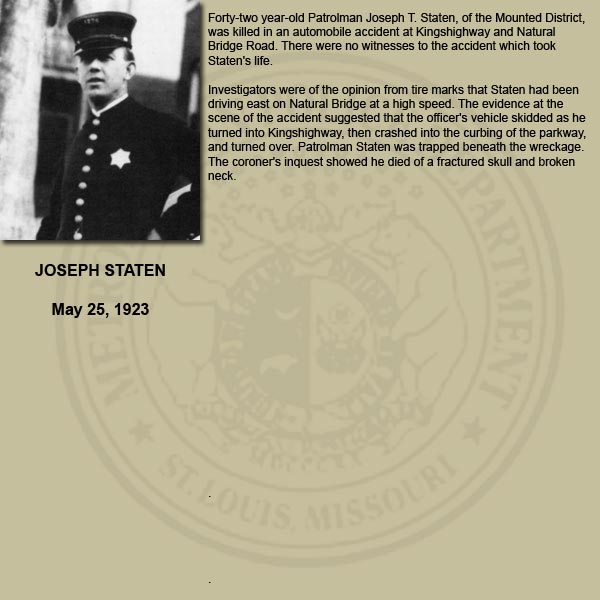 Date of death: May 25, 1923
Full Name: Joesph Staten
Content: Forty-two year-old Patrolman Joseph T. Staten, of the Mounted District,
was killed in an automobile accident at Kingshighway and Natural
Bridge Road. There were no witnesses to the accident which took
State's life.
Investigators were of the opinion from tire marks that Staten had been
driving east on Natural Bridge at a high speed. The evidence at the
scene of the accident suggested that the officer's vehicle skidded as he
turned into Kingshighway, then crashed into the curbing of the parkway,
and turned over. Patrolman Staten was trapped beneath the wreckage.
The coroner's inquest showed he died of a fractured skull and broken
neck.
Date of death: May 25, 1923
Full Name: Joesph Staten
Content: Forty-two year-old Patrolman Joseph T. Staten, of the Mounted District,
was killed in an automobile accident at Kingshighway and Natural
Bridge Road. There were no witnesses to the accident which took
State's life.
Investigators were of the opinion from tire marks that Staten had been
driving east on Natural Bridge at a high speed. The evidence at the
scene of the accident suggested that the officer's vehicle skidded as he
turned into Kingshighway, then crashed into the curbing of the parkway,
and turned over. Patrolman Staten was trapped beneath the wreckage.
The coroner's inquest showed he died of a fractured skull and broken
neck.
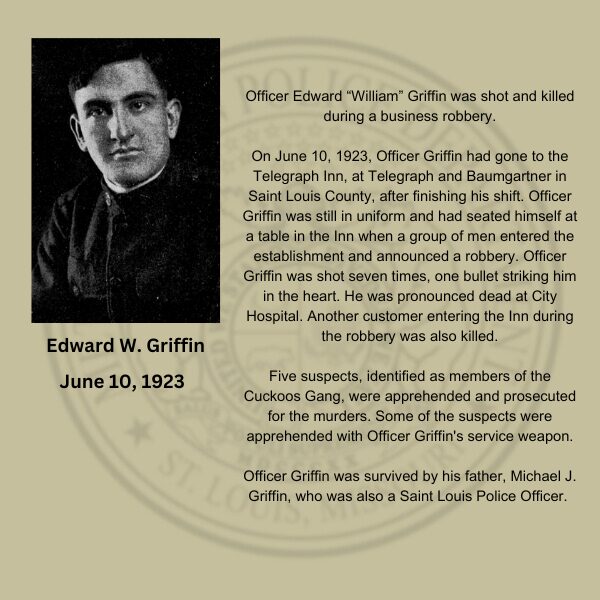 Date of death: June 10, 1923
Full Name: Edward William Griffin
Content: Officer Edward “William” Griffin was shot and killed during a business robbery.
On June 10, 1923, Officer Griffin had gone to the Telegraph Inn, at Telegraph and Baumgartner in Saint Louis County, after finishing his shift. Officer Griffin was still in uniform and had seated himself at a table in the Inn when a group of men entered the establishment and announced a robbery. Officer Griffin was shot seven times, one bullet striking him in the heart. He was pronounced dead at City Hospital. Another customer entering the Inn during the robbery was also killed.
Five suspects, identified as members of the Cuckoos Gang, were apprehended and prosecuted for the murders. Some of the suspects were apprehended with Officer Griffin's service weapon.
Officer Griffin was survived by his father, Michael J. Griffin, who was also a Saint Louis Police Officer.
Date of death: June 10, 1923
Full Name: Edward William Griffin
Content: Officer Edward “William” Griffin was shot and killed during a business robbery.
On June 10, 1923, Officer Griffin had gone to the Telegraph Inn, at Telegraph and Baumgartner in Saint Louis County, after finishing his shift. Officer Griffin was still in uniform and had seated himself at a table in the Inn when a group of men entered the establishment and announced a robbery. Officer Griffin was shot seven times, one bullet striking him in the heart. He was pronounced dead at City Hospital. Another customer entering the Inn during the robbery was also killed.
Five suspects, identified as members of the Cuckoos Gang, were apprehended and prosecuted for the murders. Some of the suspects were apprehended with Officer Griffin's service weapon.
Officer Griffin was survived by his father, Michael J. Griffin, who was also a Saint Louis Police Officer.
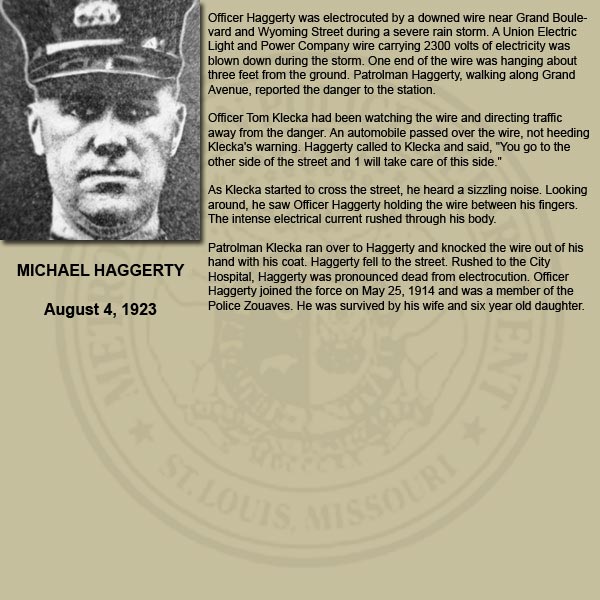 Date of death: August 4, 1923
Full Name: Michael Haggerty
Content: Officer Haggerty was electrocuted by a downed wire near Grand Boulevard and Wyoming Street during a severe rain storm. A Union Electric
Light and Power Company wire carrying 2300 vols of electricity was
blown down during the storm. One end of the wire was hanging about
three feet from the ground. Patrolman Haggerty, waking along Grand
Avenue, reported the danger to the station.
Officer Tom Kiecka had been watching the wire and directing traffic
away from the danger. An automobile passed over the wire, not heeding
Kiecka's warming. Haggerty called to Klecka and said, "You go to the
other side of the street and I will take care of this side.”
As Kiecka started to cross the street, he heard a sizzling noise. Looking.
around, he saw Officer Haggerty holding the wire between his fingers.
The intense electrical current rushed through his body.
Patrolman Klecka ran over to Haggerty and knocked the wire out of his
hand with his coat. Haggerly feel to the street Rushed to the City
Hospital, Haggerty was pronounced dead from electrocution. Officer
Haggerty joined the force on May 25, 1914 and was a member of the
Police Zouaves. He was survived by his wife and six year old daughter.
Date of death: August 4, 1923
Full Name: Michael Haggerty
Content: Officer Haggerty was electrocuted by a downed wire near Grand Boulevard and Wyoming Street during a severe rain storm. A Union Electric
Light and Power Company wire carrying 2300 vols of electricity was
blown down during the storm. One end of the wire was hanging about
three feet from the ground. Patrolman Haggerty, waking along Grand
Avenue, reported the danger to the station.
Officer Tom Kiecka had been watching the wire and directing traffic
away from the danger. An automobile passed over the wire, not heeding
Kiecka's warming. Haggerty called to Klecka and said, "You go to the
other side of the street and I will take care of this side.”
As Kiecka started to cross the street, he heard a sizzling noise. Looking.
around, he saw Officer Haggerty holding the wire between his fingers.
The intense electrical current rushed through his body.
Patrolman Klecka ran over to Haggerty and knocked the wire out of his
hand with his coat. Haggerly feel to the street Rushed to the City
Hospital, Haggerty was pronounced dead from electrocution. Officer
Haggerty joined the force on May 25, 1914 and was a member of the
Police Zouaves. He was survived by his wife and six year old daughter.
 Date of death: November 12, 1923
Full Name: Edward Kuehner
Content: On September 19, 1923, thirty-six year-old Patrolman Edward Kuehner
was critically injured in a traffic accident. On his way investigate a
burglary cal, is patrol car was struck by an eastbound streetcar on
Market Street near Grand Avenue. Officer Kuehner never recovered
from his injuries and died on November 12, 1923, from septicemia, or
blood poisoning.
Officer Kuehner joined the force on October 1, 1920. He left one month
later, only to be reappointed one month later, in December of 1920. He
was survived by a wife and four children.
Date of death: November 12, 1923
Full Name: Edward Kuehner
Content: On September 19, 1923, thirty-six year-old Patrolman Edward Kuehner
was critically injured in a traffic accident. On his way investigate a
burglary cal, is patrol car was struck by an eastbound streetcar on
Market Street near Grand Avenue. Officer Kuehner never recovered
from his injuries and died on November 12, 1923, from septicemia, or
blood poisoning.
Officer Kuehner joined the force on October 1, 1920. He left one month
later, only to be reappointed one month later, in December of 1920. He
was survived by a wife and four children.
 Date of death: November 13,1923
Full Name: John Flaherty
Content: Sixty-two year-old Patrolman John Flaherty died on November 13,
1923, several weeks after he was injured after falling down a fight of
stairs. On October 4, 1923, Flaherty was ascending steps in front of the
home of William Kiely, 3969 Ashland, when he sipped and fell. Though
the distance he fell was only a few feet, he suffered a fracture of the left
leg. Medical complications set in which resulted in his death.
Officer Flaherty joined the force on June 30, 1891, and was promoted to
Sergeant on November 1, 1907. On November 10, 1922, he was reassigned o the rank of patrolman.
Flaherty was known to fellow officers as "Steamboat Jack," a nickname
he received when he was patrolling the levee district. One day, while on
duty, he boarded a steamboat and while he was otherwise occupied,
the boat left the dock.
Flaherty remained on the steamer all day, unable to communicate with
headquarters. His absence was noted and, thinking he had met with
foul play, the Department ordered a city-wide search. He received the
nickname on his return to the levee at the end of the day. Flaherty was
survived by a widow and three children.
Date of death: November 13,1923
Full Name: John Flaherty
Content: Sixty-two year-old Patrolman John Flaherty died on November 13,
1923, several weeks after he was injured after falling down a fight of
stairs. On October 4, 1923, Flaherty was ascending steps in front of the
home of William Kiely, 3969 Ashland, when he sipped and fell. Though
the distance he fell was only a few feet, he suffered a fracture of the left
leg. Medical complications set in which resulted in his death.
Officer Flaherty joined the force on June 30, 1891, and was promoted to
Sergeant on November 1, 1907. On November 10, 1922, he was reassigned o the rank of patrolman.
Flaherty was known to fellow officers as "Steamboat Jack," a nickname
he received when he was patrolling the levee district. One day, while on
duty, he boarded a steamboat and while he was otherwise occupied,
the boat left the dock.
Flaherty remained on the steamer all day, unable to communicate with
headquarters. His absence was noted and, thinking he had met with
foul play, the Department ordered a city-wide search. He received the
nickname on his return to the levee at the end of the day. Flaherty was
survived by a widow and three children.
 Date of death: February 10, 1924
Full Name: William Anderson
Content: Patrolman William Anderson was found lying in a pool of blood on
Vandeventer Avenue just south of Natural Bridge at 5:45 am. on
February 10, 1924. The fifty-four year-old officer had been shot five
times, once each in the back, head and neck. Two bullets passed
through his clothing only. Investigators believed that Anderson was shot
from behind with no provocation. When the body of Officer Anderson
was found, he had his gloves on and his fully loaded revolver was still in
its holster.
A motorman on the Vandeventer streetcar, J. Harold, told investigators
that he had passed the area at 5:00 am and had not seen the officer's
body. He did recall two cars parked nearby, across the street from
Brady's Saloon.
Many people were questioned by the police about the murder, but the
murderer continued to avoid defection. A reward of more than $1,000
failed to generate additional insight to the identity of the murderer.
Officer Anderson had been a member of the force for twenty-five years.
He was survived by a wife and two children.
Date of death: February 10, 1924
Full Name: William Anderson
Content: Patrolman William Anderson was found lying in a pool of blood on
Vandeventer Avenue just south of Natural Bridge at 5:45 am. on
February 10, 1924. The fifty-four year-old officer had been shot five
times, once each in the back, head and neck. Two bullets passed
through his clothing only. Investigators believed that Anderson was shot
from behind with no provocation. When the body of Officer Anderson
was found, he had his gloves on and his fully loaded revolver was still in
its holster.
A motorman on the Vandeventer streetcar, J. Harold, told investigators
that he had passed the area at 5:00 am and had not seen the officer's
body. He did recall two cars parked nearby, across the street from
Brady's Saloon.
Many people were questioned by the police about the murder, but the
murderer continued to avoid defection. A reward of more than $1,000
failed to generate additional insight to the identity of the murderer.
Officer Anderson had been a member of the force for twenty-five years.
He was survived by a wife and two children.
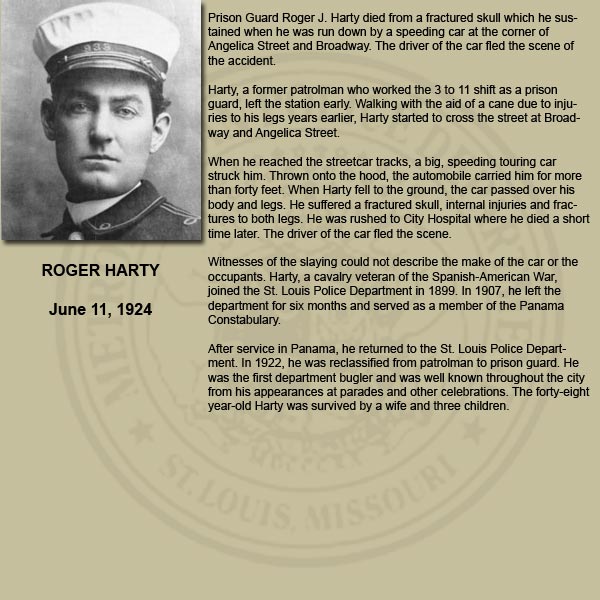 Date of death: June 11, 1924
Full Name: Roger Harty
Content: Prison Guard Roger J. Harty died from a fractured skull which he sustained when he was run down by a speeding car at the comer of
Angelica Street and Broadway. The driver of the car fled the scene of the accident.
Harty, a former patrolman who worked the 310 11 shift as a prison
guard, left the station early. Walking with the aid of a cane due to injuries to his legs years earlier, Harty started to cross the Street at Broadway and Angelica Street.
When he reached the streetcar tracks, a big, speeding touring car
suck him. Thrown onto the hood, the automobile carried him for more.
than forty feet. When Harty fell to the ground, the car passed over his
body and legs. He suffered a fractured skull, internal injuries and fractures to both legs. He was rushed to City Hospital where he died a short
time later. The driver of the car led the scene.
Witnesses of the slaying could not describe the make of the car or the
occupants. Harty, a cavalry veteran of the Spanish-American War,
joined the St.Louis Police Department in 1899. In 1907, he left the
department for six months and served as a member of the Panama
Constabulary.
After service in Panama, he returned to the St. Louis Police Department in 122, he was reclassified from patrolman to prison guard. He
was the first department bugler and was well known throughout the city
from his appearances at parades and other celebrations. The forty-eight
year-old Harty was survived by a wife and three children. |
Date of death: June 11, 1924
Full Name: Roger Harty
Content: Prison Guard Roger J. Harty died from a fractured skull which he sustained when he was run down by a speeding car at the comer of
Angelica Street and Broadway. The driver of the car fled the scene of the accident.
Harty, a former patrolman who worked the 310 11 shift as a prison
guard, left the station early. Walking with the aid of a cane due to injuries to his legs years earlier, Harty started to cross the Street at Broadway and Angelica Street.
When he reached the streetcar tracks, a big, speeding touring car
suck him. Thrown onto the hood, the automobile carried him for more.
than forty feet. When Harty fell to the ground, the car passed over his
body and legs. He suffered a fractured skull, internal injuries and fractures to both legs. He was rushed to City Hospital where he died a short
time later. The driver of the car led the scene.
Witnesses of the slaying could not describe the make of the car or the
occupants. Harty, a cavalry veteran of the Spanish-American War,
joined the St.Louis Police Department in 1899. In 1907, he left the
department for six months and served as a member of the Panama
Constabulary.
After service in Panama, he returned to the St. Louis Police Department in 122, he was reclassified from patrolman to prison guard. He
was the first department bugler and was well known throughout the city
from his appearances at parades and other celebrations. The forty-eight
year-old Harty was survived by a wife and three children. |
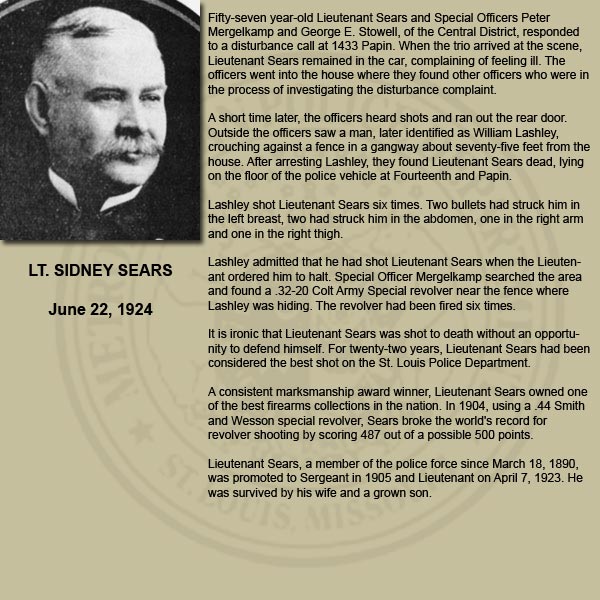 Date of death: June 22, 1924
Full Name: Lt. Sidney Sears
Content: Fifty-seven year-old Lieutenant Sears and Special Officers Peter
Mergelkamp and George E. Stowell, of the Central District, responded
to a disturbance call at 1433 Papin. When the tro arrived at the scene,
Lieutenant Sears remained in the car, complaining of feeling ill. The
officers went into the house where they found other officers who were in
the process of investigating the disturbance complaint.
A short time later, the officers heard shots and ran out the rear door.
Outside the officers saw a man, later identified as William Lashley,
crouching against a fence in a gangway about seventy-five feet from the:
house. After arresting Lashley, they found Lieutenant Sears dead, lying
on the floor of the police vehicle at Fourteenth and Papin.
Lashley shot Lieutenant Sears six times. Two bullets had struck him in the left breast, two had struck him in the abdomen, one in the right am
and one in the right thigh.
Lashley admitted that he had shot Lieutenant Sears when the Lieutenant ordered him to halt Special Officer Mergelkamp searched the area
and found a 32-20 Colt Army Special revolver near the fence where Lashley was hiding. The revolver had been fired six times
it is ironic that Lieutenant Sears was shot to death without an opportunity to defend himself. For twenty-two years, Lieutenant Sears had been
considered the best shot on the St. Louis Police Department.
A consistent marksmanship award winner, Lieutenant Sears owned one |
of the best firearms collections in the nation. In 1904, using a 44 Smith
and Wesson special revolver, Sears broke the world's record for
revolver shooting by scoring 487 out of a possible 500 points.
Lieutenant Sears, a member of the police force since March 18, 1890,
was promoted to Sergeant in 1905 and Lieutenant on April 7, 1923. He
was survived by his wife and a grown son.
Date of death: June 22, 1924
Full Name: Lt. Sidney Sears
Content: Fifty-seven year-old Lieutenant Sears and Special Officers Peter
Mergelkamp and George E. Stowell, of the Central District, responded
to a disturbance call at 1433 Papin. When the tro arrived at the scene,
Lieutenant Sears remained in the car, complaining of feeling ill. The
officers went into the house where they found other officers who were in
the process of investigating the disturbance complaint.
A short time later, the officers heard shots and ran out the rear door.
Outside the officers saw a man, later identified as William Lashley,
crouching against a fence in a gangway about seventy-five feet from the:
house. After arresting Lashley, they found Lieutenant Sears dead, lying
on the floor of the police vehicle at Fourteenth and Papin.
Lashley shot Lieutenant Sears six times. Two bullets had struck him in the left breast, two had struck him in the abdomen, one in the right am
and one in the right thigh.
Lashley admitted that he had shot Lieutenant Sears when the Lieutenant ordered him to halt Special Officer Mergelkamp searched the area
and found a 32-20 Colt Army Special revolver near the fence where Lashley was hiding. The revolver had been fired six times
it is ironic that Lieutenant Sears was shot to death without an opportunity to defend himself. For twenty-two years, Lieutenant Sears had been
considered the best shot on the St. Louis Police Department.
A consistent marksmanship award winner, Lieutenant Sears owned one |
of the best firearms collections in the nation. In 1904, using a 44 Smith
and Wesson special revolver, Sears broke the world's record for
revolver shooting by scoring 487 out of a possible 500 points.
Lieutenant Sears, a member of the police force since March 18, 1890,
was promoted to Sergeant in 1905 and Lieutenant on April 7, 1923. He
was survived by his wife and a grown son.
 Date of death: July 16, 1924
Full Name: Peter Finnerty
Content: In ill health for some time, Patrolman Peter A. Finnerty shot himself in
is left chest with a revolver. The officer died three hours later.
More than two years before his death, Officer Finnerty, while off duty,
was walking along Vandeventer and Labadie Avenues. Unexpectedly,
his hat was blown off by a sudden gust of wind. While chasing his hat,
he did not notice a Vandeventer streetcar, and ran, head down, against
the side of it. He suffered internal injuries and never fully recovered.
He shot himself while lying in bed, while others in the family were at
supper. He said before he died, he felt himself Sipping and did not want
10 be a burden to anyone. Patrolman Finnerty had been a member of
the St. Louis Police Department since 1895.
Date of death: July 16, 1924
Full Name: Peter Finnerty
Content: In ill health for some time, Patrolman Peter A. Finnerty shot himself in
is left chest with a revolver. The officer died three hours later.
More than two years before his death, Officer Finnerty, while off duty,
was walking along Vandeventer and Labadie Avenues. Unexpectedly,
his hat was blown off by a sudden gust of wind. While chasing his hat,
he did not notice a Vandeventer streetcar, and ran, head down, against
the side of it. He suffered internal injuries and never fully recovered.
He shot himself while lying in bed, while others in the family were at
supper. He said before he died, he felt himself Sipping and did not want
10 be a burden to anyone. Patrolman Finnerty had been a member of
the St. Louis Police Department since 1895.
 Date of death: July 26,1924
Full Name: Bernard Early
Content: Fifty-one year-old Patrolman Bernard Early was shot to death in Michael
Wood's Saloon at 3830 Easton by a robber. Patrolman Early was.
standing in a small room in the rear of the saloon when a man entered
the front door flourishing a revolver. The robber walked to the bar, and
ordered Wood to "Stick 'em up.” Wood dropped behind the bar, but
three patrons followed his orders and raised their hands.
Patrolman Early, with club in hand, advanced on the gunman to disarm
him. Early struck at him with his nightstick, but missed. The gunman
fumed and fired four shots at Early, hitting the officer twice in the stomach and once in the am. As Officer Early fell to the floor, the robber ran
out of the saloon.
Critically injured, Early succeeded in reaching the call box. He told the
9th District Station that he had just thwarted a holdup, but did not mention that he had been shot. Before he died, he gave detectives a
description of the suspect The investigation led to John Nearly. A short
time later, after an extensive search of the neighborhood, officers
arrested Nearly, who soon confessed to the robbery and shooting of
Patrolman Early. Early, who was single, had joined the force in 1903.
Date of death: July 26,1924
Full Name: Bernard Early
Content: Fifty-one year-old Patrolman Bernard Early was shot to death in Michael
Wood's Saloon at 3830 Easton by a robber. Patrolman Early was.
standing in a small room in the rear of the saloon when a man entered
the front door flourishing a revolver. The robber walked to the bar, and
ordered Wood to "Stick 'em up.” Wood dropped behind the bar, but
three patrons followed his orders and raised their hands.
Patrolman Early, with club in hand, advanced on the gunman to disarm
him. Early struck at him with his nightstick, but missed. The gunman
fumed and fired four shots at Early, hitting the officer twice in the stomach and once in the am. As Officer Early fell to the floor, the robber ran
out of the saloon.
Critically injured, Early succeeded in reaching the call box. He told the
9th District Station that he had just thwarted a holdup, but did not mention that he had been shot. Before he died, he gave detectives a
description of the suspect The investigation led to John Nearly. A short
time later, after an extensive search of the neighborhood, officers
arrested Nearly, who soon confessed to the robbery and shooting of
Patrolman Early. Early, who was single, had joined the force in 1903.
 Date of death: November 10, 1924
Full Name: Sgt. Robert Woody
Content: Sergeant Woody and Patrolman Wiese were making the rounds of the
precinct in a police car when they saw a car speed by with the right
running board of the car in flames. They immediately followed in pursuit
At Fair and Penrose, the four men in the car realized that the police were behind them. They pulled their car o the curb and, with revolvers
drawn, leaped from the car, abandoning their burning automobile. While police bullets rained around them, the four men ran in different
directions.
Officers Woody and Wiese stopped their car and started after the men
on foot. During the exchange of shots, three of the men disappeared
into the darkness. The fourth man jumped on the running board of a
passing car, trying to escape.
The car did not start The bandit jumped off the car and exchanged
more gunfire with Woody and Wiese before he ran up the sireet_ft was
one of these shots that struck Sergeant Woody in the abdomen. Sergeant Woody fell to the ground, mortally wounded. He died a short time.
later.
Two men, Caly Cratty and Nicholas Hare, were arrested in connection with the incident. Caly Cratty was identified as the man who shot Sergeant Woody. Nicholas Hare had been shot in the thigh by the officers.
Hare made a statement in which he named Cratty and two other men as
his companions in a series of automobile thefts and holdups. He said
that the holdups had started Friday and culminated in the early morning
clash with the officers on Sunday. Sgt. Woody joined the force in 1899
and was promoted to sergeant in 1923. He was fifty-two years old and
was survived by a wife and daughter.
Date of death: November 10, 1924
Full Name: Sgt. Robert Woody
Content: Sergeant Woody and Patrolman Wiese were making the rounds of the
precinct in a police car when they saw a car speed by with the right
running board of the car in flames. They immediately followed in pursuit
At Fair and Penrose, the four men in the car realized that the police were behind them. They pulled their car o the curb and, with revolvers
drawn, leaped from the car, abandoning their burning automobile. While police bullets rained around them, the four men ran in different
directions.
Officers Woody and Wiese stopped their car and started after the men
on foot. During the exchange of shots, three of the men disappeared
into the darkness. The fourth man jumped on the running board of a
passing car, trying to escape.
The car did not start The bandit jumped off the car and exchanged
more gunfire with Woody and Wiese before he ran up the sireet_ft was
one of these shots that struck Sergeant Woody in the abdomen. Sergeant Woody fell to the ground, mortally wounded. He died a short time.
later.
Two men, Caly Cratty and Nicholas Hare, were arrested in connection with the incident. Caly Cratty was identified as the man who shot Sergeant Woody. Nicholas Hare had been shot in the thigh by the officers.
Hare made a statement in which he named Cratty and two other men as
his companions in a series of automobile thefts and holdups. He said
that the holdups had started Friday and culminated in the early morning
clash with the officers on Sunday. Sgt. Woody joined the force in 1899
and was promoted to sergeant in 1923. He was fifty-two years old and
was survived by a wife and daughter.
 Date of death: November 23, 1924
Full Name: Fred Benz
Content: Special Officer Fred Benz, forty-six years-old, was shot in the abdomen
on the evening of November 22, 1924, as he fried to arrest a burglar. He
died 24 hours later.
While cruising the Twelfth District, Special Officers Robert Bourland,
William Qeisman, Benz and Bart Cecil were sent to 1424 Amherst Place
to investigate a report of a burglar in the house. When they arrived, they
were met by Lieutenant John J. McMillen, Officer Daniel Mahoney and
Chauffeur Clarence McCuddy.
Mrs. Lydia Moechel told the officers that she noticed someone in her
home with a flashlight when she returned from errands. She called the.
police from her neighbor's house.
Officers Benz and Cecil went o the rear of the home. Officers Qeisman
and McCuddy entered the house through an open basement door. The
officers continued to the first floor through a door that had been forced
open. When they entered the sun parlor, the burglar, Wiliam Bormann,
jumped out the window. He landed five feet from Officer Benz.
Officers Benz and Cecil ordered Bormann to halt. Bormann instead
opened fire. Bullets struck Officer Benz in the abdomen and right leg
Benz returned the fire, striking Bormann in his let hip.
Bormann was taken into custody after being treated for his wound
Officers found jewelry belonging to Mrs. Moechel on Bormann. He
admitted burglarizing the residence, but said he could not remember
firing any shots at the officers.
Benz was married, but had no children. He had been on the force since
November 28, 1902.
Date of death: November 23, 1924
Full Name: Fred Benz
Content: Special Officer Fred Benz, forty-six years-old, was shot in the abdomen
on the evening of November 22, 1924, as he fried to arrest a burglar. He
died 24 hours later.
While cruising the Twelfth District, Special Officers Robert Bourland,
William Qeisman, Benz and Bart Cecil were sent to 1424 Amherst Place
to investigate a report of a burglar in the house. When they arrived, they
were met by Lieutenant John J. McMillen, Officer Daniel Mahoney and
Chauffeur Clarence McCuddy.
Mrs. Lydia Moechel told the officers that she noticed someone in her
home with a flashlight when she returned from errands. She called the.
police from her neighbor's house.
Officers Benz and Cecil went o the rear of the home. Officers Qeisman
and McCuddy entered the house through an open basement door. The
officers continued to the first floor through a door that had been forced
open. When they entered the sun parlor, the burglar, Wiliam Bormann,
jumped out the window. He landed five feet from Officer Benz.
Officers Benz and Cecil ordered Bormann to halt. Bormann instead
opened fire. Bullets struck Officer Benz in the abdomen and right leg
Benz returned the fire, striking Bormann in his let hip.
Bormann was taken into custody after being treated for his wound
Officers found jewelry belonging to Mrs. Moechel on Bormann. He
admitted burglarizing the residence, but said he could not remember
firing any shots at the officers.
Benz was married, but had no children. He had been on the force since
November 28, 1902.
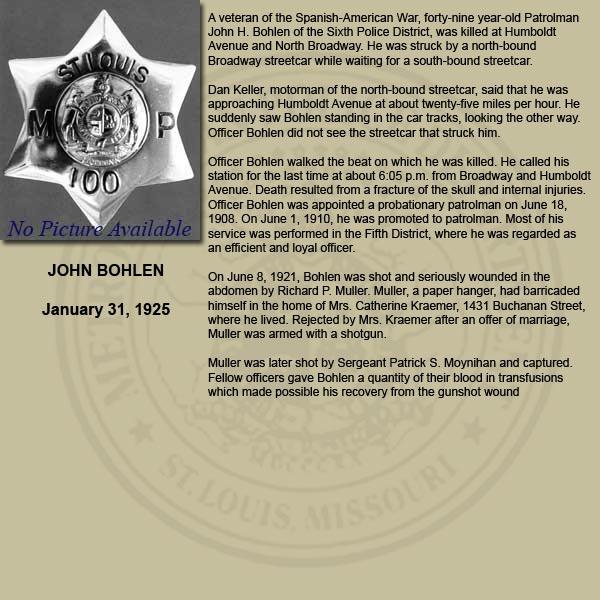 Date of death: January 31,1925
Full Name: John Bohlen
Content: A veteran of the Spanish-American War, forty-nine year-old Patrolman
John H. Bohlen of the Sixth Police District, was killed at Humboldt
Avenue and North Broadway. He was struck by a north-bound
Broadway streetcar while waiting for a south-bound streetcar.
Dan Keller, motorman of the north-bound streetcar, said that he was
approaching Humboldt Avenue at about twenty-five miles per hour. He
suddenly saw Bohlen standing in the car racks, looking the other way.
Officer Bohlen did not see the streetcar that struck him.
Officer Bohlen walked the beat on which he was killed. He called his
station for the last time at about 6:05 p.m. from Broadway and Humboldt
Avenue. Death resulted from a fracture of the skull and internal injures.
Officer Bohlen was appointed a probationary patrolman on June 18,
1908. On June 1, 1910, he was promoted to patrolman. Most of his
service was performed in the Fifth District, where he was regarded as
an efficient and loyal officer.
On June 8, 1921, Bohlen was shot and seriously wounded in the
abdomen by Richard P. Muller. Muller, a paper hanger, had barricaded
himself in the home of Mrs. Catherine Kraemer, 1431 Buchanan Street,
where he lived. Rejected by Mrs. Kraemer after an offer of marriage,
Muller was armed with a shotgun.
Muller was later shot by Sergeant Patrick S. Moynihan and captured.
Fellow officers gave Bohlen a quantity of their blood in transfusions
‘which made possible his recovery from the gunshot wound.
Date of death: January 31,1925
Full Name: John Bohlen
Content: A veteran of the Spanish-American War, forty-nine year-old Patrolman
John H. Bohlen of the Sixth Police District, was killed at Humboldt
Avenue and North Broadway. He was struck by a north-bound
Broadway streetcar while waiting for a south-bound streetcar.
Dan Keller, motorman of the north-bound streetcar, said that he was
approaching Humboldt Avenue at about twenty-five miles per hour. He
suddenly saw Bohlen standing in the car racks, looking the other way.
Officer Bohlen did not see the streetcar that struck him.
Officer Bohlen walked the beat on which he was killed. He called his
station for the last time at about 6:05 p.m. from Broadway and Humboldt
Avenue. Death resulted from a fracture of the skull and internal injures.
Officer Bohlen was appointed a probationary patrolman on June 18,
1908. On June 1, 1910, he was promoted to patrolman. Most of his
service was performed in the Fifth District, where he was regarded as
an efficient and loyal officer.
On June 8, 1921, Bohlen was shot and seriously wounded in the
abdomen by Richard P. Muller. Muller, a paper hanger, had barricaded
himself in the home of Mrs. Catherine Kraemer, 1431 Buchanan Street,
where he lived. Rejected by Mrs. Kraemer after an offer of marriage,
Muller was armed with a shotgun.
Muller was later shot by Sergeant Patrick S. Moynihan and captured.
Fellow officers gave Bohlen a quantity of their blood in transfusions
‘which made possible his recovery from the gunshot wound.
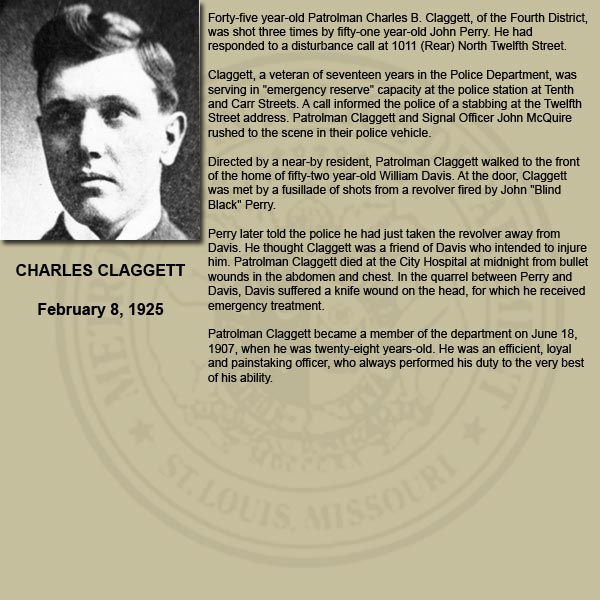 Date of death: February 8, 1925
Full Name: Charles Claggett
Content: Forty-five year-old Patrolman Charles B. Claggett, of the Fourth District,
was shot three times by fifty-one year-old John Perry. He had
responded to a disturbance call at 1011 (Rear) North Twelfth Street.
Claggett, a veteran of seventeen years in the Police Department, was
serving in “emergency reserve” capacity at the police Station at Tenth
and Carr Streets. A call informed the police of a stabbing at the Twelfth
Street address. Patrolman Claggett and Signal Officer John McQuire:
rushed to the scene in their police vehicle.
Directed by a near-by resident, Patrolman Claggett walked to the front
of the home of fifty-two year-old William Davis. At the door, Clagget
was met by a fusillade of shots from a revolver fired by John "Bind
Black” Perry.
Perry later told the police he had just taken the revolver away from
Davis. He thought Claggett was a friend of Davis who in ended to injure:
him. Patrolman Claggett died at the City Hospital at midnight from bullet
wounds in the abdomen and chest. In the quarrel between Perry and
Davis, Davis suffered a knife wound on the head, for which he received
emergency treatment.
Patrolman Claggett became a member of the department on June 18,
1907, when he was twenty-eight years-old. He was an efficient, loyal
and painstaking officer, who always performed his duly to the very best
of his abilty.
Date of death: February 8, 1925
Full Name: Charles Claggett
Content: Forty-five year-old Patrolman Charles B. Claggett, of the Fourth District,
was shot three times by fifty-one year-old John Perry. He had
responded to a disturbance call at 1011 (Rear) North Twelfth Street.
Claggett, a veteran of seventeen years in the Police Department, was
serving in “emergency reserve” capacity at the police Station at Tenth
and Carr Streets. A call informed the police of a stabbing at the Twelfth
Street address. Patrolman Claggett and Signal Officer John McQuire:
rushed to the scene in their police vehicle.
Directed by a near-by resident, Patrolman Claggett walked to the front
of the home of fifty-two year-old William Davis. At the door, Clagget
was met by a fusillade of shots from a revolver fired by John "Bind
Black” Perry.
Perry later told the police he had just taken the revolver away from
Davis. He thought Claggett was a friend of Davis who in ended to injure:
him. Patrolman Claggett died at the City Hospital at midnight from bullet
wounds in the abdomen and chest. In the quarrel between Perry and
Davis, Davis suffered a knife wound on the head, for which he received
emergency treatment.
Patrolman Claggett became a member of the department on June 18,
1907, when he was twenty-eight years-old. He was an efficient, loyal
and painstaking officer, who always performed his duly to the very best
of his abilty.
 Date of death: April 4, 1925
Full Name: Harry Wise
Content: On February 15, 1925, Officer Harry Wise of the Motorcycle Squad of
the Traffic Division was riding his motorcycle west on St. Louis Avenue.
As he approached Union Boulevard, he became ill. According to
witnesses, he was travelling at a moderate speed when he suddenly
threw his hands up and fell backwards off his machine. Doctors.
believed that he suffered a uremic convulsion.
Wise died on April 4, 1925, from the fractured skull he sustained when
he fell from his motorcycle. He left a wife and child. Wise, twenty-six
years-old, had been on the force for two years.
Date of death: April 4, 1925
Full Name: Harry Wise
Content: On February 15, 1925, Officer Harry Wise of the Motorcycle Squad of
the Traffic Division was riding his motorcycle west on St. Louis Avenue.
As he approached Union Boulevard, he became ill. According to
witnesses, he was travelling at a moderate speed when he suddenly
threw his hands up and fell backwards off his machine. Doctors.
believed that he suffered a uremic convulsion.
Wise died on April 4, 1925, from the fractured skull he sustained when
he fell from his motorcycle. He left a wife and child. Wise, twenty-six
years-old, had been on the force for two years.
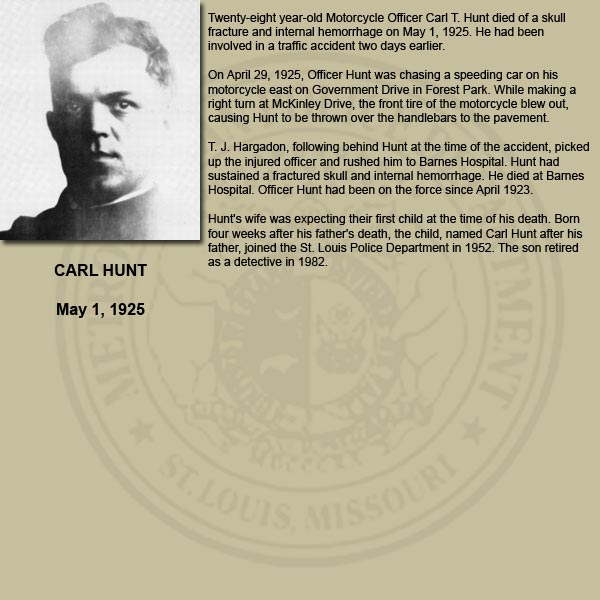 Date of death: May 1, 1925
Full Name: Carl Hunt
Content: Twenty-eight year-old Motorcycle Officer Carl T. Hunt died of a skull
fracture and internal hemorrhage on May 1, 1925. He had been
involved in a traffic accident two days earlier.
On April 29, 1925, Officer Hunt was chasing a speeding car on his
motorcycle east on Government Drive in Forest Park. While making a
right tum at McKinley Drive, the front tire of the motorcycle blew out,
causing Hunt to be thrown over the handlebars to the pavement.
TJ. Hargadon, following behind Hunt at the time of the accident, picked
up the injured officer and rushed him to Barnes Hospital. Hunt had
sustained a fractured skull and internal hemorrhage. He died at Barnes
Hospital. Officer Hunt had been on the force since April 1923.
Hunt's wife was expecting their first child at the time of his death. Born
four weeks after his father's death, the child, named Carl Hunt after his
father, joined the St. Louis Police Department in 1952. The son retired
as a detective in 1982.
Date of death: May 1, 1925
Full Name: Carl Hunt
Content: Twenty-eight year-old Motorcycle Officer Carl T. Hunt died of a skull
fracture and internal hemorrhage on May 1, 1925. He had been
involved in a traffic accident two days earlier.
On April 29, 1925, Officer Hunt was chasing a speeding car on his
motorcycle east on Government Drive in Forest Park. While making a
right tum at McKinley Drive, the front tire of the motorcycle blew out,
causing Hunt to be thrown over the handlebars to the pavement.
TJ. Hargadon, following behind Hunt at the time of the accident, picked
up the injured officer and rushed him to Barnes Hospital. Hunt had
sustained a fractured skull and internal hemorrhage. He died at Barnes
Hospital. Officer Hunt had been on the force since April 1923.
Hunt's wife was expecting their first child at the time of his death. Born
four weeks after his father's death, the child, named Carl Hunt after his
father, joined the St. Louis Police Department in 1952. The son retired
as a detective in 1982.
 Date of death: July 3, 1925
Full Name: John H. Grogan
Content: Forty-nine year-old Patrolman John H. Grogan of the Twelfth Police
District and a bystander, Harvey Hammett, died from wounds received
during a revolver bate with six payroll robbers in the first floor vestibule:
at 1531 Washington Avenue. Shortly after 4 p.m. six youths held
handkerchiefs over their faces and entered the office of the H. S. Collins.
Printing Company at 1531 Washington Avenue. Twenty of the
company's sixty-five employees were in the office. The young men
expected to find a cash payroll.
The robbers discovered that the employees had been paid by check,
rather than cash. One of the robbers forced the cashier, Ms. EN.
Frazier, to tum over $40 from the safe.
Four of the bandits then lined up the employees, among whom was the
president of the company, H. S. Collins. The robbers told the employees
to throw their money on the floor. Two of the young robbers gathered
about $100 in this manner.
Collins threw his pocket-book into a corner. When he resisted the
search, one of the robbers struck him in the head, causing a minor
laceration of the scalp.
While the holdup was in progress, one of the workers, Cms Bokamper,
left the building by a rear door to Spread the alarm. Officer John Grogan
was just leaving the Roberts, Johnson & Rand branch of the Infemational Shoe Company at 1505 Washington when he leamed of the
robbery.
Grogan hurried to the scene. He reached the elevator landing on the
first floor as the bandits stepped out of the elevator door a few feet from
him. One of the robbers said: “There's a cop — shoot him. Grogan
whipped out his revolver and exchanged gunfire with the robbers.
Patrolman Grogan was killed by a bullet that pierced his heart and
another that imbedded itself below the right eye.
Paul R. Hauschulte, a stockroom clerk, came up a fight of steps from
the basement. He tried to cut off the escape of the robbers by holding
the door shut. Hauschulte was overpowered and pushed aside by the
robbers.
Harvey Hammett, a bystander and the brother of a St. Louis Police
Officer, saw Grogan stagger after being shot. As he rushed to the
wounded officer's aid, the robbers shot Hammett in the left side of his
chest. The heroic Hammett died from his wound the following morning
at the City Hospital.
The bandits then ran from the building and through a vacant lot
adjoining the building on the east. H. S. Collins told detectives the
robbers were all young and nervous. "It looked as if they were engaged
in their first robbery,” Collins said. “Three of them were armed with
automatic pistols while a fourth carried a large revolver.”
The six youths ranged in age from sixteen to twenty years-old. Identified
as the robbers who killed Officer Grogan and Hammett were Maurice
O'Fiaherty, Frank Bird, Fred James, William Kahrhoft, James Widmer,
and Leo Sproull. In his confession, O'Flaherty said the robbery was
conceived, planned and executed within 3172 hours. They had left their
escape to the chance of stealing a car from a passing motorist.
Grogan was survived by a wife and four children. Grogan had been on
the force for twenty-two years.
Date of death: July 3, 1925
Full Name: John H. Grogan
Content: Forty-nine year-old Patrolman John H. Grogan of the Twelfth Police
District and a bystander, Harvey Hammett, died from wounds received
during a revolver bate with six payroll robbers in the first floor vestibule:
at 1531 Washington Avenue. Shortly after 4 p.m. six youths held
handkerchiefs over their faces and entered the office of the H. S. Collins.
Printing Company at 1531 Washington Avenue. Twenty of the
company's sixty-five employees were in the office. The young men
expected to find a cash payroll.
The robbers discovered that the employees had been paid by check,
rather than cash. One of the robbers forced the cashier, Ms. EN.
Frazier, to tum over $40 from the safe.
Four of the bandits then lined up the employees, among whom was the
president of the company, H. S. Collins. The robbers told the employees
to throw their money on the floor. Two of the young robbers gathered
about $100 in this manner.
Collins threw his pocket-book into a corner. When he resisted the
search, one of the robbers struck him in the head, causing a minor
laceration of the scalp.
While the holdup was in progress, one of the workers, Cms Bokamper,
left the building by a rear door to Spread the alarm. Officer John Grogan
was just leaving the Roberts, Johnson & Rand branch of the Infemational Shoe Company at 1505 Washington when he leamed of the
robbery.
Grogan hurried to the scene. He reached the elevator landing on the
first floor as the bandits stepped out of the elevator door a few feet from
him. One of the robbers said: “There's a cop — shoot him. Grogan
whipped out his revolver and exchanged gunfire with the robbers.
Patrolman Grogan was killed by a bullet that pierced his heart and
another that imbedded itself below the right eye.
Paul R. Hauschulte, a stockroom clerk, came up a fight of steps from
the basement. He tried to cut off the escape of the robbers by holding
the door shut. Hauschulte was overpowered and pushed aside by the
robbers.
Harvey Hammett, a bystander and the brother of a St. Louis Police
Officer, saw Grogan stagger after being shot. As he rushed to the
wounded officer's aid, the robbers shot Hammett in the left side of his
chest. The heroic Hammett died from his wound the following morning
at the City Hospital.
The bandits then ran from the building and through a vacant lot
adjoining the building on the east. H. S. Collins told detectives the
robbers were all young and nervous. "It looked as if they were engaged
in their first robbery,” Collins said. “Three of them were armed with
automatic pistols while a fourth carried a large revolver.”
The six youths ranged in age from sixteen to twenty years-old. Identified
as the robbers who killed Officer Grogan and Hammett were Maurice
O'Fiaherty, Frank Bird, Fred James, William Kahrhoft, James Widmer,
and Leo Sproull. In his confession, O'Flaherty said the robbery was
conceived, planned and executed within 3172 hours. They had left their
escape to the chance of stealing a car from a passing motorist.
Grogan was survived by a wife and four children. Grogan had been on
the force for twenty-two years.
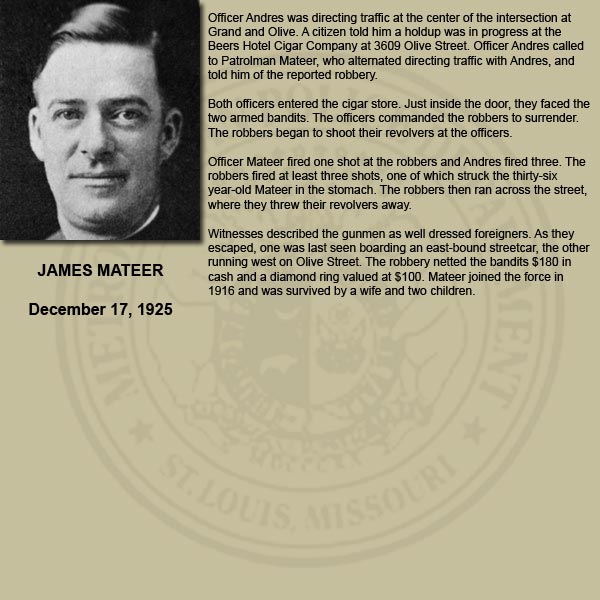 Date of death: December 17, 1925
Full Name: James Mateer
Content: Officer Andres was directing traffic at the center of the intersection at
Grand and Olive. A citizen told him a holdup was in progress at the
Beers Hotel Cigar Company at 3608 Olive Street. Officer Andres called
to Patrolman Mateer, who alternated directing traffic with Andres, and
told him of the reported robbery.
Both officers entered the cigar store. Just inside the door, they faced the
two armed bans. The officers commanded the robbers to surrender.
The robbers began to shoo their revolvers at the officers.
Officer Mateer fired one shot at the robbers and Andres fired three. The
robbers fired at least three shots, one of which struck the thirty-six
year-old Mateer in the stomach. The robbers then ran across the street,
where they threw their revolvers away.
Witnesses described the gunmen as well-dressed foreigners. As they
escaped, one was last seen boarding an east-bound streetcar, the other
running west on Olive Street. The robbery netted the bandits $180in
cash and a diamond ring valued at $100. Mateer joined the force in
1916 and was survived by a wife and two children.
Date of death: December 17, 1925
Full Name: James Mateer
Content: Officer Andres was directing traffic at the center of the intersection at
Grand and Olive. A citizen told him a holdup was in progress at the
Beers Hotel Cigar Company at 3608 Olive Street. Officer Andres called
to Patrolman Mateer, who alternated directing traffic with Andres, and
told him of the reported robbery.
Both officers entered the cigar store. Just inside the door, they faced the
two armed bans. The officers commanded the robbers to surrender.
The robbers began to shoo their revolvers at the officers.
Officer Mateer fired one shot at the robbers and Andres fired three. The
robbers fired at least three shots, one of which struck the thirty-six
year-old Mateer in the stomach. The robbers then ran across the street,
where they threw their revolvers away.
Witnesses described the gunmen as well-dressed foreigners. As they
escaped, one was last seen boarding an east-bound streetcar, the other
running west on Olive Street. The robbery netted the bandits $180in
cash and a diamond ring valued at $100. Mateer joined the force in
1916 and was survived by a wife and two children.
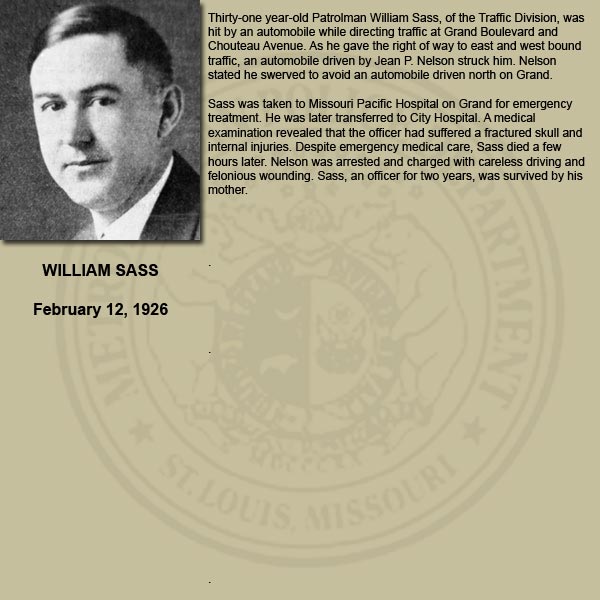 Date of death: February 12, 1926
Full Name: William Sass
Content: Thirty-one year-old Patrolman William Sass, of the Traffic Division, was
hit by an automobile while directing traffic at Grand Boulevard and
Chouteau Avenue. As he gave the right of way to east and west bound
traffic, an automobile driven by Jean P. Nelson struck him. Nelson
stated he swerved to avoid an automobile driven north on Grand.
Sass was taken to Missouri Pacific Hospital on Grand for emergency
treatment. He was later transferred to City Hospital. A medical
examination revealed that the officer had suffered a fractured skull and
internal injuries. Despite emergency medical care, Sass died a few
hours later. Nelson was arrested and charged with careless driving and
felonious wounding. Sass, an officer for two years, was survived by his
mother.
Date of death: February 12, 1926
Full Name: William Sass
Content: Thirty-one year-old Patrolman William Sass, of the Traffic Division, was
hit by an automobile while directing traffic at Grand Boulevard and
Chouteau Avenue. As he gave the right of way to east and west bound
traffic, an automobile driven by Jean P. Nelson struck him. Nelson
stated he swerved to avoid an automobile driven north on Grand.
Sass was taken to Missouri Pacific Hospital on Grand for emergency
treatment. He was later transferred to City Hospital. A medical
examination revealed that the officer had suffered a fractured skull and
internal injuries. Despite emergency medical care, Sass died a few
hours later. Nelson was arrested and charged with careless driving and
felonious wounding. Sass, an officer for two years, was survived by his
mother.
 Date of death: February 17, 1926
Full Name: Frank Kohring
Content: Sixty-six year-old Patrolman Kohring died of injuries sustained when
kicked by an unruly prisoner. Kohring arrested twenty-seven year-old
John Maloney for public drunkenness while patrolling his beat near
Cass and Eighteenth. The drunken Maloney became unruly and kicked
the officer several times in the let leg while resisting ares.
Kohring did not think much of the injury. Three days after the struggle, it
was quite Obvious from the extensive swelling that the leg was
extremely infected. Lanced by a doctor, Kohring continued working, but
the leg did not improve. Kohring finally called n sick, unable to continue
work. Within a few days he died. The inquest placed the cause of death
by diabetes and aortic stenosis. Convicted of public drunkenness,
Maloney was fined five dollar.
Date of death: February 17, 1926
Full Name: Frank Kohring
Content: Sixty-six year-old Patrolman Kohring died of injuries sustained when
kicked by an unruly prisoner. Kohring arrested twenty-seven year-old
John Maloney for public drunkenness while patrolling his beat near
Cass and Eighteenth. The drunken Maloney became unruly and kicked
the officer several times in the let leg while resisting ares.
Kohring did not think much of the injury. Three days after the struggle, it
was quite Obvious from the extensive swelling that the leg was
extremely infected. Lanced by a doctor, Kohring continued working, but
the leg did not improve. Kohring finally called n sick, unable to continue
work. Within a few days he died. The inquest placed the cause of death
by diabetes and aortic stenosis. Convicted of public drunkenness,
Maloney was fined five dollar.
 Date of death: September 25, 1926
Full Name: Eugene Lovely
Content: Motorcycle Officer Eugene N. Lovely and Patrolman Thomas J. Jones
were in a police car looking for traffic violations and suspects when they
sighted Thomas Lowry, a former convict, in an automobile at Delmar
Boulevard and Sarah Street. Lowry was known by the officers for his
prior involvement in various burglaries and disposal of stolen property.
The officers followed Lowry car to Kingshighway and Lindell
Boulevards, where they forced his car to the curb. Lowry locked fenders
with the police car, and started shooting at the officers.
Two bullets struck Officer Lovely. One struck the officer in the jaw and
the second in the chest. A bullet struck Officer Jones in the ankle.
Before Lowry could make his escape, he was shot by Officer Jones in
the right arm.
Lowry fed the scene in a stolen car, throwing away his jammed pistol
and his top-coat that was weighted down with cartridges. He was [later
found at the home of a friend and stated that he had carried a pistol for
the past two months. Lowry said that he intended to shoot any police
officer who would stop and question him. Officer Lovely was taken to
Barnes Hospital where he died a few minutes after his arrival. Lovely,
24, had been on the force just nine months. He was survived by his
widow,
Date of death: September 25, 1926
Full Name: Eugene Lovely
Content: Motorcycle Officer Eugene N. Lovely and Patrolman Thomas J. Jones
were in a police car looking for traffic violations and suspects when they
sighted Thomas Lowry, a former convict, in an automobile at Delmar
Boulevard and Sarah Street. Lowry was known by the officers for his
prior involvement in various burglaries and disposal of stolen property.
The officers followed Lowry car to Kingshighway and Lindell
Boulevards, where they forced his car to the curb. Lowry locked fenders
with the police car, and started shooting at the officers.
Two bullets struck Officer Lovely. One struck the officer in the jaw and
the second in the chest. A bullet struck Officer Jones in the ankle.
Before Lowry could make his escape, he was shot by Officer Jones in
the right arm.
Lowry fed the scene in a stolen car, throwing away his jammed pistol
and his top-coat that was weighted down with cartridges. He was [later
found at the home of a friend and stated that he had carried a pistol for
the past two months. Lowry said that he intended to shoot any police
officer who would stop and question him. Officer Lovely was taken to
Barnes Hospital where he died a few minutes after his arrival. Lovely,
24, had been on the force just nine months. He was survived by his
widow,
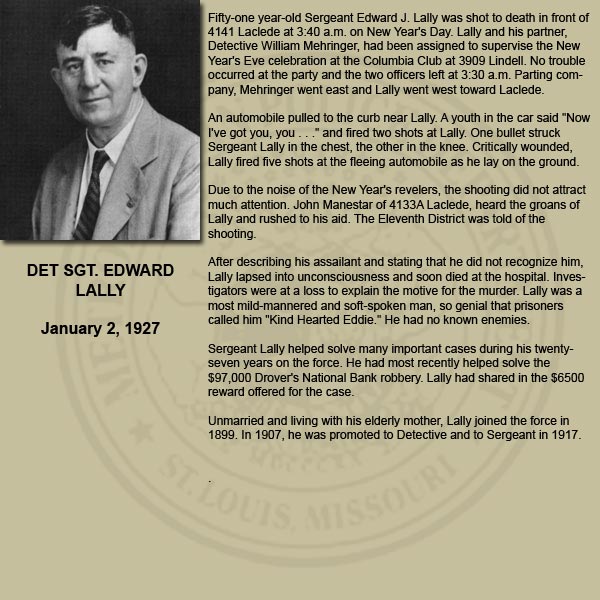 Date of death: January 2, 1927
Full Name: Det. Sgt. Edward Lally
Content: Fifty-one year-old Sergeant Edward J. Lally was shot to death in front of
4141 Laclede at 3:40 a.m. on New Year's Day. Lally and his partner,
Detective William Mehringer, had been assigned to supervise the New
Year's Eve celebration at the Columbia Club at 3909 Lindell. No trouble
occurred at the party and the two officers left at 3:30 a.m. Parting company, Mehringer went east and Lally went west toward Laclede.
An automobile pulled to the curb near Lally. A youth in the car said “Now
I've got you, you. ." and fired two shots at Lally. One bullet struck
Sergeant Lally in the chest, the other in the knee. Critically wounded,
Lally fired five shots at the fleeing automobile as he lay on the ground.
Due to the noise of the New Year's revelers, the shooting did not attract
much attention. John Manestar of 4133A Laclede, heard the groans of
Lally and rushed to his aid. The Eleventh District was told of the shooting.
After describing his assailant and stating that he did not recognize him,
Lally lapsed into unconsciousness and soon died at the hospital. Investigators were at a loss to explain the motive for the murder. Lally was a
most mild-mannered and soft-spoken man, so genial that prisoners
called him "Kind Hearted Eddie.” He had no known enemies.
Sergeant Lally helped solve many important cases during his twenty-
seven years on the force. He had most recently helped solve the
$97,000 Drover's National Bank robbery. Lally had shared in the $6500
reward offered for the case.
Unmarried and living with his elderly mother, Lally joined the force in
1899. In 1907, he was promoted to Detective and to Sergeant in 1917.
Date of death: January 2, 1927
Full Name: Det. Sgt. Edward Lally
Content: Fifty-one year-old Sergeant Edward J. Lally was shot to death in front of
4141 Laclede at 3:40 a.m. on New Year's Day. Lally and his partner,
Detective William Mehringer, had been assigned to supervise the New
Year's Eve celebration at the Columbia Club at 3909 Lindell. No trouble
occurred at the party and the two officers left at 3:30 a.m. Parting company, Mehringer went east and Lally went west toward Laclede.
An automobile pulled to the curb near Lally. A youth in the car said “Now
I've got you, you. ." and fired two shots at Lally. One bullet struck
Sergeant Lally in the chest, the other in the knee. Critically wounded,
Lally fired five shots at the fleeing automobile as he lay on the ground.
Due to the noise of the New Year's revelers, the shooting did not attract
much attention. John Manestar of 4133A Laclede, heard the groans of
Lally and rushed to his aid. The Eleventh District was told of the shooting.
After describing his assailant and stating that he did not recognize him,
Lally lapsed into unconsciousness and soon died at the hospital. Investigators were at a loss to explain the motive for the murder. Lally was a
most mild-mannered and soft-spoken man, so genial that prisoners
called him "Kind Hearted Eddie.” He had no known enemies.
Sergeant Lally helped solve many important cases during his twenty-
seven years on the force. He had most recently helped solve the
$97,000 Drover's National Bank robbery. Lally had shared in the $6500
reward offered for the case.
Unmarried and living with his elderly mother, Lally joined the force in
1899. In 1907, he was promoted to Detective and to Sergeant in 1917.
 Date of death: September 29, 1927
Full Name: Det. Sgt. Edward Schaaf
Content: Forty-one year-old Detective Sergeant Edward Schaaf and thirty-six
year-old Detective Douglas Chamblin died of injuries received when a
building collapsed on them. The one and a half story brick building,
occupied by the United Railways Company at Prairie and Easton
Avenues received extensive damage during a tornado.
Detective Sergeant Edward Schaaf and Detective Douglas Chamblin
were driving east in a department automobile on Easton Avenue when
the weather became stormy. As the intensity of the storm increased, a
tornado developed. The officers, seeing the tornado, left their car and
tried to enter the car-barn owned by the United Railways Company for
shelter,
For some reason, the officers changed their minds and decided to get
under the rear of the police car. Before the they could do so, a portion of
the front wall of the railway building collapsed, hurling the officers into
the street and partially burying both under the rubble.
Citizens pulled them from the rubble and rushed them to the hospital.
Detective Schaaf was dead, having been crushed to death by the
weight of the rubble. He was pronounced dead on arrival at the hospital
(80). Detective Chamblin survived his initial injuries. Sadly, blood
poisoning developed from the fractured pelvis and spine, crushed right
foot, lacerations to the right leg and many cuts on his body. Detective
Chamblin died fifteen days after the storm on October 14, 1927.
Detective Schaaf joined the force on June 12, 1911. He was promoted
to Sergeant in 1926. He was survived by his wife and two children.
Detective Chamblin joined the force in 1920. He was survived by his
wife and four children.
Date of death: September 29, 1927
Full Name: Det. Sgt. Edward Schaaf
Content: Forty-one year-old Detective Sergeant Edward Schaaf and thirty-six
year-old Detective Douglas Chamblin died of injuries received when a
building collapsed on them. The one and a half story brick building,
occupied by the United Railways Company at Prairie and Easton
Avenues received extensive damage during a tornado.
Detective Sergeant Edward Schaaf and Detective Douglas Chamblin
were driving east in a department automobile on Easton Avenue when
the weather became stormy. As the intensity of the storm increased, a
tornado developed. The officers, seeing the tornado, left their car and
tried to enter the car-barn owned by the United Railways Company for
shelter,
For some reason, the officers changed their minds and decided to get
under the rear of the police car. Before the they could do so, a portion of
the front wall of the railway building collapsed, hurling the officers into
the street and partially burying both under the rubble.
Citizens pulled them from the rubble and rushed them to the hospital.
Detective Schaaf was dead, having been crushed to death by the
weight of the rubble. He was pronounced dead on arrival at the hospital
(80). Detective Chamblin survived his initial injuries. Sadly, blood
poisoning developed from the fractured pelvis and spine, crushed right
foot, lacerations to the right leg and many cuts on his body. Detective
Chamblin died fifteen days after the storm on October 14, 1927.
Detective Schaaf joined the force on June 12, 1911. He was promoted
to Sergeant in 1926. He was survived by his wife and two children.
Detective Chamblin joined the force in 1920. He was survived by his
wife and four children.
 Date of death: October 14, 1927
Full Name: Douglas Chamblin
Content: Forty-one year-old Detective Sergeant Edward Schaaf and thirty-six
year-old Detective Douglas Chamblin died of injuries received when a
building collapsed on them. The one and a half story brick building,
occupied by the United Railways Company at Prairie and Easton
Avenues received extensive damage during a tornado.
Detective Sergeant Edward Schaaf and Detective Douglas Chamblin
were driving east in a department automobile on Easton Avenue when
the weather became stormy. As the intensity of the storm increased, a
tornado developed. The officers, seeing the tornado, left their car and
tried to enter the car-barn owned by the United Railways Company for
shelter,
For some reason, the officers changed their minds and decided to get
under the rear of the police car. Before the they could do so, a portion of
the front wall of the railway building collapsed, hurling the officers into
the street and partially burying both under the rubble.
Citizens pulled them from the rubble and rushed them to the hospital.
Detective Schaaf was dead, having been crushed to death by the
weight of the rubble. He was pronounced dead on arrival at the hospital
(80). Detective Chamblin survived his initial injuries. Sadly, blood
poisoning developed from the fractured pelvis and spine, crushed right
foot, lacerations to the right leg and many cuts on his body. Detective
Chamblin died fifteen days after the storm on October 14, 1927.
Detective Schaaf joined the force on June 12, 1911. He was promoted
to Sergeant in 1926. He was survived by his wife and two children.
Detective Chamblin joined the force in 1920. He was survived by his
wife and four children.
Date of death: October 14, 1927
Full Name: Douglas Chamblin
Content: Forty-one year-old Detective Sergeant Edward Schaaf and thirty-six
year-old Detective Douglas Chamblin died of injuries received when a
building collapsed on them. The one and a half story brick building,
occupied by the United Railways Company at Prairie and Easton
Avenues received extensive damage during a tornado.
Detective Sergeant Edward Schaaf and Detective Douglas Chamblin
were driving east in a department automobile on Easton Avenue when
the weather became stormy. As the intensity of the storm increased, a
tornado developed. The officers, seeing the tornado, left their car and
tried to enter the car-barn owned by the United Railways Company for
shelter,
For some reason, the officers changed their minds and decided to get
under the rear of the police car. Before the they could do so, a portion of
the front wall of the railway building collapsed, hurling the officers into
the street and partially burying both under the rubble.
Citizens pulled them from the rubble and rushed them to the hospital.
Detective Schaaf was dead, having been crushed to death by the
weight of the rubble. He was pronounced dead on arrival at the hospital
(80). Detective Chamblin survived his initial injuries. Sadly, blood
poisoning developed from the fractured pelvis and spine, crushed right
foot, lacerations to the right leg and many cuts on his body. Detective
Chamblin died fifteen days after the storm on October 14, 1927.
Detective Schaaf joined the force on June 12, 1911. He was promoted
to Sergeant in 1926. He was survived by his wife and two children.
Detective Chamblin joined the force in 1920. He was survived by his
wife and four children.
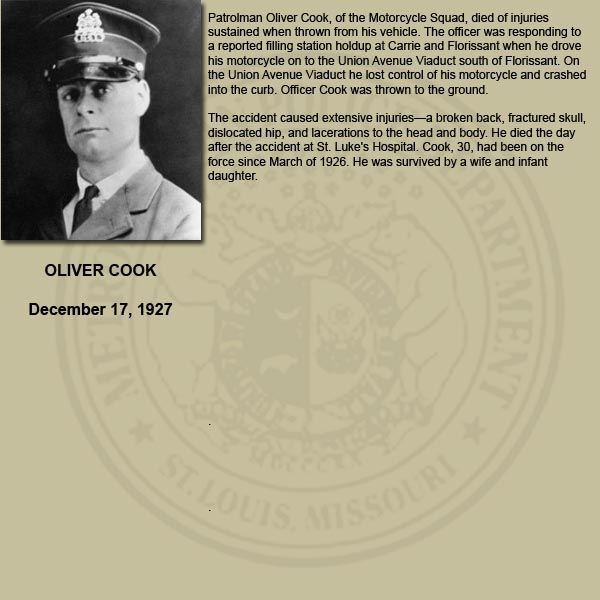 Date of death: December 17, 1927
Full Name: Oliver Cook
Content: Patrolman Oliver Cook, of the Motorcycle Squad, died of injuries
sustained when thrown from his vehicle. The officer was responding to
a reported filling station holdup at Carrie and Florissant when he drove
his motorcycle on to the Union Avenue Viaduct south of Florissant. On
the Union Avenue Viaduct he lost control of his motorcycle and crashed |
into the curb. Offer Cook was thrown to the ground.
The accident caused extensive injuries - a broken back, fractured skull,
dislocated hip, and lacerations to the head and body. He died the day
after the accident at St. Luke's Hospital. Cook, 30, had been on the
fore since March of 1925. He was survived by a wife and infant
daughter. |
Date of death: December 17, 1927
Full Name: Oliver Cook
Content: Patrolman Oliver Cook, of the Motorcycle Squad, died of injuries
sustained when thrown from his vehicle. The officer was responding to
a reported filling station holdup at Carrie and Florissant when he drove
his motorcycle on to the Union Avenue Viaduct south of Florissant. On
the Union Avenue Viaduct he lost control of his motorcycle and crashed |
into the curb. Offer Cook was thrown to the ground.
The accident caused extensive injuries - a broken back, fractured skull,
dislocated hip, and lacerations to the head and body. He died the day
after the accident at St. Luke's Hospital. Cook, 30, had been on the
fore since March of 1925. He was survived by a wife and infant
daughter. |
 Date of death: February 14, 1928
Full Name: Paul Meyer
Content: Twenty-seven year-old Patrolman Meyer of the Traffic Division was
fatally injured in an automobile accident at Kingshighway and Columbia.
Officers Meyer and Thomas Chopliske were responding to a reported
holdup at an oil filling station at South Kingshighway Boulevard and
Potomac Street. Officer Meyer was driving south on Kingshighway.
At the intersection of Columbia Avenue, an automobile making alert
tum hit the police car. The force of the impact hurled the police car onto
the South Hampton fine streetcar tracks. The left front side of the police
car collided with the left front part o the Streetcar going north. The ~~
impact of the two cars threw both officers into the street. The police car
then collided with another auto and was completely demolished.
Officer Meyer was found at the left rear end of the streetcar, with his
head against the housing of its wheels. He had sustained a compound.
depressed fracture of the skull, with hemorrhage. He died about eight
hours after. Officer Chopliske received abrasions and confusions. He
recovered from his injures. Meyer, who was single, had been on the
force since October of 1926.
Date of death: February 14, 1928
Full Name: Paul Meyer
Content: Twenty-seven year-old Patrolman Meyer of the Traffic Division was
fatally injured in an automobile accident at Kingshighway and Columbia.
Officers Meyer and Thomas Chopliske were responding to a reported
holdup at an oil filling station at South Kingshighway Boulevard and
Potomac Street. Officer Meyer was driving south on Kingshighway.
At the intersection of Columbia Avenue, an automobile making alert
tum hit the police car. The force of the impact hurled the police car onto
the South Hampton fine streetcar tracks. The left front side of the police
car collided with the left front part o the Streetcar going north. The ~~
impact of the two cars threw both officers into the street. The police car
then collided with another auto and was completely demolished.
Officer Meyer was found at the left rear end of the streetcar, with his
head against the housing of its wheels. He had sustained a compound.
depressed fracture of the skull, with hemorrhage. He died about eight
hours after. Officer Chopliske received abrasions and confusions. He
recovered from his injures. Meyer, who was single, had been on the
force since October of 1926.
 Date of death: November 11, 1928
Full Name: Joseph McGovern
Content: On November 11, 1928, Herman A. Williams tried to drive between two
stopped vehicles at the intersection at Arsenal and lowa. In doing so, he
struck a car turning right into Arsenal. The impact of the collision
knocked the rear wheel from Willams’ vehicle. Willams’ car then struck
a concrete electrical pole and finally hit fifty-two year-old Patrolman
Joseph P. McGovem, crushing him against the brick wall of the
Sartorius Provision Company. Williams, who had been drinking, was
arrested and charged with manslaughter.
McGovern had joined the force on June 18, 1907. He was survived by
his wife and nine children.
Date of death: November 11, 1928
Full Name: Joseph McGovern
Content: On November 11, 1928, Herman A. Williams tried to drive between two
stopped vehicles at the intersection at Arsenal and lowa. In doing so, he
struck a car turning right into Arsenal. The impact of the collision
knocked the rear wheel from Willams’ vehicle. Willams’ car then struck
a concrete electrical pole and finally hit fifty-two year-old Patrolman
Joseph P. McGovem, crushing him against the brick wall of the
Sartorius Provision Company. Williams, who had been drinking, was
arrested and charged with manslaughter.
McGovern had joined the force on June 18, 1907. He was survived by
his wife and nine children.
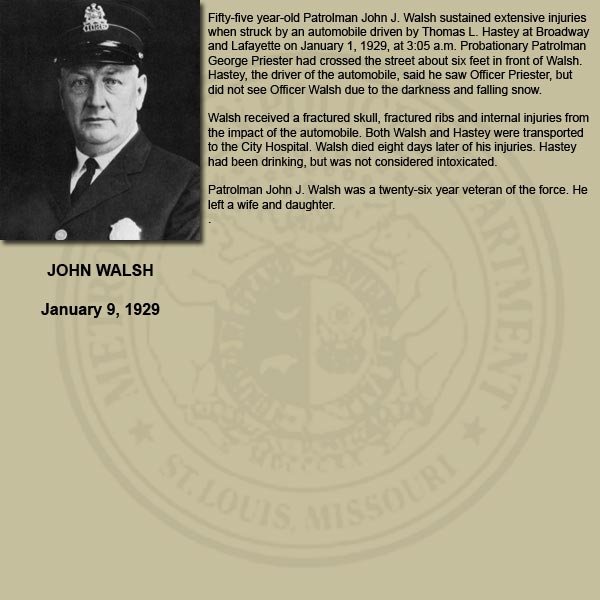 Date of death: January 9, 1929
Full Name: John Walsh
Content: Fifty-five year-old Patrolman John J. Walsh sustained extensive injuries
when struck by an automobile driven by Thomas L. Hastey at Broadway
and Lafayette on January 1, 1929, at 3:05 am. Probationary Patrolman
George Priester had crossed the street about six feet n front of Walsh.
Hastey, the driver of the automobile, said he saw Officer Priester, but
did not see Officer Walsh due to the darkness and falling snow.
Walsh received a fractured skull fractured ribs and internal injures from
the impact of the automobile. Both Walsh and Hastey were transported
to the City Hospital. Walsh died eight days later of his injuries. Hastey
had been drinking, but was not considered intoxicated.
Patrolman John J. Walsh was a twenty-six year veteran of the force. He
left a wife and daughter.
Date of death: January 9, 1929
Full Name: John Walsh
Content: Fifty-five year-old Patrolman John J. Walsh sustained extensive injuries
when struck by an automobile driven by Thomas L. Hastey at Broadway
and Lafayette on January 1, 1929, at 3:05 am. Probationary Patrolman
George Priester had crossed the street about six feet n front of Walsh.
Hastey, the driver of the automobile, said he saw Officer Priester, but
did not see Officer Walsh due to the darkness and falling snow.
Walsh received a fractured skull fractured ribs and internal injures from
the impact of the automobile. Both Walsh and Hastey were transported
to the City Hospital. Walsh died eight days later of his injuries. Hastey
had been drinking, but was not considered intoxicated.
Patrolman John J. Walsh was a twenty-six year veteran of the force. He
left a wife and daughter.
 Date of death: January 31,1929
Full Name: Roy Berry
Content: Twenty-nine year-old Patrolman Berry died as a result of injuries sustained in an automobile accident at Jefferson and Lynch. While pursuing
a speeding automobile, the police car driven by Patrolman Ralph R
Boeing, in which Berry was a passenger, was struck by an automobile
driven by Philip Muehlheausler.
The force of the impact caused the police car to spin completely around.
Officer Berry was thrown out of the vehicle and other the ground. His
injuries, which were extensive, included a fractured skull and other
internal injuries.
Muehiheausler's car overturned. He and his passengers received minor
injuries. Muehiheausier said he heard the police siren and vehicle
coming, but he thought he could safely cross the intersection. Berry,
who was married, had joined the department in 1925.
Date of death: January 31,1929
Full Name: Roy Berry
Content: Twenty-nine year-old Patrolman Berry died as a result of injuries sustained in an automobile accident at Jefferson and Lynch. While pursuing
a speeding automobile, the police car driven by Patrolman Ralph R
Boeing, in which Berry was a passenger, was struck by an automobile
driven by Philip Muehlheausler.
The force of the impact caused the police car to spin completely around.
Officer Berry was thrown out of the vehicle and other the ground. His
injuries, which were extensive, included a fractured skull and other
internal injuries.
Muehiheausler's car overturned. He and his passengers received minor
injuries. Muehiheausier said he heard the police siren and vehicle
coming, but he thought he could safely cross the intersection. Berry,
who was married, had joined the department in 1925.
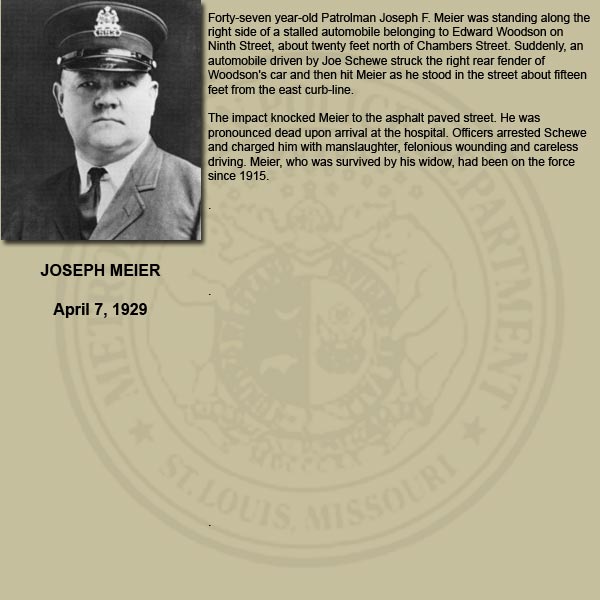 Date of death: April 7, 1929
Full Name: Joseph Meier
Content: Forty-seven year-old Patrolman Joseph F. Meier was standing along the
right side of a stalled automobile belonging to Edward Woodson on
Ninth Street, about twenty feet north of Chambers Street. Suddenly, an
automobile driven by Joe Schewe struck the right rear fender of
Woodson's car and then hit Meier as he stood in the street about fifteen
feet from the east curb-line.
The impact knocked Meier o the asphalt paved street. He was
pronounced dead upon arrival at the hospital. Officers arrested Schewe:
and charged him with manslaughter, felonious wounding and careless
driving. Meier, who was survived by his widow, had been on the force
since 1915.
Date of death: April 7, 1929
Full Name: Joseph Meier
Content: Forty-seven year-old Patrolman Joseph F. Meier was standing along the
right side of a stalled automobile belonging to Edward Woodson on
Ninth Street, about twenty feet north of Chambers Street. Suddenly, an
automobile driven by Joe Schewe struck the right rear fender of
Woodson's car and then hit Meier as he stood in the street about fifteen
feet from the east curb-line.
The impact knocked Meier o the asphalt paved street. He was
pronounced dead upon arrival at the hospital. Officers arrested Schewe:
and charged him with manslaughter, felonious wounding and careless
driving. Meier, who was survived by his widow, had been on the force
since 1915.
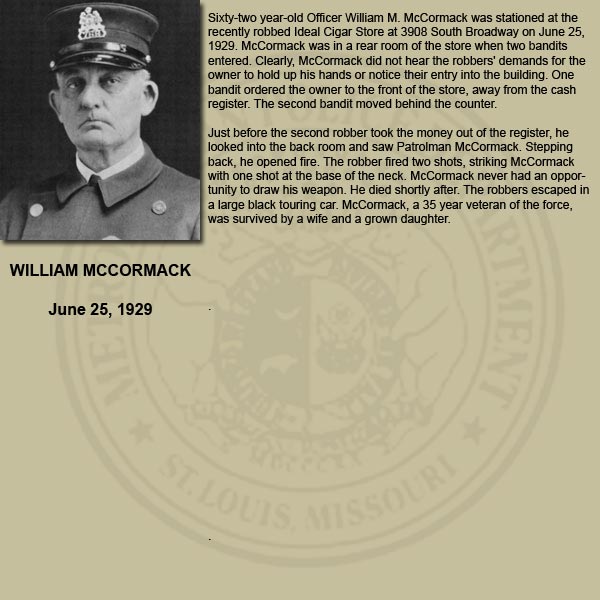 Date of death: June 25, 1929
Full Name: William McCormack
Content: Sixty-two year-old Officer William M. McCormack was stationed at the
recently robbed Ideal Cigar Store at 3908 South Broadway on June 25,
1820. McCormack was in a rear room of the store when two bands.
entered. Clearly, McCormack did not hear the robbers’ demands for the
owner to hold up his hands or notice their entry into the building. One
bandit ordered the owner to the front of the store, away from the cash
register. The second bandit moved behind the counter.
Just before the second robber took the money out of the register, he
looked into the back room and saw Patrolman McCormack. Stepping
back, he opened fire. The robber fired two shots, striking McCormack
with one shot at the base of the neck. McCormack never had an opportunity to draw his weapon. He died shorty after. The robbers escaped in
large black touring car. McCormack, a 35 year veteran of the force, was survived by a wife and a grown daughter.
Date of death: June 25, 1929
Full Name: William McCormack
Content: Sixty-two year-old Officer William M. McCormack was stationed at the
recently robbed Ideal Cigar Store at 3908 South Broadway on June 25,
1820. McCormack was in a rear room of the store when two bands.
entered. Clearly, McCormack did not hear the robbers’ demands for the
owner to hold up his hands or notice their entry into the building. One
bandit ordered the owner to the front of the store, away from the cash
register. The second bandit moved behind the counter.
Just before the second robber took the money out of the register, he
looked into the back room and saw Patrolman McCormack. Stepping
back, he opened fire. The robber fired two shots, striking McCormack
with one shot at the base of the neck. McCormack never had an opportunity to draw his weapon. He died shorty after. The robbers escaped in
large black touring car. McCormack, a 35 year veteran of the force, was survived by a wife and a grown daughter.
 Date of death: June 4, 1930
Full Name: Edward Schnittker
Content: Motorcycle Patrolman Edward Schnittker died of injuries received when
he was struck by a passenger train at the Lindell-Clnion crossing in
Forest Park on June 4, 1930. He and Motorcycle Officer August LaTour
had stopped at the train crossing at Lindell and Union. The gates were
down, indicating that the Wabash passenger train would soon be passing. After a wait of about five minutes, LaTour said he looked up and
down the tracks, but saw no train approaching. When the gates went
up, the two motorcycle officers started across the tracks.
According to LaTour, as he reached the other side of the tracks, something struck the rear of his motorcycle. The force of the impact caused
his motorcycle to spin. LaTour jumped of his motorcycle as Schnittker's body rolled past.
A train struck Officer Schnittker and hurled his body across the tracks.
Schnittker was pronounced dead at Jewish Hospital. Police arrested the
towerman, Melvin Bus, and the train crew, Roy Fletcher and Andrew
Brayfield. The three were soon released pending an inquest. Witnesses
reported that the train gates were up at the time of the accident. Butts
said the gates operated by air pressure and were down. Schnittker, 36
years old, had been on the force seven years. He was married but had
no children.
Date of death: June 4, 1930
Full Name: Edward Schnittker
Content: Motorcycle Patrolman Edward Schnittker died of injuries received when
he was struck by a passenger train at the Lindell-Clnion crossing in
Forest Park on June 4, 1930. He and Motorcycle Officer August LaTour
had stopped at the train crossing at Lindell and Union. The gates were
down, indicating that the Wabash passenger train would soon be passing. After a wait of about five minutes, LaTour said he looked up and
down the tracks, but saw no train approaching. When the gates went
up, the two motorcycle officers started across the tracks.
According to LaTour, as he reached the other side of the tracks, something struck the rear of his motorcycle. The force of the impact caused
his motorcycle to spin. LaTour jumped of his motorcycle as Schnittker's body rolled past.
A train struck Officer Schnittker and hurled his body across the tracks.
Schnittker was pronounced dead at Jewish Hospital. Police arrested the
towerman, Melvin Bus, and the train crew, Roy Fletcher and Andrew
Brayfield. The three were soon released pending an inquest. Witnesses
reported that the train gates were up at the time of the accident. Butts
said the gates operated by air pressure and were down. Schnittker, 36
years old, had been on the force seven years. He was married but had
no children.
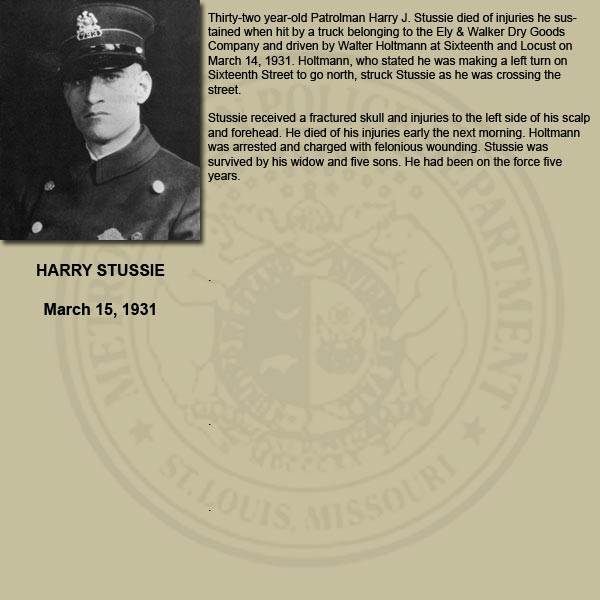 Date of death: March 15, 1931
Full Name: Harry Stussie
Content: Thirty-two year-old Patrolman Harry J. Stussie died of injuries he sustained when hit by a truck belonging to the Ely & Walker Dry Goods.
Company and driven by Walter Holtmann at Sixteenth and Locust on
March 14, 1931. Holtmann, who stated he was making a left turn on
Sixteenth Street to go north, struck Stussie as he was crossing the
street.
Stussie received a fractured skull and injuries to the left side of his scalp
and forehead. He died of his injuries early the next morning. Holtmann
was arrested and charged with felonious wounding. Stussie was
survived by his widow and five sons. He had been on the force five
years.
Date of death: March 15, 1931
Full Name: Harry Stussie
Content: Thirty-two year-old Patrolman Harry J. Stussie died of injuries he sustained when hit by a truck belonging to the Ely & Walker Dry Goods.
Company and driven by Walter Holtmann at Sixteenth and Locust on
March 14, 1931. Holtmann, who stated he was making a left turn on
Sixteenth Street to go north, struck Stussie as he was crossing the
street.
Stussie received a fractured skull and injuries to the left side of his scalp
and forehead. He died of his injuries early the next morning. Holtmann
was arrested and charged with felonious wounding. Stussie was
survived by his widow and five sons. He had been on the force five
years.
 Date of death: September 28, 1931
Full Name: Sgt. Adolph Kreidler
Content: Adolph Kreider, the fifty-six year-old desk sergeant of the Magnolia
Avenue Police Station, was dressed in civilian clothes and wearing his
police badge as he boarded a People’s Motorbus Company bus. Just
relieved from duty as desk sergeant, he boarded the bus in front of the
Magnolia Avenue Police Station on his way home. He took the fourth
seat from the rear on the right side of the upper deck.
At Grand and Meramec a man, later identified as Hubert Harvey,
boarded the bus and sat three seats behind Kreidier. As the bus
reached Osceola, the conductor went to the upper deck to collect
Harvey's fare.
When the conductor asked Harvey for the bus fare, Harvey reached into
his jacket, as though reaching for his fare. Instead of pulling his fare
from his pocket, Harvey pulled a revolver, jabbed it info the conductor's
ribs and fold him to keep quiet. Kreidler heard Harvey's threat and knew
that he would have to act.
Officer Kreidler started to draw his pistol, but due to the danger a gun-
fight would pose to others, the officer decided to overpower the armed
man. Kreider grabbed the man and struggled for the pistol. In the fight,
the qun discharged, striking Kreidler in the leg. As Kreidler fell back, the
robber placed his pistol to the back of Kreidler's head and fired.
Kreidler fell dead to the floor. Harvey jumped from the bus at Osceola
Street and ran south down the alley. His hat and revolver were later
found in an ash-pit the rear of 3554 Osceola Street. Hubert Harvey
was arrested and confessed to the murder of Officer Kreidier. He was
convicted of the murder and was sentenced to if imprisonment.
Kriedler, a 31 year veteran of the force, was survived by a wife and
daughter.
Date of death: September 28, 1931
Full Name: Sgt. Adolph Kreidler
Content: Adolph Kreider, the fifty-six year-old desk sergeant of the Magnolia
Avenue Police Station, was dressed in civilian clothes and wearing his
police badge as he boarded a People’s Motorbus Company bus. Just
relieved from duty as desk sergeant, he boarded the bus in front of the
Magnolia Avenue Police Station on his way home. He took the fourth
seat from the rear on the right side of the upper deck.
At Grand and Meramec a man, later identified as Hubert Harvey,
boarded the bus and sat three seats behind Kreidier. As the bus
reached Osceola, the conductor went to the upper deck to collect
Harvey's fare.
When the conductor asked Harvey for the bus fare, Harvey reached into
his jacket, as though reaching for his fare. Instead of pulling his fare
from his pocket, Harvey pulled a revolver, jabbed it info the conductor's
ribs and fold him to keep quiet. Kreidler heard Harvey's threat and knew
that he would have to act.
Officer Kreidler started to draw his pistol, but due to the danger a gun-
fight would pose to others, the officer decided to overpower the armed
man. Kreider grabbed the man and struggled for the pistol. In the fight,
the qun discharged, striking Kreidler in the leg. As Kreidler fell back, the
robber placed his pistol to the back of Kreidler's head and fired.
Kreidler fell dead to the floor. Harvey jumped from the bus at Osceola
Street and ran south down the alley. His hat and revolver were later
found in an ash-pit the rear of 3554 Osceola Street. Hubert Harvey
was arrested and confessed to the murder of Officer Kreidier. He was
convicted of the murder and was sentenced to if imprisonment.
Kriedler, a 31 year veteran of the force, was survived by a wife and
daughter.
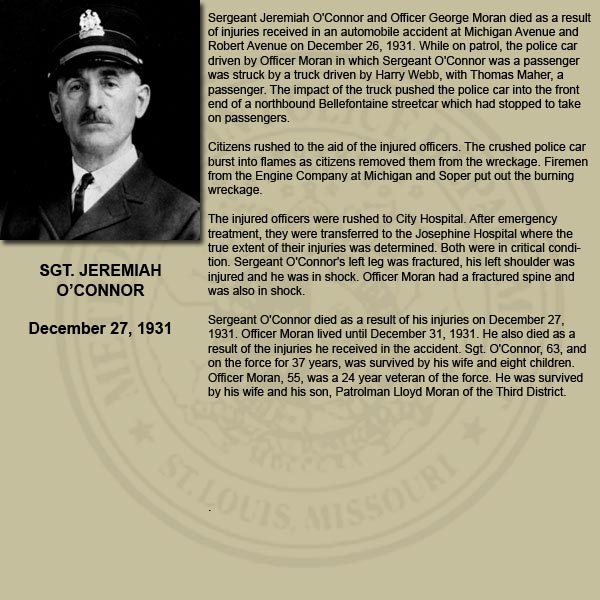 Date of death: December 27, 1931
Full Name: Sgt. Jeremiah O’Connor
Content: Sergeant Jeremiah O'Connor and Officer George Moran died as a result
of injuries received in an automobile accident at Michigan Avenue and
Robert Avenue on December 26, 1931. While on patrol, the police car
driven by Officer Moran in which Sergeant O'Connor was a passenger
was struck by a truck driven by Harry Webb, with Thomas Maher, a
passenger. The impact of the truck pushed the police car into the front
end of a northbound Bellefontaine streetcar which had stopped to take
on passengers.
Citizens rushed to the aid of the injured officers. The crushed police car
burst into flames as citizens removed them from the wreckage. Firemen
from the Engine Company at Michigan and Soper put out the burning
wreckage.
The injured officers were rushed to City Hospital. After emergency
treatment, they were transferred to the Josephine Hospital where the
true extent of their injuries was determined. Both were in critical condition. Sergeant O'Connor's left leq was fractured, his left shoulder was
injured and he was in shock. Officer Moran had a fractured spine and
was also in shock.
Sergeant O'Connor died as a result of his injuries on December 27,
1931. Officer Moran lived until December 31, 1931. He also died as a
result of the injuries he received in the accident. Sgt. O'Connor, 63, and
on the force for 37 years, was survived by his wife and eight children.
Officer Moran, 55, was a 24 year veteran of the force. He was survived
by his wife and his son, Patrolman Lloyd Moran of the Third District.
Date of death: December 27, 1931
Full Name: Sgt. Jeremiah O’Connor
Content: Sergeant Jeremiah O'Connor and Officer George Moran died as a result
of injuries received in an automobile accident at Michigan Avenue and
Robert Avenue on December 26, 1931. While on patrol, the police car
driven by Officer Moran in which Sergeant O'Connor was a passenger
was struck by a truck driven by Harry Webb, with Thomas Maher, a
passenger. The impact of the truck pushed the police car into the front
end of a northbound Bellefontaine streetcar which had stopped to take
on passengers.
Citizens rushed to the aid of the injured officers. The crushed police car
burst into flames as citizens removed them from the wreckage. Firemen
from the Engine Company at Michigan and Soper put out the burning
wreckage.
The injured officers were rushed to City Hospital. After emergency
treatment, they were transferred to the Josephine Hospital where the
true extent of their injuries was determined. Both were in critical condition. Sergeant O'Connor's left leq was fractured, his left shoulder was
injured and he was in shock. Officer Moran had a fractured spine and
was also in shock.
Sergeant O'Connor died as a result of his injuries on December 27,
1931. Officer Moran lived until December 31, 1931. He also died as a
result of the injuries he received in the accident. Sgt. O'Connor, 63, and
on the force for 37 years, was survived by his wife and eight children.
Officer Moran, 55, was a 24 year veteran of the force. He was survived
by his wife and his son, Patrolman Lloyd Moran of the Third District.
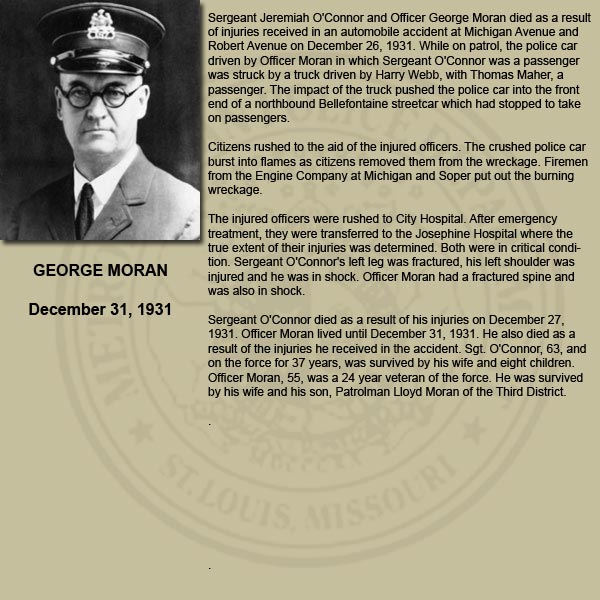 Date of death: December 31, 1931
Full Name: George Moran
Content: Sergeant Jeremiah O'Connor and Officer George Moran died as a result
of injuries received in an automobile accident at Michigan Avenue and
Robert Avenue on December 26, 1931. While on patrol, the police car
driven by Officer Moran in which Sergeant O'Connor was a passenger
was struck by a truck driven by Harry Webb, with Thomas Maher, a
passenger. The impact of the truck pushed the police car into the front
end of a northbound Bellefontaine streetcar which had stopped to take
on passengers.
Citizens rushed to the aid of the injured officers. The crushed police car
burst into flames as citizens removed them from the wreckage. Firemen
from the Engine Company at Michigan and Soper put out the burning
wreckage.
The injured officers were rushed to City Hospital. After emergency
treatment, they were transferred to the Josephine Hospital where the
true extent of their injuries was determined. Both were in critical condition. Sergeant O'Connor's left leq was fractured, his left shoulder was
injured and he was in shock. Officer Moran had a fractured spine and
was also in shock.
Sergeant O'Connor died as a result of his injuries on December 27,
1931. Officer Moran lived until December 31, 1931. He also died as a
result of the injuries he received in the accident. Sgt. O'Connor, 63, and
on the force for 37 years, was survived by his wife and eight children.
Officer Moran, 55, was a 24 year veteran of the force. He was survived
by his wife and his son, Patrolman Lloyd Moran of the Third District.
Date of death: December 31, 1931
Full Name: George Moran
Content: Sergeant Jeremiah O'Connor and Officer George Moran died as a result
of injuries received in an automobile accident at Michigan Avenue and
Robert Avenue on December 26, 1931. While on patrol, the police car
driven by Officer Moran in which Sergeant O'Connor was a passenger
was struck by a truck driven by Harry Webb, with Thomas Maher, a
passenger. The impact of the truck pushed the police car into the front
end of a northbound Bellefontaine streetcar which had stopped to take
on passengers.
Citizens rushed to the aid of the injured officers. The crushed police car
burst into flames as citizens removed them from the wreckage. Firemen
from the Engine Company at Michigan and Soper put out the burning
wreckage.
The injured officers were rushed to City Hospital. After emergency
treatment, they were transferred to the Josephine Hospital where the
true extent of their injuries was determined. Both were in critical condition. Sergeant O'Connor's left leq was fractured, his left shoulder was
injured and he was in shock. Officer Moran had a fractured spine and
was also in shock.
Sergeant O'Connor died as a result of his injuries on December 27,
1931. Officer Moran lived until December 31, 1931. He also died as a
result of the injuries he received in the accident. Sgt. O'Connor, 63, and
on the force for 37 years, was survived by his wife and eight children.
Officer Moran, 55, was a 24 year veteran of the force. He was survived
by his wife and his son, Patrolman Lloyd Moran of the Third District.
 Date of death: April 16, 1932
Full Name: George Schrameyer
Content: On April 16, 1932, Patrolman Guybert Carter was at home at 4042
Aldine, when he heard several shots fired in the alley. Deciding to
investigate, he walked into the alley where he confronted James Tucker.
Tucker began shooting at the officer.
Detective James Scott heard the shots and ran into the alley where hie
saw Carter fall wounded. Scot then exchanged gunfire with Tucker,
who took refuge in a shed.
Patrolman Charles E. Mohr and Probationary Patrolman Raymond
Mayfield arrived on the scene, entering the alley from Sarah Street
Sergeant Walter Archibald and Officer George Schrameyer pulled up to
the shed in their patrol car. Suddenly, both Sergeant Archibald and
Officer Schrameyer were shot by Tucker as they got out of the automobie. Schrameyer fell dead to the street; a bullet had entered his fore-
head.
Tucker continued firing at Mohr and Mayfield as he tried to make good
his escape. As Tucker emerged from a gangway, Scott fired at him.
Wounded, Tucker initially fell to his knees, but rose almost immediately
and ran across Aldine info another alley and then into a yard on Cote:
Brilliante.
Mohr continued to fire at Tucker, who was again wounded and fell to his
knees. Finally, officers arrested Tucker for murder and took him to City
Hospital. At City Hospital doctors discovered that Tucker had been
wounded six times, twice in the chest, and once each in the back, left
leg and both arms. Sergeant Archibald and Officer Carter both
recovered from their wounds; tragically, Officer Schrameyer died
Tucker had escaped from the City Sanitarium where he had been
confined for hallucinations. He had escaped a total of four times, the
fast time on May 12, 1928. Sanitarium officials had stopped looking for
him under a city ordinance which required the name of an escaped
inmate to be "dropped from the books" after he had been missing
eighteen months. Tucker was again confined in the City Sanitorium,
from which he had escaped.
Officer Schrameyer was fifty years old. He had been with the Department since April 27, 1908. He was married and the father of four
children.
Date of death: April 16, 1932
Full Name: George Schrameyer
Content: On April 16, 1932, Patrolman Guybert Carter was at home at 4042
Aldine, when he heard several shots fired in the alley. Deciding to
investigate, he walked into the alley where he confronted James Tucker.
Tucker began shooting at the officer.
Detective James Scott heard the shots and ran into the alley where hie
saw Carter fall wounded. Scot then exchanged gunfire with Tucker,
who took refuge in a shed.
Patrolman Charles E. Mohr and Probationary Patrolman Raymond
Mayfield arrived on the scene, entering the alley from Sarah Street
Sergeant Walter Archibald and Officer George Schrameyer pulled up to
the shed in their patrol car. Suddenly, both Sergeant Archibald and
Officer Schrameyer were shot by Tucker as they got out of the automobie. Schrameyer fell dead to the street; a bullet had entered his fore-
head.
Tucker continued firing at Mohr and Mayfield as he tried to make good
his escape. As Tucker emerged from a gangway, Scott fired at him.
Wounded, Tucker initially fell to his knees, but rose almost immediately
and ran across Aldine info another alley and then into a yard on Cote:
Brilliante.
Mohr continued to fire at Tucker, who was again wounded and fell to his
knees. Finally, officers arrested Tucker for murder and took him to City
Hospital. At City Hospital doctors discovered that Tucker had been
wounded six times, twice in the chest, and once each in the back, left
leg and both arms. Sergeant Archibald and Officer Carter both
recovered from their wounds; tragically, Officer Schrameyer died
Tucker had escaped from the City Sanitarium where he had been
confined for hallucinations. He had escaped a total of four times, the
fast time on May 12, 1928. Sanitarium officials had stopped looking for
him under a city ordinance which required the name of an escaped
inmate to be "dropped from the books" after he had been missing
eighteen months. Tucker was again confined in the City Sanitorium,
from which he had escaped.
Officer Schrameyer was fifty years old. He had been with the Department since April 27, 1908. He was married and the father of four
children.
 Date of death: November 5, 1933
Full Name: Joseph Theobald Jr.
Content: Officer Theobald was killed when hit by an automobile in front of
Triangle Park, 4100 South Broadway at 4:00 am. on November 5,1933. Theobald remained at the scene of an automobile accident until a
tow truck arrived to remove the damaged car from the accident scene.
When the tow truck arrived, Theobald stepped into the street to direct
traffic around the accident scene until the wreckage could be cleared
from the road-way.
Ralph Finnegan, driver of the tow truck, testified he was slowing down
in response to the officers flashlight signal. Theobald had turned and
was signaling to Dennis Barnet to halt when he was hit. Barnett,
Speeding, went around the tow truck and struck Theobald. Finnegan
said the automobile appeared to be traveling in excess of the 30-mile
per hour speed limit.
The force of the impact carried Theobald about sixty feet. Finnegan's
account was corroborated by another eyewitness. Officer Theobald died
on the way to Alexian Brothers Hospital.
Barnet was arrested and charged with manslaughter. He and the three
others in the car were on the way home from a dance. Barnet, with a
record of nineteen previous arrests for various charges, had been
drinking,
Barnett was released on bond pending presentation of the case to the
grand jury. A coroner's jury returned a verdict of criminal carelessness
against Barnett in the death of the officer.
The thirty-six year-old Theobald had been a police officer since
February 1930. Assigned to the Wyoming Street Station, Theobald lived
at 6027 Leona Avenue with his wife, Lilian, and two young children.
Funeral services were held at St. Stephen's Catholic Church, with burial
in Peter and Paul's Cemetery.
Date of death: November 5, 1933
Full Name: Joseph Theobald Jr.
Content: Officer Theobald was killed when hit by an automobile in front of
Triangle Park, 4100 South Broadway at 4:00 am. on November 5,1933. Theobald remained at the scene of an automobile accident until a
tow truck arrived to remove the damaged car from the accident scene.
When the tow truck arrived, Theobald stepped into the street to direct
traffic around the accident scene until the wreckage could be cleared
from the road-way.
Ralph Finnegan, driver of the tow truck, testified he was slowing down
in response to the officers flashlight signal. Theobald had turned and
was signaling to Dennis Barnet to halt when he was hit. Barnett,
Speeding, went around the tow truck and struck Theobald. Finnegan
said the automobile appeared to be traveling in excess of the 30-mile
per hour speed limit.
The force of the impact carried Theobald about sixty feet. Finnegan's
account was corroborated by another eyewitness. Officer Theobald died
on the way to Alexian Brothers Hospital.
Barnet was arrested and charged with manslaughter. He and the three
others in the car were on the way home from a dance. Barnet, with a
record of nineteen previous arrests for various charges, had been
drinking,
Barnett was released on bond pending presentation of the case to the
grand jury. A coroner's jury returned a verdict of criminal carelessness
against Barnett in the death of the officer.
The thirty-six year-old Theobald had been a police officer since
February 1930. Assigned to the Wyoming Street Station, Theobald lived
at 6027 Leona Avenue with his wife, Lilian, and two young children.
Funeral services were held at St. Stephen's Catholic Church, with burial
in Peter and Paul's Cemetery.
 Date of death: May 1, 1934
Full Name: Albert Siko
Content: Officer Siko died of wounds suffered on April 30,1934, when he was
shot by a robber. Officer Siko had just completed his shift and was
waiting at Fourth Street and Delmar for a streetcar. A person came to
him and told of a streetcar holdup a block north on Franklin.
Officer Siko ran to Franklin Street and saw a person jump from the
streetcar and run. In pursuit, Siko chased the robber to an alley just
north of Franklin, where the robber fumed and fired at him. One bullet
struck the officer just under the left eye.
Severely wounded and unable to further defend himself, Siko was shot
three more times by the robber. Despite wounds to the head, both arms
and back, the fast bullet emerging from the abdomen, Officer Siko
crawled fifty feet o a cal-box. He reported the shooting before he
collapsed.
Officer Siko was rushed to the hospital. A description of the robber led
to the arrest the next day of Louis DeMore, a forty-two year-old taxicab.
chauffeur from Chicago. Arrested at the Rector Hotel at 603 Walnut,
DeMore was charged with the murder of Officer Siko.
Police took DeMore to Siko's hospital room one day before the critcally
wounded officer died in the hope that Siko could identify his assailant.
Police officials confirmed to reporters that Siko identified DeMore as the
person who shot him. Thomas E. Fisher, operator of a Wellston street-
car, also identified DeMore as the holdup man Siko chased after the
attempted robbery.
Officer Siko lived at 4840 Gano Avenue with his wife and two small
boys, the youngest of whom was five weeks old. Because his death was
in the line of duty, his family received his salary of $165 a month fora
year, and $8000 from the Police Pension Fund.
Date of death: May 1, 1934
Full Name: Albert Siko
Content: Officer Siko died of wounds suffered on April 30,1934, when he was
shot by a robber. Officer Siko had just completed his shift and was
waiting at Fourth Street and Delmar for a streetcar. A person came to
him and told of a streetcar holdup a block north on Franklin.
Officer Siko ran to Franklin Street and saw a person jump from the
streetcar and run. In pursuit, Siko chased the robber to an alley just
north of Franklin, where the robber fumed and fired at him. One bullet
struck the officer just under the left eye.
Severely wounded and unable to further defend himself, Siko was shot
three more times by the robber. Despite wounds to the head, both arms
and back, the fast bullet emerging from the abdomen, Officer Siko
crawled fifty feet o a cal-box. He reported the shooting before he
collapsed.
Officer Siko was rushed to the hospital. A description of the robber led
to the arrest the next day of Louis DeMore, a forty-two year-old taxicab.
chauffeur from Chicago. Arrested at the Rector Hotel at 603 Walnut,
DeMore was charged with the murder of Officer Siko.
Police took DeMore to Siko's hospital room one day before the critcally
wounded officer died in the hope that Siko could identify his assailant.
Police officials confirmed to reporters that Siko identified DeMore as the
person who shot him. Thomas E. Fisher, operator of a Wellston street-
car, also identified DeMore as the holdup man Siko chased after the
attempted robbery.
Officer Siko lived at 4840 Gano Avenue with his wife and two small
boys, the youngest of whom was five weeks old. Because his death was
in the line of duty, his family received his salary of $165 a month fora
year, and $8000 from the Police Pension Fund.
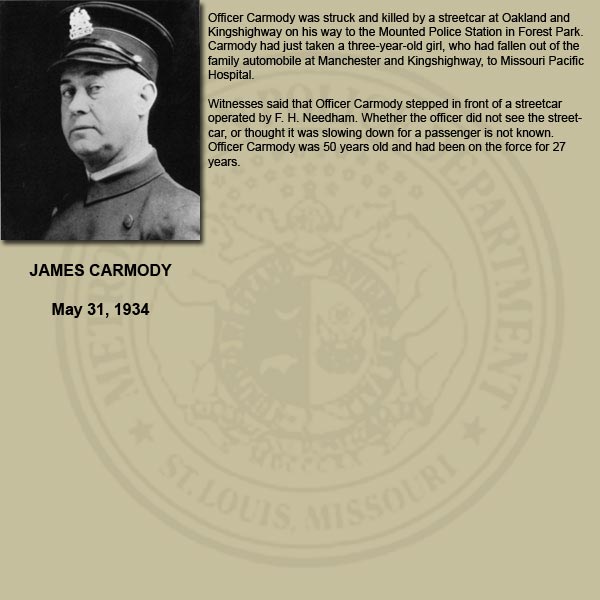 Date of death: May 31,1934
Full Name: James J. Carmody
Content: Officer Carmody was struck and killed by a streetcar at Oakland and
Kingshighway on his way to the Mounted Police Station in Forest Park
Carmody had just taken a three-year-old girl, who had fallen out of the
family automobile at Manchester and Kingshighway, to Missouri Pacific
Hospital
Witnesses said that Officer Carmody stepped in front of a streetcar
operated by F- H. Needham. Whether the officer did not see the street-
car, or thought it was slowing down for a passenger is not known.
Officer Carmody was 50 years old and had been on the force for 27
years.
Date of death: May 31,1934
Full Name: James J. Carmody
Content: Officer Carmody was struck and killed by a streetcar at Oakland and
Kingshighway on his way to the Mounted Police Station in Forest Park
Carmody had just taken a three-year-old girl, who had fallen out of the
family automobile at Manchester and Kingshighway, to Missouri Pacific
Hospital
Witnesses said that Officer Carmody stepped in front of a streetcar
operated by F- H. Needham. Whether the officer did not see the street-
car, or thought it was slowing down for a passenger is not known.
Officer Carmody was 50 years old and had been on the force for 27
years.
 Date of death: July 11,1934
Full Name: William Cotter
Content: On July 9, 1934, at 10.00 p.m. Patrolman William F. Cotter was struck
as he crossed the street by an automobile driven by John Meagher at
3300 Morganford. Meagher claimed to be travelling about 20 miles per
hour at the time of the accident. He further stated that he swerved to
avoid Colter as soon as he saw him. Officer Cotter was struck by the
automobile's right front fender.
Cotter suffered a skull fracture and a compound fracture of the right leg
He was rushed to St. Anthony's Hospital where he died two days later
Meagher, who had been drinking, was charged with manslaughter. The
sixty-five year-old Cotter, a police officer since 1898, was survived by is wife.
Date of death: July 11,1934
Full Name: William Cotter
Content: On July 9, 1934, at 10.00 p.m. Patrolman William F. Cotter was struck
as he crossed the street by an automobile driven by John Meagher at
3300 Morganford. Meagher claimed to be travelling about 20 miles per
hour at the time of the accident. He further stated that he swerved to
avoid Colter as soon as he saw him. Officer Cotter was struck by the
automobile's right front fender.
Cotter suffered a skull fracture and a compound fracture of the right leg
He was rushed to St. Anthony's Hospital where he died two days later
Meagher, who had been drinking, was charged with manslaughter. The
sixty-five year-old Cotter, a police officer since 1898, was survived by is wife.
 Date of death: March 3, 1936
Full Name: Sgt. William Cullen
Content: Sergeant William Cullen and Patrolman Arthur Wahibfink were patrolling
their precinct about 9:00 p.m. on March 2, 1936. The two officers
stopped at the comer of Warne and West Florissant Avenues, where
Officer Wahibrink made the regular hourly call o the station from the
call box.
Wahibrink then went into the drugstore located at the comer to i
purchase some medicine. While inside the store, Wahlbrink heard
shots. Running outside, he found Sergeant Cullen, a thirty year veteran
of the Saint Louis Police Department, wounded in the street.
Cullen told Wahibrink that while siting in the police car, a man walked
up to him and said, "Stick ‘em up - give me your gun Cullen said, I will
not,” and started to get out of his car. The man fired two shots, hitting
Officer Cullen in the stomach. As the officer fell, the man who shot him
fled into an alley and disappeared.
The fifty-nine year-old Cullen was rushed to DePaul Hospital where he
was given three pints of blood during emergency surgery in an attempt
to save his life. Despite the emergency medical efforts, the bullets had
struck vital organs and Sergeant Cullen died the next morning. He was married.
Date of death: March 3, 1936
Full Name: Sgt. William Cullen
Content: Sergeant William Cullen and Patrolman Arthur Wahibfink were patrolling
their precinct about 9:00 p.m. on March 2, 1936. The two officers
stopped at the comer of Warne and West Florissant Avenues, where
Officer Wahibrink made the regular hourly call o the station from the
call box.
Wahibrink then went into the drugstore located at the comer to i
purchase some medicine. While inside the store, Wahlbrink heard
shots. Running outside, he found Sergeant Cullen, a thirty year veteran
of the Saint Louis Police Department, wounded in the street.
Cullen told Wahibrink that while siting in the police car, a man walked
up to him and said, "Stick ‘em up - give me your gun Cullen said, I will
not,” and started to get out of his car. The man fired two shots, hitting
Officer Cullen in the stomach. As the officer fell, the man who shot him
fled into an alley and disappeared.
The fifty-nine year-old Cullen was rushed to DePaul Hospital where he
was given three pints of blood during emergency surgery in an attempt
to save his life. Despite the emergency medical efforts, the bullets had
struck vital organs and Sergeant Cullen died the next morning. He was married.
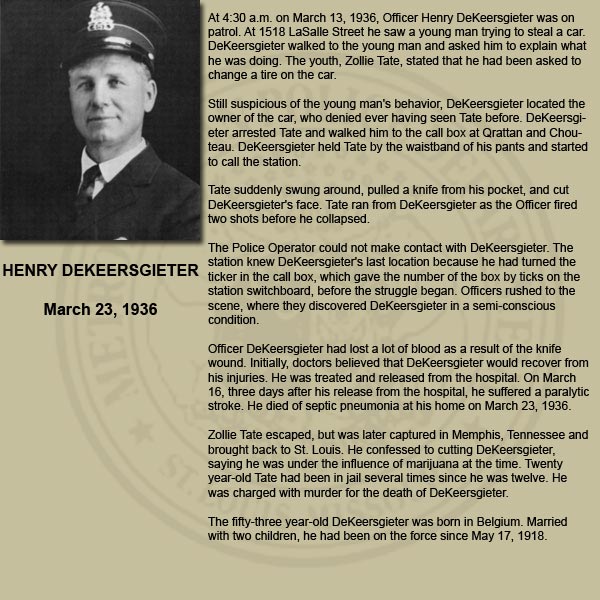 Date of death: March 23, 1936
Full Name: Henry DeKeersgieter
Content: At 4:30 a.m. on March 13, 1936, Officer Henry DeKeersgieter was on
patrol. At 1518 LaSalle Street he saw a young man trying to steal a car.
DeKeersgieter walked to the young man and asked him to explain what
he was doing. The youth, Zollie Tate, stated that he had been asked to
change a tire on the car.
Still suspicious of the young man's behavior, DeKeersgieter located the
owner of the car, who denied ever having seen Tate before. DeKeersgieter arrested Tate and walked him to the call box at Qrattan and Chouteau. DeKeersgieter held Tate by the waistband of his pants and started
to cal the station.
Tate suddenly swung around, pulled a knife from his pocket, and cut
DeKeersgieter's face. Tate ran from DeKeersgieter as the Officer fired
two shots before he collapsed.
The Police Operator could not make contact with DeKearsgieter. The
station knew DeKeersgieter's last location because he had tumed the
ticker in the call box, which gave the number of the box by ticks on the
station switchboard, before the struggle began. Officers rushed to the
scene, where they discovered DeKeersgieter in a semi-conscious
condition.
Officer DeKeersgieter had lost a lot of blood as a result of the knife
wound. Initial, doctors believed that DeKeersgiefer would recover from
his injuries. He was treated and released from the hospital. On March
16, three days after his release from the hospital, he suffered a paralytic:
stroke. He died of septic pneumonia at his home on March 23, 1936.
Zollie Tate escaped, but was later captured in Memphis, Tennessee and
brought back to St. Louis. He confessed to cutting DeKeersgieter,
saying he was under the influence of marijuana at the time. Twenty
year-old Tate had been in jail several times since he was twelve. He
was charged with murder for the death of DeKeersgieter.
The fifty-three year-old DeKeersgieter was born in Belgium. Married
with two children, he had been on the force since May 17, 191.
Date of death: March 23, 1936
Full Name: Henry DeKeersgieter
Content: At 4:30 a.m. on March 13, 1936, Officer Henry DeKeersgieter was on
patrol. At 1518 LaSalle Street he saw a young man trying to steal a car.
DeKeersgieter walked to the young man and asked him to explain what
he was doing. The youth, Zollie Tate, stated that he had been asked to
change a tire on the car.
Still suspicious of the young man's behavior, DeKeersgieter located the
owner of the car, who denied ever having seen Tate before. DeKeersgieter arrested Tate and walked him to the call box at Qrattan and Chouteau. DeKeersgieter held Tate by the waistband of his pants and started
to cal the station.
Tate suddenly swung around, pulled a knife from his pocket, and cut
DeKeersgieter's face. Tate ran from DeKeersgieter as the Officer fired
two shots before he collapsed.
The Police Operator could not make contact with DeKearsgieter. The
station knew DeKeersgieter's last location because he had tumed the
ticker in the call box, which gave the number of the box by ticks on the
station switchboard, before the struggle began. Officers rushed to the
scene, where they discovered DeKeersgieter in a semi-conscious
condition.
Officer DeKeersgieter had lost a lot of blood as a result of the knife
wound. Initial, doctors believed that DeKeersgiefer would recover from
his injuries. He was treated and released from the hospital. On March
16, three days after his release from the hospital, he suffered a paralytic:
stroke. He died of septic pneumonia at his home on March 23, 1936.
Zollie Tate escaped, but was later captured in Memphis, Tennessee and
brought back to St. Louis. He confessed to cutting DeKeersgieter,
saying he was under the influence of marijuana at the time. Twenty
year-old Tate had been in jail several times since he was twelve. He
was charged with murder for the death of DeKeersgieter.
The fifty-three year-old DeKeersgieter was born in Belgium. Married
with two children, he had been on the force since May 17, 191.
 Date of death: June 14, 1936
Full Name: Anthony Retkowski
Content: Leading a parade of school children publicizing a school picnic at St.
Engelbert on June 14, 1936, Motorcycle Officer Anthony Retkowski
sped ahead of the children to ensure control of passing traffic. AS he
moved ahead with his motorcycle, he struck a depression in the street
and his vehicle careened to the curb. The force of the Impact threw him
over the handlebars of the motorcycle and into a concrete light standard
at Harney and Thrush. His head struck the light standard, fracturing his
skull. He died as a result of the injury. Retkowski, on the force since
1934, was survived by his wife.
Date of death: June 14, 1936
Full Name: Anthony Retkowski
Content: Leading a parade of school children publicizing a school picnic at St.
Engelbert on June 14, 1936, Motorcycle Officer Anthony Retkowski
sped ahead of the children to ensure control of passing traffic. AS he
moved ahead with his motorcycle, he struck a depression in the street
and his vehicle careened to the curb. The force of the Impact threw him
over the handlebars of the motorcycle and into a concrete light standard
at Harney and Thrush. His head struck the light standard, fracturing his
skull. He died as a result of the injury. Retkowski, on the force since
1934, was survived by his wife.
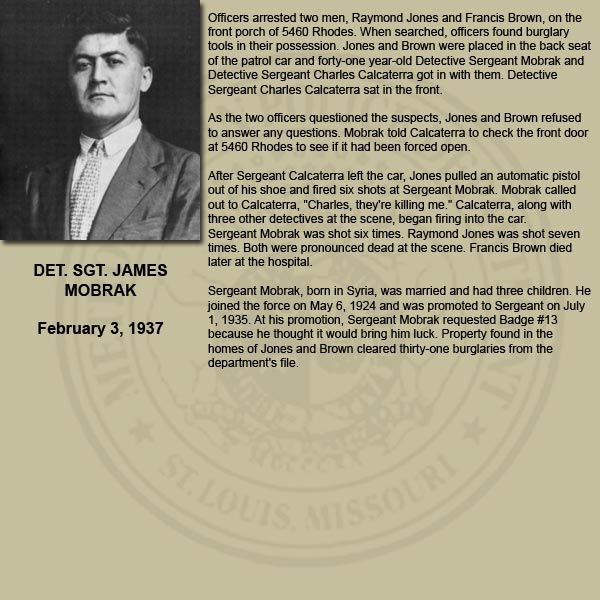 Date of death: February 3, 1937
Full Name: Det. Sgt. James Mobrak
Content: Officers arrested two men, Raymond Jones and Francis Brown, on the
front porch of 5460 Rhodes. When searched, officers found burglary
tools in their possession. Jones and Brown were placed in the back seat
of the patrol car and forty-one year-old Detective Sergeant Mobrak and
Detective Sergeant Charles Calcaterra got in with them. Detective
Sergeant Charles Calcaterra sat in the front.
As the two officers questioned the suspects, Jones and Brown refused
to answer any questions. Mobrak told Calcaterra to check the front door
at 5460 Rhodes to see if it had been forced open.
After Sergeant Calcaterra left the car, Jones pulled an automatic pistol
out of his shoe and fired six shots at Sergeant Mobrak. Mobrak called
out to Calcaterra, "Charles, they're killing me * Calcaterra, along with
three other detectives at the scene, began firing into the car.
Sergeant Mobrak was shot six times. Raymond Jones was shot seven
times. Both were pronounced dead at the scene. Francis Brown died
later at the hospital.
Sergeant Mobrak, born in Syria, was married and had three children. He.
joined the force on May 6, 1924 and was promoted to Sergeant on July
1, 1935. At his promotion, Sergeant Mobrak requested Badge #13
because he thought it would bring him luck. Property found in the
homes of Jones and Brown cleared thirty-one burglaries from the
department’s file.
Date of death: February 3, 1937
Full Name: Det. Sgt. James Mobrak
Content: Officers arrested two men, Raymond Jones and Francis Brown, on the
front porch of 5460 Rhodes. When searched, officers found burglary
tools in their possession. Jones and Brown were placed in the back seat
of the patrol car and forty-one year-old Detective Sergeant Mobrak and
Detective Sergeant Charles Calcaterra got in with them. Detective
Sergeant Charles Calcaterra sat in the front.
As the two officers questioned the suspects, Jones and Brown refused
to answer any questions. Mobrak told Calcaterra to check the front door
at 5460 Rhodes to see if it had been forced open.
After Sergeant Calcaterra left the car, Jones pulled an automatic pistol
out of his shoe and fired six shots at Sergeant Mobrak. Mobrak called
out to Calcaterra, "Charles, they're killing me * Calcaterra, along with
three other detectives at the scene, began firing into the car.
Sergeant Mobrak was shot six times. Raymond Jones was shot seven
times. Both were pronounced dead at the scene. Francis Brown died
later at the hospital.
Sergeant Mobrak, born in Syria, was married and had three children. He.
joined the force on May 6, 1924 and was promoted to Sergeant on July
1, 1935. At his promotion, Sergeant Mobrak requested Badge #13
because he thought it would bring him luck. Property found in the
homes of Jones and Brown cleared thirty-one burglaries from the
department’s file.
 Date of death: February 26, 1937
Full Name: Det. Sgt. Thomas Sullivan
Content: On February 25, 1937, Detective Sergeant Thomas Sullivan and Officer
Ray Roessler were patrolling the area near Pine and Olive. Special
attention was directed toward this area because of a four-day series of
holdups and automobile thefts, including seven in one night,
The officers were cruising the area, inquiring in several small hotels for
two young men who fit the descriptions given by the victims. One of the
stolen automobiles was abandoned near the Leonard Hotel on Olive,
between Compton and Channing.
Even though their shift was over, the officers continued their investigation into the robberies. They stopped at the Leonard Hotel, where the
clerk said that the two men in Room 209 fit the descriptions. The clerk
walked them down the hall and knocked on the door, telling the men
inside that two gentlemen wished to speak to them.
The officers waited in the hall with their revolvers in one hand and their
badges in the other. Inside the room were two escaped convicts from
Michigan, Raymond Rusch, age twenty, and Alvin Mot, age nineteen.
The door was cracked open and then slammed shut. The two men fired
through the door at the officers, who returned the fire and then forced
the door open. Sullivan and Roessler started through the door,
announcing, "We're police officers.” Rusch and Mott opened fire again
Officer Roessler killed Rusch and Molt shot Sergeant Sulivan.
Officer Roessler ducked out of the room because his revolver was
empty. He drew an automatic pistol, which he carried as a second gun
Mott came into the hall and fired a shot at him. The bullet grazed his
coat.
Officer Roessler fired at Mott who jumped back info the room and
slammed the door. Roessler then fired four shots through the door and
forced it open in time to See Mott jumping out the window.
Mott landed on a roof eight feet below and entered the building through
a window. Officer Roessler ran downstairs, but could not find Mott
Other scout cars were arriving at the scene. In Room 209, Rusch was
pronounced dead. The paralyzed Sergeant Sullivan was rushed to
Firmin Desloge Hospital.
Mott, hiding in a refrigerator repair store, waited until the arriving Scout
cars parked and the officers entered the hotel. He then ran out through
an alley, pointing the revolver he took from Sergeant Sullivan at a
salesman and stole his automobile.
The salesman flagged down another scout car driven by Detective
Louis Shoulders. Together they pursued Mott. At Laclede, the salesman
pointed out his car at a stop sign. Detective Shoulders pulled up
alongside Mott and yelled at him to pull over. Mott ducked down to grab
his gun.
Shoulders reached out the window of his car and fired one shot at Mott
The shot passed through the window of Mo's vehicle and hit him in the
head. The stolen automobile rolled across Market and hit a parked car.
Mott died at the hospital.
Detective Sergeant Sullivan had received five bullet wounds, two in his
left arm, one in his chest, one under the fifth rib and an abdominal
wound. The most serious wound was the abdominal wound. The bullet
lodged in the spine, causing paralysis. On February 26, 1937, Sullivan
lapsed into a coma and died.
Sullivan had joined the force in 1919 after serving in the Amy. His
promotion to Sergeant in 1624 came shortly after he played a key role
in breaking up an auto theft ring operating out of Booneville, Missouri
The discovery and arrest of the people involved in the automobile theft
ring resulted in the recovery of fifty cars.
In 1824, Detective Sullivan arrested a seventeen year-old murderer
after a five week investigation. The forty-five year-old Detective left a
wife and three children. Two of Sergeant Sullivan's children, Francis and
Gregory, went on to become St. Louis police officers. They both retired
from the department in 1980.
Date of death: February 26, 1937
Full Name: Det. Sgt. Thomas Sullivan
Content: On February 25, 1937, Detective Sergeant Thomas Sullivan and Officer
Ray Roessler were patrolling the area near Pine and Olive. Special
attention was directed toward this area because of a four-day series of
holdups and automobile thefts, including seven in one night,
The officers were cruising the area, inquiring in several small hotels for
two young men who fit the descriptions given by the victims. One of the
stolen automobiles was abandoned near the Leonard Hotel on Olive,
between Compton and Channing.
Even though their shift was over, the officers continued their investigation into the robberies. They stopped at the Leonard Hotel, where the
clerk said that the two men in Room 209 fit the descriptions. The clerk
walked them down the hall and knocked on the door, telling the men
inside that two gentlemen wished to speak to them.
The officers waited in the hall with their revolvers in one hand and their
badges in the other. Inside the room were two escaped convicts from
Michigan, Raymond Rusch, age twenty, and Alvin Mot, age nineteen.
The door was cracked open and then slammed shut. The two men fired
through the door at the officers, who returned the fire and then forced
the door open. Sullivan and Roessler started through the door,
announcing, "We're police officers.” Rusch and Mott opened fire again
Officer Roessler killed Rusch and Molt shot Sergeant Sulivan.
Officer Roessler ducked out of the room because his revolver was
empty. He drew an automatic pistol, which he carried as a second gun
Mott came into the hall and fired a shot at him. The bullet grazed his
coat.
Officer Roessler fired at Mott who jumped back info the room and
slammed the door. Roessler then fired four shots through the door and
forced it open in time to See Mott jumping out the window.
Mott landed on a roof eight feet below and entered the building through
a window. Officer Roessler ran downstairs, but could not find Mott
Other scout cars were arriving at the scene. In Room 209, Rusch was
pronounced dead. The paralyzed Sergeant Sullivan was rushed to
Firmin Desloge Hospital.
Mott, hiding in a refrigerator repair store, waited until the arriving Scout
cars parked and the officers entered the hotel. He then ran out through
an alley, pointing the revolver he took from Sergeant Sullivan at a
salesman and stole his automobile.
The salesman flagged down another scout car driven by Detective
Louis Shoulders. Together they pursued Mott. At Laclede, the salesman
pointed out his car at a stop sign. Detective Shoulders pulled up
alongside Mott and yelled at him to pull over. Mott ducked down to grab
his gun.
Shoulders reached out the window of his car and fired one shot at Mott
The shot passed through the window of Mo's vehicle and hit him in the
head. The stolen automobile rolled across Market and hit a parked car.
Mott died at the hospital.
Detective Sergeant Sullivan had received five bullet wounds, two in his
left arm, one in his chest, one under the fifth rib and an abdominal
wound. The most serious wound was the abdominal wound. The bullet
lodged in the spine, causing paralysis. On February 26, 1937, Sullivan
lapsed into a coma and died.
Sullivan had joined the force in 1919 after serving in the Amy. His
promotion to Sergeant in 1624 came shortly after he played a key role
in breaking up an auto theft ring operating out of Booneville, Missouri
The discovery and arrest of the people involved in the automobile theft
ring resulted in the recovery of fifty cars.
In 1824, Detective Sullivan arrested a seventeen year-old murderer
after a five week investigation. The forty-five year-old Detective left a
wife and three children. Two of Sergeant Sullivan's children, Francis and
Gregory, went on to become St. Louis police officers. They both retired
from the department in 1980.
 Date of death: October 22, 1937
Full Name: Walter Bingham
Content: Probationary Patrolman Waiter Bingham died on October 22, 1937, of a
fractured skull and internal injuries. He was injured the day before when
his police motorcycle struck an automobile at Kingshighway and Terry.
Avenue. The driver of the automobile, Clyde Ousley, told police he was
northbound on Kingshighway and making a left turn onto Terry, when
Bingham, driving south on Kingshighway, struck his car.
Witnesses said Bingham was traveling at about twenty-five miles per
hour when the accident occurred. The motorcycle skidded as it
approached Ousley's car. The force of the impact threw Bingham to the
ground, causing injuries which resulted in his death. A coroner's jury
returned a verdict of accidental death.
A member of the police force since April 1936, twenty-nine year-old
Patrolman Bingham was married. He was the father of two children.
Date of death: October 22, 1937
Full Name: Walter Bingham
Content: Probationary Patrolman Waiter Bingham died on October 22, 1937, of a
fractured skull and internal injuries. He was injured the day before when
his police motorcycle struck an automobile at Kingshighway and Terry.
Avenue. The driver of the automobile, Clyde Ousley, told police he was
northbound on Kingshighway and making a left turn onto Terry, when
Bingham, driving south on Kingshighway, struck his car.
Witnesses said Bingham was traveling at about twenty-five miles per
hour when the accident occurred. The motorcycle skidded as it
approached Ousley's car. The force of the impact threw Bingham to the
ground, causing injuries which resulted in his death. A coroner's jury
returned a verdict of accidental death.
A member of the police force since April 1936, twenty-nine year-old
Patrolman Bingham was married. He was the father of two children.
 Date of death: November 4, 1939
Full Name: Harry Canton
Content: Officer Harry Canton died when his motorcycle hit the side of a bus at
Sidney and California. Witnesses told police that as the bus neared the
intersection, an eastbound automobile fumed sharply north onto.
California at high speed.
Officer Canton, with his siren on, followed the car and tried to stop it.
When Canton put on his brakes, the motorcycle skidded, striking the
front of the westbound bus. The officer's skull was crushed and he died
instantly.
Police arrested the bus driver, James Steele and booked him for
manslaughter. The charges were later dropped when it was determined
he was not at fault.
Officer Canton was forty-nine years-old and a resident of 4133W Blow.
He was the oldest motorcycle officer with the traffic division at that time.
An officer since 1924, he left a widow.
Date of death: November 4, 1939
Full Name: Harry Canton
Content: Officer Harry Canton died when his motorcycle hit the side of a bus at
Sidney and California. Witnesses told police that as the bus neared the
intersection, an eastbound automobile fumed sharply north onto.
California at high speed.
Officer Canton, with his siren on, followed the car and tried to stop it.
When Canton put on his brakes, the motorcycle skidded, striking the
front of the westbound bus. The officer's skull was crushed and he died
instantly.
Police arrested the bus driver, James Steele and booked him for
manslaughter. The charges were later dropped when it was determined
he was not at fault.
Officer Canton was forty-nine years-old and a resident of 4133W Blow.
He was the oldest motorcycle officer with the traffic division at that time.
An officer since 1924, he left a widow.
 Date of death: March 25, 1941
Full Name: William Mears
Content: Motorcycle Officer William Mears died from injuries he received during a
motorcycle accident about 11:25 p.m. on March 25, 1941. Driving his
motorcycle south on Hampton, he crashed through two wooden street
barricades at the intersection of Hampton and Loran. The barricades,
constructed around an excavation site dug for a gas pipe, were lighted
with red lanterns.
A motorist, Ralph Beahre, told police he was diving south on Hampton
when he saw the motorcycle approaching the barricades from the
opposite direction at about 30 m.p.h. Beahre slowed to see which way
the motorcycle would go around the barricades, but it continued straight
on crashing through the south barricade, plowing through the dirt piled
beside it and hitting the north barricade, 60 feet away. The motorcycle
flipped in the air and landed on Officer Mears. Mears, who suffered a
broken neck and skull injury, was pronounced dead at the scene.
Thirty-four year-old Mears had been on the Department eleven years
and lived at 4049 McRee. Mears left a widow and two young daughters.
Date of death: March 25, 1941
Full Name: William Mears
Content: Motorcycle Officer William Mears died from injuries he received during a
motorcycle accident about 11:25 p.m. on March 25, 1941. Driving his
motorcycle south on Hampton, he crashed through two wooden street
barricades at the intersection of Hampton and Loran. The barricades,
constructed around an excavation site dug for a gas pipe, were lighted
with red lanterns.
A motorist, Ralph Beahre, told police he was diving south on Hampton
when he saw the motorcycle approaching the barricades from the
opposite direction at about 30 m.p.h. Beahre slowed to see which way
the motorcycle would go around the barricades, but it continued straight
on crashing through the south barricade, plowing through the dirt piled
beside it and hitting the north barricade, 60 feet away. The motorcycle
flipped in the air and landed on Officer Mears. Mears, who suffered a
broken neck and skull injury, was pronounced dead at the scene.
Thirty-four year-old Mears had been on the Department eleven years
and lived at 4049 McRee. Mears left a widow and two young daughters.
 Date of death: April 26, 1946
Full Name: Neal Courtney
Content: The murder of Officer Neal A. Courtney was not at all similar to the 120
Saint Louis Police Officers who died in the fine of duty before him. First,
the weapon used was a two inch pen knife. Second, and more unusual,
he was stabbed to death by a seventy-one year old vagrant
As Officer Courtney was walking his beat in the early morning hours of
April 26, 1946, he noticed a vagrant lighting a ire in the vacant lot at
1522 North Seventh Street Courtney told the vagrant, later identified as
seventy-one year-old George Reuben Case, to extinguish the fire. Case
refused, stating he had been living in an abandoned ruck on the lot and
therefore had the right to build a fire.
Courtney began to put out the fire with his foot. Case then picked up a
burning stick and struck him on the left side of his face, knocking
Courtney to the ground. Case then fled from the scene, with Officer
Courtney pursuing him.
Courtney caught Case at 1507 North Broadway. AS they were scuffing,
Case pulled out a penknife and repeatedly stabbed Courtney in his face
and neck. Case then tried to run from the scene, but a watchman who
saw the fight held him at gunpoint until the police arrived.
Officer Courtney was rushed to City Hospital #1. A victim of many stab
wounds, lacerations and a severed jugular vein, he was pronounced
dead on arrival at the hospital.
Officer Courtney was thirty-six years-old when he died. He lived at 5933
Lucile and left a widow and a six year-old daughter. Part of a police
family, Courtney's father served as a member of the St. Louis Police.
Department for forty-two years, rising to the rank of Sergeant. His
brother, also a St. Louis police officer, was given the grim task of
identifying his brother's body at the morgue.
Date of death: April 26, 1946
Full Name: Neal Courtney
Content: The murder of Officer Neal A. Courtney was not at all similar to the 120
Saint Louis Police Officers who died in the fine of duty before him. First,
the weapon used was a two inch pen knife. Second, and more unusual,
he was stabbed to death by a seventy-one year old vagrant
As Officer Courtney was walking his beat in the early morning hours of
April 26, 1946, he noticed a vagrant lighting a ire in the vacant lot at
1522 North Seventh Street Courtney told the vagrant, later identified as
seventy-one year-old George Reuben Case, to extinguish the fire. Case
refused, stating he had been living in an abandoned ruck on the lot and
therefore had the right to build a fire.
Courtney began to put out the fire with his foot. Case then picked up a
burning stick and struck him on the left side of his face, knocking
Courtney to the ground. Case then fled from the scene, with Officer
Courtney pursuing him.
Courtney caught Case at 1507 North Broadway. AS they were scuffing,
Case pulled out a penknife and repeatedly stabbed Courtney in his face
and neck. Case then tried to run from the scene, but a watchman who
saw the fight held him at gunpoint until the police arrived.
Officer Courtney was rushed to City Hospital #1. A victim of many stab
wounds, lacerations and a severed jugular vein, he was pronounced
dead on arrival at the hospital.
Officer Courtney was thirty-six years-old when he died. He lived at 5933
Lucile and left a widow and a six year-old daughter. Part of a police
family, Courtney's father served as a member of the St. Louis Police.
Department for forty-two years, rising to the rank of Sergeant. His
brother, also a St. Louis police officer, was given the grim task of
identifying his brother's body at the morgue.
 Date of death: June 11, 1948
Full Name: Raymond Hacker
Content: On June 5,1948, Officer Raymond Hacker was rerouting traffic around
fallen electrical power lines at Seventh Street and Caroll during
thunderstorm. As he directed traffic, he was struck by an automobile.
The force of the impact threw Officer Hacker into the path of another
vehicle, which also struck him.
The two automobiles, the first driven by Ernie Ball and the second
driven by Warren Colyer, were travelling in opposite directions when
they struck Officer Hacker. Both Ball and Colyer said they did not see him standing in the street.
Officer Hacker died six days after he was injured. Assigned to the Third
District, Officer Hacker was thirty-nine at the time of his death
Like many officers before him, Officer Hacker died as a result of injuries
received during a traffic accident. Tragically, streetcars, rains, buses,
motorcycles and automobiles have proven to be as deadly for police
officers as knives or firearms.
Date of death: June 11, 1948
Full Name: Raymond Hacker
Content: On June 5,1948, Officer Raymond Hacker was rerouting traffic around
fallen electrical power lines at Seventh Street and Caroll during
thunderstorm. As he directed traffic, he was struck by an automobile.
The force of the impact threw Officer Hacker into the path of another
vehicle, which also struck him.
The two automobiles, the first driven by Ernie Ball and the second
driven by Warren Colyer, were travelling in opposite directions when
they struck Officer Hacker. Both Ball and Colyer said they did not see him standing in the street.
Officer Hacker died six days after he was injured. Assigned to the Third
District, Officer Hacker was thirty-nine at the time of his death
Like many officers before him, Officer Hacker died as a result of injuries
received during a traffic accident. Tragically, streetcars, rains, buses,
motorcycles and automobiles have proven to be as deadly for police
officers as knives or firearms.
 Date of death: July 6, 1948
Full Name: Edward Fabick
Content: Patrolman Edward Fabick was struck by a hit and run driver as he
directed traffic around an earlier accident on July 5, 1948. Fabick,
standing on the white center line dividing the 6700 block of Watson,
used a lighted nightstick to direct automobiles around a truck that had
collided with a parked car. Suddenly, he was hit by a car. The vehicle
which hit Fabick carried him 114 feet as the driver sped away.
Investigators determined that the driver of the car, Roy Kuehne, had
been drag racing with another car at the time of the accident. When
faced with his damaged automobile and witnesses’ statements, Kuehne
admitted he hit Fabick, but gave no reason for leaving the scene. He
was arrested and charged with manslaughter.
Fabick, who died the next morning, was fifty-four years-old. He had
joined the Department in 1923. He was survived by a wife and children.
Date of death: July 6, 1948
Full Name: Edward Fabick
Content: Patrolman Edward Fabick was struck by a hit and run driver as he
directed traffic around an earlier accident on July 5, 1948. Fabick,
standing on the white center line dividing the 6700 block of Watson,
used a lighted nightstick to direct automobiles around a truck that had
collided with a parked car. Suddenly, he was hit by a car. The vehicle
which hit Fabick carried him 114 feet as the driver sped away.
Investigators determined that the driver of the car, Roy Kuehne, had
been drag racing with another car at the time of the accident. When
faced with his damaged automobile and witnesses’ statements, Kuehne
admitted he hit Fabick, but gave no reason for leaving the scene. He
was arrested and charged with manslaughter.
Fabick, who died the next morning, was fifty-four years-old. He had
joined the Department in 1923. He was survived by a wife and children.
William O’Brien
1949
 Date of death: August 28, 1952
Full Name: CORP. CHARLES VORACEK
Content: Corporal Charles E. Voracek and Patrolman Joseph Novak were
patrolling in the Third District on August 17, 1952, when they received a
radio message for an officer in need of aid. Responding to the call, the
officers turned on the patrol car's siren and lights and rushed toward
Jefferson and Chestnut.
As the officers crossed the intersection at Chouteau and Jefferson, their
patrol car was hit by another car. The impact of the wreck knocked the
patrol car firs into an electric light standard before it finally came to rest
against the concrete wall of the viaduct approach.
Voracek suffered fractures of the neck, right leg and three ribs. Novak
suffered injuries to his back, and fractures of the collarbone and four
ribs. Three persons in the other car were also injured, one seriously.
The driver of the offer automobile was booked on charges of felonious
wounding, violating an electric signal, careless driving and destruction
of city property.
Eleven days later, on August 28, 1952, Corporal Charles Voracek died
from his injuries. Fifty-two years old, Voracek had been on the force for
twenty-two years. He was survived by a wife and son.
Date of death: August 28, 1952
Full Name: CORP. CHARLES VORACEK
Content: Corporal Charles E. Voracek and Patrolman Joseph Novak were
patrolling in the Third District on August 17, 1952, when they received a
radio message for an officer in need of aid. Responding to the call, the
officers turned on the patrol car's siren and lights and rushed toward
Jefferson and Chestnut.
As the officers crossed the intersection at Chouteau and Jefferson, their
patrol car was hit by another car. The impact of the wreck knocked the
patrol car firs into an electric light standard before it finally came to rest
against the concrete wall of the viaduct approach.
Voracek suffered fractures of the neck, right leg and three ribs. Novak
suffered injuries to his back, and fractures of the collarbone and four
ribs. Three persons in the other car were also injured, one seriously.
The driver of the offer automobile was booked on charges of felonious
wounding, violating an electric signal, careless driving and destruction
of city property.
Eleven days later, on August 28, 1952, Corporal Charles Voracek died
from his injuries. Fifty-two years old, Voracek had been on the force for
twenty-two years. He was survived by a wife and son.
 Date of death: January 3, 1953 Recognized May 17,2006
Full Name: Edward T. Burke
Content: Police Officer Edward Burke was killed when he fell down a staircase as.
he was escorting a prisoner.
Officer Burke was survived by his wife and five children.
Date of death: January 3, 1953 Recognized May 17,2006
Full Name: Edward T. Burke
Content: Police Officer Edward Burke was killed when he fell down a staircase as.
he was escorting a prisoner.
Officer Burke was survived by his wife and five children.
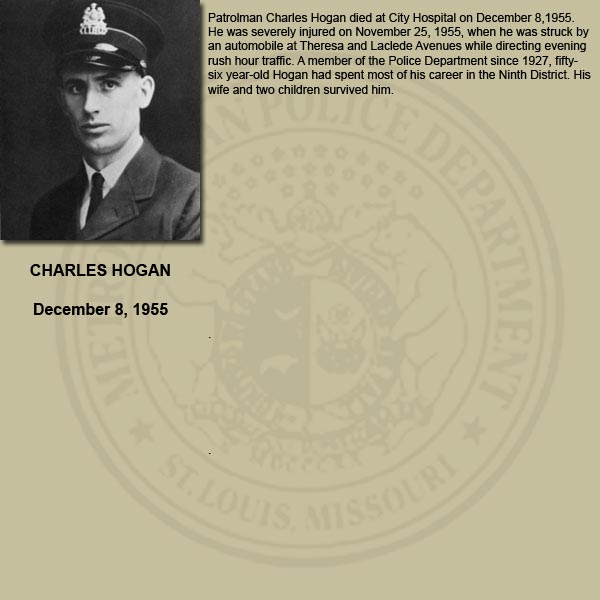 Date of death: December 8, 1955
Full Name: Charles J. Hogan
Content: Patrolman Charles Hogan died at City Hospital on December 8,1955.
He was severely injured on November 25, 1955, when he was struck by
an automobile at Theresa and Laclede Avenues while directing evening
rush hour traffic. A member of the Police Department since 1927, fifty-
six year-old Hogan had spent most of his career in the Ninth District. His.
wife and two children survived him.
Date of death: December 8, 1955
Full Name: Charles J. Hogan
Content: Patrolman Charles Hogan died at City Hospital on December 8,1955.
He was severely injured on November 25, 1955, when he was struck by
an automobile at Theresa and Laclede Avenues while directing evening
rush hour traffic. A member of the Police Department since 1927, fifty-
six year-old Hogan had spent most of his career in the Ninth District. His.
wife and two children survived him.
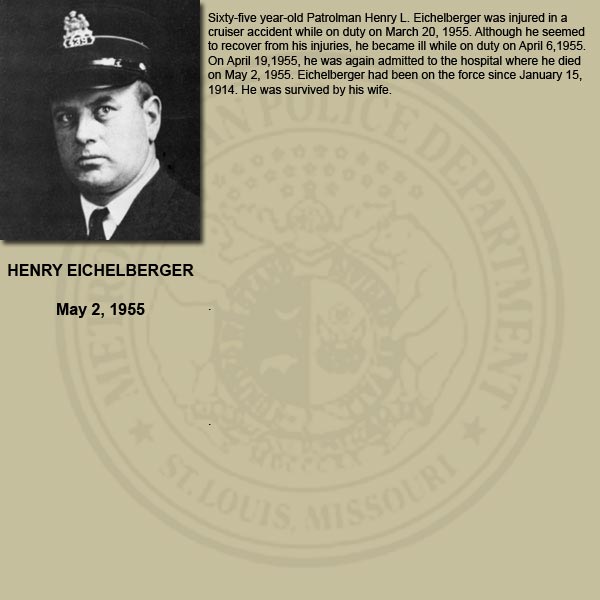 Date of death: May 2, 1955
Full Name: Henry Eichelberger
Content: Sixty-five year-old Patrolman Henry L. Eichelberger was injured in a
cruiser accident while on duty on March 20, 1955. Although he seemed
to recover from his injuries, he became ill while on duty on April 6,1955.
On April 19,1955, he was again admitted to the hospital where he died
on May 2, 1955. Eichelberger had been on the force since January 15,
1914. He was survived by his wife.
Date of death: May 2, 1955
Full Name: Henry Eichelberger
Content: Sixty-five year-old Patrolman Henry L. Eichelberger was injured in a
cruiser accident while on duty on March 20, 1955. Although he seemed
to recover from his injuries, he became ill while on duty on April 6,1955.
On April 19,1955, he was again admitted to the hospital where he died
on May 2, 1955. Eichelberger had been on the force since January 15,
1914. He was survived by his wife.
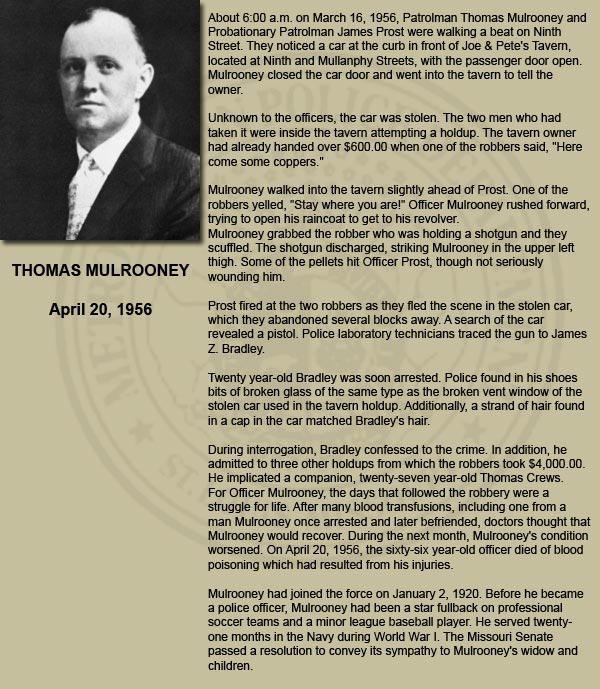 Date of death: April 20, 1956
Full Name: Thomas P. Mulrooney
Content: About 6:00 a.m. on March 16, 1956, Patrolman Thomas Mulroney and
Probationary Patrolman James Prost were walking a beat on Ninth
Street. They noticed a car at the curb in front of Joe & Pete's Tavern,
located at Ninth and Mullanphy Streets, with the passenger door open
Mulroney closed the car door and went info the tavern to tell the owner.
Mulroney walked into the tavern sightly ahead of Prost One of the
robbers yelled, "Stay where you are!” Officer Mulroney rushed forward,
trying to Open his raincoat to get to his revolver.
Mulroney grabbed the robber who was holding a shotgun and they
scuffled. The shogun discharged, striking Mulrooney in the upper left
thigh. Some of the pellets hit Officer Prost, though not seriously
wounding him.
Prost fired at the two robbers as they fled the scene in the stolen car,
which they abandoned several blocks away. A search of the car
revealed a pistol. Police laboratory technicians traced the gun to James
Z. Bradley.
Twenty year-old Bradley was soon arrested. Police found in his shoes
bits of broken glass of the same type as the broken vent window of the
stolen car used in the tavern holdup. Additionally, a strand of hair found
in a cap in the car matched Bradley's hair.
During interrogation, Bradley confessed to the crime. In addition, he
admitted to three other holdups from which the robbers took $4,000.00.
He implicated a companion, twenty-seven year-old Thomas Crews.
For Officer Mulroney, the days that followed the robbery were a
struggle for life. After many blood transfusions, including one from a
man Mulroney once arrested and later befriended, doctors thought that
Mulroney would recover. During the next month, Mulroney's condition
worsened. On April 20, 1956, the sixty-six year-old officer died of blood
poisoning which had resulted from his injuries.
Mulroney had joined the force on January 2, 1920. Before he became
a police officer, Mulroney had been a star fullback on professional
Soccer teams and a minor league baseball player. He served twenty-
one months in the Navy during World War |. The Missouri Senate
passed a resolution to convey ifs sympathy to Mulroney's widow and
children.
Date of death: April 20, 1956
Full Name: Thomas P. Mulrooney
Content: About 6:00 a.m. on March 16, 1956, Patrolman Thomas Mulroney and
Probationary Patrolman James Prost were walking a beat on Ninth
Street. They noticed a car at the curb in front of Joe & Pete's Tavern,
located at Ninth and Mullanphy Streets, with the passenger door open
Mulroney closed the car door and went info the tavern to tell the owner.
Mulroney walked into the tavern sightly ahead of Prost One of the
robbers yelled, "Stay where you are!” Officer Mulroney rushed forward,
trying to Open his raincoat to get to his revolver.
Mulroney grabbed the robber who was holding a shotgun and they
scuffled. The shogun discharged, striking Mulrooney in the upper left
thigh. Some of the pellets hit Officer Prost, though not seriously
wounding him.
Prost fired at the two robbers as they fled the scene in the stolen car,
which they abandoned several blocks away. A search of the car
revealed a pistol. Police laboratory technicians traced the gun to James
Z. Bradley.
Twenty year-old Bradley was soon arrested. Police found in his shoes
bits of broken glass of the same type as the broken vent window of the
stolen car used in the tavern holdup. Additionally, a strand of hair found
in a cap in the car matched Bradley's hair.
During interrogation, Bradley confessed to the crime. In addition, he
admitted to three other holdups from which the robbers took $4,000.00.
He implicated a companion, twenty-seven year-old Thomas Crews.
For Officer Mulroney, the days that followed the robbery were a
struggle for life. After many blood transfusions, including one from a
man Mulroney once arrested and later befriended, doctors thought that
Mulroney would recover. During the next month, Mulroney's condition
worsened. On April 20, 1956, the sixty-six year-old officer died of blood
poisoning which had resulted from his injuries.
Mulroney had joined the force on January 2, 1920. Before he became
a police officer, Mulroney had been a star fullback on professional
Soccer teams and a minor league baseball player. He served twenty-
one months in the Navy during World War |. The Missouri Senate
passed a resolution to convey ifs sympathy to Mulroney's widow and
children.
 Date of death: September 23, 1959
Full Name: CORP. SAMUEL CHEATHAM
Content: Fifty-five year-old Corporal Samuel Cheatham was a twenty-nine year
veteran of the police force who spent the first half of his career as a
motorcycle officer. On May 4, 1959, Corporal Cheatham suffered a
heart attack while scuffing with a man who was resisting arrest. He was
on sick leave at his home on September 23, 1959 when he died of a
second hear attack.
Cheatham was survived by his wife. Promoted to corporal in 1947,
Cheatham served in the Carondelet District.
Date of death: September 23, 1959
Full Name: CORP. SAMUEL CHEATHAM
Content: Fifty-five year-old Corporal Samuel Cheatham was a twenty-nine year
veteran of the police force who spent the first half of his career as a
motorcycle officer. On May 4, 1959, Corporal Cheatham suffered a
heart attack while scuffing with a man who was resisting arrest. He was
on sick leave at his home on September 23, 1959 when he died of a
second hear attack.
Cheatham was survived by his wife. Promoted to corporal in 1947,
Cheatham served in the Carondelet District.
 Date of death: March 4, 1963
Full Name: Donald Sparks
Content: Patrolman Donald C. Sparks was a veteran police officer with ten years
of service with the St. Louis Police Department, On March 4, 1963, the
thirty-three year-old Officer was shot twice in the head by a holdup man
at Grand and Castleman. He died two hours after.
Earl Nickens, a former convict, was fleeing from a grocery store holdup
when Officer Sparks stopped first car. Sparks pulled over Nickens’ car,
which matched the description of the robbery getaway car. As Officer
Sparks approached Nickens’ car, Nickens fired at the officer, fatally
wounding him. Sergeant James McQauley, Patrolman Donald Qathright
and Patrolman James Scott arrested Nickens a few hours after the
shooting.
Sparks began his career with the department as a civilian employee in
1953. He became a patrolman in July of 1954. He was survived by a
wife and nine year old daughter.
Date of death: March 4, 1963
Full Name: Donald Sparks
Content: Patrolman Donald C. Sparks was a veteran police officer with ten years
of service with the St. Louis Police Department, On March 4, 1963, the
thirty-three year-old Officer was shot twice in the head by a holdup man
at Grand and Castleman. He died two hours after.
Earl Nickens, a former convict, was fleeing from a grocery store holdup
when Officer Sparks stopped first car. Sparks pulled over Nickens’ car,
which matched the description of the robbery getaway car. As Officer
Sparks approached Nickens’ car, Nickens fired at the officer, fatally
wounding him. Sergeant James McQauley, Patrolman Donald Qathright
and Patrolman James Scott arrested Nickens a few hours after the
shooting.
Sparks began his career with the department as a civilian employee in
1953. He became a patrolman in July of 1954. He was survived by a
wife and nine year old daughter.
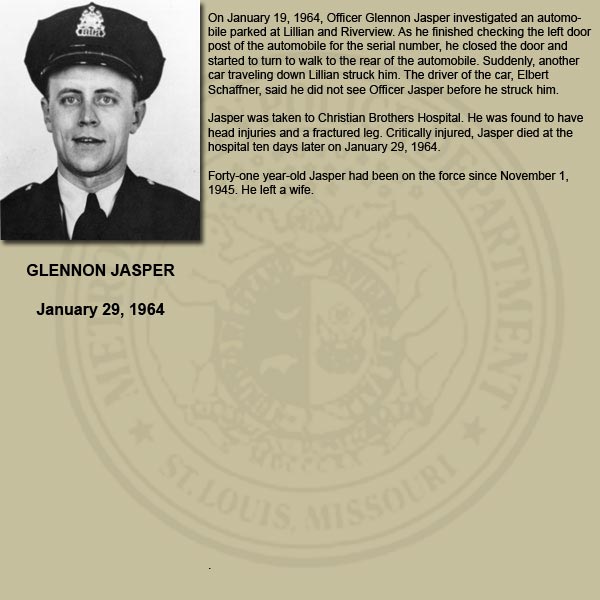 Date of death: January 29, 1964
Full Name: Glennon Jasper
Content: On January 19, 1964, Officer Glennon Jasper investigated an automobile parked at Lilian and Riverview. As he finished checking the left door
post of the automobile for the serial number, he closed the door and
started to tum to walk to the rear of the automobile. Suddenly, another
car traveling down Lillian struck him. The driver of the car, Elbert
Schaffner, said he did not see Officer Jasper before he struck him.
Jasper was taken to Christian Brothers Hospital. He was found to have
head injuries and a fractured leg. Critically injured, Jasper died at the
hospital ten days later on January 29, 1964.
Forty-one year-old Jasper had been on the force since November 1,
1945. He left a wife.
Date of death: January 29, 1964
Full Name: Glennon Jasper
Content: On January 19, 1964, Officer Glennon Jasper investigated an automobile parked at Lilian and Riverview. As he finished checking the left door
post of the automobile for the serial number, he closed the door and
started to tum to walk to the rear of the automobile. Suddenly, another
car traveling down Lillian struck him. The driver of the car, Elbert
Schaffner, said he did not see Officer Jasper before he struck him.
Jasper was taken to Christian Brothers Hospital. He was found to have
head injuries and a fractured leg. Critically injured, Jasper died at the
hospital ten days later on January 29, 1964.
Forty-one year-old Jasper had been on the force since November 1,
1945. He left a wife.
 Date of death: July 2, 1964
Full Name: Paul McCulloch
Content: On July 2, 1964, at 6:30 p.m., Marilyn Morris was seated in her automobile in front of the Food Fair Super Market located at 814 North Leflinquell. She was waiting to drive her mother, who owned the store, home.
As she waited, Eddie C. Glenn got into her car. Displaying a knife,
Glenn said, "Don't make a sound, drive straight”. As Mortis drove, she
tried to attract attention by honking her horn, but no one came to her
aid. For the next hour, Glenn forced her to drive around the northern
portion of the city.
Glenn looked through her purse for money to buy drugs, but she had
only $4.00 plus change. He took a diamond ring from her finger.
Mortis repeatedly tried to alert others to her situation, including a
service station attendant when they stopped for gas. No one realized
her predicament.
Officer Robert Steel, suspicious about the car, pulled ito the curb at
Twentieth Street and Carr. As the officer approached the vehicle on the
drivers side, Mariyn Morris jumped from the car and ran. Officer Steele
pointed his revolver at Glenn and told him to get out of the car.
Glenn lunged at Steele. Officer Steele fired, hitting Glenn in the
shoulder. Glenn grabbed the officer's gun with both hands, preventing
the cylinder from turning. During the struggle, Glenn gained possession
of the gun. Officer Steele ran toward his patrol car to call for help. Glenn
fired two shots at him.
While Officer Steele called for help, Glenn ran onto the grounds of the
Pruitt-Igoe Housing Project. After Officer Steele radioed for help, he
collapsed in the street. The call went out as "police officer in need of
aid, supposedly shot".
Patrolmen Ronald Pott and Ralph Atkins heard the radio call and
responded to the scene. They saw Officer Steele lying in the street
covered with blood. Officer Pott went after Glenn, while Officer Atkins
stayed to help Officer Steele. Steele, though not seriously injured, was
dazed from the scuffle.
Officer Pott and Glenn exchanged shots as they ran through the areaways between the buildings of Pruitt-Igoe. A short time later, Canine
Officer Paul McCulloch, on his way to work, arrived at the scene.
McCulloch and Port decided to circle the building from opposite sides
and head off Glenn. Soon after the officers parted, Officer Pott heard a
gunshot. As he rounded a corner of the building, he came face to face
with Glenn. They each fired simultaneously.
The bullet that hit Officer Pott went through his left forearm, ricocheted
off the badge worn on his left chest, and struck his righ hand. The
impact of the bullet caused him to drop his revolver. Before he dropped
his revolver, Officer Pott shot Glenn in the right chest. Though staggered, Glenn continued across the courtyard between two of the buildings. Officer Pott went to Officer McCulloch's patrol car and radioed for more help.
Detective Dan Kier responded to the original call for help. He arrived
in time to see Officer Pott and Eddie Glenn exchange shots. Kirner fired
six shots at Glenn. Officer Arthur Mueller and Project Policeman James
Miller also began firing at Glenn. Glenn fell to the ground and was immediately arrested.
Detectives Vernon Brinkman and George Hydar arrived at the scene.
They found Officer McCulloch lying in an areaway, bleeding from a
gunshot wound to the head. McCulloch was pronounced dead on arrival
at City Hospital #1.
Eddie Glenn admitted kidnapping Marilyn Moris and shooting at the
police officers. The thirty-seven year-old McCulloch joined the department on October 31, 1949. In 1950, he resigned from the force to enter
the United States Marine Corps during the Korean War. In 1951 he returned to the Department,
McCulloch joined the Canine Unit in April, 1950. He was survived by his
wife, Anne, and four children. Anne McCulloch later worked for the
department as a secretary. Also, one of McCulloch's children, Joseph, is
now a Sergeant with the Department.
Date of death: July 2, 1964
Full Name: Paul McCulloch
Content: On July 2, 1964, at 6:30 p.m., Marilyn Morris was seated in her automobile in front of the Food Fair Super Market located at 814 North Leflinquell. She was waiting to drive her mother, who owned the store, home.
As she waited, Eddie C. Glenn got into her car. Displaying a knife,
Glenn said, "Don't make a sound, drive straight”. As Mortis drove, she
tried to attract attention by honking her horn, but no one came to her
aid. For the next hour, Glenn forced her to drive around the northern
portion of the city.
Glenn looked through her purse for money to buy drugs, but she had
only $4.00 plus change. He took a diamond ring from her finger.
Mortis repeatedly tried to alert others to her situation, including a
service station attendant when they stopped for gas. No one realized
her predicament.
Officer Robert Steel, suspicious about the car, pulled ito the curb at
Twentieth Street and Carr. As the officer approached the vehicle on the
drivers side, Mariyn Morris jumped from the car and ran. Officer Steele
pointed his revolver at Glenn and told him to get out of the car.
Glenn lunged at Steele. Officer Steele fired, hitting Glenn in the
shoulder. Glenn grabbed the officer's gun with both hands, preventing
the cylinder from turning. During the struggle, Glenn gained possession
of the gun. Officer Steele ran toward his patrol car to call for help. Glenn
fired two shots at him.
While Officer Steele called for help, Glenn ran onto the grounds of the
Pruitt-Igoe Housing Project. After Officer Steele radioed for help, he
collapsed in the street. The call went out as "police officer in need of
aid, supposedly shot".
Patrolmen Ronald Pott and Ralph Atkins heard the radio call and
responded to the scene. They saw Officer Steele lying in the street
covered with blood. Officer Pott went after Glenn, while Officer Atkins
stayed to help Officer Steele. Steele, though not seriously injured, was
dazed from the scuffle.
Officer Pott and Glenn exchanged shots as they ran through the areaways between the buildings of Pruitt-Igoe. A short time later, Canine
Officer Paul McCulloch, on his way to work, arrived at the scene.
McCulloch and Port decided to circle the building from opposite sides
and head off Glenn. Soon after the officers parted, Officer Pott heard a
gunshot. As he rounded a corner of the building, he came face to face
with Glenn. They each fired simultaneously.
The bullet that hit Officer Pott went through his left forearm, ricocheted
off the badge worn on his left chest, and struck his righ hand. The
impact of the bullet caused him to drop his revolver. Before he dropped
his revolver, Officer Pott shot Glenn in the right chest. Though staggered, Glenn continued across the courtyard between two of the buildings. Officer Pott went to Officer McCulloch's patrol car and radioed for more help.
Detective Dan Kier responded to the original call for help. He arrived
in time to see Officer Pott and Eddie Glenn exchange shots. Kirner fired
six shots at Glenn. Officer Arthur Mueller and Project Policeman James
Miller also began firing at Glenn. Glenn fell to the ground and was immediately arrested.
Detectives Vernon Brinkman and George Hydar arrived at the scene.
They found Officer McCulloch lying in an areaway, bleeding from a
gunshot wound to the head. McCulloch was pronounced dead on arrival
at City Hospital #1.
Eddie Glenn admitted kidnapping Marilyn Moris and shooting at the
police officers. The thirty-seven year-old McCulloch joined the department on October 31, 1949. In 1950, he resigned from the force to enter
the United States Marine Corps during the Korean War. In 1951 he returned to the Department,
McCulloch joined the Canine Unit in April, 1950. He was survived by his
wife, Anne, and four children. Anne McCulloch later worked for the
department as a secretary. Also, one of McCulloch's children, Joseph, is
now a Sergeant with the Department.
 Date of death: September 1, 1964 Recognized December 20, 2000
Full Name: Paul Goldak
Content: Officer Paul Goldak died three years after being struck by a drunk
driver. Officer Goldak was writing a traffic citation to a driver when
another car struck him, causing severe internal and bone injuries. He
required several surgeries and died of kidney failure attributed to the
accident.
Officer Goldak was survived by his wife and children.
Date of death: September 1, 1964 Recognized December 20, 2000
Full Name: Paul Goldak
Content: Officer Paul Goldak died three years after being struck by a drunk
driver. Officer Goldak was writing a traffic citation to a driver when
another car struck him, causing severe internal and bone injuries. He
required several surgeries and died of kidney failure attributed to the
accident.
Officer Goldak was survived by his wife and children.
 Date of death: July 7, 1966
Full Name: Sgt. Harry Oebels
Content: On Thursday evening July 7, 1966, at 10 p.m., Sergeant Harry Oebels
went to pick up his wife from work at Rathgeber's Pharmacy, located at
4221 Bayless in St. Louis County. Off duty and in civilian attire, the
Sergeant was standing near the magazine rack when two armed
robbers announced a holdup.
After taking money from the pharmacy, one of the robbers ordered
Sergeant Oebe’s to step closer. Instead, Sergeant Ocbels drew his
service revolver and fired at the robber. The robber ran out the front
door.
Moments later, the second robber ran toward the front and exchanged
shots with Sergeant Oebels before making his escape. Oebels fired at
the robbers. At that time it was unknown if Oebels’ shots had hit either
suspect, but the shots fired by the Sergeant would later prove to be
most important.
Two bullets from a .45 caliber automatic pistol struck Sergeant Oebels.
One bullet struck him in the upper left thigh, the second and more
serious gunshot wound struck him in the left side of the jaw. He was
pronounced dead at St. Louis County Hospital.
After learning of the shooting, Colonel Raymond Hensley, then Superintendent of the St. Louis County Police, requested the aid of the Major
Case Squad. The Major Case Squad, composed of officers from various
police departments in the area, immediately began work on the case.
This was only the second time the newly formed squad was called into action.
Within days of Sergeant Oebels' murder, two men and a woman were
taken into custody by the Major Case Squad for the crime. Following up
on over 100 leads, the Major Case Squad made arrests on the basis of
information gathered during the investigation.
Due to a lack of evidence, the subjects were released. However, the
investigation into the murder of Sergeant Oebels was far from over.
On August 3, 1966, thirty-eight year-old Richard Anderson was arrested
for the robbery and murder of Sergeant Oebels. Anderson, who had a
long arrest record, stood trial, but was acquitted of all charges in Circuit Court.
Twenty-nine year-old Duane G. Homes was arrested and charged with
murder after Anderson's acquittal. Holmes, whose physical description
closely resembled Richard Anderson, pled guilty to Second Degree
Murder and was convicted and sentenced to fifteen years in the Penitentiary.
An unusual turn of events then occurred which led to the arrest and
conviction of the second robber, the man who killed the Sergeant.
Forty-two year-old John Allen Scott was a prime suspect immediately
after the murder, but sufficient evidence did not exist to warrant prosecution.
Scott was arrested and convicted for an unrelated burglary in Illinois. He
was sentenced to twenty years in the Illinois penitentiary.
In December 1965, while in the penitentiary, Scott complained of pain in
his right buttock. A medical examination revealed a bullet.
The slug was removed during surgery. Prison officials realized Scott
was a suspect in the murder of Sergeant Oebels and that Oebels had
fired at the robbers before they made their escape. A warrant was
obtained for the bullet. The laboratory was prepared to determine if the
recovered slug had been fired from the Sergeant's revolver.
Scott appealed to the courts on the grounds of illegal search and
seizure to prevent the analysis of the recovered slug. After appeal, the
court ruled the bullet had been properly seized and could be analyzed.
A firearms identification test proved the slug taken from Scott buttock
came from Sergeant Ocbels revolver. In May 1968, almost two years
after the murder, John Allen Scott was charged for the murder of Sergeant Harry Oebels. Despite his attempts to fight extradition, Scott was
prosecuted for the murder. On May 14, 1969, he was convicted and
sentenced to death. His execution date was set for November 12, 1969.
After receiving his death sentence, Scott appealed his conviction. The
court rejected his appeal, but he would escape the death penalty. After
a June 1972, United States Supreme Court decision held the death
penalty unconstitutional in most cases, the Missouri Supreme Court
reduced Scots sentence to ff imprisonment.
Due to the various legal issues which were raised, the Oebels murder
case received much attention. The main issue was whether a bullet.
Date of death: July 7, 1966
Full Name: Sgt. Harry Oebels
Content: On Thursday evening July 7, 1966, at 10 p.m., Sergeant Harry Oebels
went to pick up his wife from work at Rathgeber's Pharmacy, located at
4221 Bayless in St. Louis County. Off duty and in civilian attire, the
Sergeant was standing near the magazine rack when two armed
robbers announced a holdup.
After taking money from the pharmacy, one of the robbers ordered
Sergeant Oebe’s to step closer. Instead, Sergeant Ocbels drew his
service revolver and fired at the robber. The robber ran out the front
door.
Moments later, the second robber ran toward the front and exchanged
shots with Sergeant Oebels before making his escape. Oebels fired at
the robbers. At that time it was unknown if Oebels’ shots had hit either
suspect, but the shots fired by the Sergeant would later prove to be
most important.
Two bullets from a .45 caliber automatic pistol struck Sergeant Oebels.
One bullet struck him in the upper left thigh, the second and more
serious gunshot wound struck him in the left side of the jaw. He was
pronounced dead at St. Louis County Hospital.
After learning of the shooting, Colonel Raymond Hensley, then Superintendent of the St. Louis County Police, requested the aid of the Major
Case Squad. The Major Case Squad, composed of officers from various
police departments in the area, immediately began work on the case.
This was only the second time the newly formed squad was called into action.
Within days of Sergeant Oebels' murder, two men and a woman were
taken into custody by the Major Case Squad for the crime. Following up
on over 100 leads, the Major Case Squad made arrests on the basis of
information gathered during the investigation.
Due to a lack of evidence, the subjects were released. However, the
investigation into the murder of Sergeant Oebels was far from over.
On August 3, 1966, thirty-eight year-old Richard Anderson was arrested
for the robbery and murder of Sergeant Oebels. Anderson, who had a
long arrest record, stood trial, but was acquitted of all charges in Circuit Court.
Twenty-nine year-old Duane G. Homes was arrested and charged with
murder after Anderson's acquittal. Holmes, whose physical description
closely resembled Richard Anderson, pled guilty to Second Degree
Murder and was convicted and sentenced to fifteen years in the Penitentiary.
An unusual turn of events then occurred which led to the arrest and
conviction of the second robber, the man who killed the Sergeant.
Forty-two year-old John Allen Scott was a prime suspect immediately
after the murder, but sufficient evidence did not exist to warrant prosecution.
Scott was arrested and convicted for an unrelated burglary in Illinois. He
was sentenced to twenty years in the Illinois penitentiary.
In December 1965, while in the penitentiary, Scott complained of pain in
his right buttock. A medical examination revealed a bullet.
The slug was removed during surgery. Prison officials realized Scott
was a suspect in the murder of Sergeant Oebels and that Oebels had
fired at the robbers before they made their escape. A warrant was
obtained for the bullet. The laboratory was prepared to determine if the
recovered slug had been fired from the Sergeant's revolver.
Scott appealed to the courts on the grounds of illegal search and
seizure to prevent the analysis of the recovered slug. After appeal, the
court ruled the bullet had been properly seized and could be analyzed.
A firearms identification test proved the slug taken from Scott buttock
came from Sergeant Ocbels revolver. In May 1968, almost two years
after the murder, John Allen Scott was charged for the murder of Sergeant Harry Oebels. Despite his attempts to fight extradition, Scott was
prosecuted for the murder. On May 14, 1969, he was convicted and
sentenced to death. His execution date was set for November 12, 1969.
After receiving his death sentence, Scott appealed his conviction. The
court rejected his appeal, but he would escape the death penalty. After
a June 1972, United States Supreme Court decision held the death
penalty unconstitutional in most cases, the Missouri Supreme Court
reduced Scots sentence to ff imprisonment.
Due to the various legal issues which were raised, the Oebels murder
case received much attention. The main issue was whether a bullet.
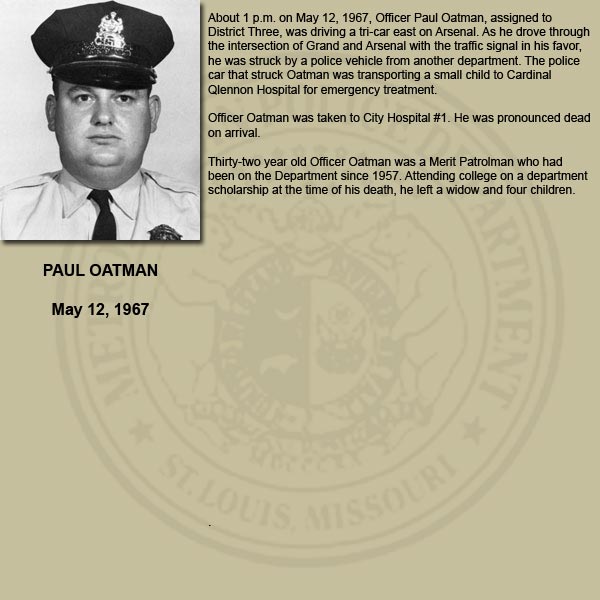 Date of death: May 12, 1967
Full Name: Paul B. Oatman
Content: About 1 p.m. on May 12, 1967, Officer Paul Oatman, assigned to
District Three, was driving a tri-car east on Arsenal. As he drove through
the intersection of Grand and Arsenal with the traffic signal in his favor,
he was struck by a police vehicle from another department. The police
car that struck Oatman was transporting a small child to Cardinal
Qlennon Hospital for emergency treatment.
Officer Oatman was taken to City Hospital #1. He was pronounced dead
on arrival.
Thirty-two year old Officer Oatman was a Merit Patrolman who had
been on the Department since 1957. Attending college on a department
scholarship at the time of his death, he left a widow and four children.
Date of death: May 12, 1967
Full Name: Paul B. Oatman
Content: About 1 p.m. on May 12, 1967, Officer Paul Oatman, assigned to
District Three, was driving a tri-car east on Arsenal. As he drove through
the intersection of Grand and Arsenal with the traffic signal in his favor,
he was struck by a police vehicle from another department. The police
car that struck Oatman was transporting a small child to Cardinal
Qlennon Hospital for emergency treatment.
Officer Oatman was taken to City Hospital #1. He was pronounced dead
on arrival.
Thirty-two year old Officer Oatman was a Merit Patrolman who had
been on the Department since 1957. Attending college on a department
scholarship at the time of his death, he left a widow and four children.
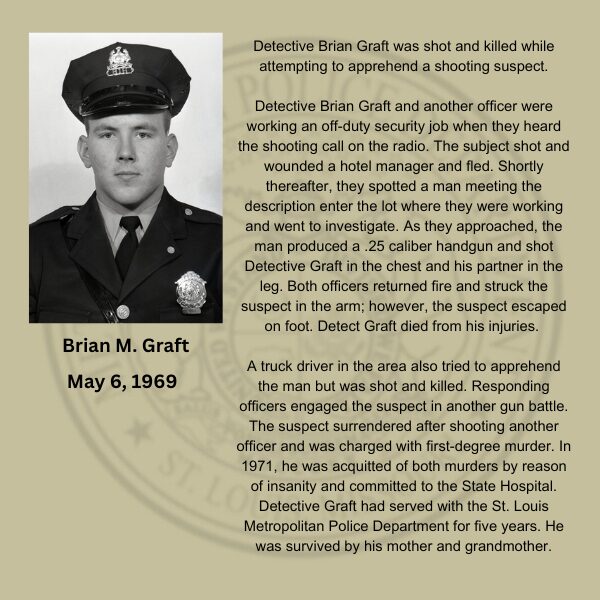 Date of death: May 6, 1969
Full Name: Brian M. Graft
Content: Detective Brian Graft was shot and killed while attempting to apprehend a shooting suspect.
Detective Brian Graft and another officer were working an off-duty security job when they heard the shooting call on the radio. The subject shot and wounded a hotel manager and fled. Shortly thereafter, they spotted a man meeting the description enter the lot where they were working and went to investigate. As they approached, the man produced a .25 caliber handgun and shot Detective Graft in the chest and his partner in the leg. Both officers returned fire and struck the suspect in the arm; however, the suspect escaped on foot. Detect Graft died from his injuries. A truck driver in the area also tried to apprehend the man but was shot and killed.
Responding officers engaged the suspect in another gun battle. The suspect surrendered after shooting another officer and was charged with first-degree murder. In 1971, he was acquitted of both murders by reason of insanity and committed to the State Hospital.
Detective Graft had served with the St. Louis Metropolitan Police Department for five years. He was survived by his mother and grandmother.
Date of death: May 6, 1969
Full Name: Brian M. Graft
Content: Detective Brian Graft was shot and killed while attempting to apprehend a shooting suspect.
Detective Brian Graft and another officer were working an off-duty security job when they heard the shooting call on the radio. The subject shot and wounded a hotel manager and fled. Shortly thereafter, they spotted a man meeting the description enter the lot where they were working and went to investigate. As they approached, the man produced a .25 caliber handgun and shot Detective Graft in the chest and his partner in the leg. Both officers returned fire and struck the suspect in the arm; however, the suspect escaped on foot. Detect Graft died from his injuries. A truck driver in the area also tried to apprehend the man but was shot and killed.
Responding officers engaged the suspect in another gun battle. The suspect surrendered after shooting another officer and was charged with first-degree murder. In 1971, he was acquitted of both murders by reason of insanity and committed to the State Hospital.
Detective Graft had served with the St. Louis Metropolitan Police Department for five years. He was survived by his mother and grandmother.
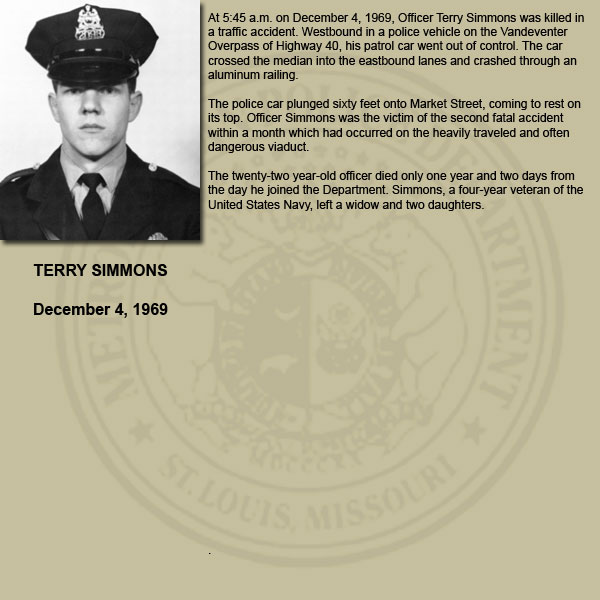 Date of death: December 4, 1969
Full Name: Terry Scott Simmons
Content: At 5:45 a.m. on December 4, 1969, Officer Terry Simmons was killed in
a traffic accident Westbound in a police vehicle on the Vandeventer
Overpass of Highway 40, his patrol car went out of control. The car
crossed the median into the eastbound lanes and crashed through an
aluminum railing.
The police car plunged sixty feet onto Market Street, coming to rest on
its top. Officer Simmons was the victim of the second fatal accident
within 2 month which had occurred on the heavily traveled and often
dangerous viaduct.
The twenty-two year-old officer died only one year and two days from
the day he joined the Department. Simmons, a four-year veteran of the
United States Navy, left a widow and two daughters.
Date of death: December 4, 1969
Full Name: Terry Scott Simmons
Content: At 5:45 a.m. on December 4, 1969, Officer Terry Simmons was killed in
a traffic accident Westbound in a police vehicle on the Vandeventer
Overpass of Highway 40, his patrol car went out of control. The car
crossed the median into the eastbound lanes and crashed through an
aluminum railing.
The police car plunged sixty feet onto Market Street, coming to rest on
its top. Officer Simmons was the victim of the second fatal accident
within 2 month which had occurred on the heavily traveled and often
dangerous viaduct.
The twenty-two year-old officer died only one year and two days from
the day he joined the Department. Simmons, a four-year veteran of the
United States Navy, left a widow and two daughters.
 Date of death: March 30, 1971
Full Name: Paul Kramer
Content: On March 25,1971, off-duty Patrolman Paul Kramer was visiting his
brother Herman's store, the Parkhurst Food Shop, at 230 North Taylor.
Officer Kramer was in the back of the store, behind the meat counter
with his sister-in-law Edith, when three men entered the store. One of
the men stayed in the front where Herman Kramer was behind the
checkout counter. The other two men went to the rear of the store.
Paul and Herman Kramer were both suspicious of the men. While Paul
took over the checkout counter, Herman left to call police from a nearby
hotel. He told the dispatcher that he felt a robbery was about to take
place.
Meanwhile, one of the robbers grabbed Edith Kramer. He put a gun to
her head, saying, "Get the money out of the back.” She told him there
was no money. He waked her to the front of the sore where they
encountered Officer Kramer. The two robbers faced him and demanded
his money. Kramer reached into his pocket and, instead of puling out
his wallet, he drew his gun.
One robber fired twice, hitting Kramer in the head and chest. All three
robbers then fled the scene, taking an undetermined amount of money
from the cash register.
Officer Kramer died from his wounds five days later, on March 30, 1971
Fifty-three year-old Kramer had been on the force for thirty-one years.
He was single.
Date of death: March 30, 1971
Full Name: Paul Kramer
Content: On March 25,1971, off-duty Patrolman Paul Kramer was visiting his
brother Herman's store, the Parkhurst Food Shop, at 230 North Taylor.
Officer Kramer was in the back of the store, behind the meat counter
with his sister-in-law Edith, when three men entered the store. One of
the men stayed in the front where Herman Kramer was behind the
checkout counter. The other two men went to the rear of the store.
Paul and Herman Kramer were both suspicious of the men. While Paul
took over the checkout counter, Herman left to call police from a nearby
hotel. He told the dispatcher that he felt a robbery was about to take
place.
Meanwhile, one of the robbers grabbed Edith Kramer. He put a gun to
her head, saying, "Get the money out of the back.” She told him there
was no money. He waked her to the front of the sore where they
encountered Officer Kramer. The two robbers faced him and demanded
his money. Kramer reached into his pocket and, instead of puling out
his wallet, he drew his gun.
One robber fired twice, hitting Kramer in the head and chest. All three
robbers then fled the scene, taking an undetermined amount of money
from the cash register.
Officer Kramer died from his wounds five days later, on March 30, 1971
Fifty-three year-old Kramer had been on the force for thirty-one years.
He was single.
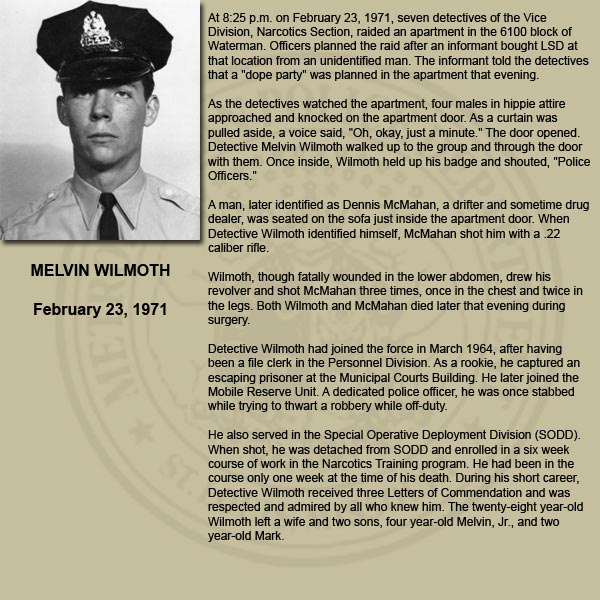 Date of death: February 23, 1971
Full Name: Melvin Wilmoth
Content: At 8:25 p.m. on February 23, 1971, seven detectives of the Vice
Division, Narcotics Section, raided an apartment in the 6100 block of
Waterman. Officers planned the raid after an informant bought LSD at
that location from an unidentified man. The informant fold the defectives
that a "dope party” was planned in the apartment that evening.
AS the detectives watched the apartment, four males in hippie at the
approached and knocked on the apartment door As a curtain was
pulled aside, a voice said, "On, okay, just a minute." The door opened.
Detective Melvin Wimoth walked up to the group and through the door
with them. Once inside, Wimoth held up his badge and shouted, "Police
Officers.”
Aman, later identified as Dennis McMahan, a drifter and sometime drug:
dealer, was seated on the sofa just inside the apartment door. When
Detective Wimoth identified him self, McMahan shot him with a 22
caliber rifle.
Wilmoth, though fatally wounded in the lower abdomen, drew his.
revolver and shot McMahan three times, once in the chest and twice in
the legs. Both Wilmoth and McMahan died later that evening during
surgery.
Detective Wimoth had fined the force in March 1964, after having
been a file clerk n the Personnel Division. AS a rookie, he captured an
escaping prisoner at the Municipal Courts Building. He later joined the
Mobile Reserve Unit. A dedicated police officer, he was once stabbed
while trying to thwart robbery while off-duty.
He also served in the Special Operative Deployment Division (SODD).
When shot, he was detached from SODD and enrolled in a six week
course of work in the Narcolics Training program. He had been in the
course only one week at the time of his death. During his short career,
Detective Wilmoth received three Letters of Commendation and was
respected and admired by all who knew him. The twenty-eight year-old
Wilmoth eft a wie and two sons, four year-old Melvin, Jr, and two
year-old Mark.
Date of death: February 23, 1971
Full Name: Melvin Wilmoth
Content: At 8:25 p.m. on February 23, 1971, seven detectives of the Vice
Division, Narcotics Section, raided an apartment in the 6100 block of
Waterman. Officers planned the raid after an informant bought LSD at
that location from an unidentified man. The informant fold the defectives
that a "dope party” was planned in the apartment that evening.
AS the detectives watched the apartment, four males in hippie at the
approached and knocked on the apartment door As a curtain was
pulled aside, a voice said, "On, okay, just a minute." The door opened.
Detective Melvin Wimoth walked up to the group and through the door
with them. Once inside, Wimoth held up his badge and shouted, "Police
Officers.”
Aman, later identified as Dennis McMahan, a drifter and sometime drug:
dealer, was seated on the sofa just inside the apartment door. When
Detective Wimoth identified him self, McMahan shot him with a 22
caliber rifle.
Wilmoth, though fatally wounded in the lower abdomen, drew his.
revolver and shot McMahan three times, once in the chest and twice in
the legs. Both Wilmoth and McMahan died later that evening during
surgery.
Detective Wimoth had fined the force in March 1964, after having
been a file clerk n the Personnel Division. AS a rookie, he captured an
escaping prisoner at the Municipal Courts Building. He later joined the
Mobile Reserve Unit. A dedicated police officer, he was once stabbed
while trying to thwart robbery while off-duty.
He also served in the Special Operative Deployment Division (SODD).
When shot, he was detached from SODD and enrolled in a six week
course of work in the Narcolics Training program. He had been in the
course only one week at the time of his death. During his short career,
Detective Wilmoth received three Letters of Commendation and was
respected and admired by all who knew him. The twenty-eight year-old
Wilmoth eft a wie and two sons, four year-old Melvin, Jr, and two
year-old Mark.
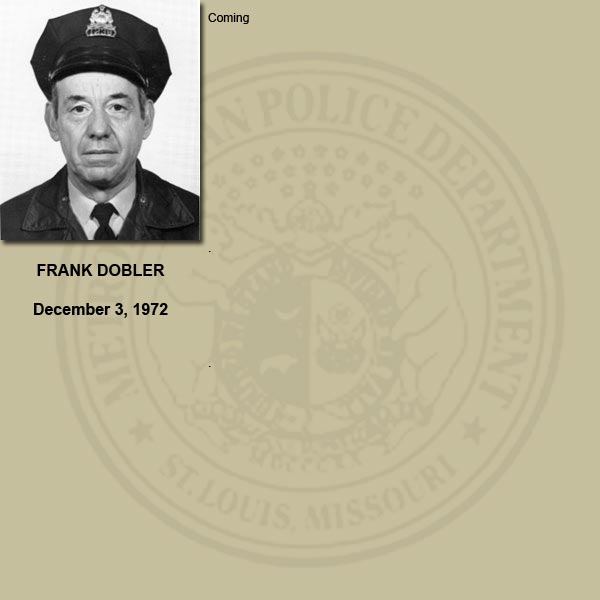 Date of death: December 3, 1972
Full Name: Frank G. Dobler
Content: Coming
Date of death: December 3, 1972
Full Name: Frank G. Dobler
Content: Coming
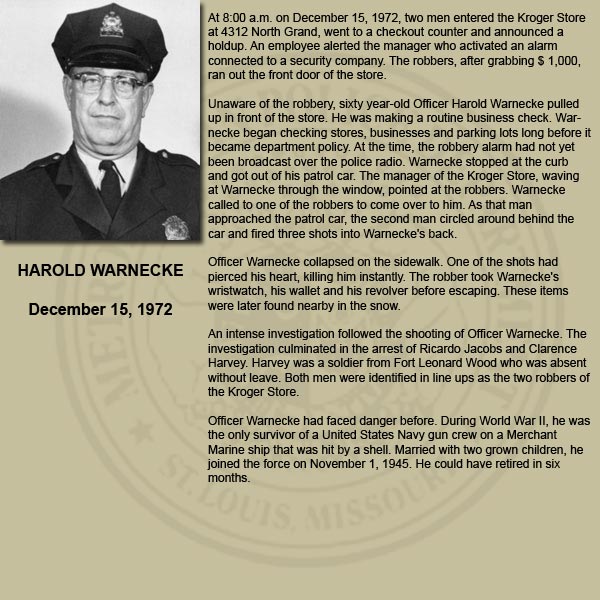 Date of death: December 15, 1972
Full Name: Harold E. Warnecke
Content: At 8:00 a.m. on December 15, 1972, two men entered the Kroger Store
at 4312 North Grand, went to 3 checkout counter and announced a
holdup. An employee alerted the manager who activated an alarm
connected to a security company. The robbers, after grabbing $ 1,000,
ran out the front door of the store.
Unaware of the robbery, sixty year-old Officer Harold Wamecke pulled
up in front of the store. He was making a routine business check. Warnecke began checking stores, businesses and parking lots long before it
became department policy. At the time, the robbery alarm had not yet
been broadcast over the police radio. Wamecke stopped at the curb
and got out of his patrol car. The manager of the Kroger Store, waving
at Warnecke through the window, pointed at the robbers. Warnecke
called to one of the robbers to come over to him. As that man
approached the patrol car, the second man circled around behind the
car and fired three shots into Wamecke's back.
Officer Wamecke collapsed on the sidewalk One of the shots had
pierced his heart, killing him instantly. The robber took Wamecke's
wristwatch, his wallet and his revolver before escaping. These items
were later found nearby in the snow.
An intense investigation followed the shooting of Officer Warnecke. The
investigation culminated in the arrest of Ricardo Jacobs and Clarence
Harvey. Harvey was a soldier from Fort Leonard Wood who was absent
without leave. Both men were identified in line ups as the two robbers of
the Kroger Store.
Officer Wamecke had faced danger before. During World War II, he was
the only survivor of a United States Navy gun crew on a Merchant.
Marine ship that was hit by a shell. Married with two grown children, he
joined the force on November 1, 1945. He could have retired in six
‘months.
Date of death: December 15, 1972
Full Name: Harold E. Warnecke
Content: At 8:00 a.m. on December 15, 1972, two men entered the Kroger Store
at 4312 North Grand, went to 3 checkout counter and announced a
holdup. An employee alerted the manager who activated an alarm
connected to a security company. The robbers, after grabbing $ 1,000,
ran out the front door of the store.
Unaware of the robbery, sixty year-old Officer Harold Wamecke pulled
up in front of the store. He was making a routine business check. Warnecke began checking stores, businesses and parking lots long before it
became department policy. At the time, the robbery alarm had not yet
been broadcast over the police radio. Wamecke stopped at the curb
and got out of his patrol car. The manager of the Kroger Store, waving
at Warnecke through the window, pointed at the robbers. Warnecke
called to one of the robbers to come over to him. As that man
approached the patrol car, the second man circled around behind the
car and fired three shots into Wamecke's back.
Officer Wamecke collapsed on the sidewalk One of the shots had
pierced his heart, killing him instantly. The robber took Wamecke's
wristwatch, his wallet and his revolver before escaping. These items
were later found nearby in the snow.
An intense investigation followed the shooting of Officer Warnecke. The
investigation culminated in the arrest of Ricardo Jacobs and Clarence
Harvey. Harvey was a soldier from Fort Leonard Wood who was absent
without leave. Both men were identified in line ups as the two robbers of
the Kroger Store.
Officer Wamecke had faced danger before. During World War II, he was
the only survivor of a United States Navy gun crew on a Merchant.
Marine ship that was hit by a shell. Married with two grown children, he
joined the force on November 1, 1945. He could have retired in six
‘months.
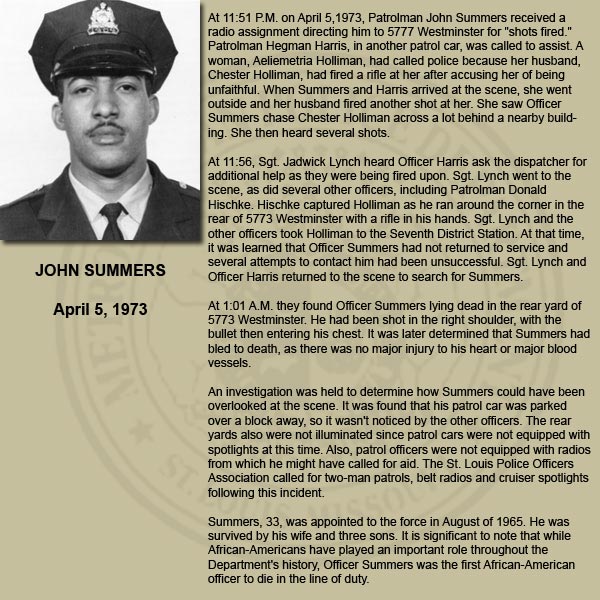 Date of death: April 5,1973
Full Name: John L. Summers
Content: At 11:51 PM. on April 5,1973, Patrolman John Summers received a
radio assignment directing hi to 5777 Westminster for "shots fired."
Patrolman Hegman Harris, in another patrol car, was called to assist. A
woman, Aeliemetia Hollman, had called police because her husband,
Chester Hollman, had fired a rife at her after accusing her of being
unfaithful, When Summers and Harris arrived at the scene, she went
outside and her husband fired another shot at her. She saw Officer
Summers chase Chester Holliman across a lot behind a nearby building. She then heard several shots.
At 11:56, Sgt. Jadwick Lynch heard Officer Harris ask the dispatcher for
additional help as they were being fired upon. Sgt. Lynch went to the
scene, as did several other officers, including Patrolman Donald
Hischke. Hischke captured Hollman as he ran around the comer in the
rear of 5773 Westminster with a rifle in his hands. Sat. Lynch and the
other officers took Hollman to the Seventh District Station. At hat time,
it was learned that Officer Summers had not returned to service and
several attempts to contact him had been unsuccessful. Sat. Lynch and
Officer Harris returned to the scene to search for Summers.
At 1:01 AM. they found Officer Summers lying dead in the rear yard of
5773 Westminster. He had been shot n the right shoulder, with the
bullet then entering is chest. It was later determined that Summers had
bled to death, as there was no major injury to his heart or major blood
vessels.
An investigation was held to determine how Summers could have been
overlooked at the Scene. It was found that his patrol car was parked
over a block away, so it wasn't noticed by the other officers. The rear
yards also were not illuminated since patrol cars were not equipped with
Spotlights at this time. Also, patrol officers were not equipped with radios
from which he might have called for aid. The St. Louis Police Officers
Association called for two-man patrols, belt radios and cruiser spotlight
following this incident.
Summers, 33, was appointed to the force in August of 1965. He was
survived by his wife and three sons. It is significant to note that while
African-Americans have played an important ole throughout the
Department's history, Officer Summers was the first African-American
officer to die n the line of duty.
Date of death: April 5,1973
Full Name: John L. Summers
Content: At 11:51 PM. on April 5,1973, Patrolman John Summers received a
radio assignment directing hi to 5777 Westminster for "shots fired."
Patrolman Hegman Harris, in another patrol car, was called to assist. A
woman, Aeliemetia Hollman, had called police because her husband,
Chester Hollman, had fired a rife at her after accusing her of being
unfaithful, When Summers and Harris arrived at the scene, she went
outside and her husband fired another shot at her. She saw Officer
Summers chase Chester Holliman across a lot behind a nearby building. She then heard several shots.
At 11:56, Sgt. Jadwick Lynch heard Officer Harris ask the dispatcher for
additional help as they were being fired upon. Sgt. Lynch went to the
scene, as did several other officers, including Patrolman Donald
Hischke. Hischke captured Hollman as he ran around the comer in the
rear of 5773 Westminster with a rifle in his hands. Sat. Lynch and the
other officers took Hollman to the Seventh District Station. At hat time,
it was learned that Officer Summers had not returned to service and
several attempts to contact him had been unsuccessful. Sat. Lynch and
Officer Harris returned to the scene to search for Summers.
At 1:01 AM. they found Officer Summers lying dead in the rear yard of
5773 Westminster. He had been shot n the right shoulder, with the
bullet then entering is chest. It was later determined that Summers had
bled to death, as there was no major injury to his heart or major blood
vessels.
An investigation was held to determine how Summers could have been
overlooked at the Scene. It was found that his patrol car was parked
over a block away, so it wasn't noticed by the other officers. The rear
yards also were not illuminated since patrol cars were not equipped with
Spotlights at this time. Also, patrol officers were not equipped with radios
from which he might have called for aid. The St. Louis Police Officers
Association called for two-man patrols, belt radios and cruiser spotlight
following this incident.
Summers, 33, was appointed to the force in August of 1965. He was
survived by his wife and three sons. It is significant to note that while
African-Americans have played an important ole throughout the
Department's history, Officer Summers was the first African-American
officer to die n the line of duty.
 Date of death: November 3, 1973
Full Name: Aloysius J. Nelke
Content: Officer Aloysius Nelke succumbed to gunshot wounds received 22 years earlier on January 28, 1951, when gunfire struck him in the neck. He and four other officers had responded to a burglary in progress on Grandel Square and were met with gunfire as they exited the patrol car. The wounds left Officer Nelke paralyzed. His death was ruled to be a direct result of the gunshot wound and paralysis.
Officer Nelke was survived by his wife, two daughters and two sons.
Date of death: November 3, 1973
Full Name: Aloysius J. Nelke
Content: Officer Aloysius Nelke succumbed to gunshot wounds received 22 years earlier on January 28, 1951, when gunfire struck him in the neck. He and four other officers had responded to a burglary in progress on Grandel Square and were met with gunfire as they exited the patrol car. The wounds left Officer Nelke paralyzed. His death was ruled to be a direct result of the gunshot wound and paralysis.
Officer Nelke was survived by his wife, two daughters and two sons.
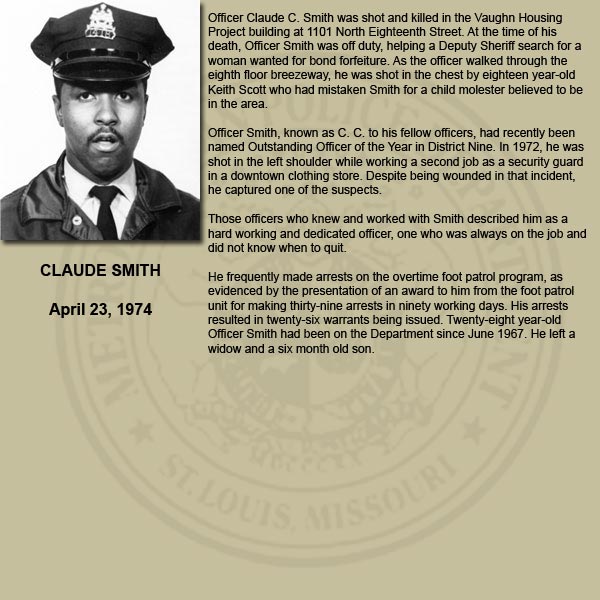 Date of death: April 23, 1974
Full Name: Claude C. Smith
Content: Officer Claude C. Smith was shot and killed in the Vaughn Housing
Project building at 1101 North Eighteenth Street. At the time of his
death, Officer Smith was off duty, helping a Deputy Sheriff search for a
woman wanted for bond forfeiture. As the officer walked through the
eighth floor breezeway, he was Shot in the chest by eighteen year-old
Keith Scott who had mistaken Smith for a child molester believed to be
in the area.
Officer Smith, known as C. C. to his fellow officers, had recently been
named Outstanding Officer of the Year in District Nine. In 1972 he was
shot in the left shoulder while working a second ob as a security guard
in a downtown clothing store. Despite being wounded in that incident,
he captured one of he suspect.
Those officers who knew and worked with Smith described him as a
hard working and dedicated officer, one who was always on the ob and
did not know when to quit.
He frequently made arrests on the overtime foot patrol program, as
evidenced by the presentation of an award to him from the foot patrol
unit for making thirty-nine arrest in ninety working days. His arrests
resulted in twenty-six warrants being issued. Twenty-eight year-old
Officer Smith had been on the Department since June 1967. He left a
widow and a six month old son.
Date of death: April 23, 1974
Full Name: Claude C. Smith
Content: Officer Claude C. Smith was shot and killed in the Vaughn Housing
Project building at 1101 North Eighteenth Street. At the time of his
death, Officer Smith was off duty, helping a Deputy Sheriff search for a
woman wanted for bond forfeiture. As the officer walked through the
eighth floor breezeway, he was Shot in the chest by eighteen year-old
Keith Scott who had mistaken Smith for a child molester believed to be
in the area.
Officer Smith, known as C. C. to his fellow officers, had recently been
named Outstanding Officer of the Year in District Nine. In 1972 he was
shot in the left shoulder while working a second ob as a security guard
in a downtown clothing store. Despite being wounded in that incident,
he captured one of he suspect.
Those officers who knew and worked with Smith described him as a
hard working and dedicated officer, one who was always on the ob and
did not know when to quit.
He frequently made arrests on the overtime foot patrol program, as
evidenced by the presentation of an award to him from the foot patrol
unit for making thirty-nine arrest in ninety working days. His arrests
resulted in twenty-six warrants being issued. Twenty-eight year-old
Officer Smith had been on the Department since June 1967. He left a
widow and a six month old son.
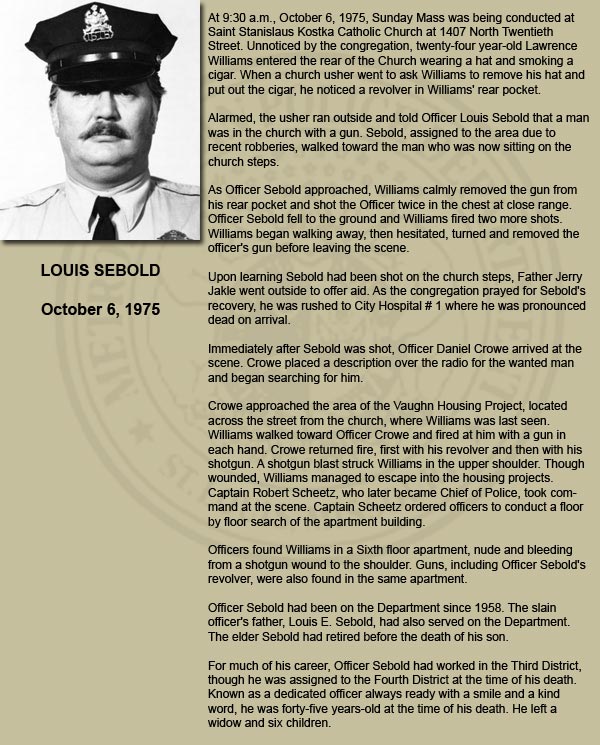 Date of death: October 6, 1975
Full Name: Louis D. Sebold
Content: At 9:30 am, October 6, 1975, Sunday Mass was being conducted at
Saint Stanislaus Kostka Catholic Church at 1407 North Twentieth
Street. Unnoticed by the congregation, twenty-four year-old Lawrence
Williams entered the rear of the Church wearing a hat and smoking a
cigar When a church usher went to ask Williams to remove his hat and
put out the cigar, he noticed a revolver in Williams rear pocket
Alarmed, the usher ran outside and told Officer Louis Sebold that a man
was in the church with a gun. Sebold, assigned to the area due to
recent robberies, walked toward the man who was now sitting on the
church steps.
As Officer Sebold approached, Willams calmly removed the gun from
his rear pocket and shot the Officer twice in the chest at close range.
Officer Sebold feel to the ground and Williams fired two more shots.
Williams began walking away, then hesitated, turned and removed the
officer's gun before leaving the scene.
Upon learning Sebold had been shot on the church steps, Father Jerry
Jakle went outside to offer aid. As the congregation prayed for Sebold's
recovery, he was rushed to City Hospital # 1 where he was pronounced
dead on arrival.
Immediately after Sebold was shot, Officer Daniel Crowe arrived at the
scene. Crowe placed a description over the radio for the wanted man
and began searching for him.
Crowe approached the area of the Vaughn Housing Project, located
across the street from the church, where Williams was last seen.
Williams walked toward Officer Crowe and fired at him with a gun in
each hand. Crowe returned fire, first with his revolver and then with his
shotgun. A shotgun blast struck Williams in the upper shoulder. Though
wounded, Williams managed to escape into the housing projects.
Captain Robert Scheetz, who later became Chief of Police, took command at the scene. Captain Scheetz ordered officers to conduct a floor
by floor search of the apartment building.
Officers found Williams in a Sixth floor apartment, nude and bleeding
from a shotgun wound to the shoulder. Guns, including Officer Sebold's
revolver, were also found in the same apartment.
Officer Sebold had been on the Department since 1958. The slain
officer's father, Louis E. Sebold, had also served on the Department.
The elder Sebold had retired before the death of his son.
For much of his career, Officer Sebold had worked in the Third District,
though he was assigned to the Fourth District at the time of his death.
Known as a dedicated officer always ready with a smile and a kind
word, he was forty-five years-old at the time of his death. He left a
widow and six children.
Date of death: October 6, 1975
Full Name: Louis D. Sebold
Content: At 9:30 am, October 6, 1975, Sunday Mass was being conducted at
Saint Stanislaus Kostka Catholic Church at 1407 North Twentieth
Street. Unnoticed by the congregation, twenty-four year-old Lawrence
Williams entered the rear of the Church wearing a hat and smoking a
cigar When a church usher went to ask Williams to remove his hat and
put out the cigar, he noticed a revolver in Williams rear pocket
Alarmed, the usher ran outside and told Officer Louis Sebold that a man
was in the church with a gun. Sebold, assigned to the area due to
recent robberies, walked toward the man who was now sitting on the
church steps.
As Officer Sebold approached, Willams calmly removed the gun from
his rear pocket and shot the Officer twice in the chest at close range.
Officer Sebold feel to the ground and Williams fired two more shots.
Williams began walking away, then hesitated, turned and removed the
officer's gun before leaving the scene.
Upon learning Sebold had been shot on the church steps, Father Jerry
Jakle went outside to offer aid. As the congregation prayed for Sebold's
recovery, he was rushed to City Hospital # 1 where he was pronounced
dead on arrival.
Immediately after Sebold was shot, Officer Daniel Crowe arrived at the
scene. Crowe placed a description over the radio for the wanted man
and began searching for him.
Crowe approached the area of the Vaughn Housing Project, located
across the street from the church, where Williams was last seen.
Williams walked toward Officer Crowe and fired at him with a gun in
each hand. Crowe returned fire, first with his revolver and then with his
shotgun. A shotgun blast struck Williams in the upper shoulder. Though
wounded, Williams managed to escape into the housing projects.
Captain Robert Scheetz, who later became Chief of Police, took command at the scene. Captain Scheetz ordered officers to conduct a floor
by floor search of the apartment building.
Officers found Williams in a Sixth floor apartment, nude and bleeding
from a shotgun wound to the shoulder. Guns, including Officer Sebold's
revolver, were also found in the same apartment.
Officer Sebold had been on the Department since 1958. The slain
officer's father, Louis E. Sebold, had also served on the Department.
The elder Sebold had retired before the death of his son.
For much of his career, Officer Sebold had worked in the Third District,
though he was assigned to the Fourth District at the time of his death.
Known as a dedicated officer always ready with a smile and a kind
word, he was forty-five years-old at the time of his death. He left a
widow and six children.
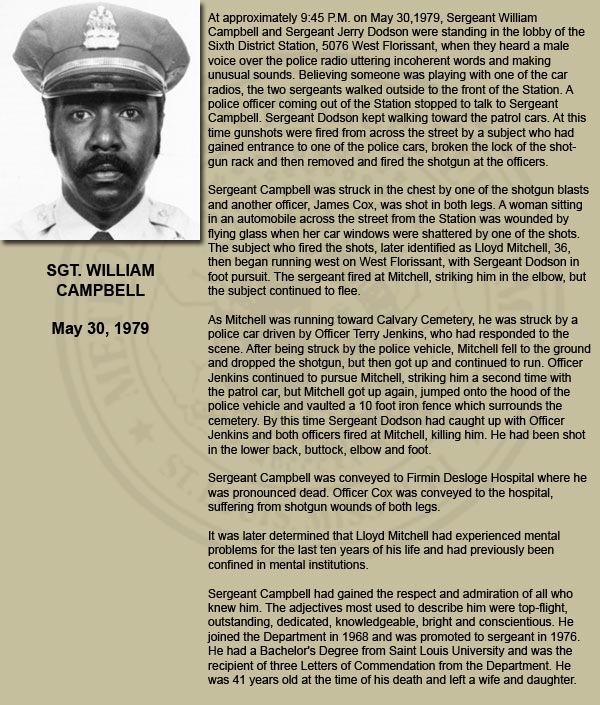 Date of death: May 30, 1979
Full Name: Sgt. William Campbell
Content: At approximately 9:45 P.M. on May 30,1979, Sergeant William
Campbell and Sergeant Jerry Dodson were Standing in the lobby of the
Sixth District Station, 5076 West Florissant, when they heard a male
voice over the police radio uttering incoherent words and making
unusual sounds. Believing someone was playing with one of the car
radios, the two sergeants walked outside to the front of the Station. A
police officer coming out of the Station stopped to talk to Sergeant
Campbell Sergeant Dodson kept walking forward the patrol cars. At this
time gunshots were fired from across the street by a subject who had
gained entrance to one of the police cars, broken the lock of the shot-
gun rack and then removed and fired the shotgun at the officers.
Sergeant Campbell was struck in the chest by one of the shotgun blasts
and another offices, James Cox, was shot In both legs. A woman siting
in an automobile across the street from the Station was wounded by
fling glass when her car windows were shattered by one of the shots.
The subject who fired the shots, later identified as Lloyd Mitchell, 36,
then began running west on West Florissant, with Sergeant Dodson in
foot pursuit. The sergeant fired at Mitchell striking him in the elbow, but
the subject continued to flee.
As Mitchell was running toward Calvary Cemetery, he was struck by a
police car driven by Officer Terry Jenkins, who had responded to the
scene. After being struck by the police vehicle, Mitchell feel to the ground
and dropped the shotgun, but then got up and continued to run. Officer
Jenkins continued to pursue Mitchell string him a second time with
the patrol car, but Mitchell got up again, jumped onto the hood of the
police vehicle and vaulted a 10 foot iron fence which surrounds the
cemetery. By this time Sergeant Dodson had caught up with Officer
Jenkins and both officers fired at Mitchel killing him. He had been shot
in the lower back, buttock, elbow and foot.
Sergeant Campbell was conveyed to Firmin Desloge Hospital where he
was pronounced dead. Officer Cox was conveyed to the hospital,
suffering from shotgun wounds of both legs.
It was later determined that Lloyd Mitchel had experienced mental
problems for the last ten years of his life and had previously been
confined in mental institutions.
Sergeant Campbell had gained the respect and admiration of all who
knew him. The adjectives most used to describe him were top fight,
outstanding, dedicated, knowledgeable, bright and conscientious. He
joined the Department in 1968 and was promoted to sergeant in 1976.
He had a Bachelor's Degree from Saint Louis University and was the
recipient of three Letters of Commendation from the Department He
was 41 years old at the time of his death and left a wife and daughter.
Date of death: May 30, 1979
Full Name: Sgt. William Campbell
Content: At approximately 9:45 P.M. on May 30,1979, Sergeant William
Campbell and Sergeant Jerry Dodson were Standing in the lobby of the
Sixth District Station, 5076 West Florissant, when they heard a male
voice over the police radio uttering incoherent words and making
unusual sounds. Believing someone was playing with one of the car
radios, the two sergeants walked outside to the front of the Station. A
police officer coming out of the Station stopped to talk to Sergeant
Campbell Sergeant Dodson kept walking forward the patrol cars. At this
time gunshots were fired from across the street by a subject who had
gained entrance to one of the police cars, broken the lock of the shot-
gun rack and then removed and fired the shotgun at the officers.
Sergeant Campbell was struck in the chest by one of the shotgun blasts
and another offices, James Cox, was shot In both legs. A woman siting
in an automobile across the street from the Station was wounded by
fling glass when her car windows were shattered by one of the shots.
The subject who fired the shots, later identified as Lloyd Mitchell, 36,
then began running west on West Florissant, with Sergeant Dodson in
foot pursuit. The sergeant fired at Mitchell striking him in the elbow, but
the subject continued to flee.
As Mitchell was running toward Calvary Cemetery, he was struck by a
police car driven by Officer Terry Jenkins, who had responded to the
scene. After being struck by the police vehicle, Mitchell feel to the ground
and dropped the shotgun, but then got up and continued to run. Officer
Jenkins continued to pursue Mitchell string him a second time with
the patrol car, but Mitchell got up again, jumped onto the hood of the
police vehicle and vaulted a 10 foot iron fence which surrounds the
cemetery. By this time Sergeant Dodson had caught up with Officer
Jenkins and both officers fired at Mitchel killing him. He had been shot
in the lower back, buttock, elbow and foot.
Sergeant Campbell was conveyed to Firmin Desloge Hospital where he
was pronounced dead. Officer Cox was conveyed to the hospital,
suffering from shotgun wounds of both legs.
It was later determined that Lloyd Mitchel had experienced mental
problems for the last ten years of his life and had previously been
confined in mental institutions.
Sergeant Campbell had gained the respect and admiration of all who
knew him. The adjectives most used to describe him were top fight,
outstanding, dedicated, knowledgeable, bright and conscientious. He
joined the Department in 1968 and was promoted to sergeant in 1976.
He had a Bachelor's Degree from Saint Louis University and was the
recipient of three Letters of Commendation from the Department He
was 41 years old at the time of his death and left a wife and daughter.
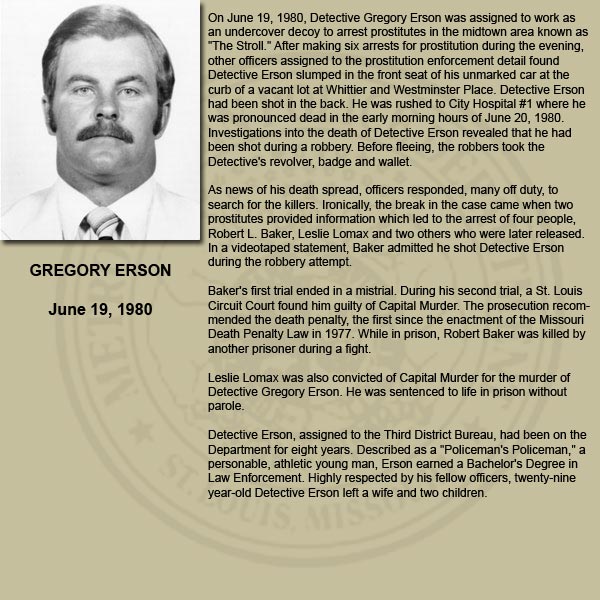 Date of death: June 19, 1980
Full Name: Gregory Erson
Content: On June 19, 1980, Detective Gregory Erson was assigned to work as
an undercover decoy to arrest prostitutes in the midtown area known as
"The Stroll". After making six arrests for prostitution during the evening,
other officers assigned to the prostitution enforcement detail found
Detective Erson slumped in the front seat of his unmarked car at the
curb of a vacant lo at Whiter and Westminster Place. Detective Erson
had been shot in the back. He was rushed to City Hospital #1 where he
was pronounced dead in the early morning hours of June 20, 1980.
Investigations info the death of Detective Erson revealed that he had
been shot during a robbery. Before fleeing, the robbers took the
Detective's revolver, badge and wallet.
AS news of his death spread, officers responded, many off duty, to
search for the killers. Ironically, the break in the case came when two
prostitutes provided information which led to the arrest of four people,
Robert L. Baker, Leslie Lomax and two others who were after released.
In a videotaped Statement, Baker admitted he shot Detective Erson
during the robbery attempt.
Baker's first trial ended in a mistrial. During his second trial, a St. Louis
Circuit Court found hi guilty of Capital Murder. The prosecution recomended the death penalty, the first since the enactment of the Missouri
Death Penalty Law in 1877. While in prison, Robert Baker was killed by
another prisoner during a fight.
Leslie Lomax was also convicted of Capital Murder for the murder of
Detective Gregory Erson. He was sentenced to life in prison without
parole.
Detective Erson, assigned to the Third District Bureau, had been on the
Department for eight years. Described as a Policeman's Policeman,
personable, athletic young man, Erson eared a Bachelor's Degree in
Law Enforcement. Highly respected by his fellow officers, twenty-nine.
year-old Detective Erson left a wife and two children.
Date of death: June 19, 1980
Full Name: Gregory Erson
Content: On June 19, 1980, Detective Gregory Erson was assigned to work as
an undercover decoy to arrest prostitutes in the midtown area known as
"The Stroll". After making six arrests for prostitution during the evening,
other officers assigned to the prostitution enforcement detail found
Detective Erson slumped in the front seat of his unmarked car at the
curb of a vacant lo at Whiter and Westminster Place. Detective Erson
had been shot in the back. He was rushed to City Hospital #1 where he
was pronounced dead in the early morning hours of June 20, 1980.
Investigations info the death of Detective Erson revealed that he had
been shot during a robbery. Before fleeing, the robbers took the
Detective's revolver, badge and wallet.
AS news of his death spread, officers responded, many off duty, to
search for the killers. Ironically, the break in the case came when two
prostitutes provided information which led to the arrest of four people,
Robert L. Baker, Leslie Lomax and two others who were after released.
In a videotaped Statement, Baker admitted he shot Detective Erson
during the robbery attempt.
Baker's first trial ended in a mistrial. During his second trial, a St. Louis
Circuit Court found hi guilty of Capital Murder. The prosecution recomended the death penalty, the first since the enactment of the Missouri
Death Penalty Law in 1877. While in prison, Robert Baker was killed by
another prisoner during a fight.
Leslie Lomax was also convicted of Capital Murder for the murder of
Detective Gregory Erson. He was sentenced to life in prison without
parole.
Detective Erson, assigned to the Third District Bureau, had been on the
Department for eight years. Described as a Policeman's Policeman,
personable, athletic young man, Erson eared a Bachelor's Degree in
Law Enforcement. Highly respected by his fellow officers, twenty-nine.
year-old Detective Erson left a wife and two children.
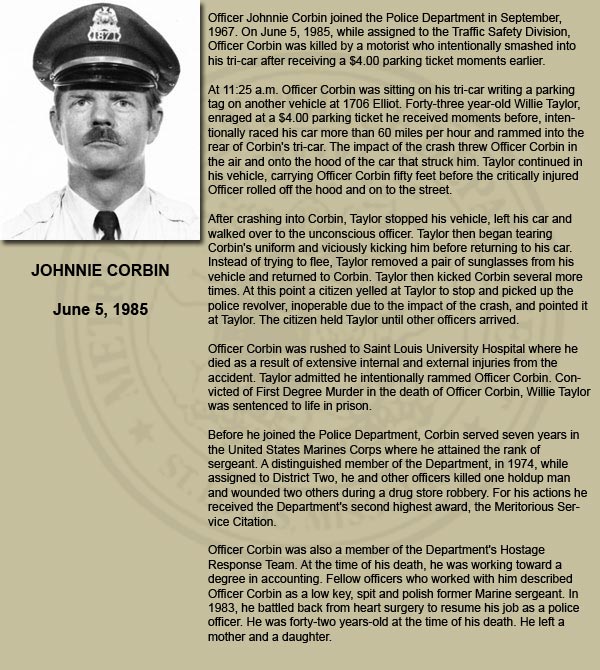 Date of death: June 5, 1985
Full Name: Johnnie C. Corbin
Content: Officer Johnnie Corbin joined the Police Department in September,
1967. On June 5, 1985, while assigned to the Traffic Safety Division,
Officer Corbin was killed by a motorist who intentionally smashed info
his tri-car after receiving a $4.00 parking ticket moments earlier.
At 11:25 am. Officer Corbin was sitting on his tri-car writing a parking
tag on another vehicle at 1706 Elliot. Forty-three year-old Willie Taylor,
enraged at a $4.00 parking ticket he received moments before, intentionally raced his car more than 60 miles per hour and rammed info the
rear of Corbin's tr-car. The impact of the crash threw Officer Corbin in
the air and onto the hood of the car that struck him. Taylor continued in
his vehicle, carrying Officer Corbin fit feet before the critically injured
Officer rolled off the hood and on to the street.
After crashing into Corbin, Taylor stopped his vehicle, left his car and
walked over to the unconscious officer. Taylor then began tearing
Corbin's uniform and viciously kicking him before returning to his car
Instead of trying to flee, Taylor removed a pair of sunglasses from his
vehicle and returned to Corbin. Taylor then kicked Corbin several more
times. At this point a citizen yelled at Taylor o stop and picked up the
police revolver, inoperable due to the impact of the crash, and pointed it
at Taylor. The citizen held Taylor until other officers arrived.
Officer Corbin was rushed to Saint Louis University Hospital where he
died as a result of extensive internal and external injuries from the
accident. Taylor admitted he intentionally rammed Officer Corbin. Convicted of First Degree Murder in the death of Officer Corbin, Willie Taylor
was sentenced to life in prison.
Before he joined the Police Department, Corbin served seven years in
the United States Marines Corps where he attained the rank of
sergeant. A distinguished member of the Department, in 1974, while
assigned to District Two, he and other officers killed one holdup man
and wounded two others during a drug store robbery. For his actions he
received the Department’s second-highest award, the Meritorious Service Citation.
Officer Corbin was also a member of the Department's Hostage:
Response Team. At the time of his death, he was working toward a
degree in accounting. Fellow officers who worked with him described
Officer Corbin as a low key, spit and polish former Marine sergeant. In
1983, he battled back from heart surgery to resume his job as a police
officer. He was forty-two years-old at the time of his death. He left a
mother and a daughter.
Date of death: June 5, 1985
Full Name: Johnnie C. Corbin
Content: Officer Johnnie Corbin joined the Police Department in September,
1967. On June 5, 1985, while assigned to the Traffic Safety Division,
Officer Corbin was killed by a motorist who intentionally smashed info
his tri-car after receiving a $4.00 parking ticket moments earlier.
At 11:25 am. Officer Corbin was sitting on his tri-car writing a parking
tag on another vehicle at 1706 Elliot. Forty-three year-old Willie Taylor,
enraged at a $4.00 parking ticket he received moments before, intentionally raced his car more than 60 miles per hour and rammed info the
rear of Corbin's tr-car. The impact of the crash threw Officer Corbin in
the air and onto the hood of the car that struck him. Taylor continued in
his vehicle, carrying Officer Corbin fit feet before the critically injured
Officer rolled off the hood and on to the street.
After crashing into Corbin, Taylor stopped his vehicle, left his car and
walked over to the unconscious officer. Taylor then began tearing
Corbin's uniform and viciously kicking him before returning to his car
Instead of trying to flee, Taylor removed a pair of sunglasses from his
vehicle and returned to Corbin. Taylor then kicked Corbin several more
times. At this point a citizen yelled at Taylor o stop and picked up the
police revolver, inoperable due to the impact of the crash, and pointed it
at Taylor. The citizen held Taylor until other officers arrived.
Officer Corbin was rushed to Saint Louis University Hospital where he
died as a result of extensive internal and external injuries from the
accident. Taylor admitted he intentionally rammed Officer Corbin. Convicted of First Degree Murder in the death of Officer Corbin, Willie Taylor
was sentenced to life in prison.
Before he joined the Police Department, Corbin served seven years in
the United States Marines Corps where he attained the rank of
sergeant. A distinguished member of the Department, in 1974, while
assigned to District Two, he and other officers killed one holdup man
and wounded two others during a drug store robbery. For his actions he
received the Department’s second-highest award, the Meritorious Service Citation.
Officer Corbin was also a member of the Department's Hostage:
Response Team. At the time of his death, he was working toward a
degree in accounting. Fellow officers who worked with him described
Officer Corbin as a low key, spit and polish former Marine sergeant. In
1983, he battled back from heart surgery to resume his job as a police
officer. He was forty-two years-old at the time of his death. He left a
mother and a daughter.
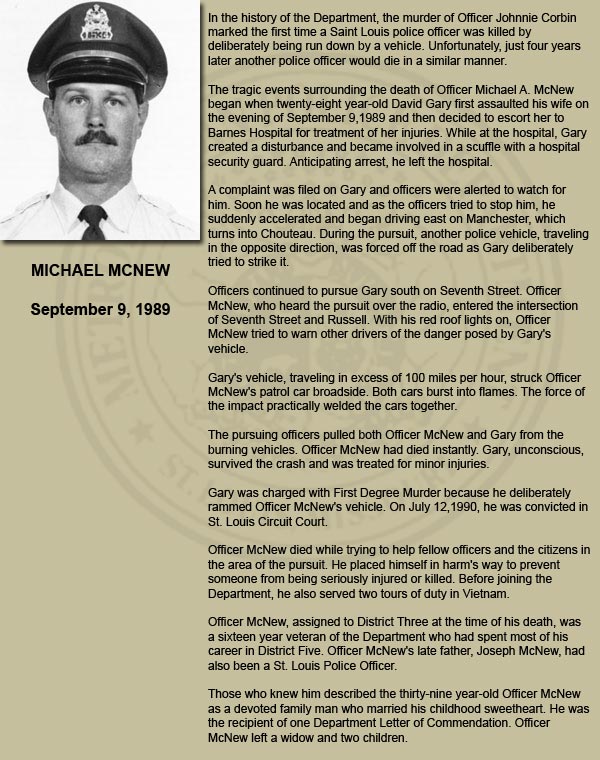 Date of death: September 9, 1989
Full Name: Michael McNew
Content: In the history of the Department, the murder of Officer Johnnie Corbin
marked the first time a Saint Louis police officer was killed by
deliberately being run down by a vehicle. Unfortunately, just four years
later another police officer would die in a similar manner.
The tragic events surrounding the death of Offer Michael A. McNew
began when twenty-eight year-old David Gary first assaulted his wife on
the evening of September 9, 1989 and then decided to escort her to
Barnes Hospital for treatment of her injuries. While at the hospital, Gary
created a disturbance and became involved in a scuffle with a hospital
security guard. Anticipating arrest, he left the hospital.
A complaint was filed on Gary and officers were alerted to watch for
him. Soon he was located and as the officers fried to stop him, he.
Suddenly accelerated and began driving east on Manchester, which
turns into Chouteau. During the pursuit, another police vehicle, traveling
in the opposite direction, was forced off the road as Gary deliberately
tied to strike it.
Officers continued to pursue Gary south on Seventh Street Officer
McNew, who heard the pursuit over the radio, entered the intersection
of Seventh Street and Russell. With is red roof lights on, Officer
McNew tried to warm other drivers of the danger posed by Gary's
vehicle.
Gary's vehicle, traveling in excess of 100 miles per hour, struck Officer
McNews patrol car broadside. Both cars burs: into flames. The force of
the impact practically welded the cars together.
The pursuing officers pulled both Officer McNew and Gary from the
burning vehicles. Officer McNew had died instantly. Gary, Unconscious,
survived the crash and was treated for minor injuries
Gary was charged with First Degree Murder because he deliberately
rammed Officer McNews vehicle. On July 12,1990, he was convicted in
St. Louis Circuit Court.
Officer McNew died while trying to help fellow officers and the citizens in
the area of the pursuit. He placed himself in harm's way to prevent
someone from being seriously injured or killed. Before joining the
Department, he also served two tours of duty in Vietnam.
Officer McNew, assigned to District Three at the time of his death, was
a sixteen year veteran of the Department who had spent most of his
career in District Five. Officer McNews ate father, Joseph McNew, had
also been a St. Louis Police Officer.
Those who knew him described the thirty-nine year-old Officer McNew
as a devoted family man who married his childhood sweetheart. He was
the recipient of one Department Letter of Commendation. Officer
McNew left a widow and two children.
Date of death: September 9, 1989
Full Name: Michael McNew
Content: In the history of the Department, the murder of Officer Johnnie Corbin
marked the first time a Saint Louis police officer was killed by
deliberately being run down by a vehicle. Unfortunately, just four years
later another police officer would die in a similar manner.
The tragic events surrounding the death of Offer Michael A. McNew
began when twenty-eight year-old David Gary first assaulted his wife on
the evening of September 9, 1989 and then decided to escort her to
Barnes Hospital for treatment of her injuries. While at the hospital, Gary
created a disturbance and became involved in a scuffle with a hospital
security guard. Anticipating arrest, he left the hospital.
A complaint was filed on Gary and officers were alerted to watch for
him. Soon he was located and as the officers fried to stop him, he.
Suddenly accelerated and began driving east on Manchester, which
turns into Chouteau. During the pursuit, another police vehicle, traveling
in the opposite direction, was forced off the road as Gary deliberately
tied to strike it.
Officers continued to pursue Gary south on Seventh Street Officer
McNew, who heard the pursuit over the radio, entered the intersection
of Seventh Street and Russell. With is red roof lights on, Officer
McNew tried to warm other drivers of the danger posed by Gary's
vehicle.
Gary's vehicle, traveling in excess of 100 miles per hour, struck Officer
McNews patrol car broadside. Both cars burs: into flames. The force of
the impact practically welded the cars together.
The pursuing officers pulled both Officer McNew and Gary from the
burning vehicles. Officer McNew had died instantly. Gary, Unconscious,
survived the crash and was treated for minor injuries
Gary was charged with First Degree Murder because he deliberately
rammed Officer McNews vehicle. On July 12,1990, he was convicted in
St. Louis Circuit Court.
Officer McNew died while trying to help fellow officers and the citizens in
the area of the pursuit. He placed himself in harm's way to prevent
someone from being seriously injured or killed. Before joining the
Department, he also served two tours of duty in Vietnam.
Officer McNew, assigned to District Three at the time of his death, was
a sixteen year veteran of the Department who had spent most of his
career in District Five. Officer McNews ate father, Joseph McNew, had
also been a St. Louis Police Officer.
Those who knew him described the thirty-nine year-old Officer McNew
as a devoted family man who married his childhood sweetheart. He was
the recipient of one Department Letter of Commendation. Officer
McNew left a widow and two children.
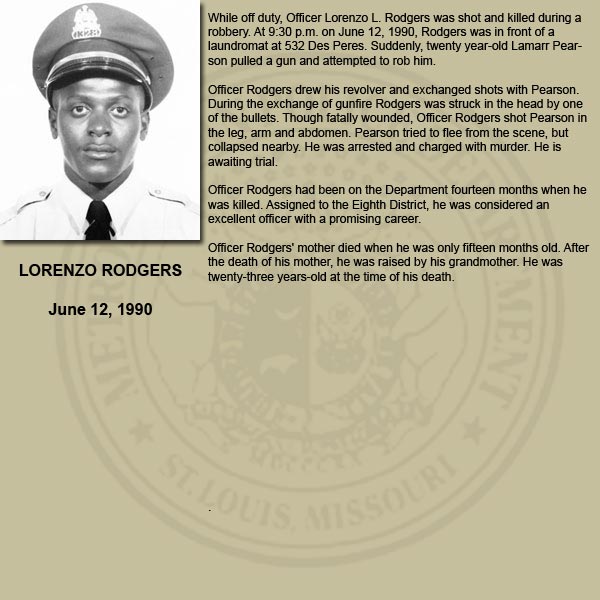 Date of death: June 12, 1990
Full Name: Lorenzo Rodgers
Content: While off duty, Officer Lorenzo L. Rodgers was shot and killed during a
robbery. At :30 p.m. on June 12, 1990, Rodgers was n font of a
laundromat at 532 Des Peres. Suddenly, twenty year-old Lamarr Pear-
son pulled a gun and attempted to rob him.
Officer Rodgers drew his revolver and exchanged shots with Pearson.
During the exchange of gunfire Rodgers was struck in the head by one
of the bullets. Though fatally wounded, Officer Rodgers shot Pearson in
the leg, arm and abdomen. Pearson tried to flee from the scene, but
collapsed nearby. He was arrested and charged with murder. He is
awaiting trial.
Officer Rodgers had been on the Department fourteen months when he
was killed. Assigned to the Eighth District, he was considered an
excellent officer with a promising career.
Officer Rodgers’ mother died when he was only fifteen months old. After
the death of his mother, he was raised by his grandmother He was
twenty-three years-old at the time of his death.
Date of death: June 12, 1990
Full Name: Lorenzo Rodgers
Content: While off duty, Officer Lorenzo L. Rodgers was shot and killed during a
robbery. At :30 p.m. on June 12, 1990, Rodgers was n font of a
laundromat at 532 Des Peres. Suddenly, twenty year-old Lamarr Pear-
son pulled a gun and attempted to rob him.
Officer Rodgers drew his revolver and exchanged shots with Pearson.
During the exchange of gunfire Rodgers was struck in the head by one
of the bullets. Though fatally wounded, Officer Rodgers shot Pearson in
the leg, arm and abdomen. Pearson tried to flee from the scene, but
collapsed nearby. He was arrested and charged with murder. He is
awaiting trial.
Officer Rodgers had been on the Department fourteen months when he
was killed. Assigned to the Eighth District, he was considered an
excellent officer with a promising career.
Officer Rodgers’ mother died when he was only fifteen months old. After
the death of his mother, he was raised by his grandmother He was
twenty-three years-old at the time of his death.
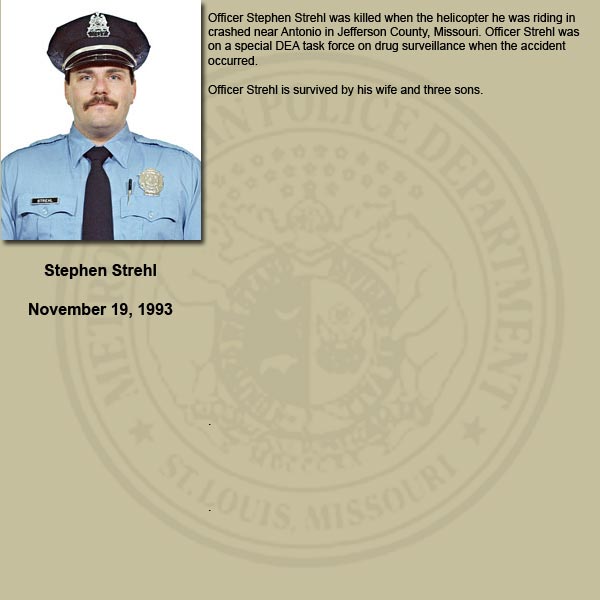 Date of death: November 19, 1993
Full Name: Stephen Strehl
Content: Officer Stephen Strehl was killed when the helicopter he was riding in
crashed near Antonio in Jefferson County, Missouri Officer Strehi was
on a special DEA task force on drug surveillance when the accident
occurred.
Officer Strehl is survived by his wife and three sons.
Date of death: November 19, 1993
Full Name: Stephen Strehl
Content: Officer Stephen Strehl was killed when the helicopter he was riding in
crashed near Antonio in Jefferson County, Missouri Officer Strehi was
on a special DEA task force on drug surveillance when the accident
occurred.
Officer Strehl is survived by his wife and three sons.
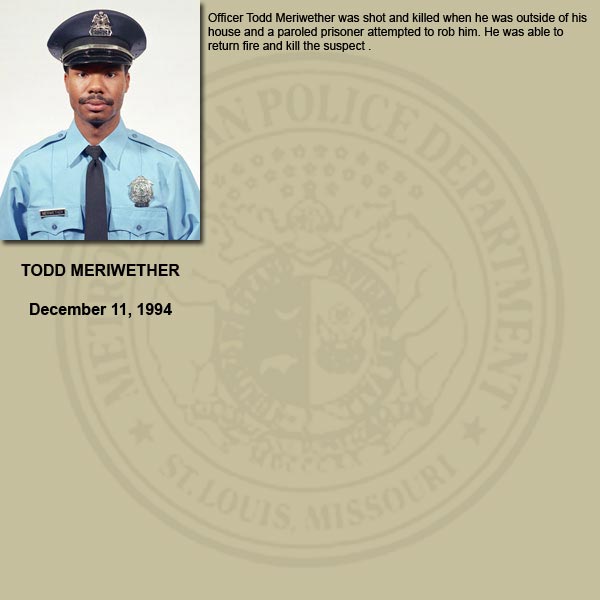 Date of death: December 11, 1994
Full Name: Todd Meriwether
Content: Officer Todd Meriwether was shot and killed when he was outside of his.
house and a paroled prisoner attempted to rob him. He was able to
return fire and Kill the suspect.
Date of death: December 11, 1994
Full Name: Todd Meriwether
Content: Officer Todd Meriwether was shot and killed when he was outside of his.
house and a paroled prisoner attempted to rob him. He was able to
return fire and Kill the suspect.
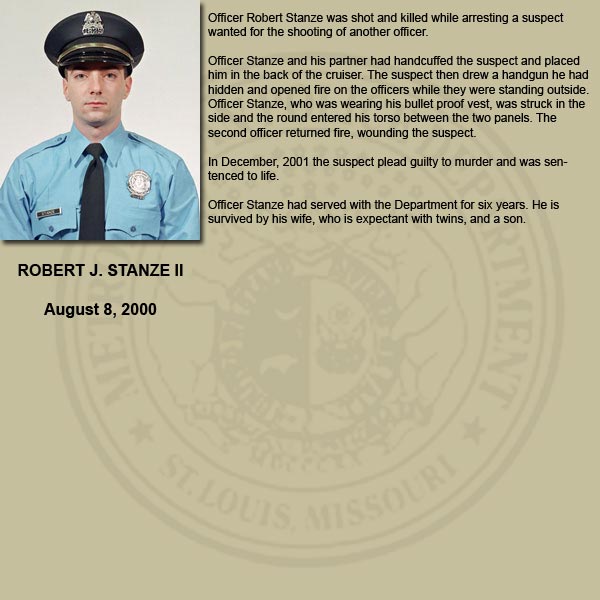 Date of death: August 8, 2000
Full Name: Robert J. Stanze II
Content: Officer Robert Stanze was shot and killed while arresting a suspect
wanted or the shooting of another officer.
Officer Stanze and his partner had handcuffed the suspect and placed
him in the back of the cruiser. The suspect then drew a handgun he had
hidden and opened fire on the officers while they were standing outside.
Officer Stanze, who was wearing his bullet proof vest, was struck i the
side and the round entered his torso between the two panels. The
second officer returned fire, wounding the suspect.
In December, 2001 the suspect plead guilty to murder and was sentenced to life.
Officer Stanze had served with the Department for six years. He is
survived by his wife, who is expectant with twins, and a son.
Date of death: August 8, 2000
Full Name: Robert J. Stanze II
Content: Officer Robert Stanze was shot and killed while arresting a suspect
wanted or the shooting of another officer.
Officer Stanze and his partner had handcuffed the suspect and placed
him in the back of the cruiser. The suspect then drew a handgun he had
hidden and opened fire on the officers while they were standing outside.
Officer Stanze, who was wearing his bullet proof vest, was struck i the
side and the round entered his torso between the two panels. The
second officer returned fire, wounding the suspect.
In December, 2001 the suspect plead guilty to murder and was sentenced to life.
Officer Stanze had served with the Department for six years. He is
survived by his wife, who is expectant with twins, and a son.
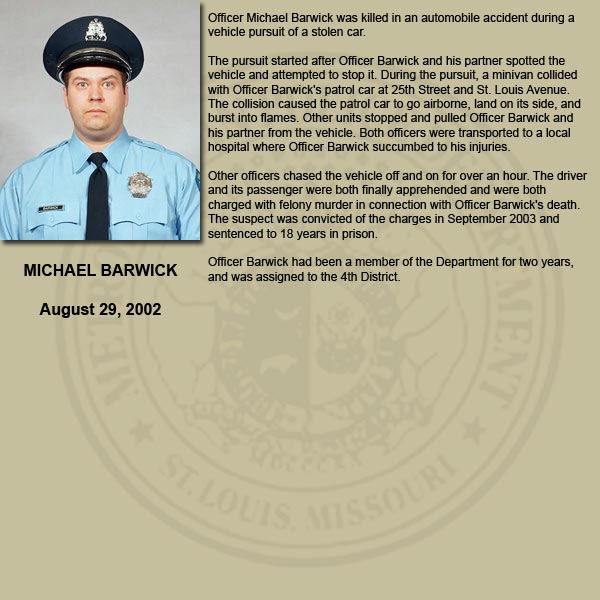 Date of death: August 29, 2002
Full Name: Michael J. Barwick
Content: Officer Michael Barwick was killed in an automobile accident during a
Vehicle pursuit of a stolen car.
The pursuit started after Officer Barwick and his partner spotted the
vehicle and attempted to stop it. During the pursuit, a minivan collided
with Officer Barwick patrol car at 25th Street and St. Louis Avenue.
The collision caused the patrol car to go airborn, land on is side, and
burst into flames. Other units stopped and pulled Officer Barwick and
his partner from the vehicle. Both officers were transported to a local
hospital where Officer Barwick succumbed to his injures.
Other officers chased the vehicle off and on for over an hour. The driver
and its passenger were both finally apprehended and were both
charged with felony murder in connection with Officer Barwick's death
The suspect was convicted of the charges in September 2003 and
sentenced to 18 years in prison.
Officer Barwick had been a member of the Department for two years,
and was assigned to the 4th District.
Date of death: August 29, 2002
Full Name: Michael J. Barwick
Content: Officer Michael Barwick was killed in an automobile accident during a
Vehicle pursuit of a stolen car.
The pursuit started after Officer Barwick and his partner spotted the
vehicle and attempted to stop it. During the pursuit, a minivan collided
with Officer Barwick patrol car at 25th Street and St. Louis Avenue.
The collision caused the patrol car to go airborn, land on is side, and
burst into flames. Other units stopped and pulled Officer Barwick and
his partner from the vehicle. Both officers were transported to a local
hospital where Officer Barwick succumbed to his injures.
Other officers chased the vehicle off and on for over an hour. The driver
and its passenger were both finally apprehended and were both
charged with felony murder in connection with Officer Barwick's death
The suspect was convicted of the charges in September 2003 and
sentenced to 18 years in prison.
Officer Barwick had been a member of the Department for two years,
and was assigned to the 4th District.
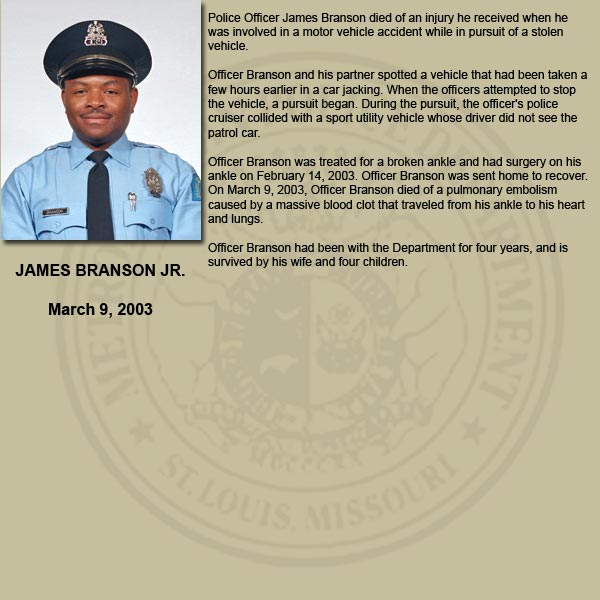 Date of death: March 9, 2003
Full Name: James W. Branson Jr.
Content: Police Officer James Branson died of an injury he received when he
was involved in a motor vehicle accident while in pursuit of a stolen
vehicle.
Officer Branson and his partner spotted a vehicle that had been taken a
few hours earlier in a car jacking. When the officers attempted to stop
the vehicle, a pursuit began. During the pursue, the officer's police
cruiser collided with a sport utility vehicle whose driver did not see the
patrol car.
Officer Branson was treated for a broken ankle and had surgery on his
ankle on February 14, 2003. Officer Branson was sent home to recover:
On March 9, 2003, Officer Branson died of a pulmonary embolism
caused by a massive blood clot that traveled from his ankle to his heart
and lungs.
Officer Branson had been with the Department for four years, and is
survived by his wife and four children.
Date of death: March 9, 2003
Full Name: James W. Branson Jr.
Content: Police Officer James Branson died of an injury he received when he
was involved in a motor vehicle accident while in pursuit of a stolen
vehicle.
Officer Branson and his partner spotted a vehicle that had been taken a
few hours earlier in a car jacking. When the officers attempted to stop
the vehicle, a pursuit began. During the pursue, the officer's police
cruiser collided with a sport utility vehicle whose driver did not see the
patrol car.
Officer Branson was treated for a broken ankle and had surgery on his
ankle on February 14, 2003. Officer Branson was sent home to recover:
On March 9, 2003, Officer Branson died of a pulmonary embolism
caused by a massive blood clot that traveled from his ankle to his heart
and lungs.
Officer Branson had been with the Department for four years, and is
survived by his wife and four children.
 Date of death: January 30, 2004
Full Name: Nicholas K. Sloan
Content: Officer Nicholas Sloan was shot and killed while conducting a narcotics
operation on North Taylor Avenue.
Officer Sloan and his partner were participating n a narcotics operation
made possible through the federal Weed and Seed Program. The
officers were observing drug sales in the parking lot of a liquor sore.
Upon observing a transaction, he and his partner approached one of he
subjects The man immediately began to struggle with the officers.
During the struggle Officer Sloan suffered several injuries, including a
deep gash above his right eye.
As the three continued to struggle, the suspect was able to gain control
of Officer Sloan's service weapon. He shot Officer Sloan once in the
chest, just above his vest. The suspect then fired at Officer Sloan's
partner three times, striking him twice. Despite being wounded, the
partner was able to return fire and killed the suspect.
Officer Sloan had served with the Department for just over 2 years. He
is survived by his 13-month-oid son, girlfriend, parents, and two sisters.
His father serves as a sergeant with the Department's Vice/Narcotics
Division.
Date of death: January 30, 2004
Full Name: Nicholas K. Sloan
Content: Officer Nicholas Sloan was shot and killed while conducting a narcotics
operation on North Taylor Avenue.
Officer Sloan and his partner were participating n a narcotics operation
made possible through the federal Weed and Seed Program. The
officers were observing drug sales in the parking lot of a liquor sore.
Upon observing a transaction, he and his partner approached one of he
subjects The man immediately began to struggle with the officers.
During the struggle Officer Sloan suffered several injuries, including a
deep gash above his right eye.
As the three continued to struggle, the suspect was able to gain control
of Officer Sloan's service weapon. He shot Officer Sloan once in the
chest, just above his vest. The suspect then fired at Officer Sloan's
partner three times, striking him twice. Despite being wounded, the
partner was able to return fire and killed the suspect.
Officer Sloan had served with the Department for just over 2 years. He
is survived by his 13-month-oid son, girlfriend, parents, and two sisters.
His father serves as a sergeant with the Department's Vice/Narcotics
Division.
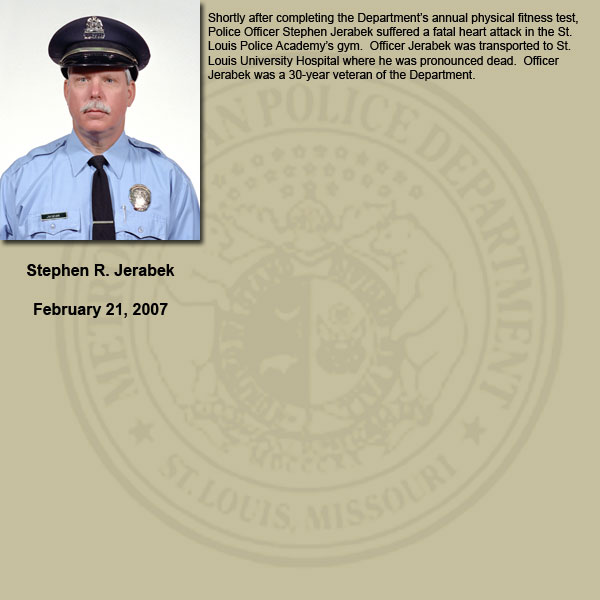 Date of death: February 21, 2007
Full Name: Stephen R. Jerabek
Content: Shortly after completing the Department's annual physical fitness test,
Police Officer Stephen Jerabek suffered a fatal heart attack in the St.
Louis Police Academy's gym. Officer Jerabek was transported to St.
Louis University Hospital where he was pronounced dead. Officer
Jerabek was 30-year veteran of the Department.
Date of death: February 21, 2007
Full Name: Stephen R. Jerabek
Content: Shortly after completing the Department's annual physical fitness test,
Police Officer Stephen Jerabek suffered a fatal heart attack in the St.
Louis Police Academy's gym. Officer Jerabek was transported to St.
Louis University Hospital where he was pronounced dead. Officer
Jerabek was 30-year veteran of the Department.
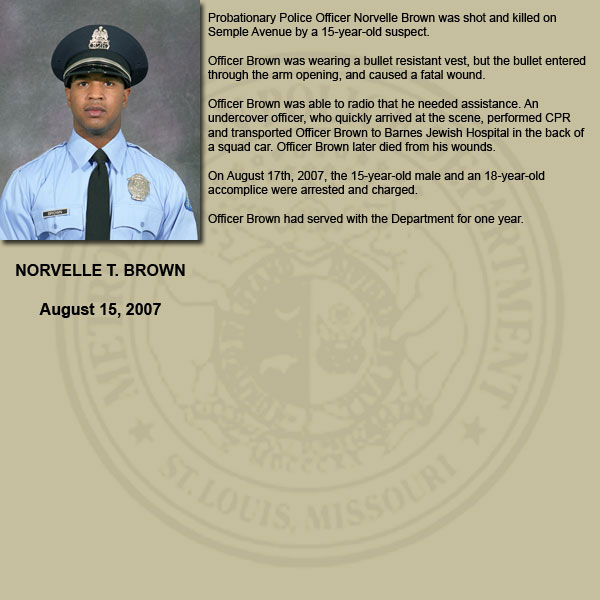 Date of death: August 15, 2007
Full Name: Norvelle T. Brown
Content: Probationary Police Officer Norvelle Brown was shot and killed on
Semple Avenue by a 15-year-old suspect.
Officer Brown was wearing a bullet resistant vest, but the bullet entered
through the arm opening, and caused a fatal wound.
Officer Brown was able to radio that he needed assistance. An
undercover officer, who quickly arrived at the scene, performed CPR
and transported Officer Brown to Barnes Jewish Hospital in the back of
a squad car. Officer Brown later died from his wounds.
On August 17th, 2007, the 15-year-old male and an 18-year-old
accomplice were arrested and charged.
Officer Brown had served with the Department for one year.
Date of death: August 15, 2007
Full Name: Norvelle T. Brown
Content: Probationary Police Officer Norvelle Brown was shot and killed on
Semple Avenue by a 15-year-old suspect.
Officer Brown was wearing a bullet resistant vest, but the bullet entered
through the arm opening, and caused a fatal wound.
Officer Brown was able to radio that he needed assistance. An
undercover officer, who quickly arrived at the scene, performed CPR
and transported Officer Brown to Barnes Jewish Hospital in the back of
a squad car. Officer Brown later died from his wounds.
On August 17th, 2007, the 15-year-old male and an 18-year-old
accomplice were arrested and charged.
Officer Brown had served with the Department for one year.
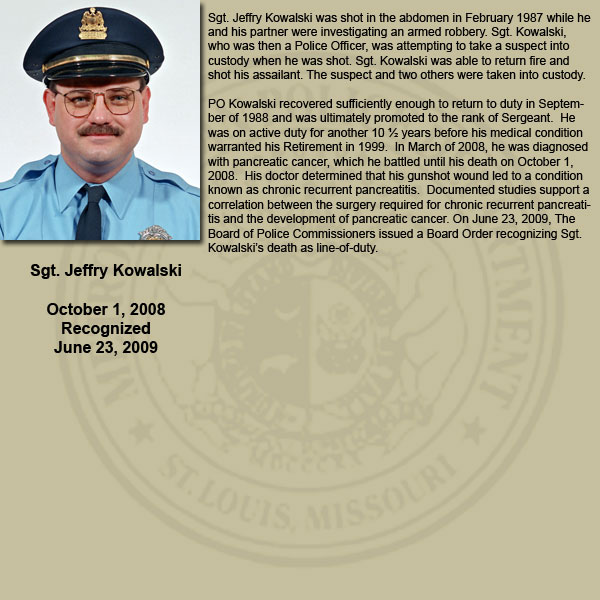 Date of death: October 1, 2008 Recognized June 23, 2009
Full Name: Sgt. Jeffry Kowalski
Content: Sgt. Jeffry Kowalski was shot in the abdomen in February 1987 while he-
and his partner were investigating an armed robbery. Sqt. Kowalski,
who was then a Police Officer, was attempting to take a suspect into.
custody when he was shot. Sgt. Kowalski was able to return fie and
shot his assailant. The suspect and two others were taken info custody.
PO Kowalski recovered sufficiently enough to return to duty in September of 1988 and was ultimately promoted to the rank of Sergeant. He
was on active duty for another 10 % years before his medical condition
warranted his Retirement in 1999. In March of 2008, he was diagnosed
with pancreatic cancer, which he batted until his death on October 1,
2008. His doctor determined that his gunshot wounded to a condition
known as chronic recurrent pancreatitis. Documented studies support a
correlation between the surgery required for chronic recurrent pancreatitis and the development of pancreatic cancer. On June 23, 2009, The
Board of Police Commissioners issued a Board Order recognizing Sgt.
Kowalsks death as line-of-duty. |
Date of death: October 1, 2008 Recognized June 23, 2009
Full Name: Sgt. Jeffry Kowalski
Content: Sgt. Jeffry Kowalski was shot in the abdomen in February 1987 while he-
and his partner were investigating an armed robbery. Sqt. Kowalski,
who was then a Police Officer, was attempting to take a suspect into.
custody when he was shot. Sgt. Kowalski was able to return fie and
shot his assailant. The suspect and two others were taken info custody.
PO Kowalski recovered sufficiently enough to return to duty in September of 1988 and was ultimately promoted to the rank of Sergeant. He
was on active duty for another 10 % years before his medical condition
warranted his Retirement in 1999. In March of 2008, he was diagnosed
with pancreatic cancer, which he batted until his death on October 1,
2008. His doctor determined that his gunshot wounded to a condition
known as chronic recurrent pancreatitis. Documented studies support a
correlation between the surgery required for chronic recurrent pancreatitis and the development of pancreatic cancer. On June 23, 2009, The
Board of Police Commissioners issued a Board Order recognizing Sgt.
Kowalsks death as line-of-duty. |
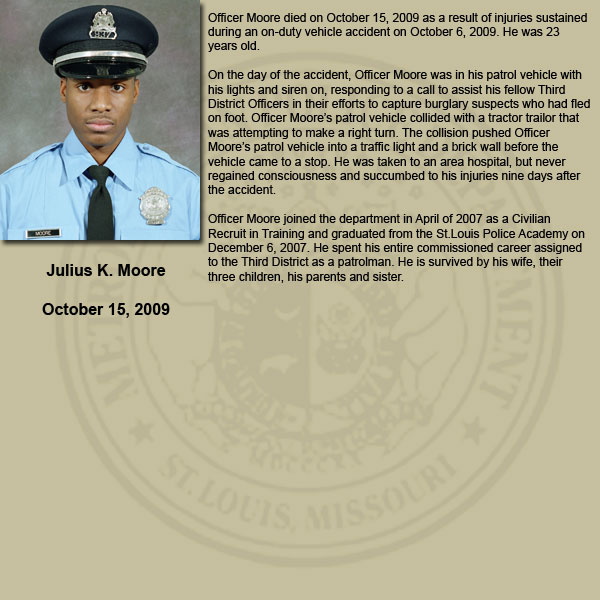 Date of death: October 15, 2009
Full Name: Julius K. Moore
Content: Officer Moore died on October 15, 2009 as a result of injuries sustained
during an on-duty vehicle accident on October 6, 2000. He was 23
years old.
On the day of the accident, Officer Moore was in his patrol vehicle with
his lights and siren on, responding to a call to assist his fellow Third
District Officers in their effors o capture burglary suspects who had fled
on foot. Officer Moore's patrol vehicle collided with a tractor trailor that
‘was attempting to make a right tum. The collision pushed Officer
Moore's patrol vehicle into a traffic light and a brick wall before the
vehicle came to a stop. He was taken to an area hospital, but never
regained consciousness and succumbed to is injuries nine days after
the accident.
Officer Moore joined the department in April of 2007 as a Civilian
Recruit in Training and graduated from the St Louis Police Academy on
December 6, 2007. He spent is entire commissioned career assigned
to the Third District as a patrolman. He is survived by his wife, their
three children, his parents and sister.
Date of death: October 15, 2009
Full Name: Julius K. Moore
Content: Officer Moore died on October 15, 2009 as a result of injuries sustained
during an on-duty vehicle accident on October 6, 2000. He was 23
years old.
On the day of the accident, Officer Moore was in his patrol vehicle with
his lights and siren on, responding to a call to assist his fellow Third
District Officers in their effors o capture burglary suspects who had fled
on foot. Officer Moore's patrol vehicle collided with a tractor trailor that
‘was attempting to make a right tum. The collision pushed Officer
Moore's patrol vehicle into a traffic light and a brick wall before the
vehicle came to a stop. He was taken to an area hospital, but never
regained consciousness and succumbed to is injuries nine days after
the accident.
Officer Moore joined the department in April of 2007 as a Civilian
Recruit in Training and graduated from the St Louis Police Academy on
December 6, 2007. He spent is entire commissioned career assigned
to the Third District as a patrolman. He is survived by his wife, their
three children, his parents and sister.
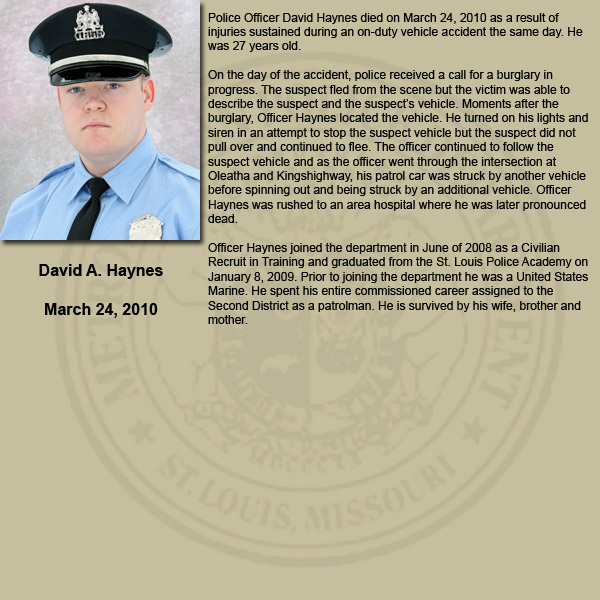 Date of death: March 24,2010
Full Name: David A. Haynes
Content: Police Officer David Haynes died on March 24, 2010 as a result of
injuries sustained during an on-duty vehicle accident the same day. He
was 27 years old.
On the day of the accident, police received a call for a burglary in
progress. The suspect fled from the scene but the victim was able to
describe the suspect and the suspect's vehicle. Moments after the
burglary, Officer Haynes located the vehicle. He fumed on his lights and
siren in an attempt to Stop the Suspect vehicle but the suspect did not
pull over and continued to flee. The officer continued to follow the
suspect vehicle and as the officer went through the intersection at
Oleatha and Kingshighway, his patrol car was struck by another vehicle
before spinning out and being struck by an additional vehicle. Officer
Haynes was rushed to an area hospital, where he was later pronounced
dead.
Officer Haynes joined the department in June of 2008 3s a Civilian
Recruit in Training and graduated from the St. Louis Police Academy on
January 8, 2009. Prior to joining the department he was a United States
Marine. He spent his entire commissioned career assigned to the
Second District as a patrolman. He is survived by his wife, brother and
mother.
Date of death: March 24,2010
Full Name: David A. Haynes
Content: Police Officer David Haynes died on March 24, 2010 as a result of
injuries sustained during an on-duty vehicle accident the same day. He
was 27 years old.
On the day of the accident, police received a call for a burglary in
progress. The suspect fled from the scene but the victim was able to
describe the suspect and the suspect's vehicle. Moments after the
burglary, Officer Haynes located the vehicle. He fumed on his lights and
siren in an attempt to Stop the Suspect vehicle but the suspect did not
pull over and continued to flee. The officer continued to follow the
suspect vehicle and as the officer went through the intersection at
Oleatha and Kingshighway, his patrol car was struck by another vehicle
before spinning out and being struck by an additional vehicle. Officer
Haynes was rushed to an area hospital, where he was later pronounced
dead.
Officer Haynes joined the department in June of 2008 3s a Civilian
Recruit in Training and graduated from the St. Louis Police Academy on
January 8, 2009. Prior to joining the department he was a United States
Marine. He spent his entire commissioned career assigned to the
Second District as a patrolman. He is survived by his wife, brother and
mother.
 Date of death: April 24, 2011
Full Name: Daryl A. Hall
Content: Police Officer Daryl Hall died April 24, 2011 as a result of gunshot injuries sustained while involved in an off-duty accident. He was 34 years
old. AS a result of the actions he took during the incident, Officer Hall's
death was classified as being in the line of duty.
On April 24, 2011, police responded to an Officer Involved Shooting at
800 S. 4th Street, the parking lot of the Black Label Nightclub, where
Officer Hall was a patron. According to witnesses, an altercation
between other patrons inside the nightclub erupted and those patrons
were escorted from the nightclub. Witnesses stated after the altercation
was moved outside onto the parking lt, the suspect retrieved a hand-
gun and began firing shots. According to witnesses, when Officer Hall
heard the gunshots, while still inside the nightclub, he went outside to
investigate. Witnesses also stated, that Officer Hall observed the suspect firing a handgun and announced that he was a police officer and
ordered the suspect to drop his weapon. The suspect refused and
gunfire was exchanged between Officer Hal, the suspect and a person
providing security for the nightclub. Officer Hall suffered two gunshot
wounds, one to the neck and one to the bicep. Officer Hall was transported to St. Louis University Hospital where he was pronounced dead
33:16 2.m. The suspect who fired shots was also struck multiple times
and later died.
Officer Hall joined the department in November of 2005 as a Civilian
Recruit in Training. On July 13, 2006, he graduated from the St. Louis
Police Academy as a commissioned St. Louis Police Officer. During his
carer with the department Officer Hall served in the Sixth District as a
patrolman. At the time of his death he was a patrolman assigned to the
Housing Authority Unit He Is survived by his mother, stepfather and
brother.
Date of death: April 24, 2011
Full Name: Daryl A. Hall
Content: Police Officer Daryl Hall died April 24, 2011 as a result of gunshot injuries sustained while involved in an off-duty accident. He was 34 years
old. AS a result of the actions he took during the incident, Officer Hall's
death was classified as being in the line of duty.
On April 24, 2011, police responded to an Officer Involved Shooting at
800 S. 4th Street, the parking lot of the Black Label Nightclub, where
Officer Hall was a patron. According to witnesses, an altercation
between other patrons inside the nightclub erupted and those patrons
were escorted from the nightclub. Witnesses stated after the altercation
was moved outside onto the parking lt, the suspect retrieved a hand-
gun and began firing shots. According to witnesses, when Officer Hall
heard the gunshots, while still inside the nightclub, he went outside to
investigate. Witnesses also stated, that Officer Hall observed the suspect firing a handgun and announced that he was a police officer and
ordered the suspect to drop his weapon. The suspect refused and
gunfire was exchanged between Officer Hal, the suspect and a person
providing security for the nightclub. Officer Hall suffered two gunshot
wounds, one to the neck and one to the bicep. Officer Hall was transported to St. Louis University Hospital where he was pronounced dead
33:16 2.m. The suspect who fired shots was also struck multiple times
and later died.
Officer Hall joined the department in November of 2005 as a Civilian
Recruit in Training. On July 13, 2006, he graduated from the St. Louis
Police Academy as a commissioned St. Louis Police Officer. During his
carer with the department Officer Hall served in the Sixth District as a
patrolman. At the time of his death he was a patrolman assigned to the
Housing Authority Unit He Is survived by his mother, stepfather and
brother.
 Date of death: August 30, 2020
Full Name: Tamarris L. Bohannon
Content: Police Officer Tamarris Bohannon succumbed to a gunshot
sustained on August 29th, 2020, when he and other officers were
ambushed in the 3700 block of Hartford Street.
Shortly before 6:00 p.m. on August 28th, 2020, Officer Bohannon
and other officers were dispatched to reports of a shooting in the
3700 block of Hartford. Wile searching for a victim a man opened
fire, striking Officer Bohannon in the head and a second officer in
the'leg. The suspect then unlawfully entered a residence, causing
the residents to flee. The suspect barricaded himself inside the
home until being taken into custody nearly 12 hours later.
Officer Bohannon was taken to a local hospital where he
succumbed to his injuries on 8/30/20.
Officer Bohannon had served with the St. Louis Metropolitan Police
Department for 3-1/2 years. He is survived by his wife and three
children.
Date of death: August 30, 2020
Full Name: Tamarris L. Bohannon
Content: Police Officer Tamarris Bohannon succumbed to a gunshot
sustained on August 29th, 2020, when he and other officers were
ambushed in the 3700 block of Hartford Street.
Shortly before 6:00 p.m. on August 28th, 2020, Officer Bohannon
and other officers were dispatched to reports of a shooting in the
3700 block of Hartford. Wile searching for a victim a man opened
fire, striking Officer Bohannon in the head and a second officer in
the'leg. The suspect then unlawfully entered a residence, causing
the residents to flee. The suspect barricaded himself inside the
home until being taken into custody nearly 12 hours later.
Officer Bohannon was taken to a local hospital where he
succumbed to his injuries on 8/30/20.
Officer Bohannon had served with the St. Louis Metropolitan Police
Department for 3-1/2 years. He is survived by his wife and three
children.
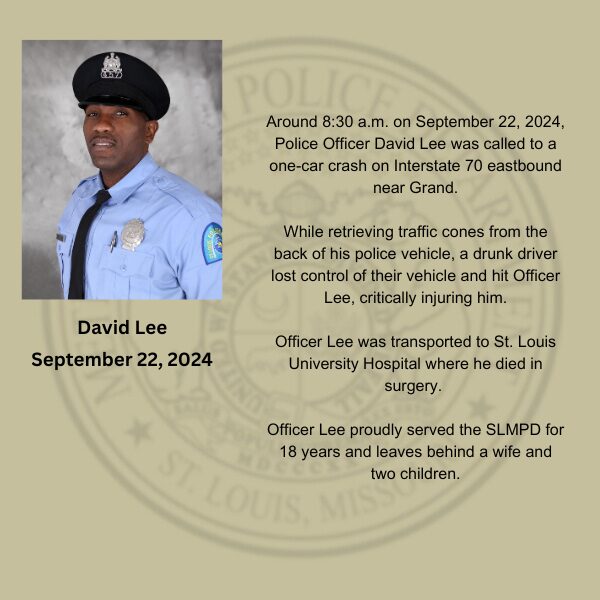 Date of death: 09-22-24
Full Name: David Lee III
Content: Around 8:30 a.m. on September 22, 2024, Police Officer David Lee was called to a one-car crash on Interstate 70 eastbound near Grand. While in the process of retrieving traffic cones from the back of his police vehicle, a drunk driver lost control of their vehicle and hit Officer Lee, critically injuring him.
Officer Lee was transported to St. Louis University Hospital where he died in surgery.
Officer Lee proudly served the SLMPD for 18 years and leaves behind a wife and two children.
Date of death: 09-22-24
Full Name: David Lee III
Content: Around 8:30 a.m. on September 22, 2024, Police Officer David Lee was called to a one-car crash on Interstate 70 eastbound near Grand. While in the process of retrieving traffic cones from the back of his police vehicle, a drunk driver lost control of their vehicle and hit Officer Lee, critically injuring him.
Officer Lee was transported to St. Louis University Hospital where he died in surgery.
Officer Lee proudly served the SLMPD for 18 years and leaves behind a wife and two children.
Biographical information extracted from In the Line of Duty: St. Louis Police Officers Who Made the Ultimate Sacrifice by Barbara Miksicek, Lt. Col. Stephen Pollihan, David McElreath and Kristiana Carnaghi.
